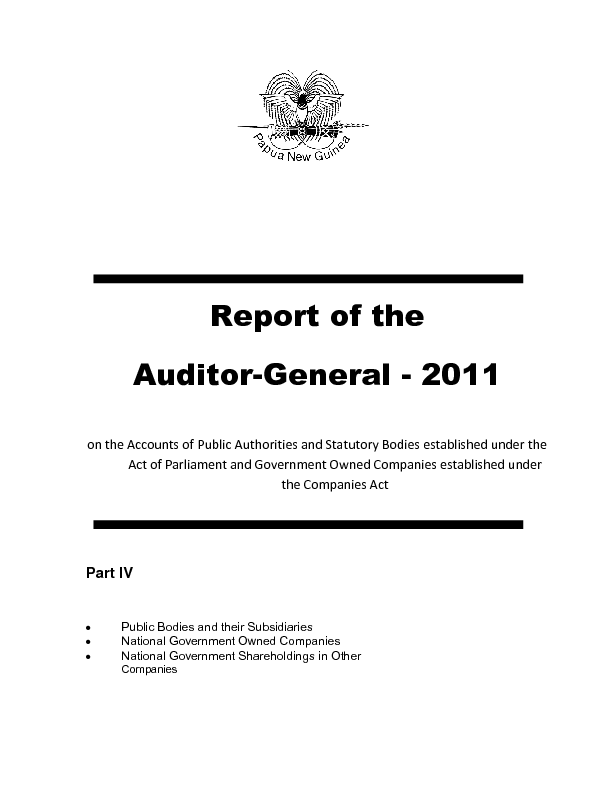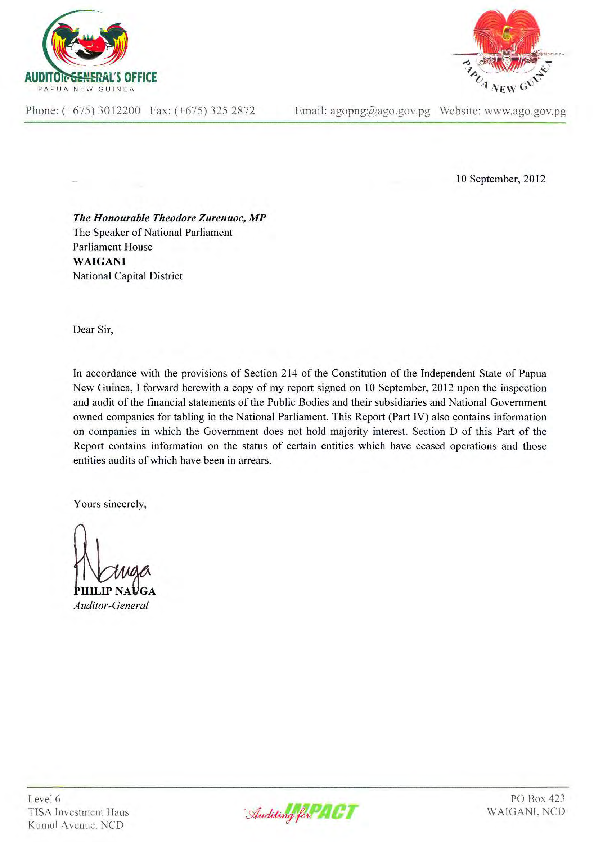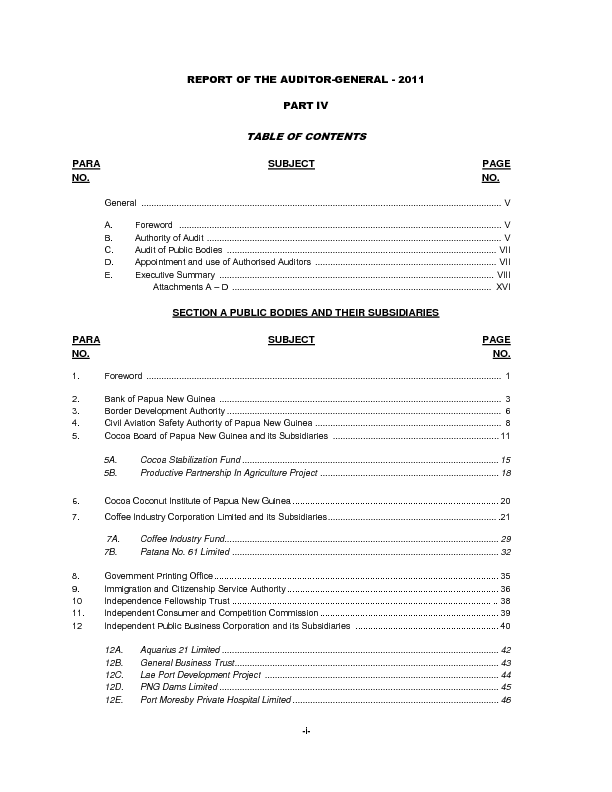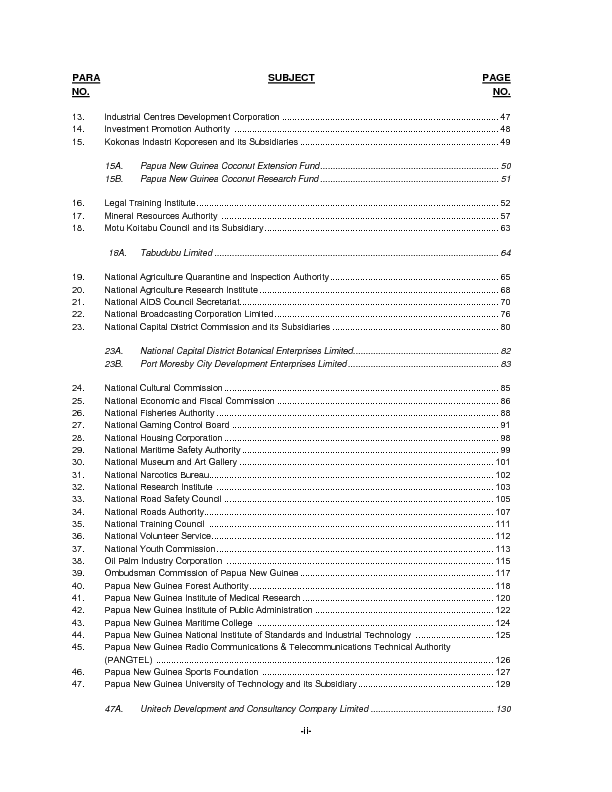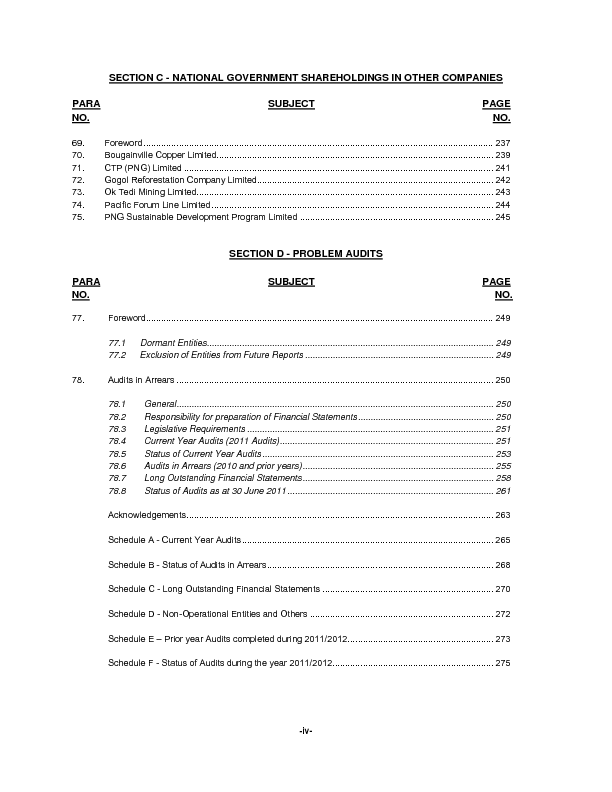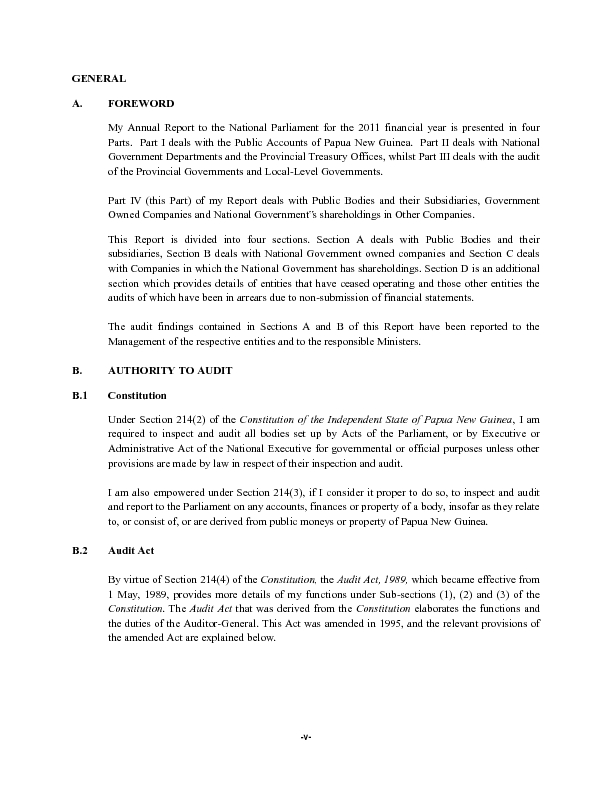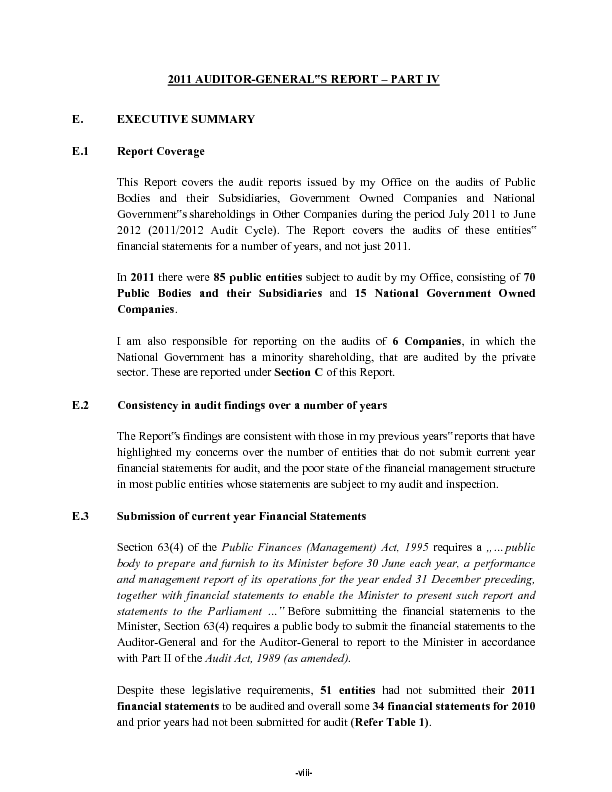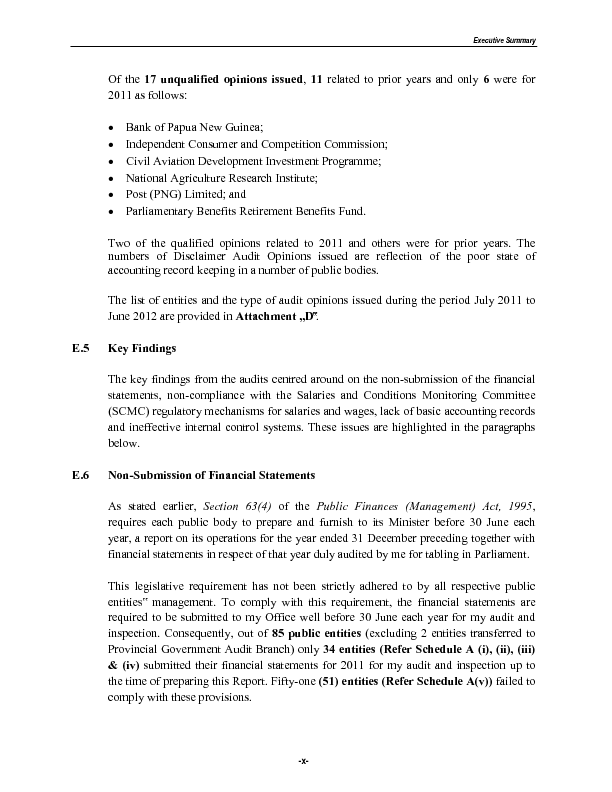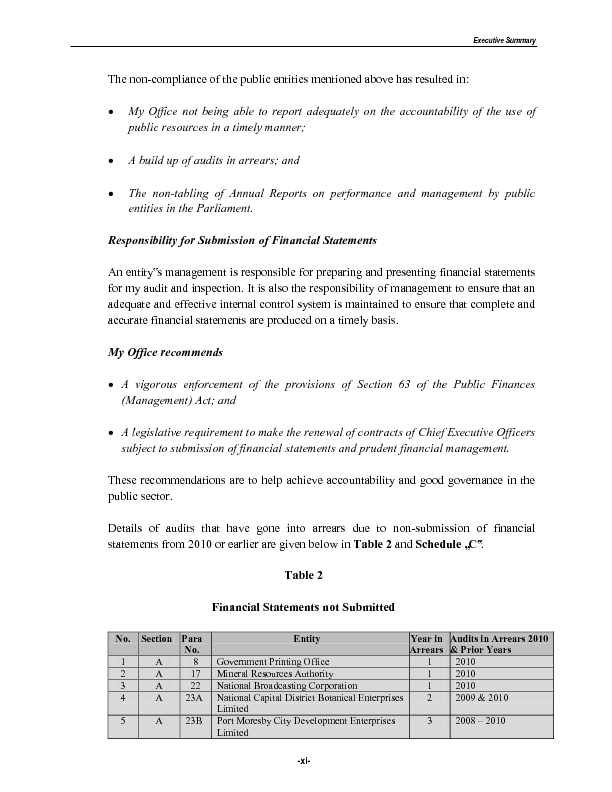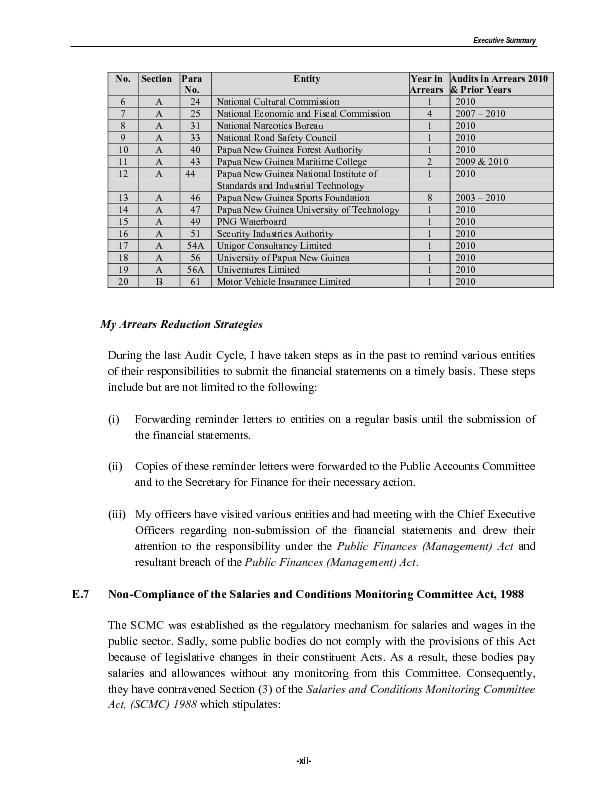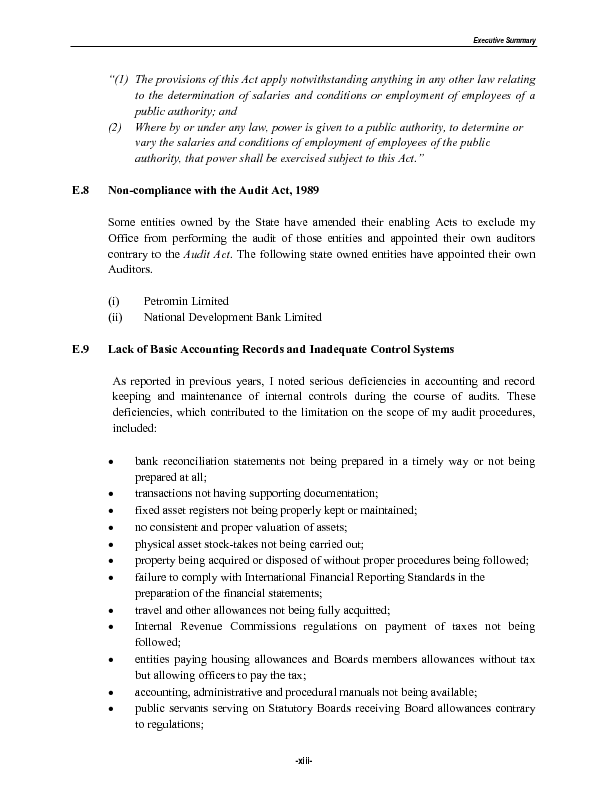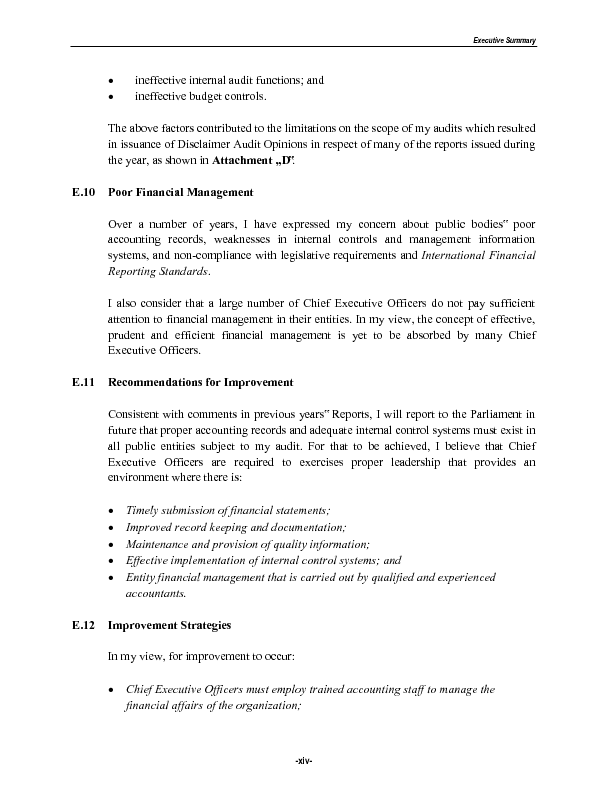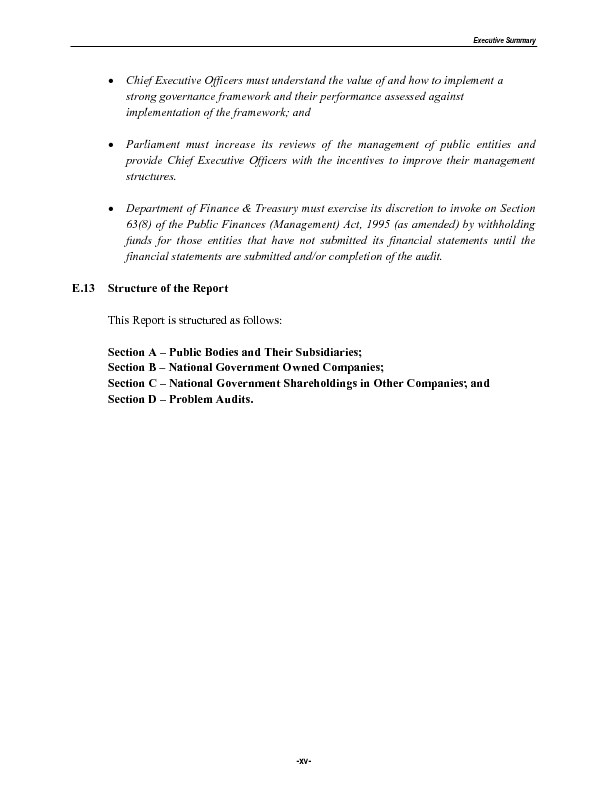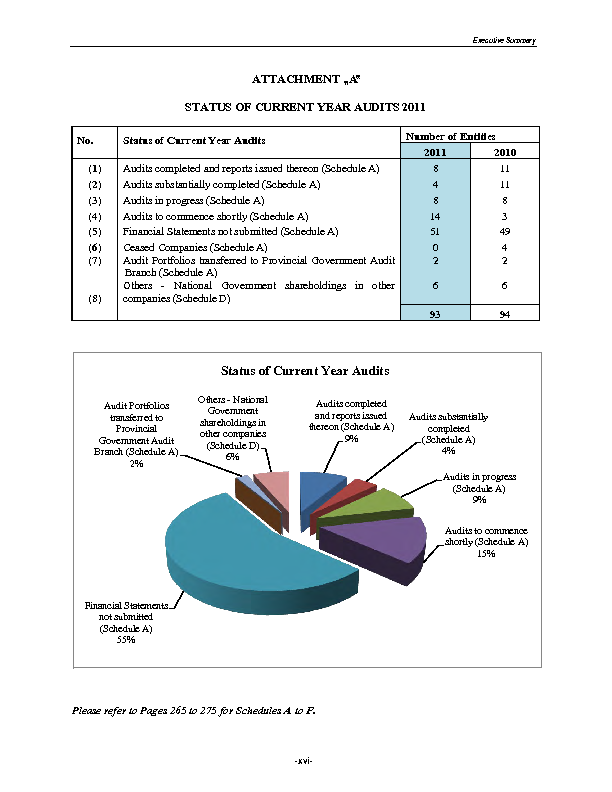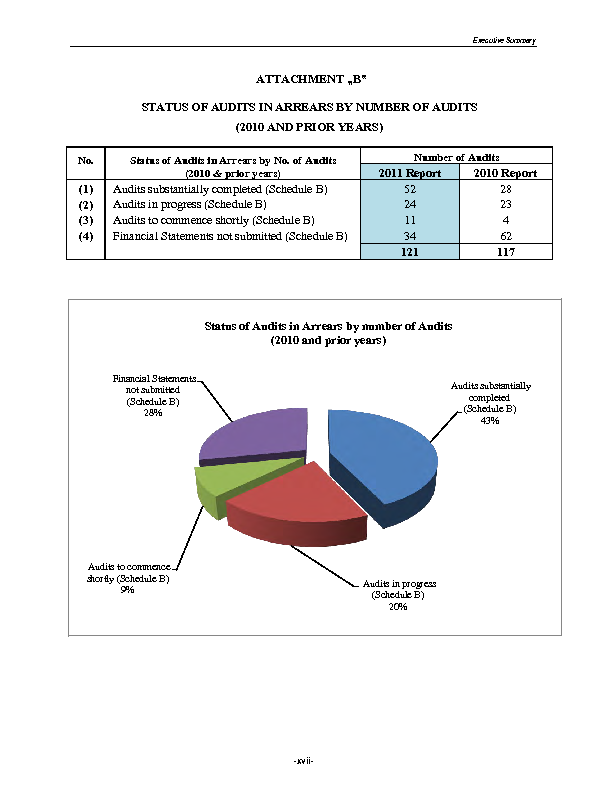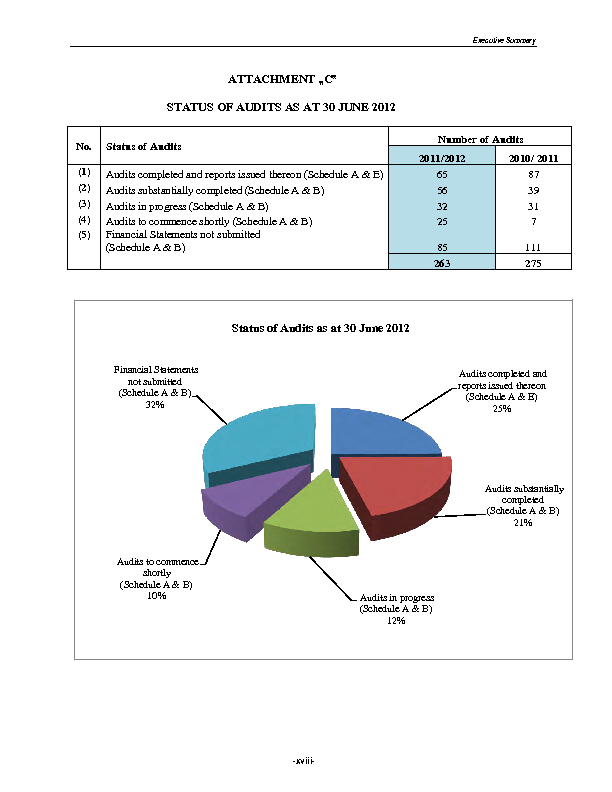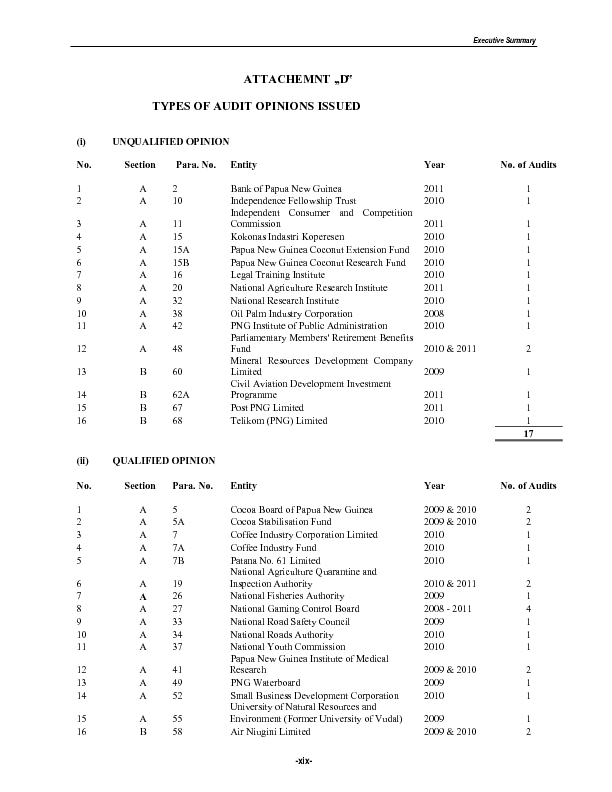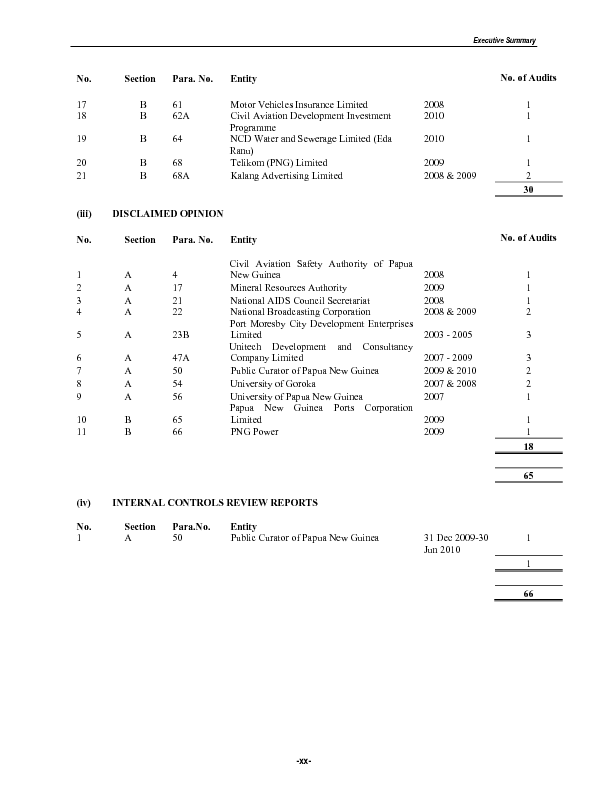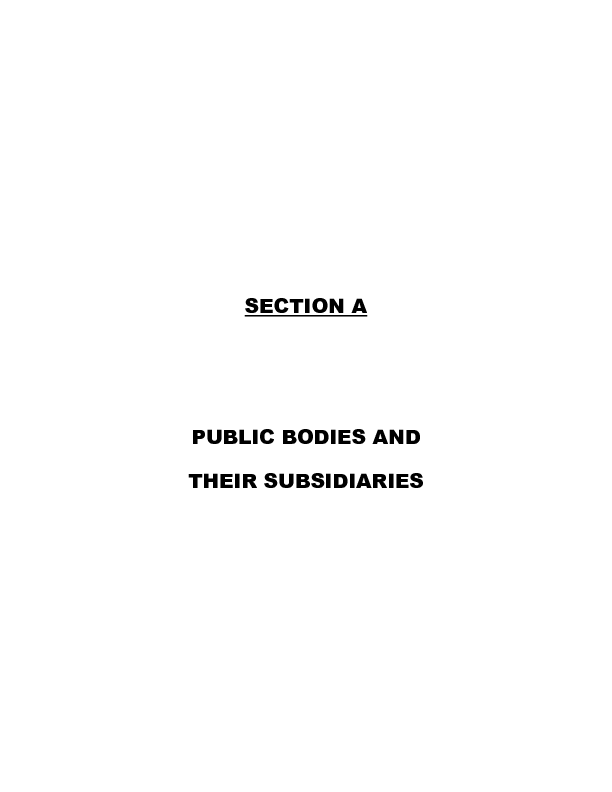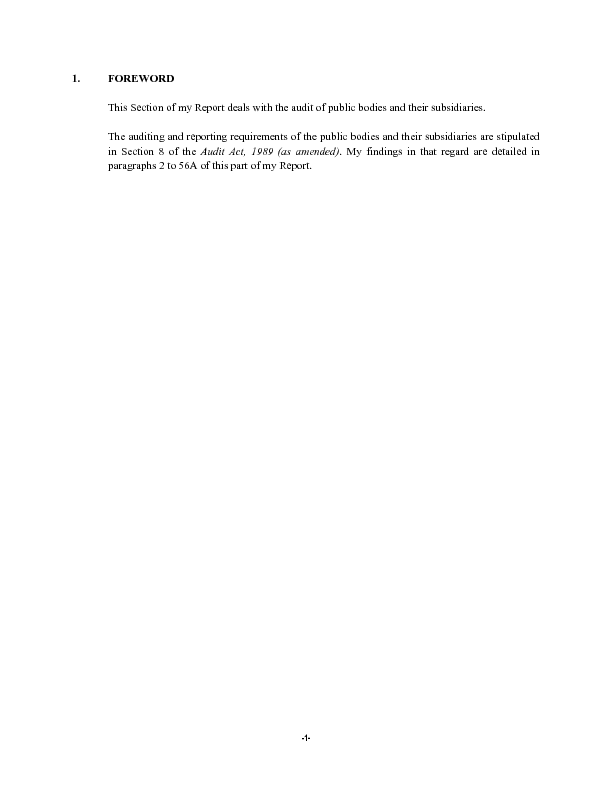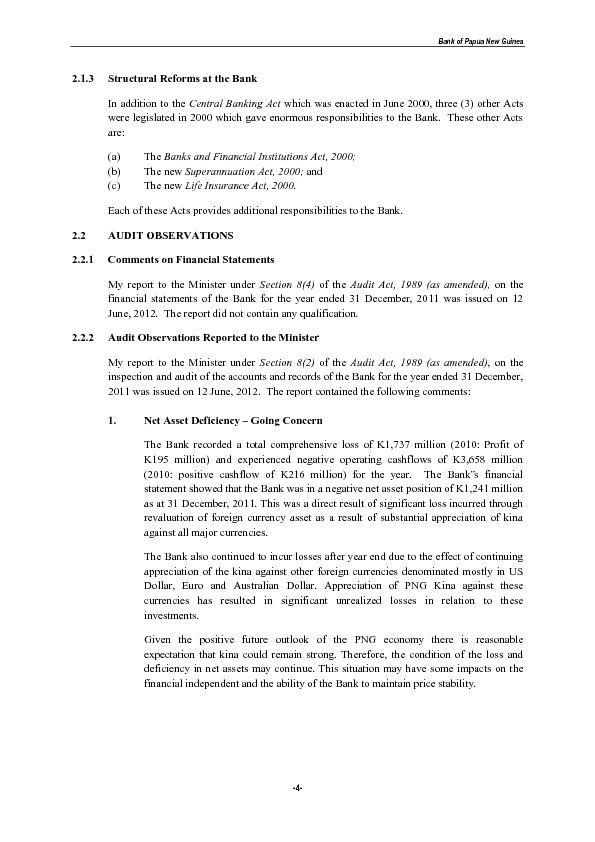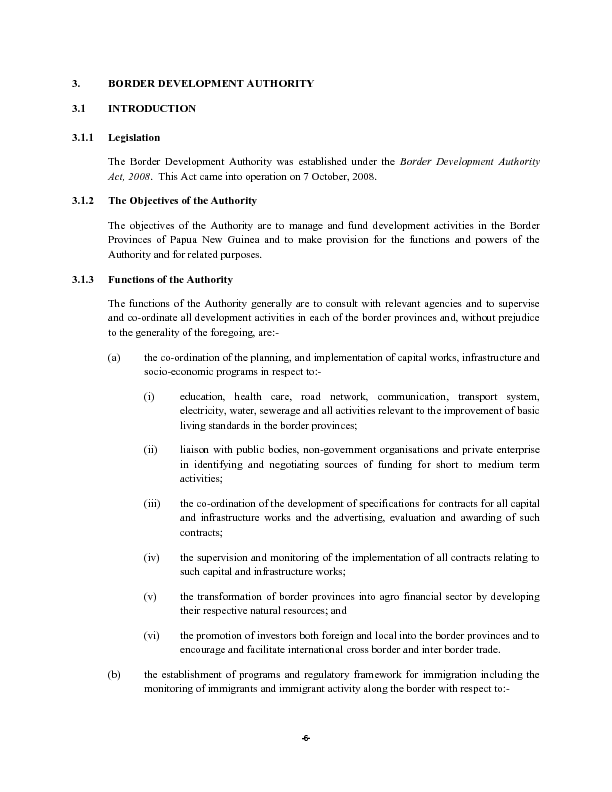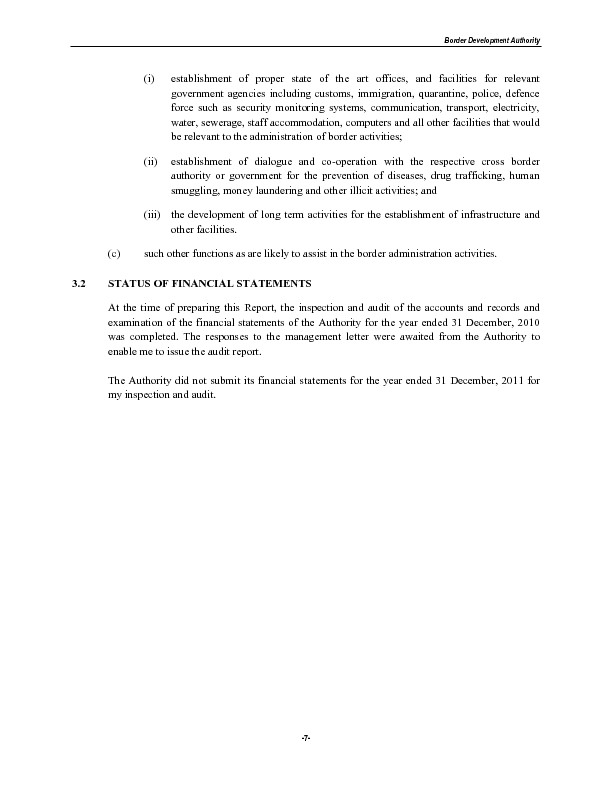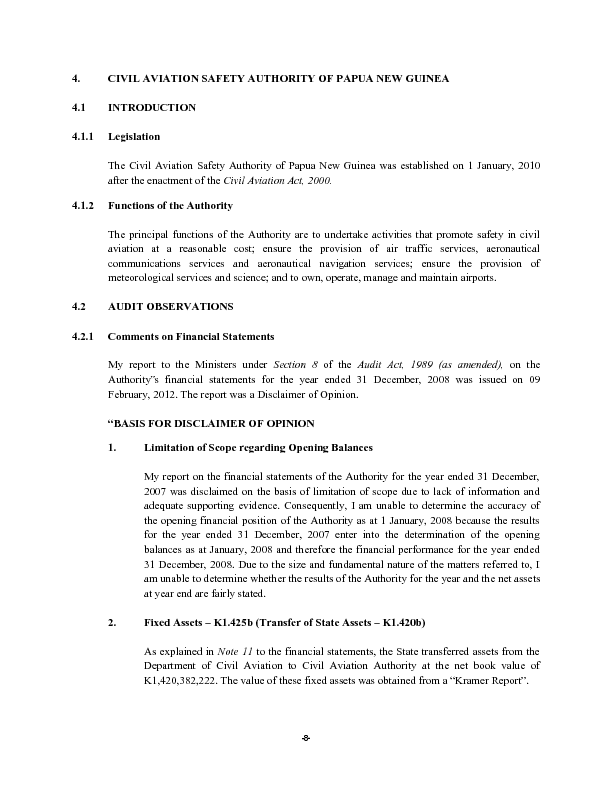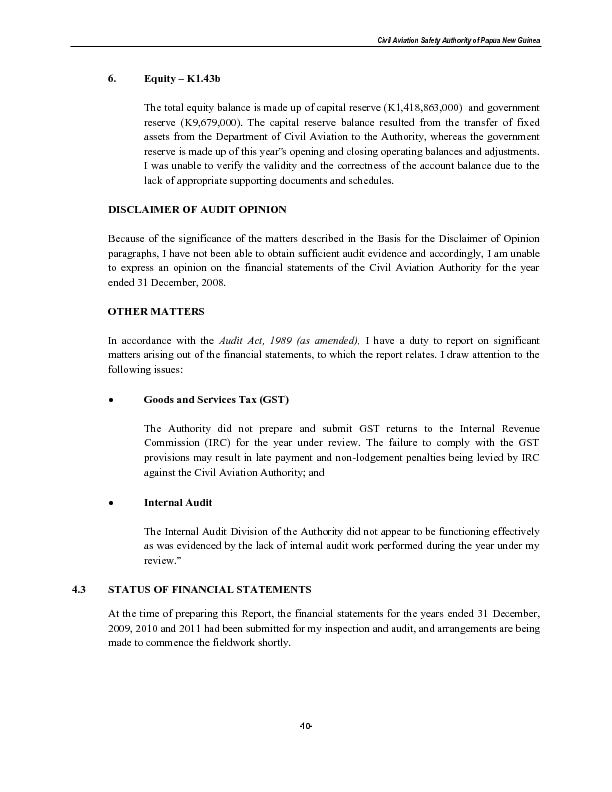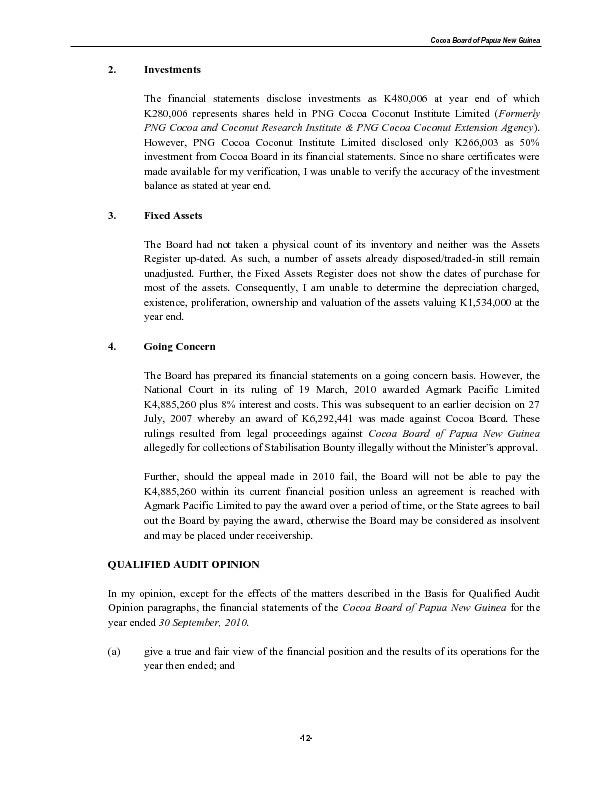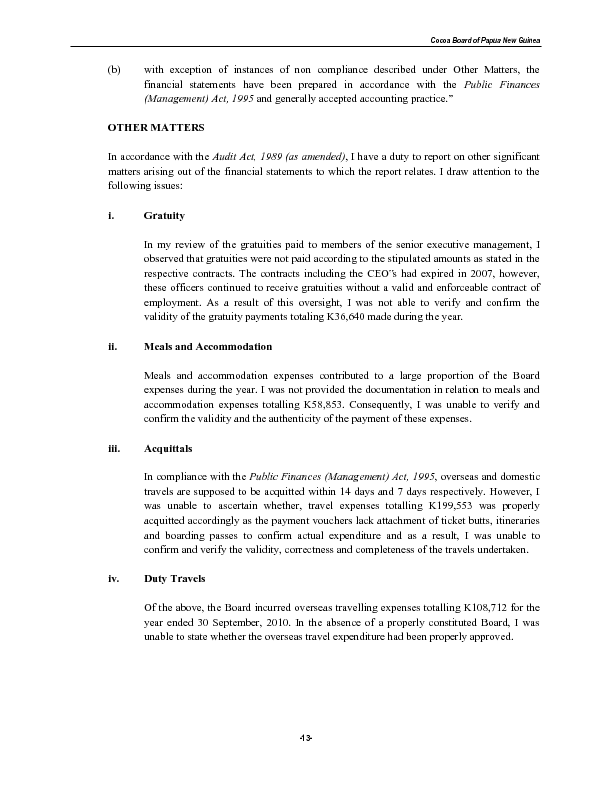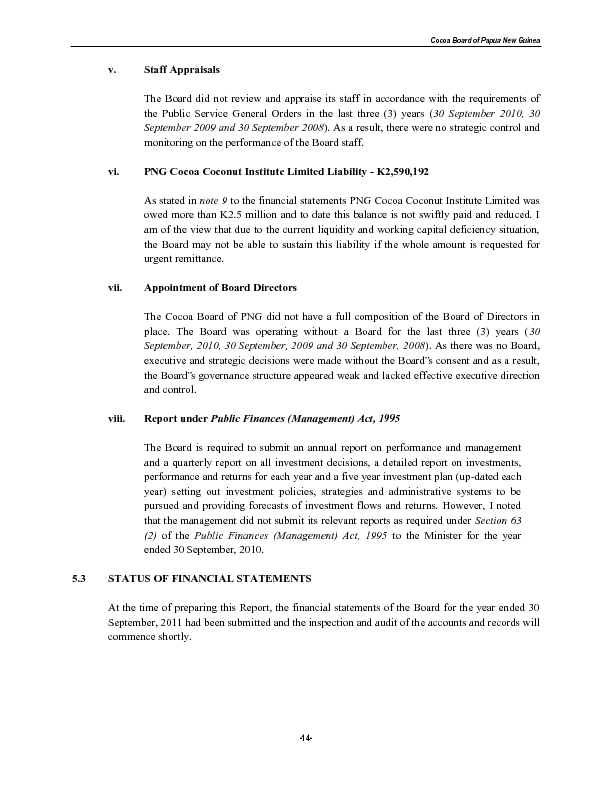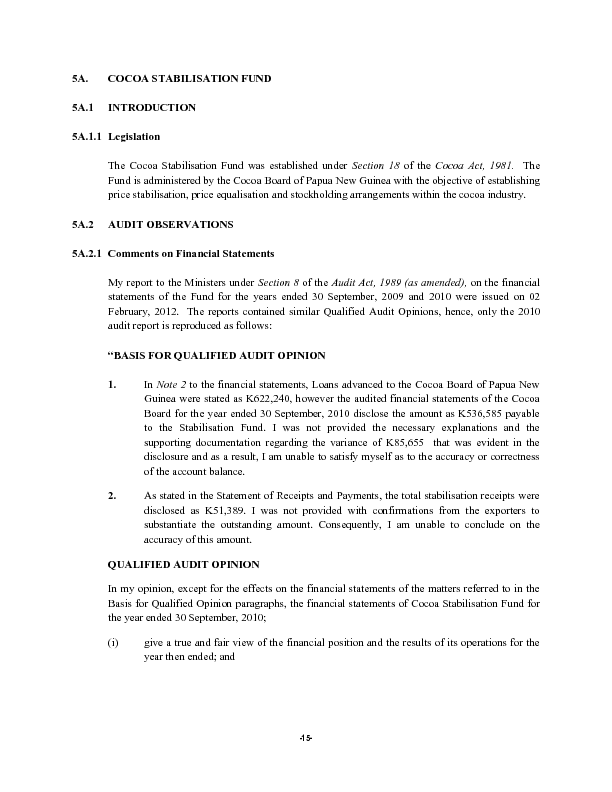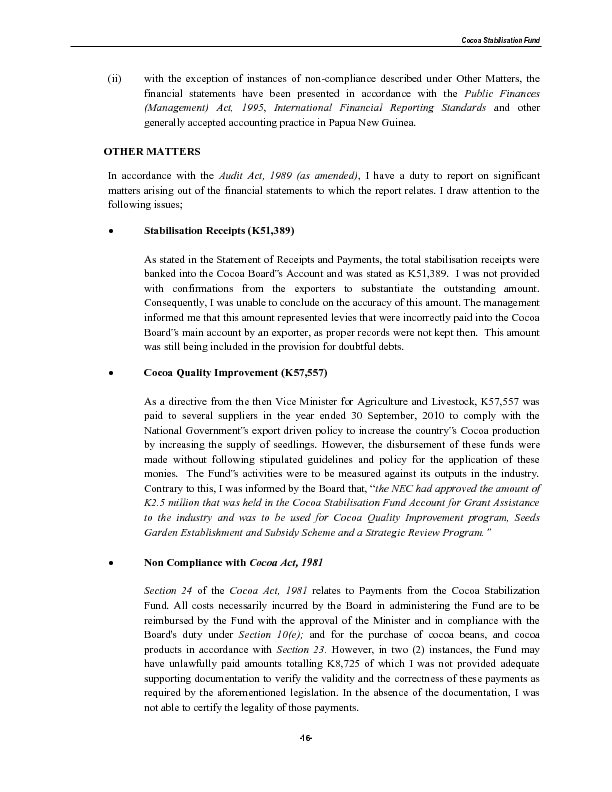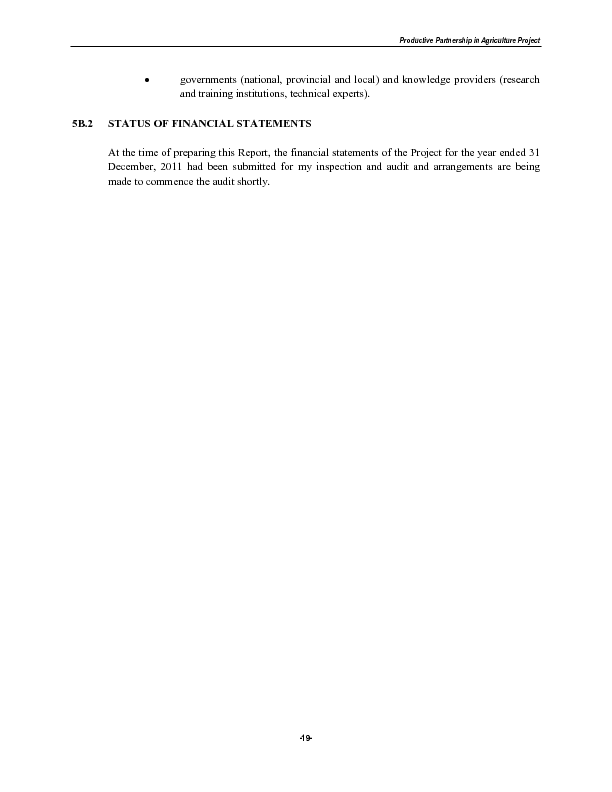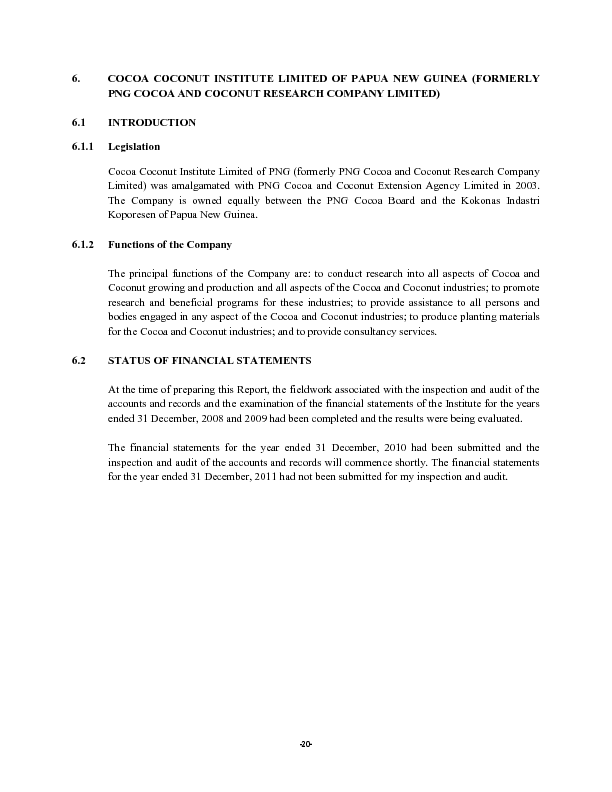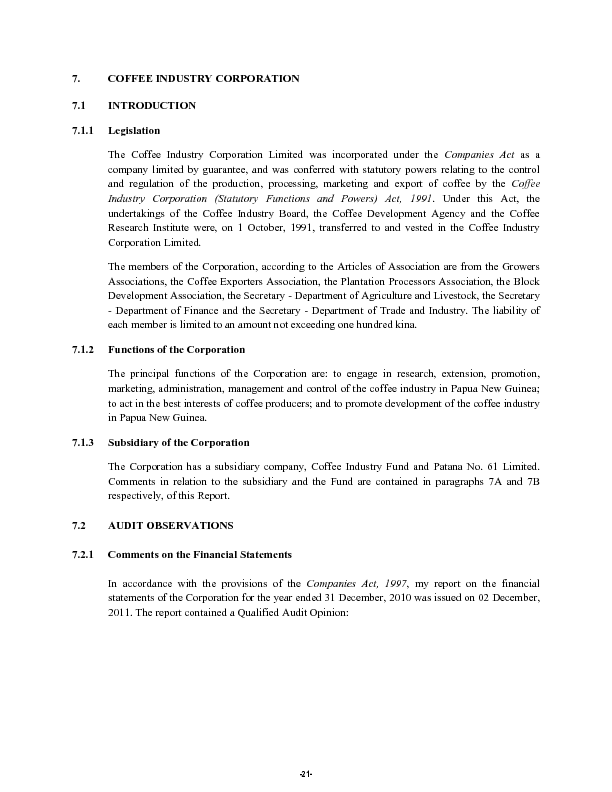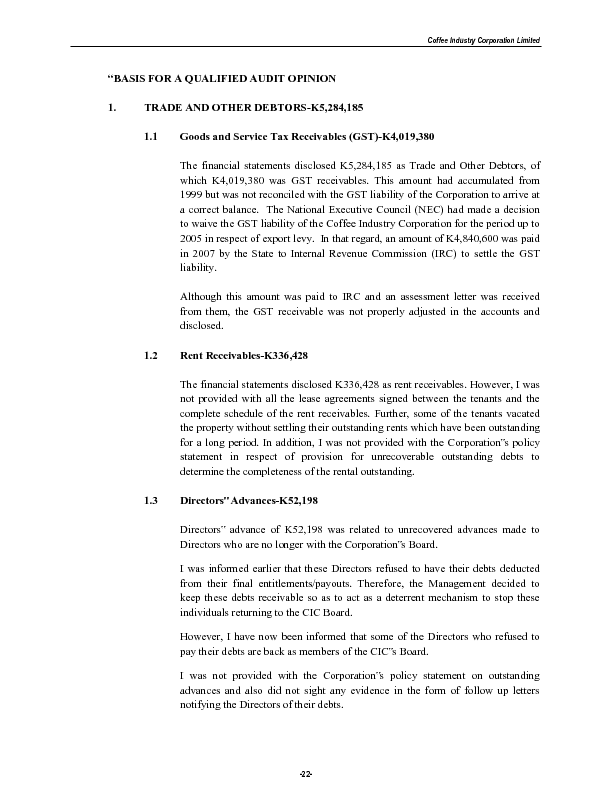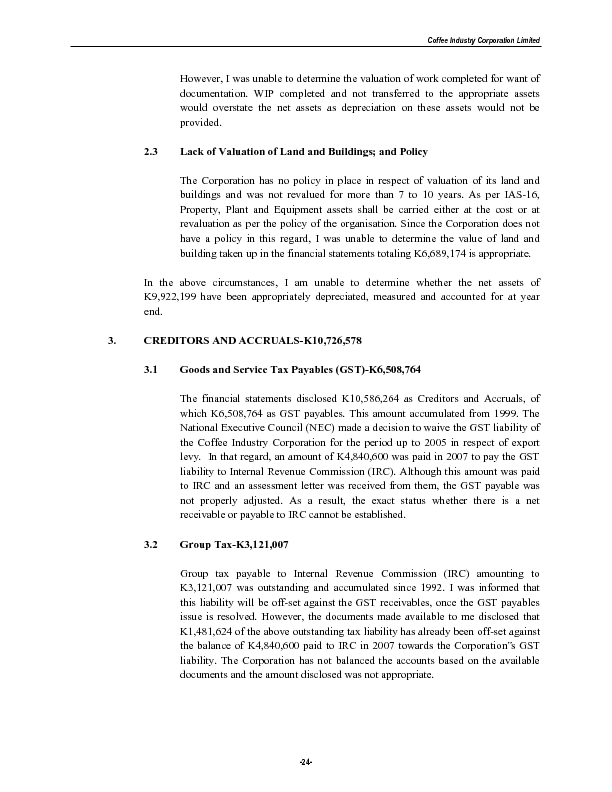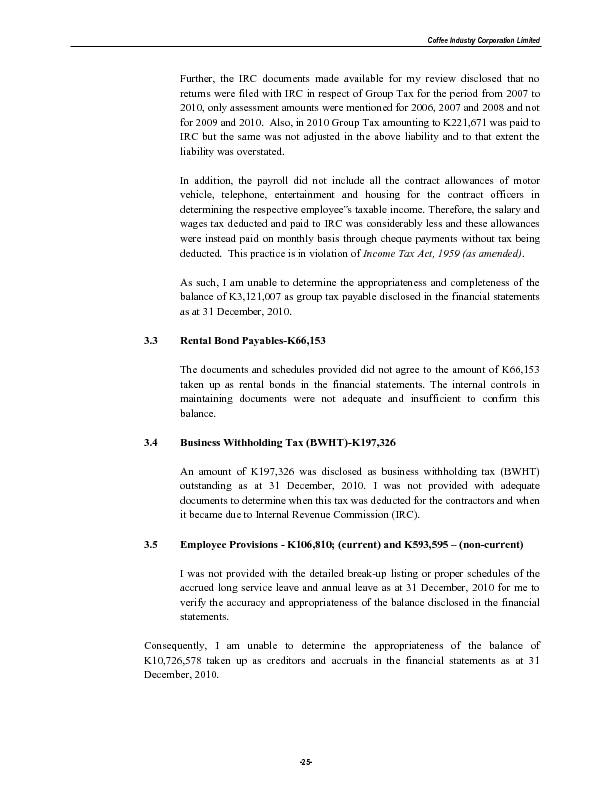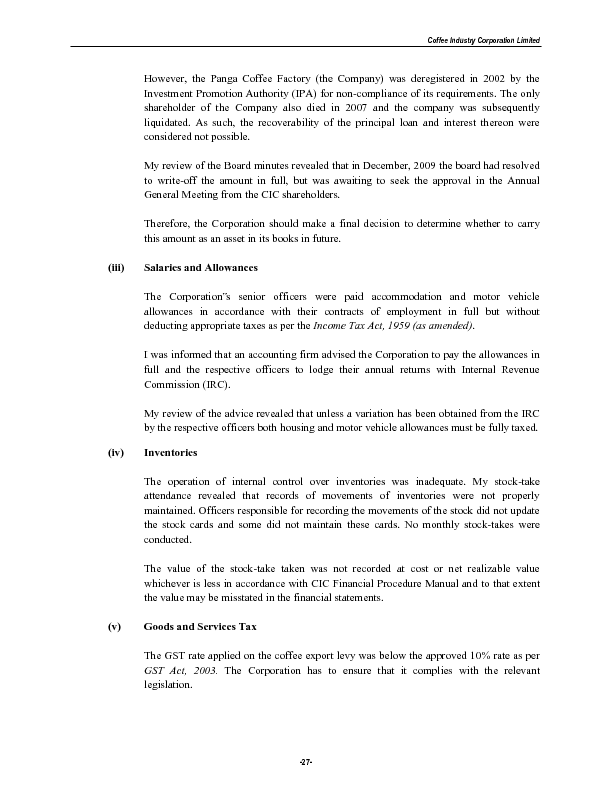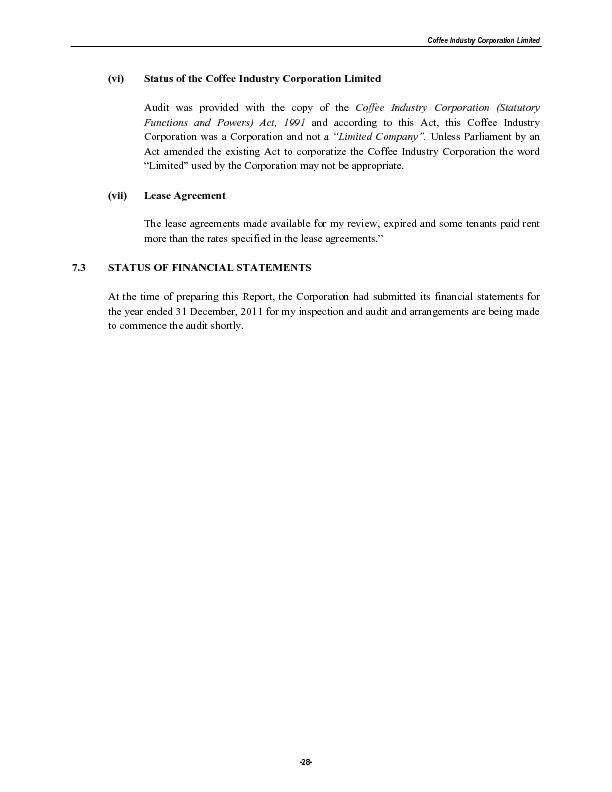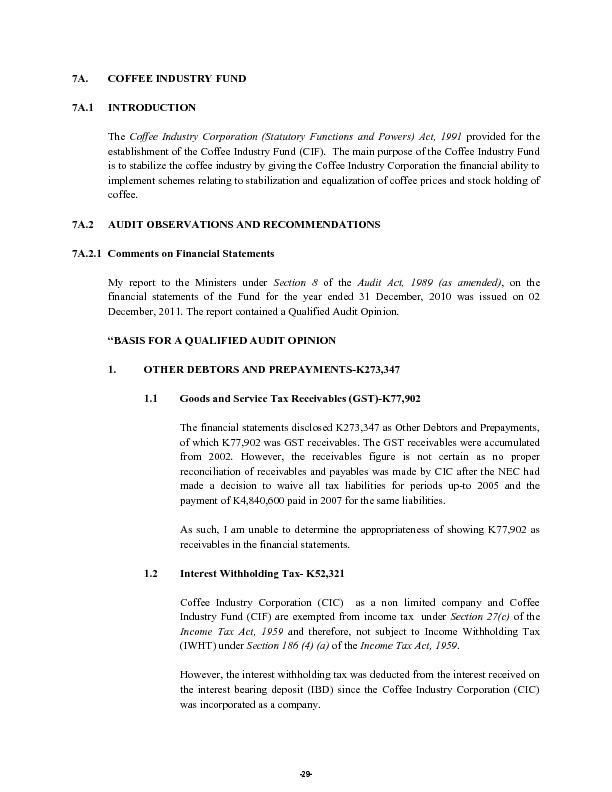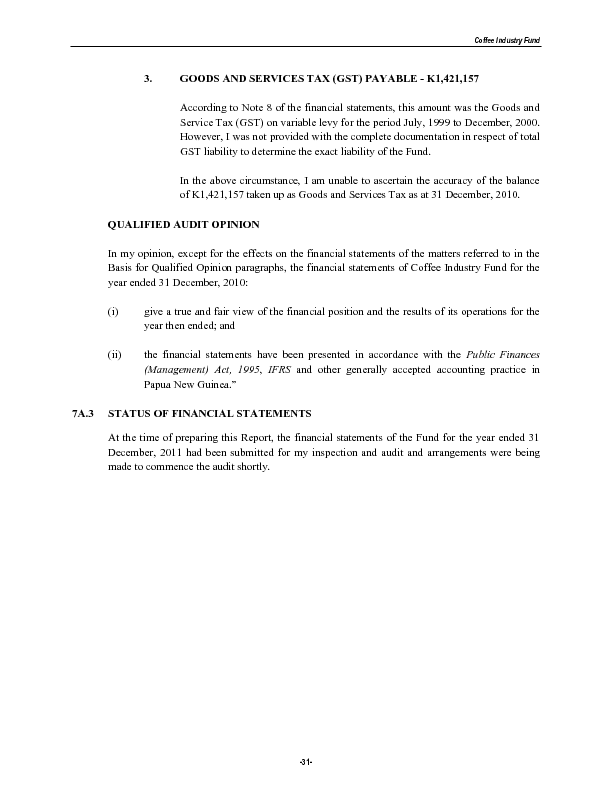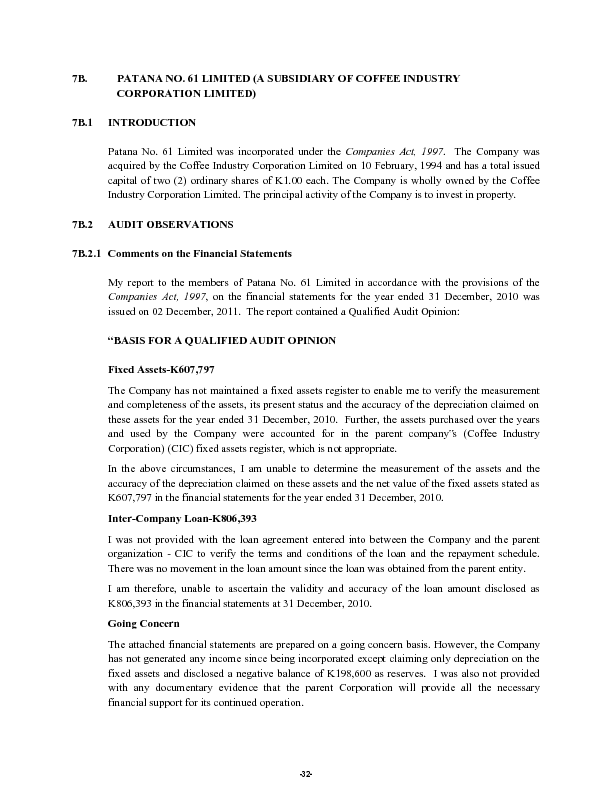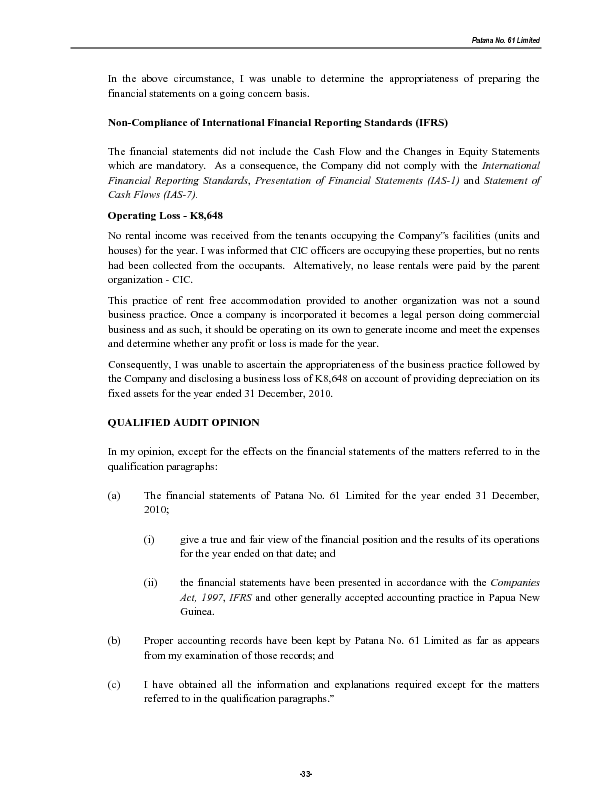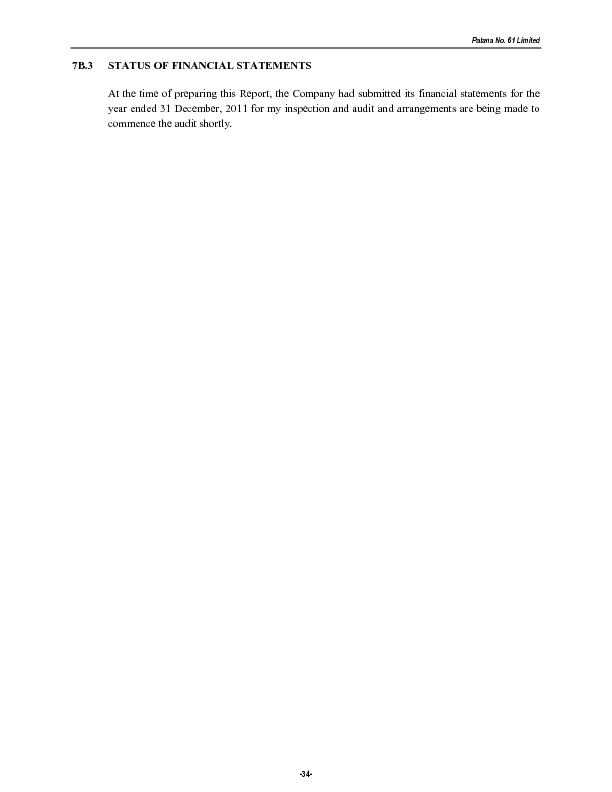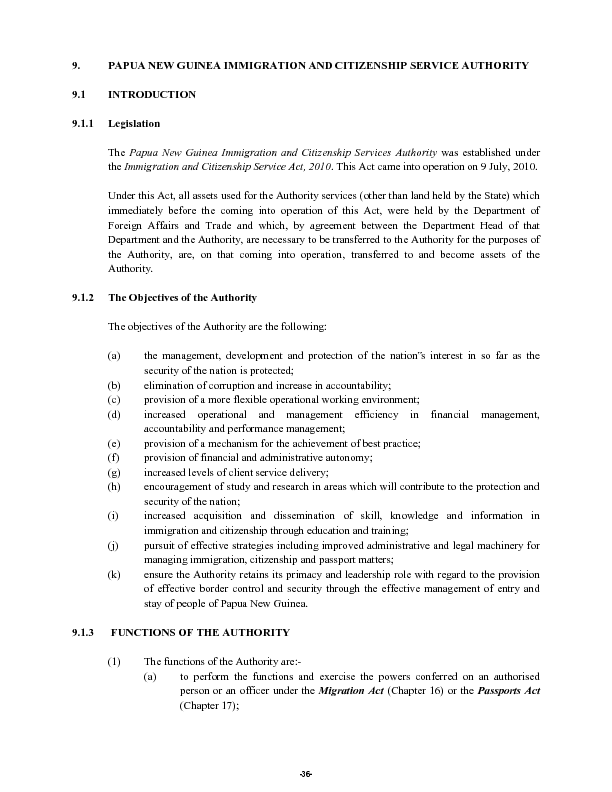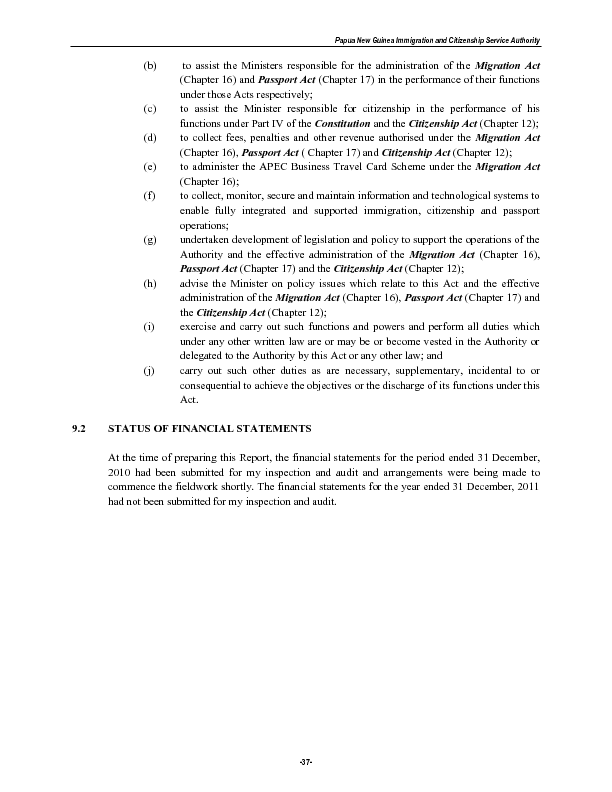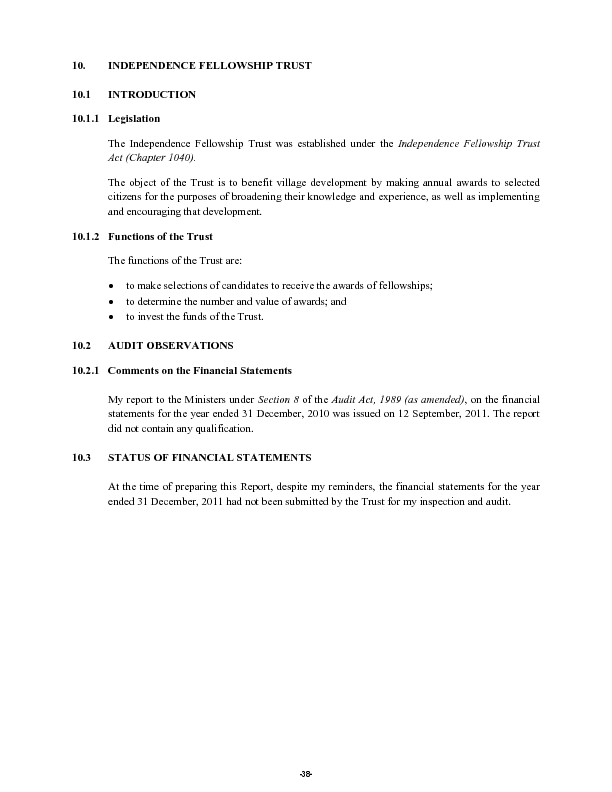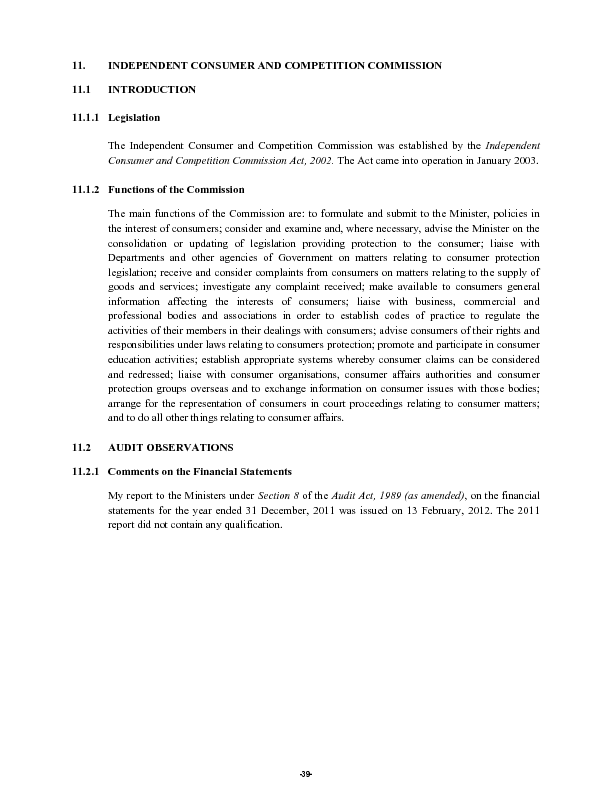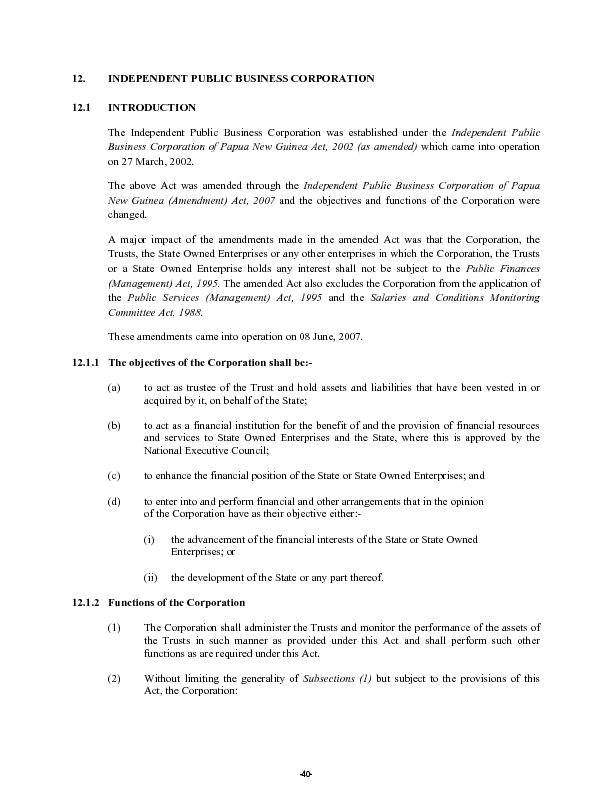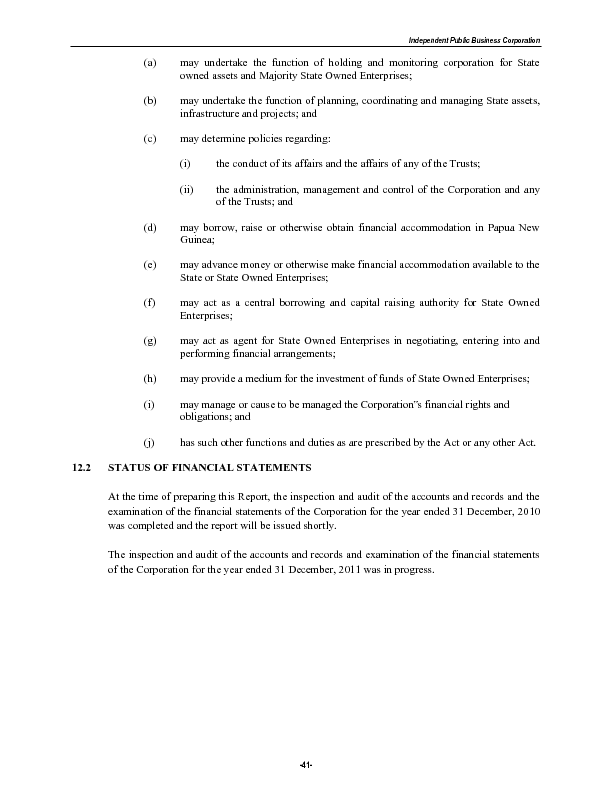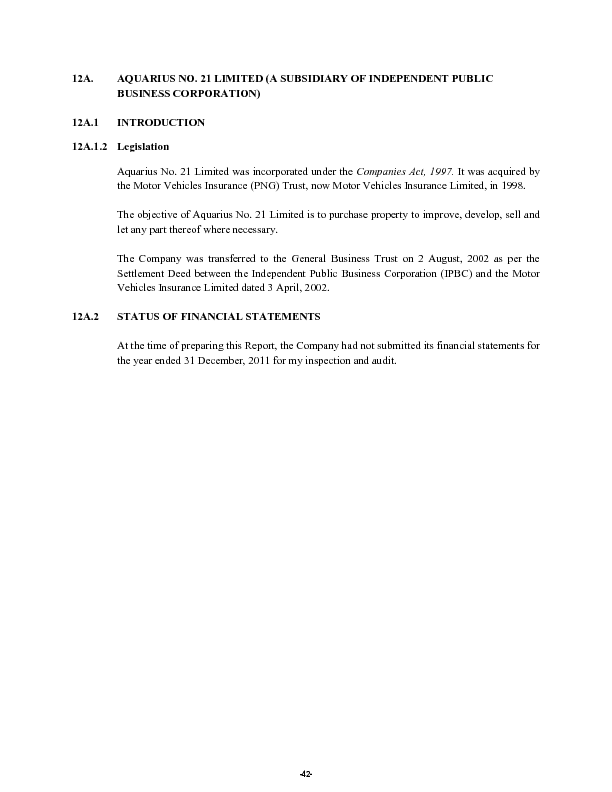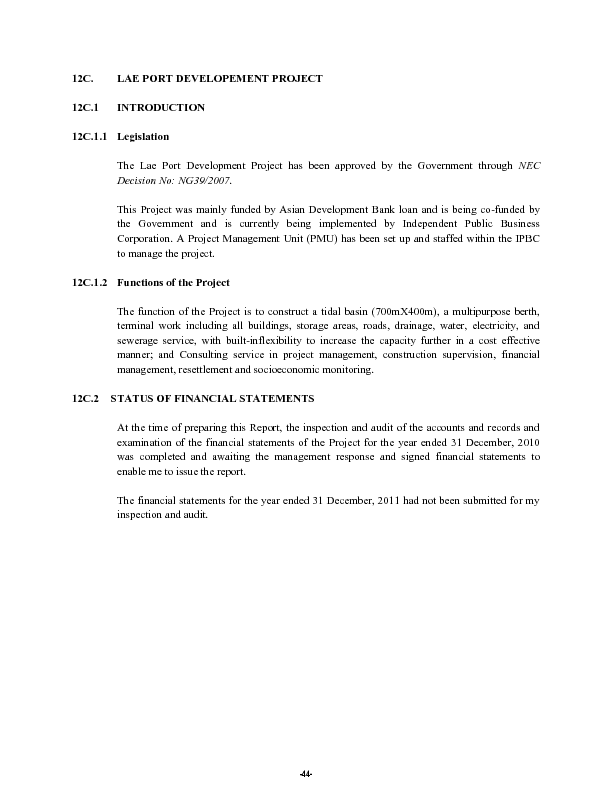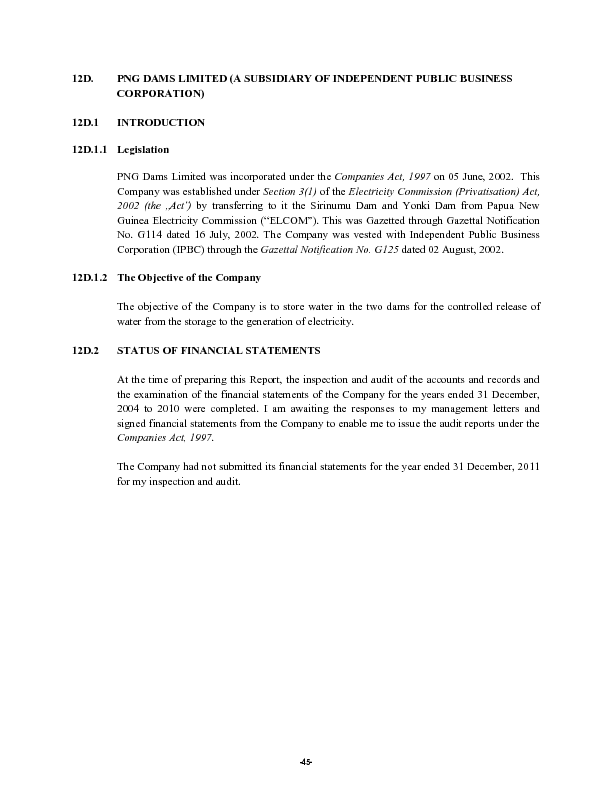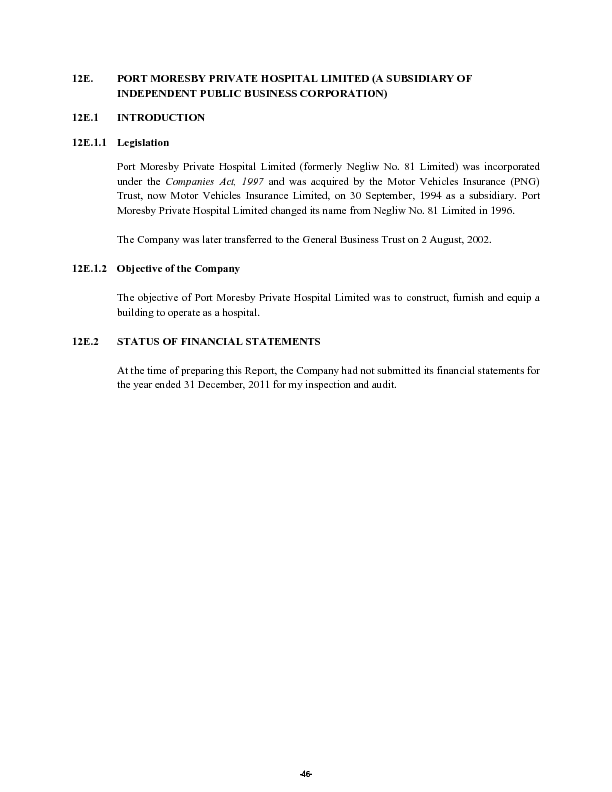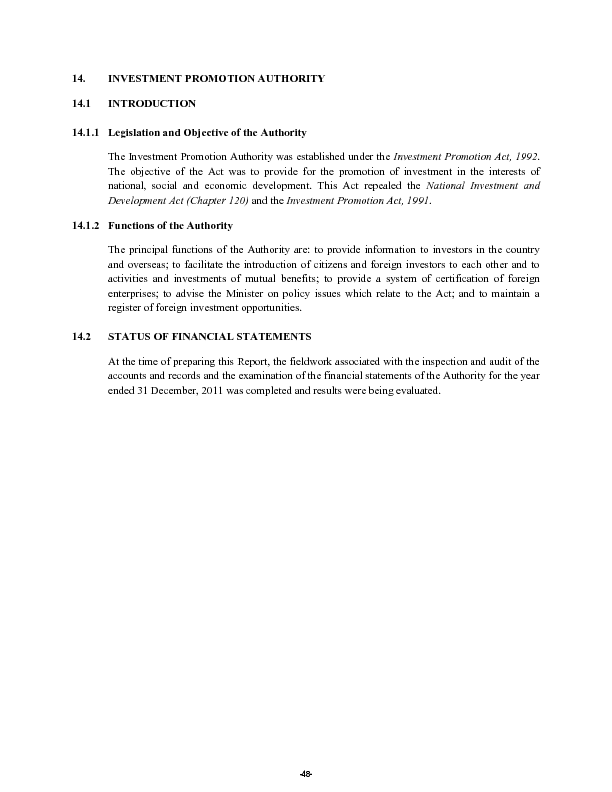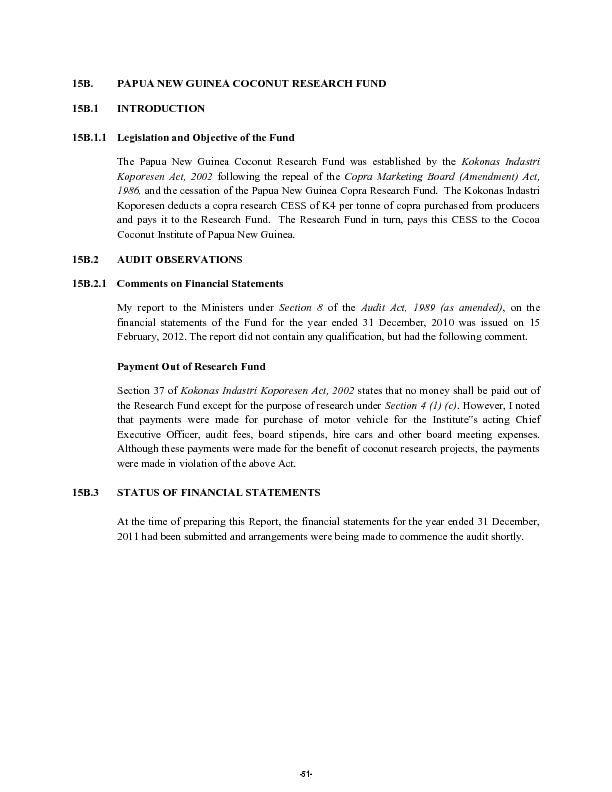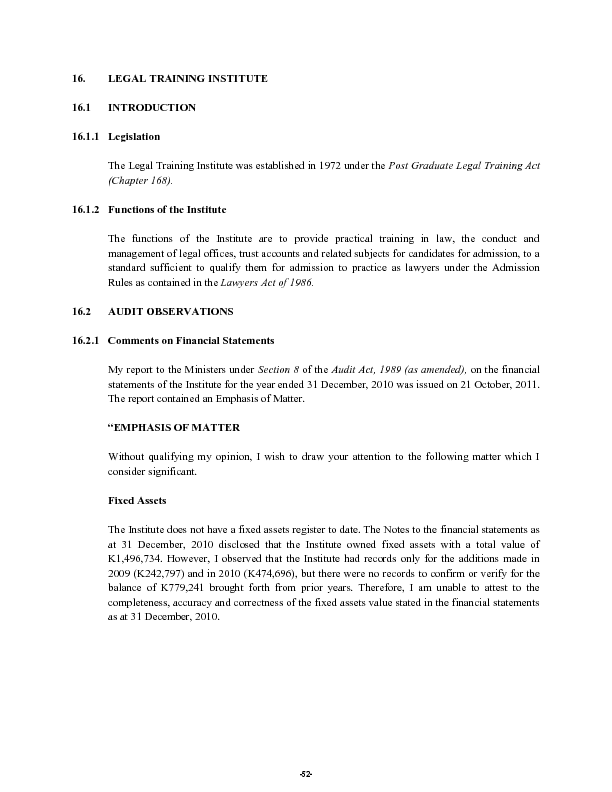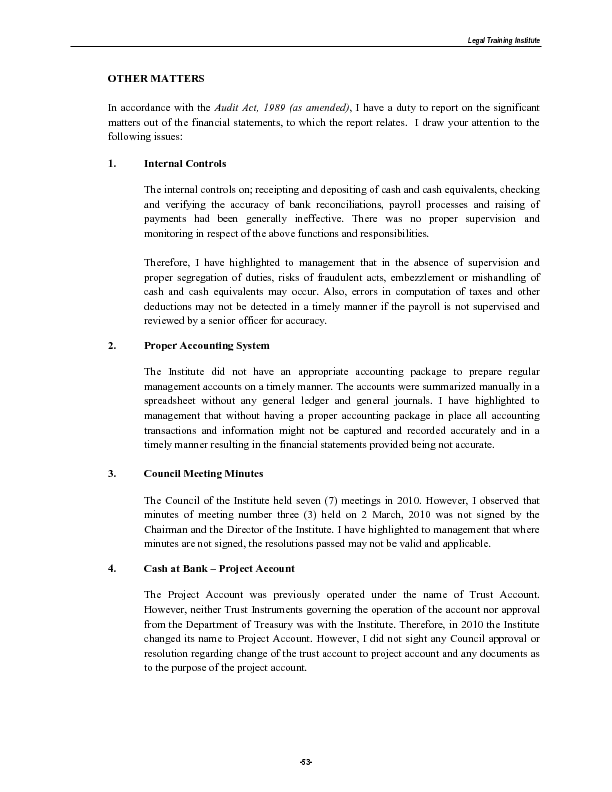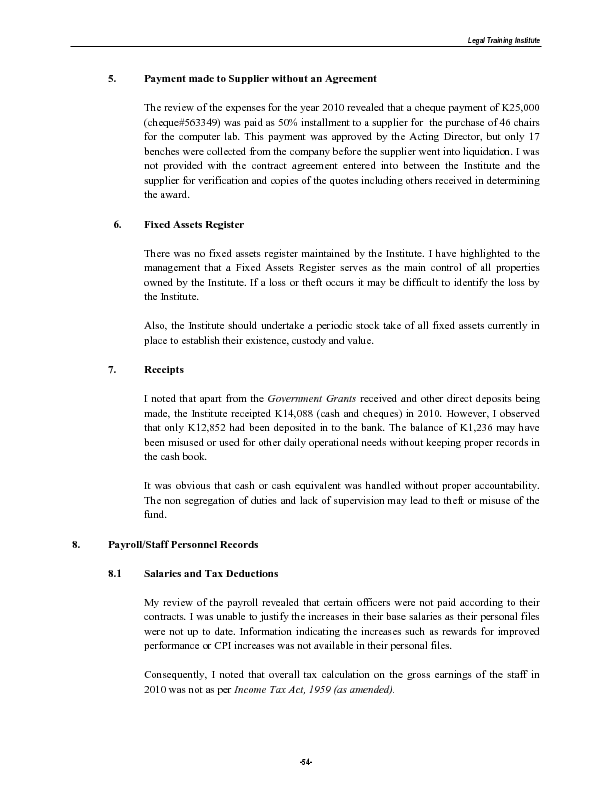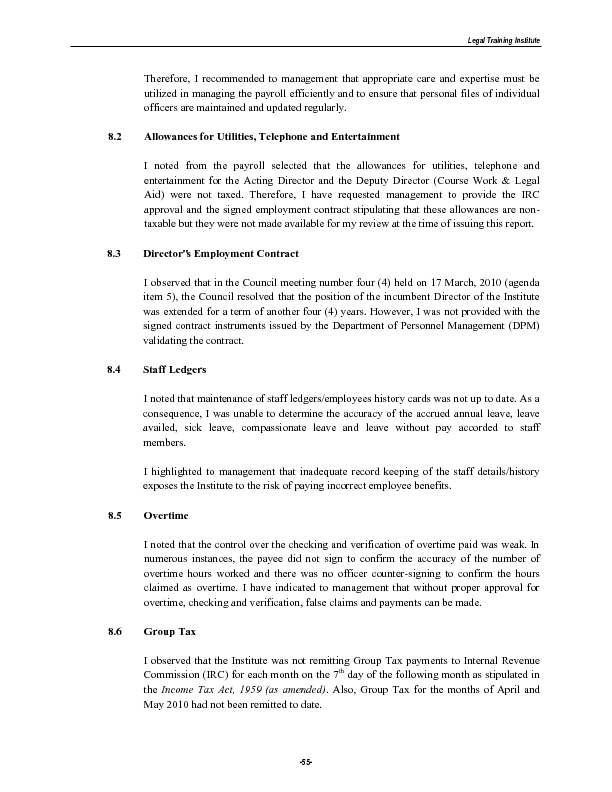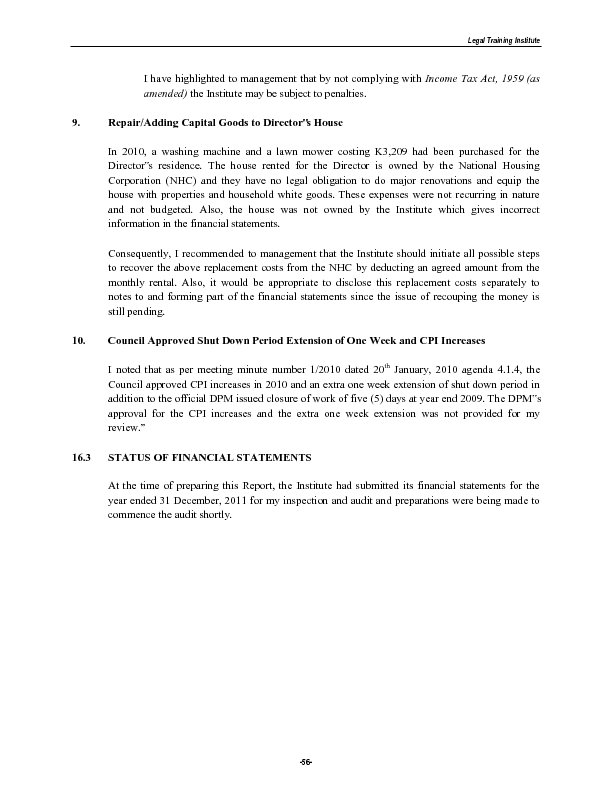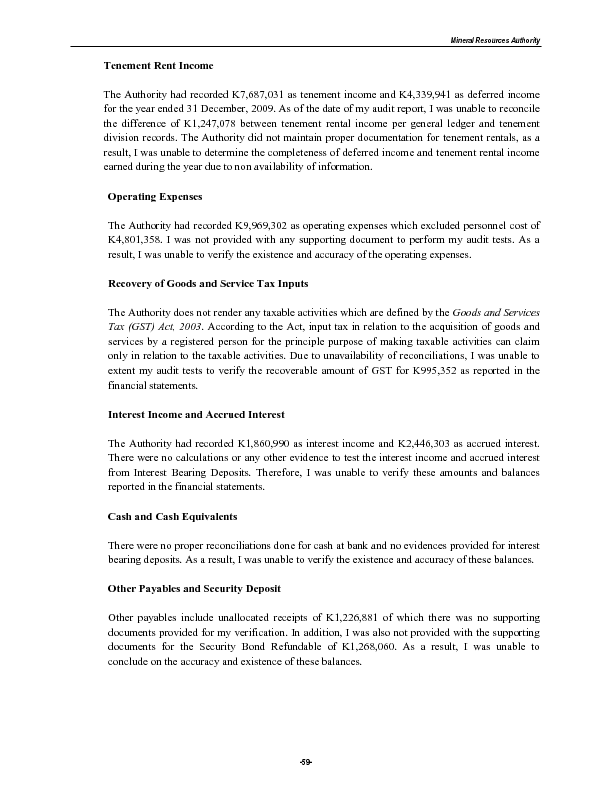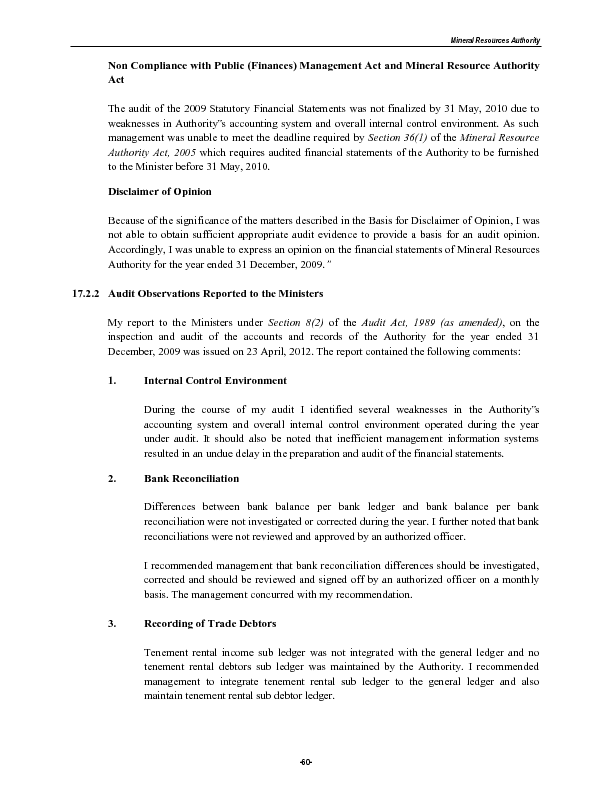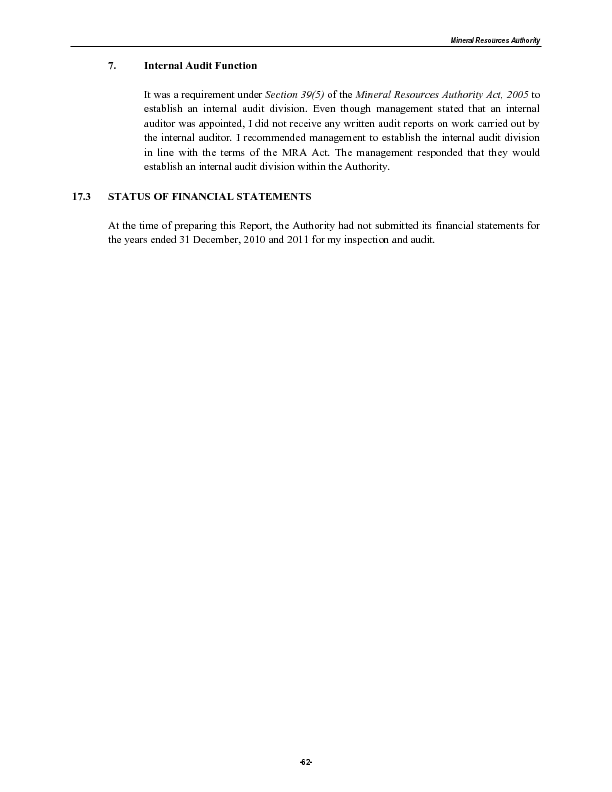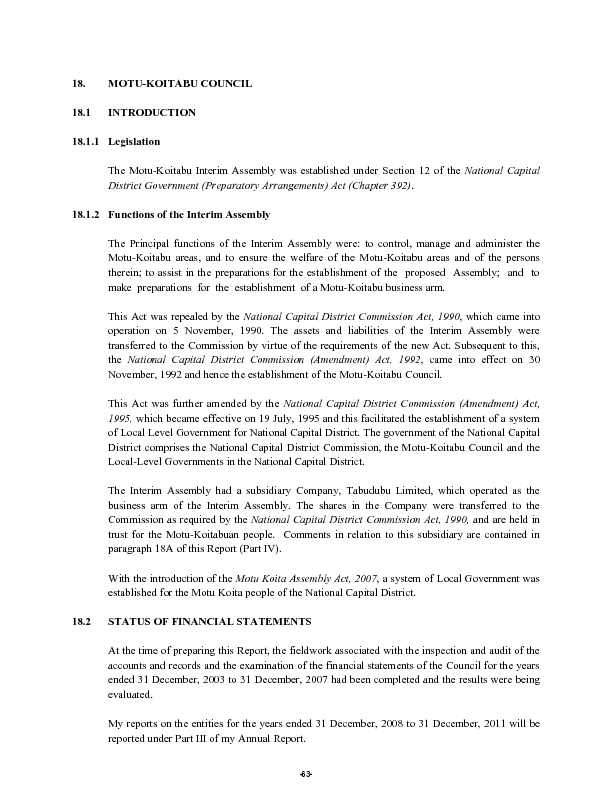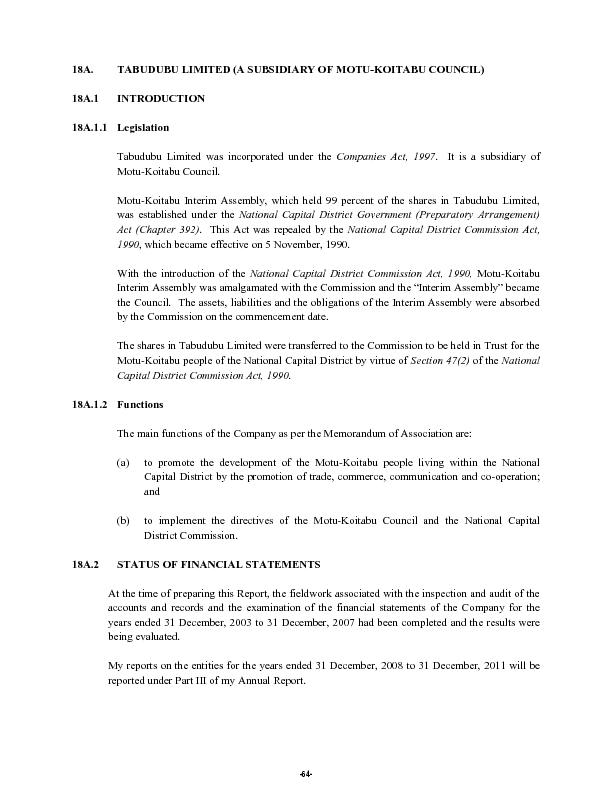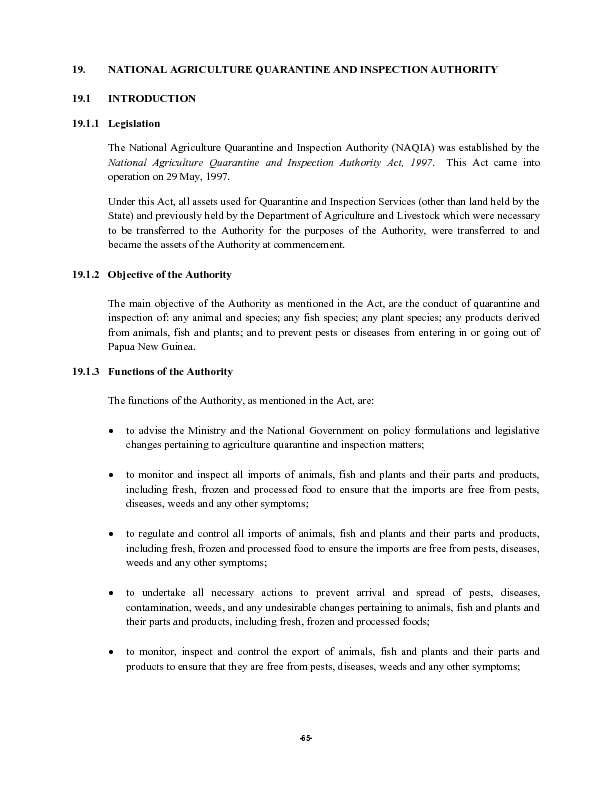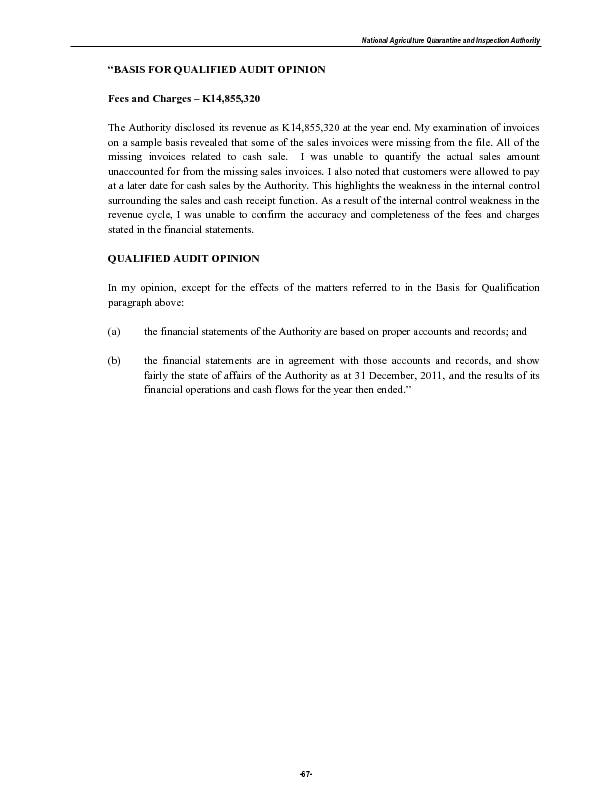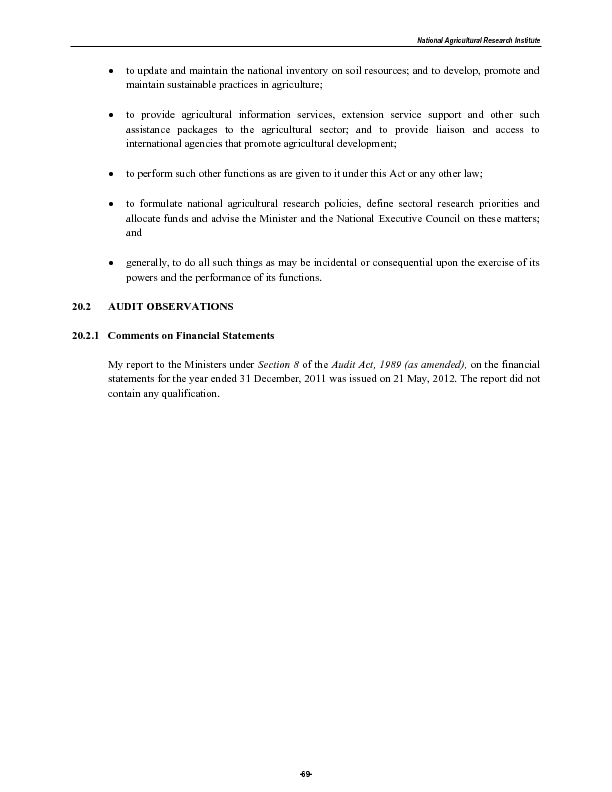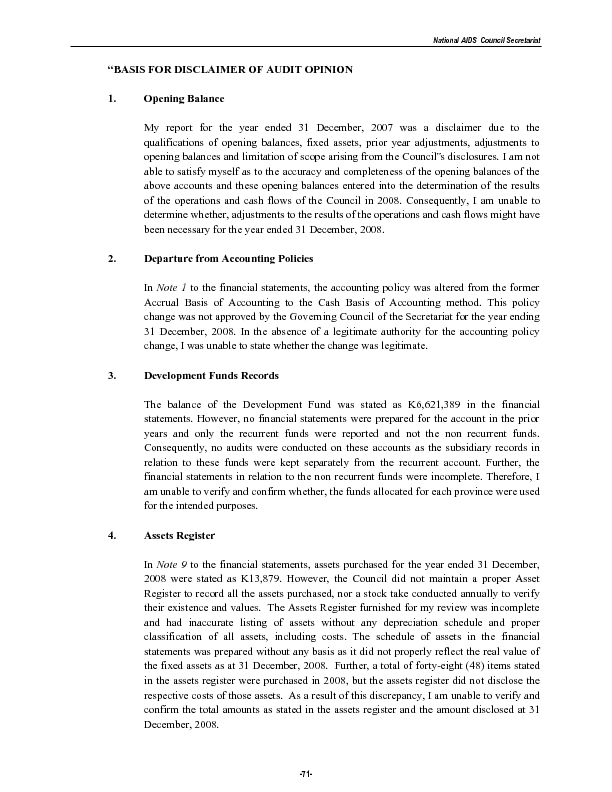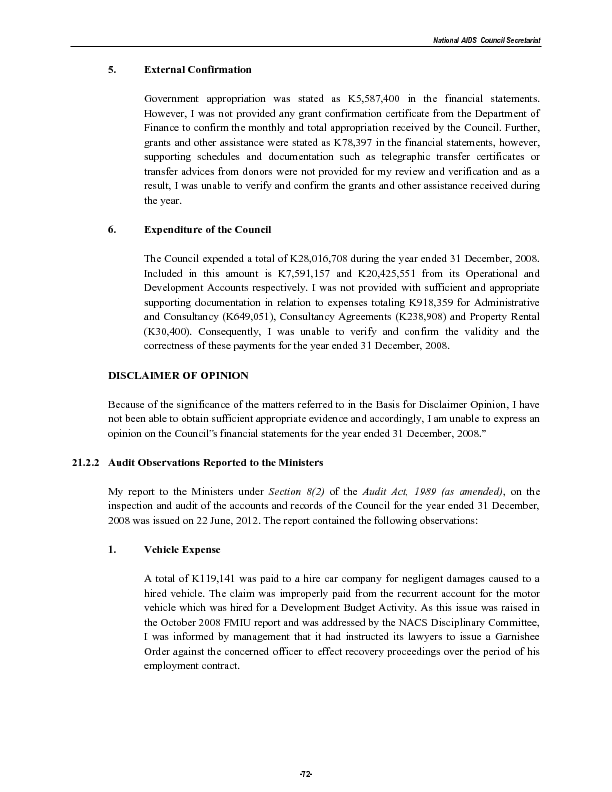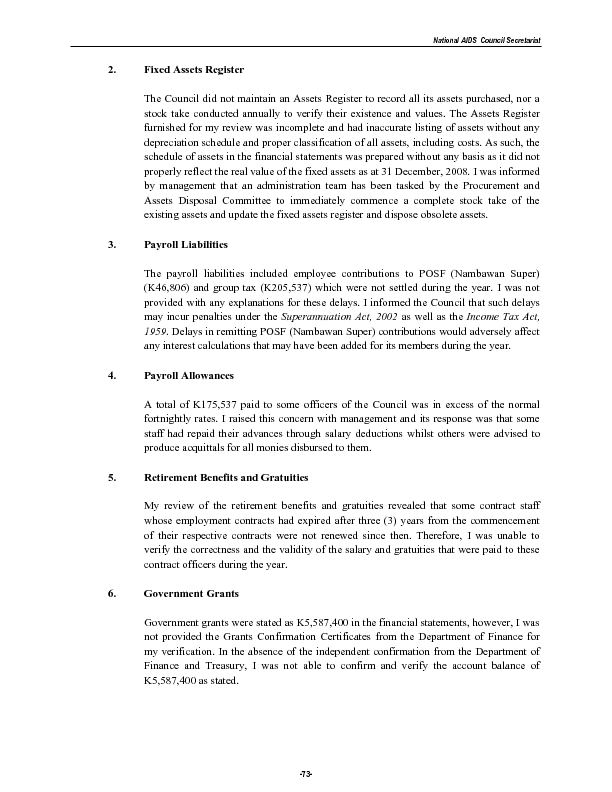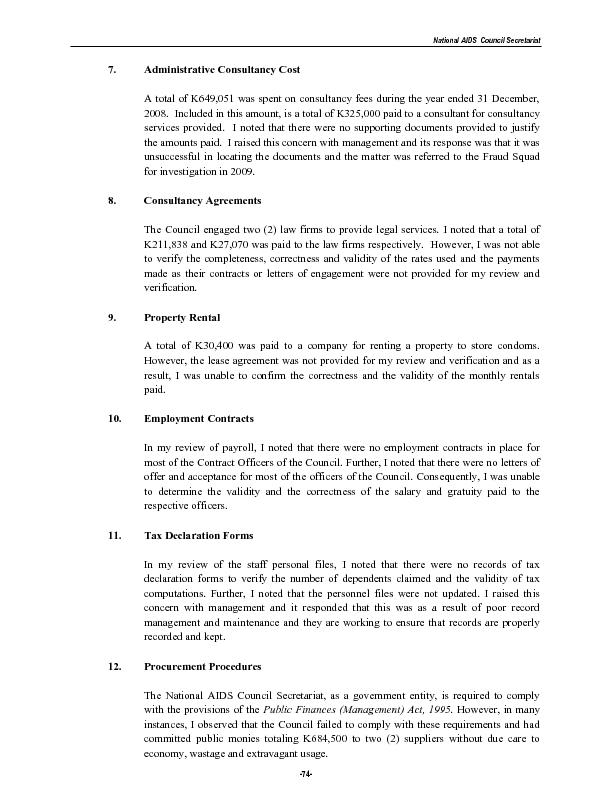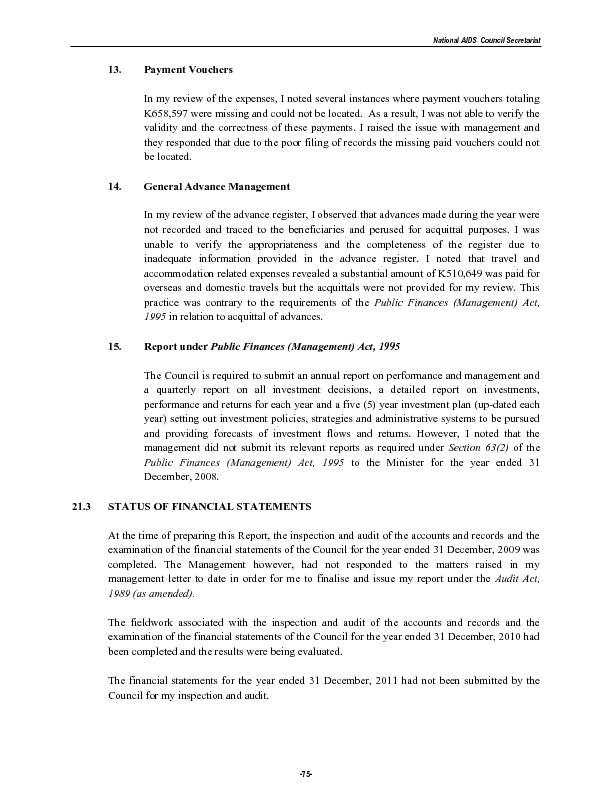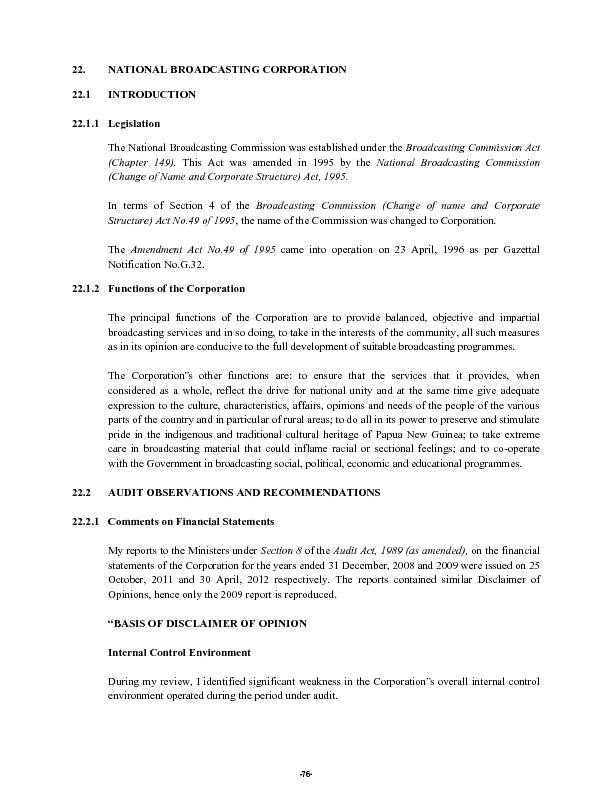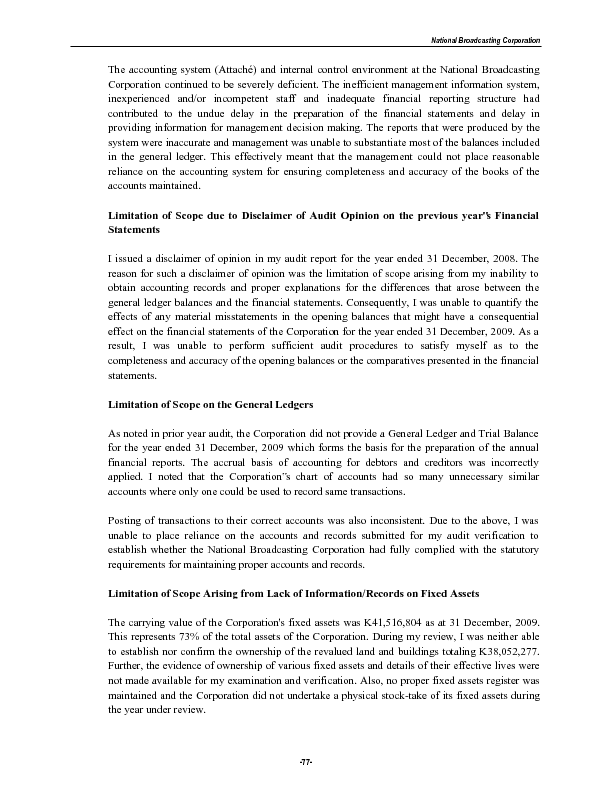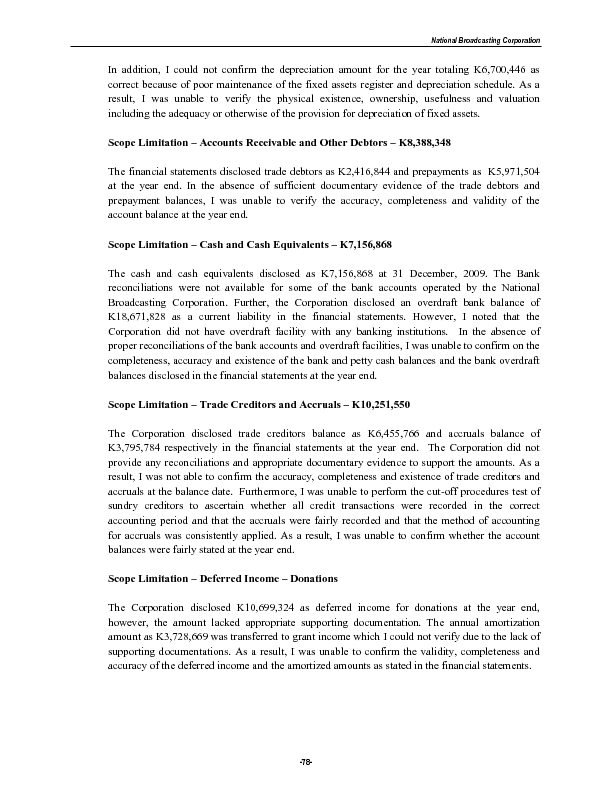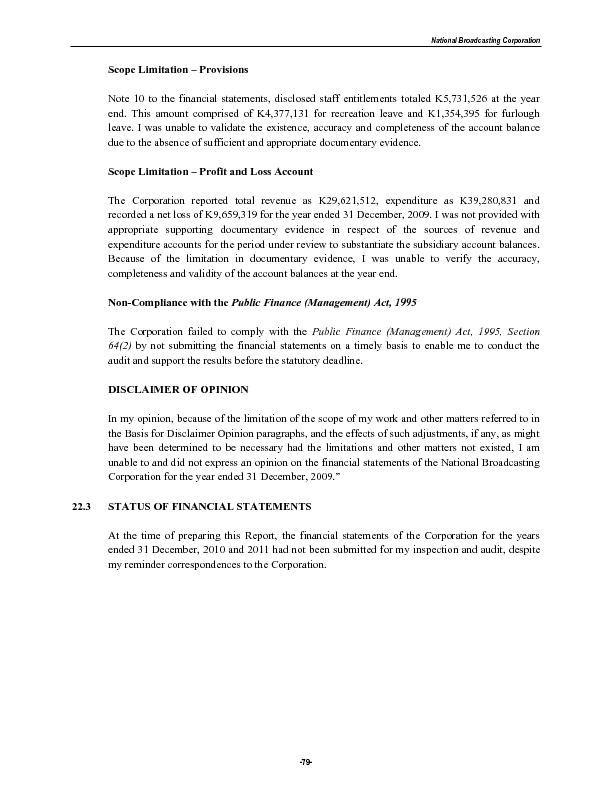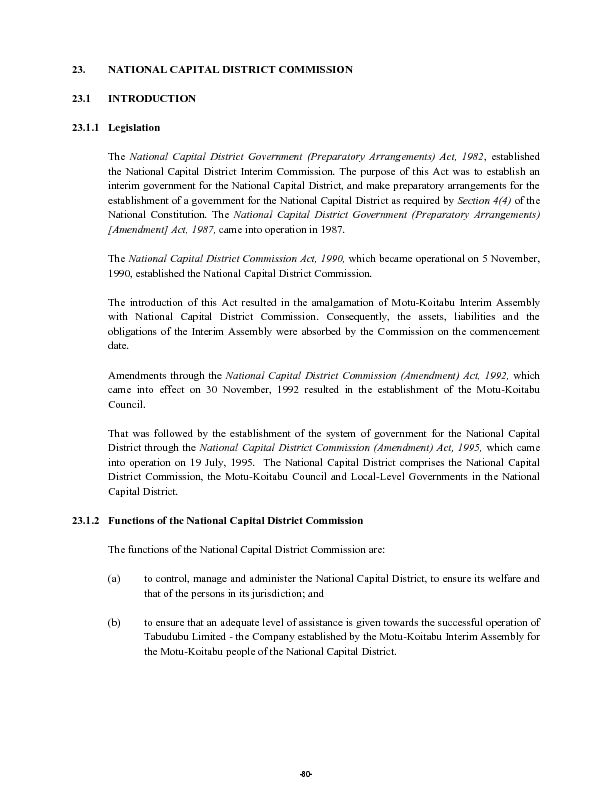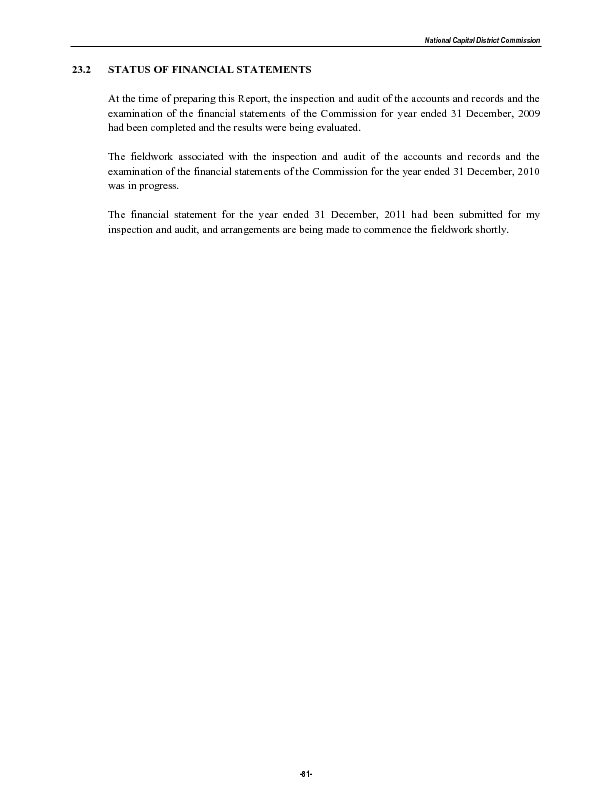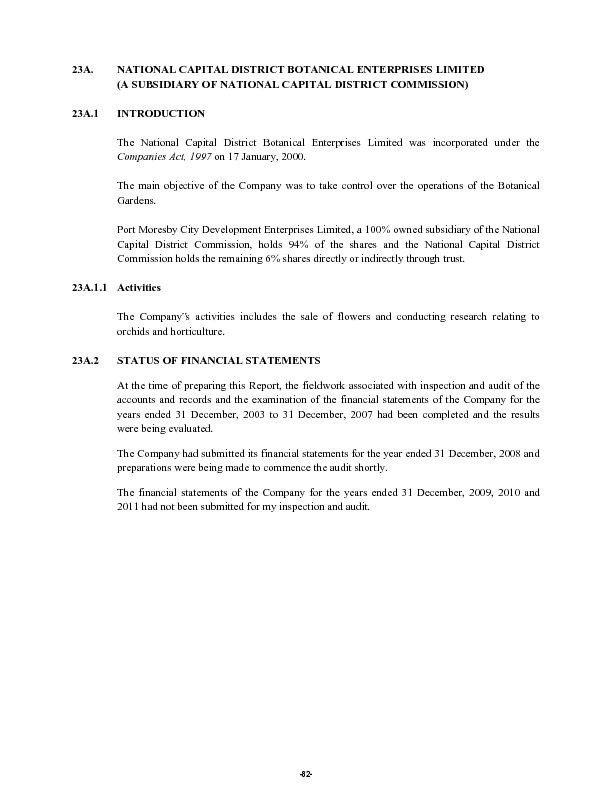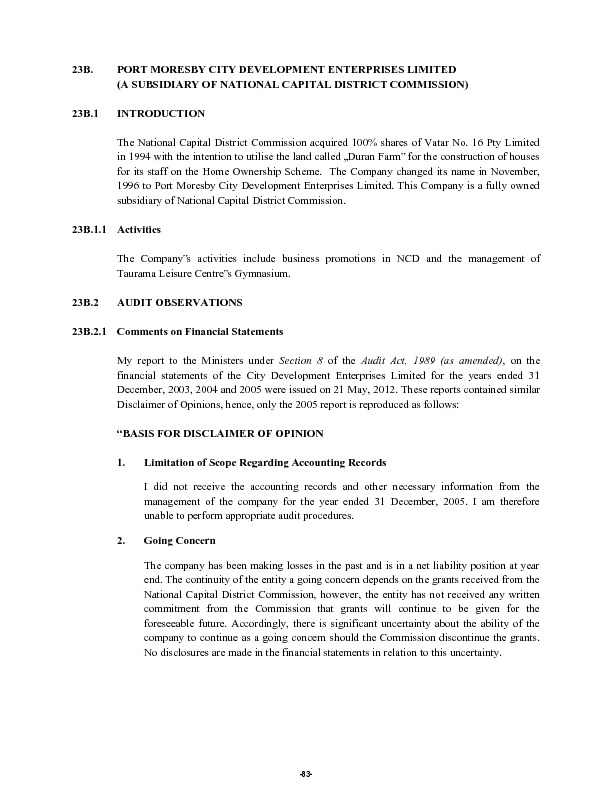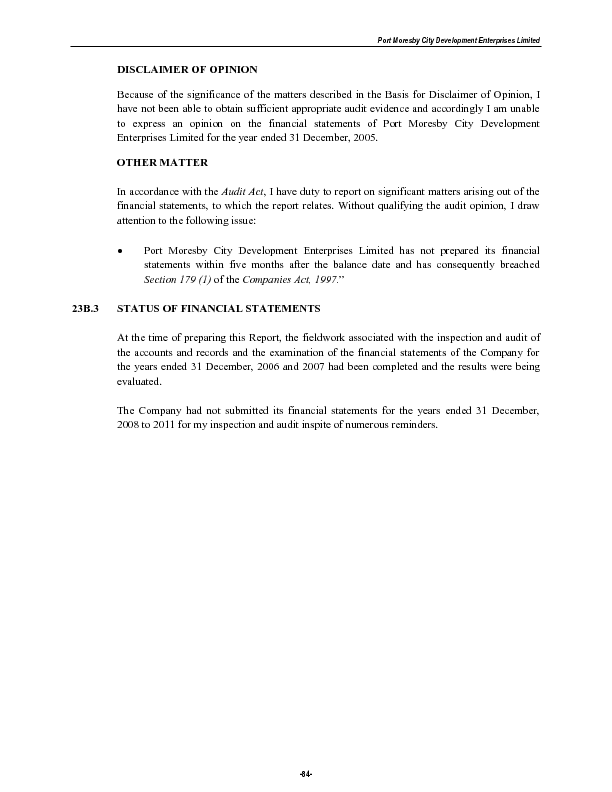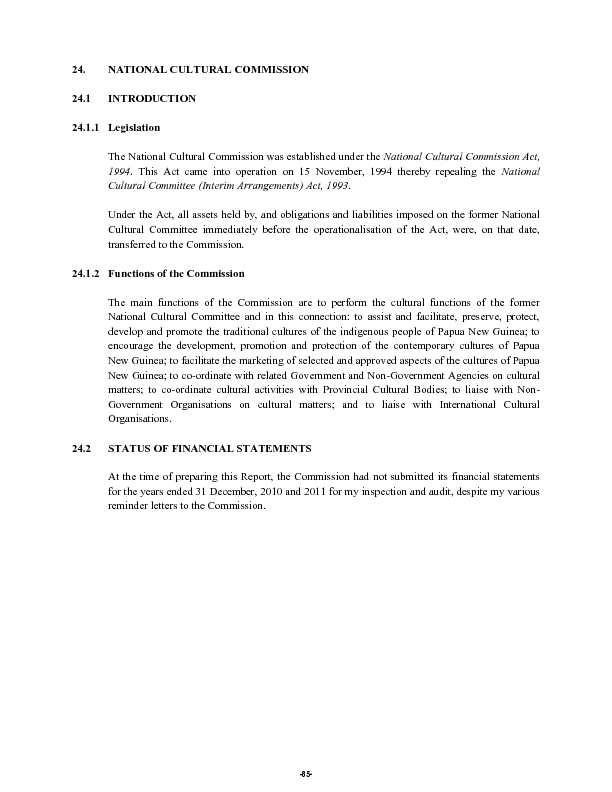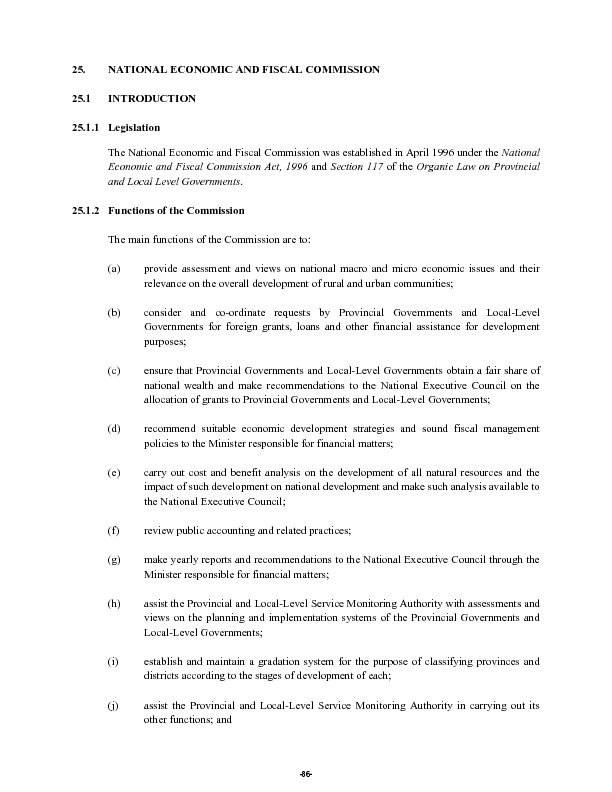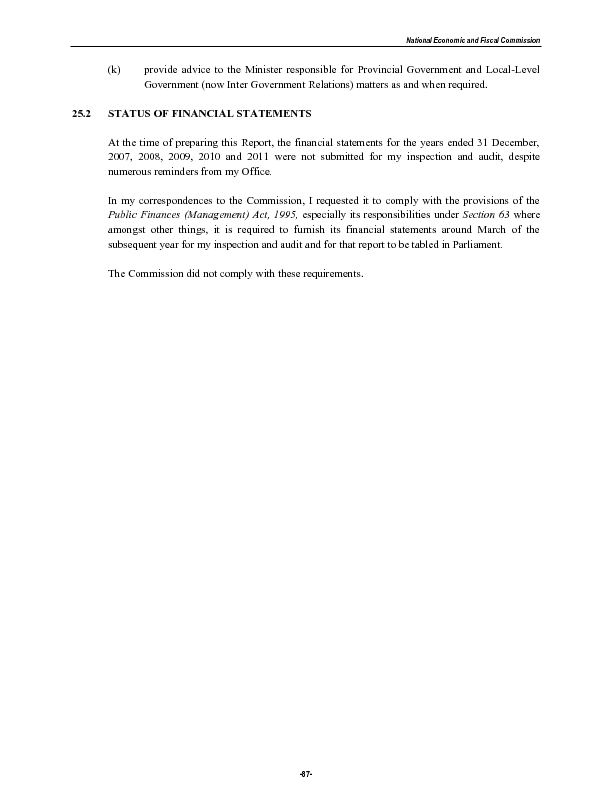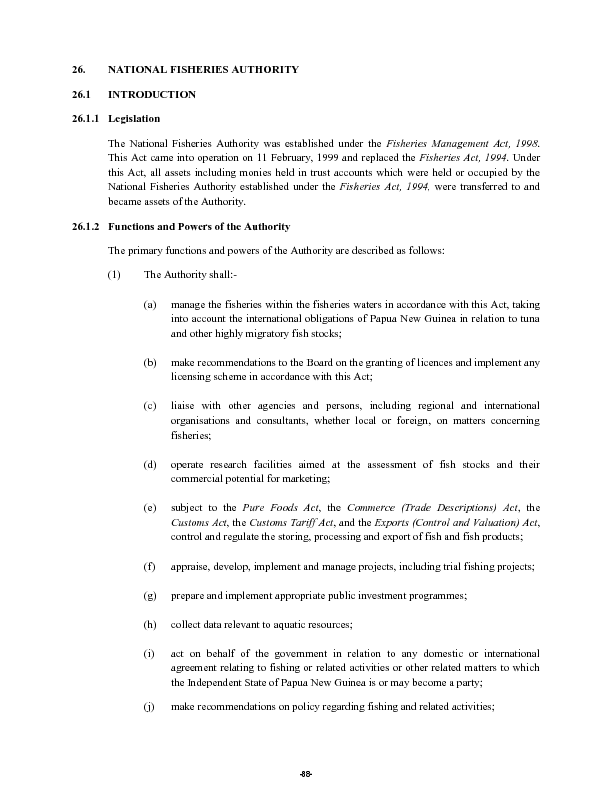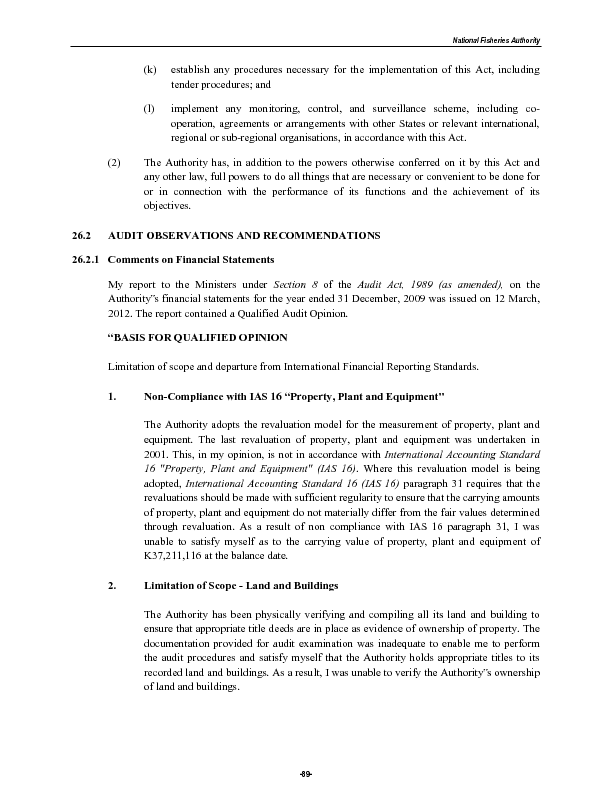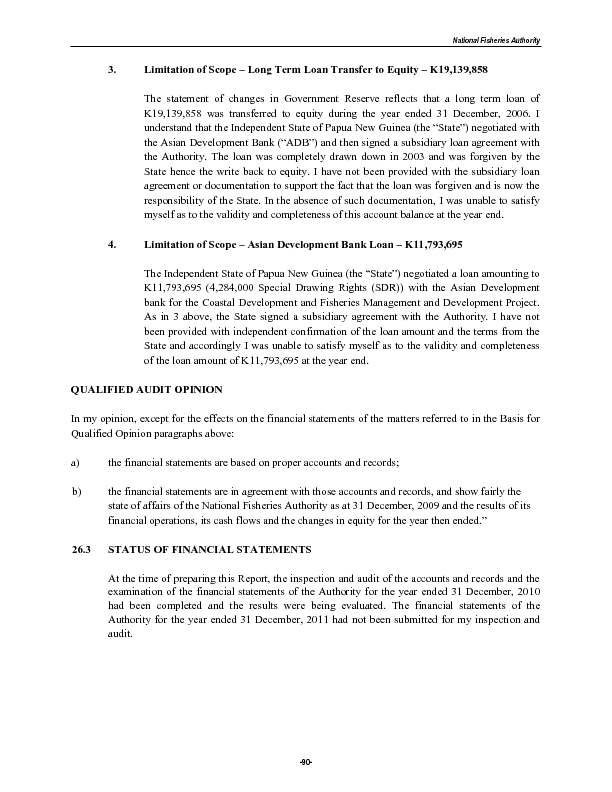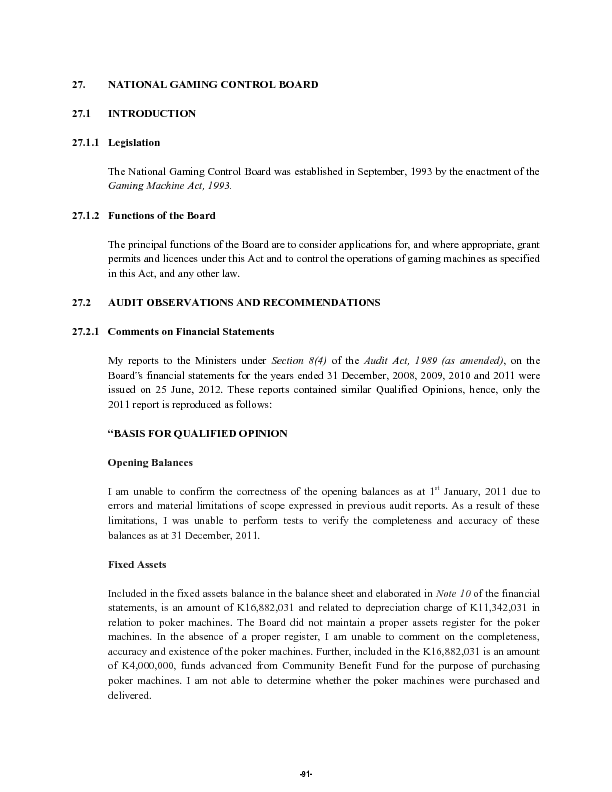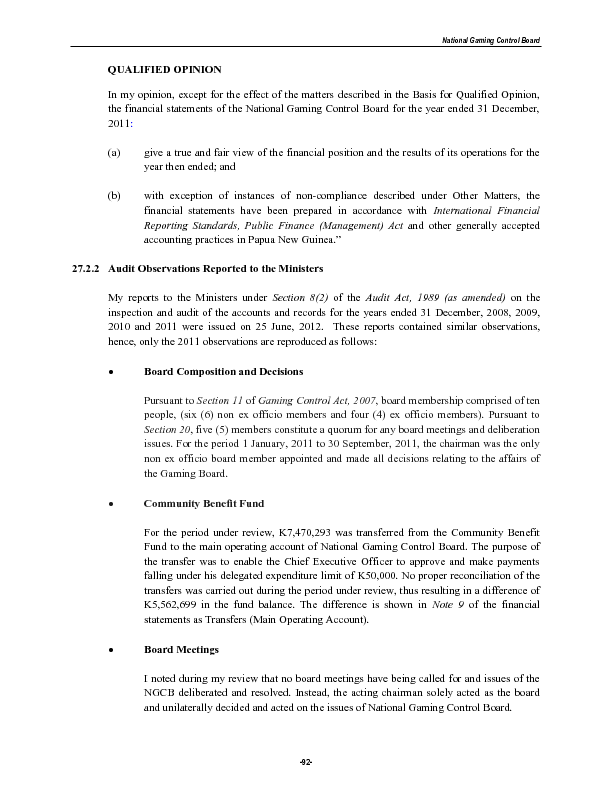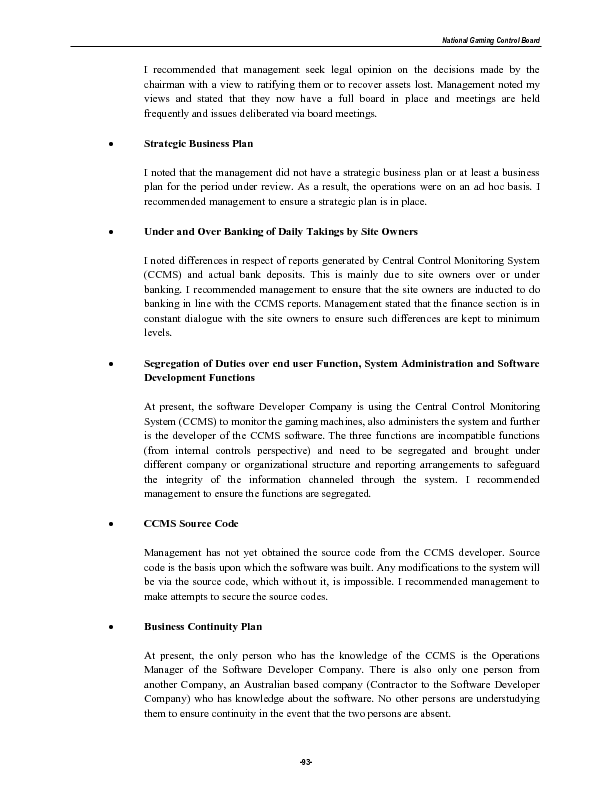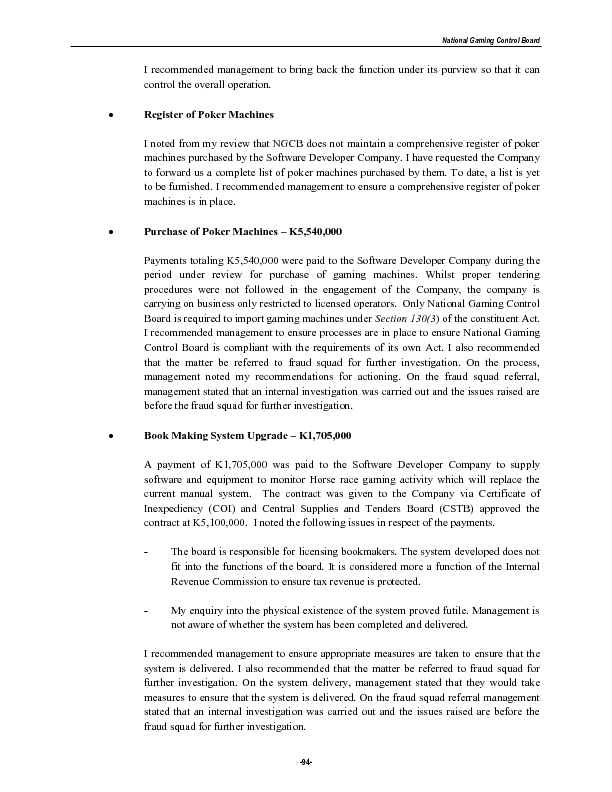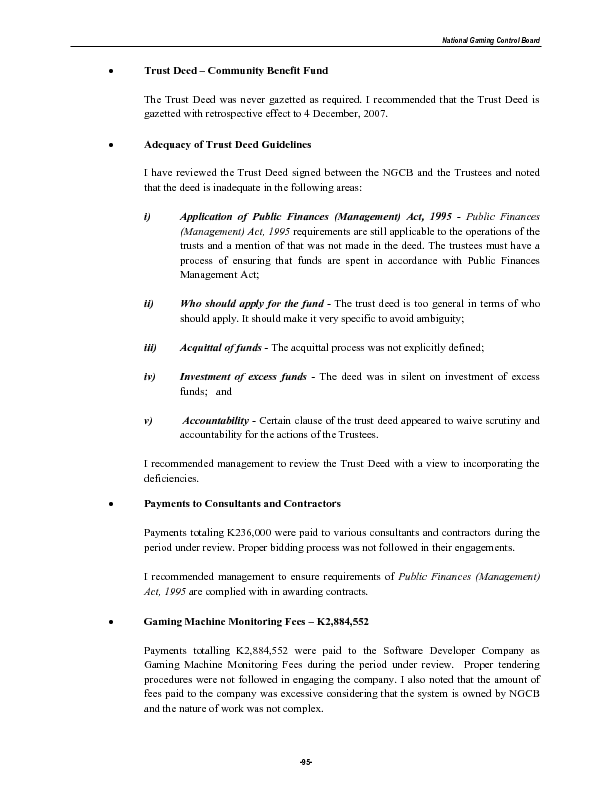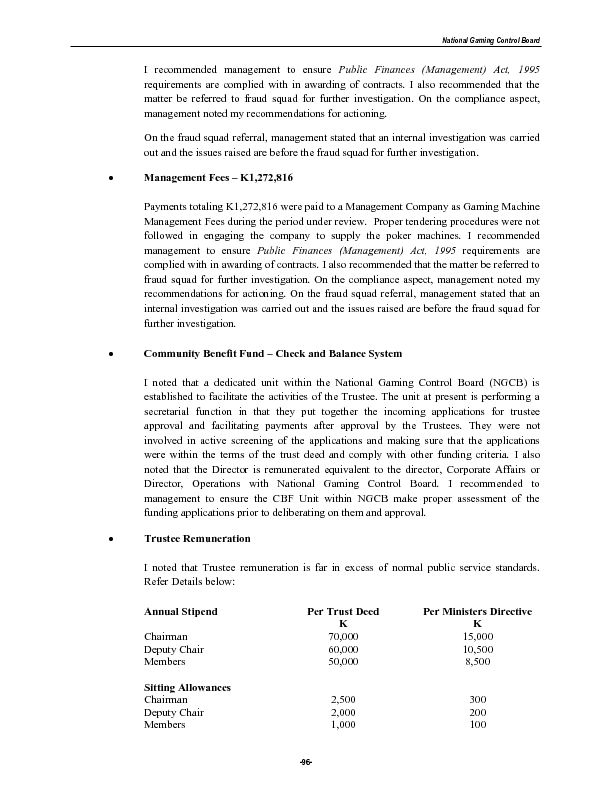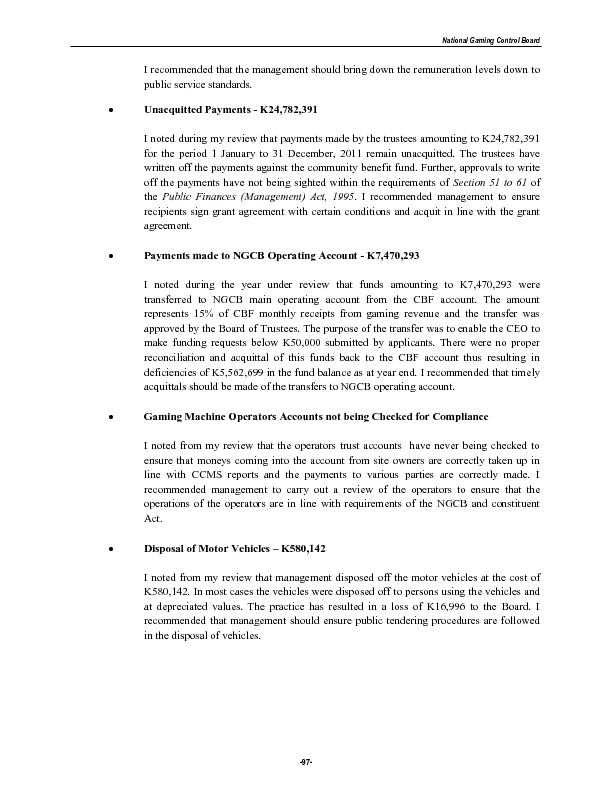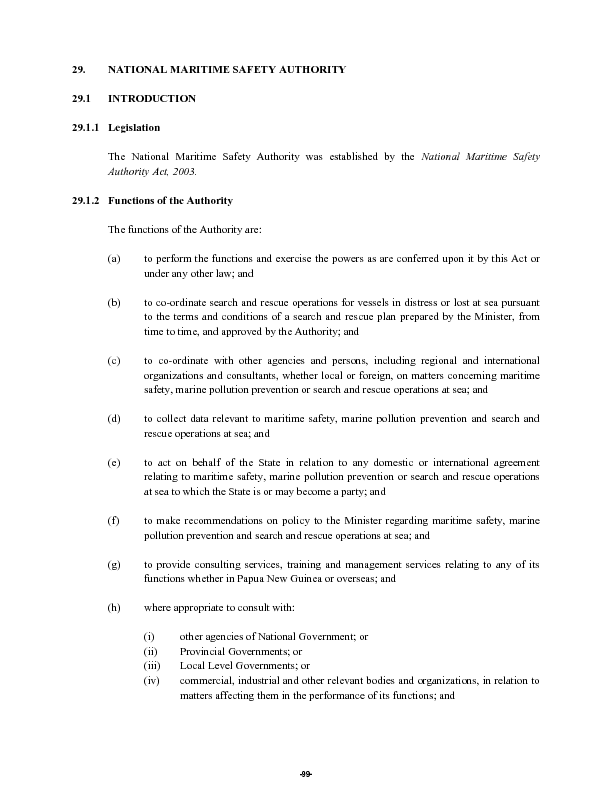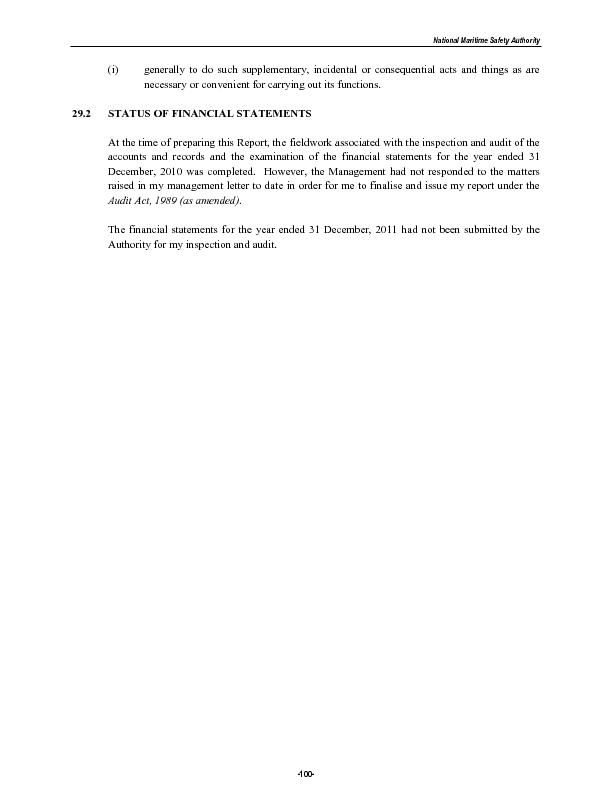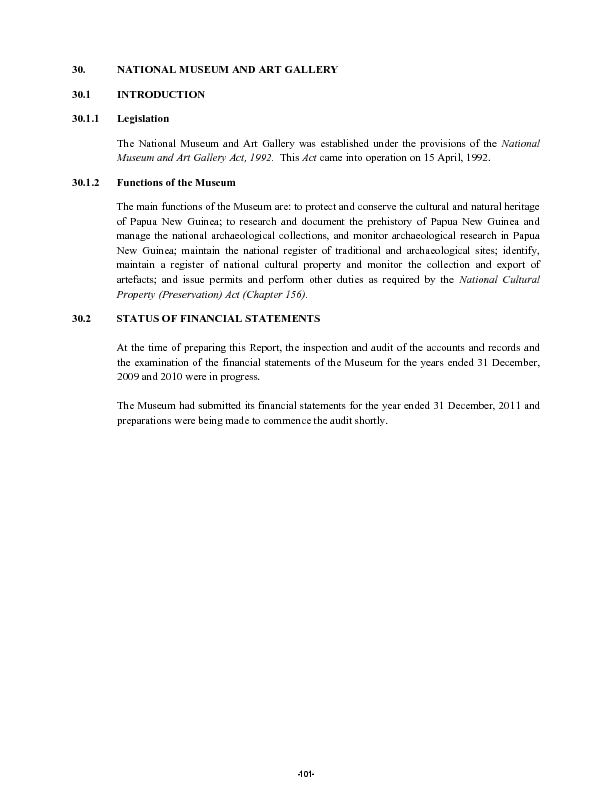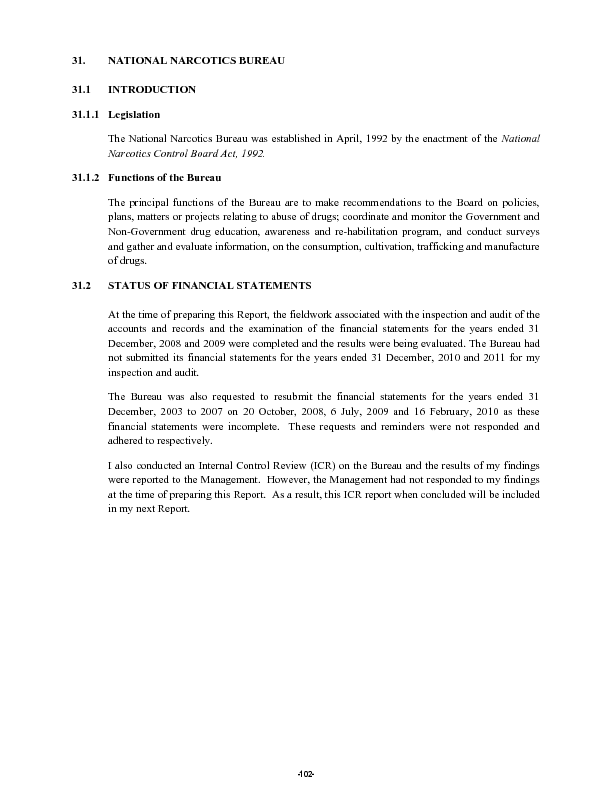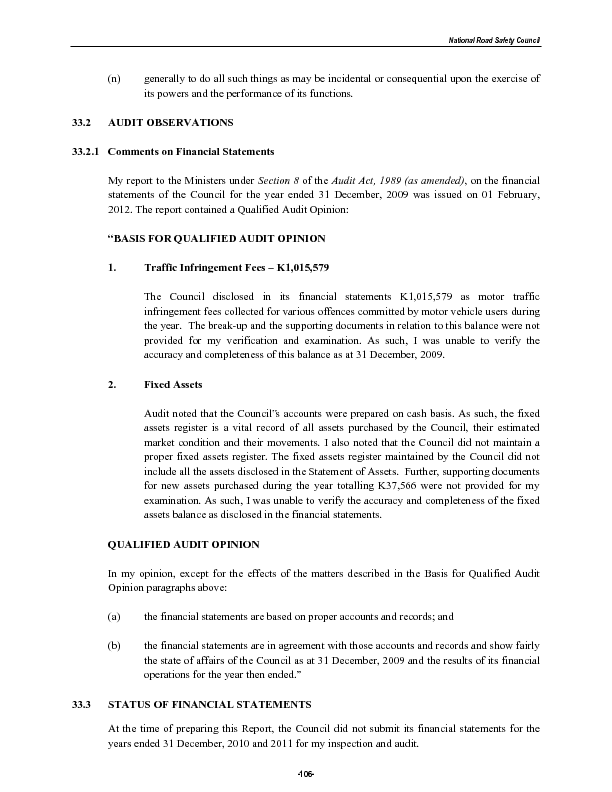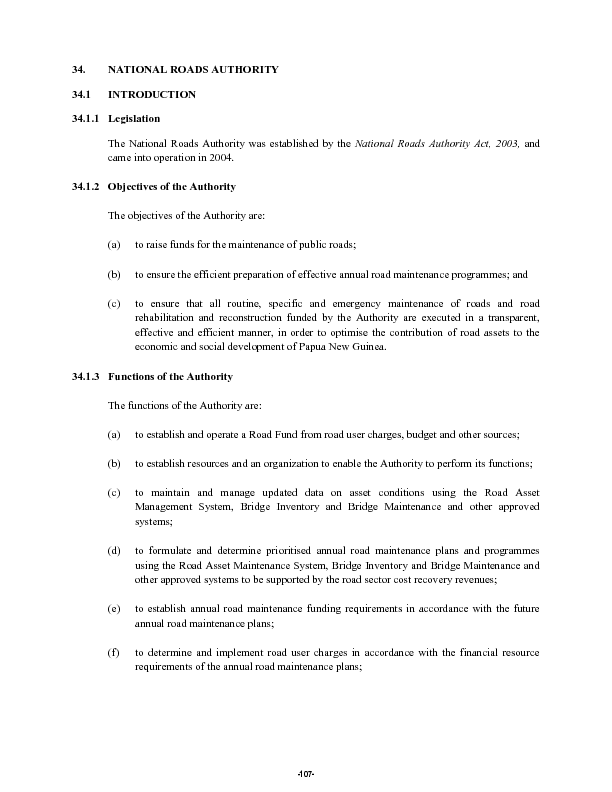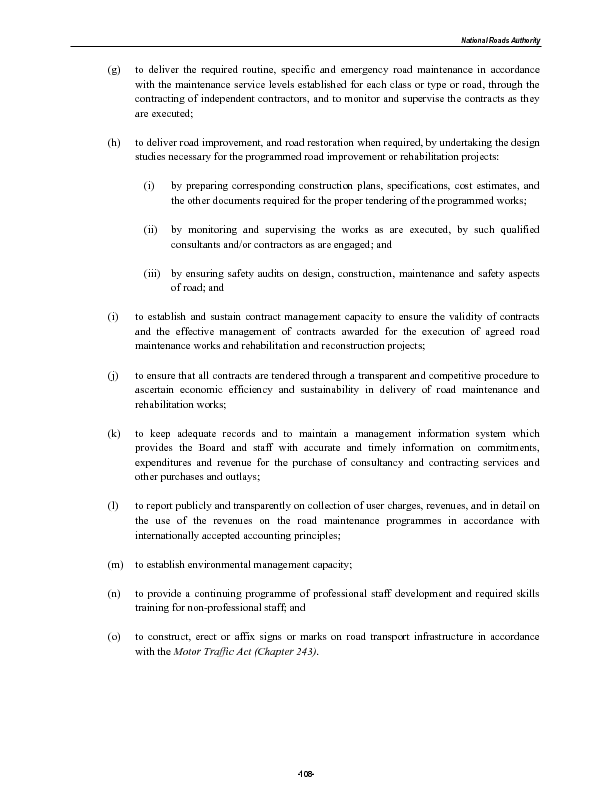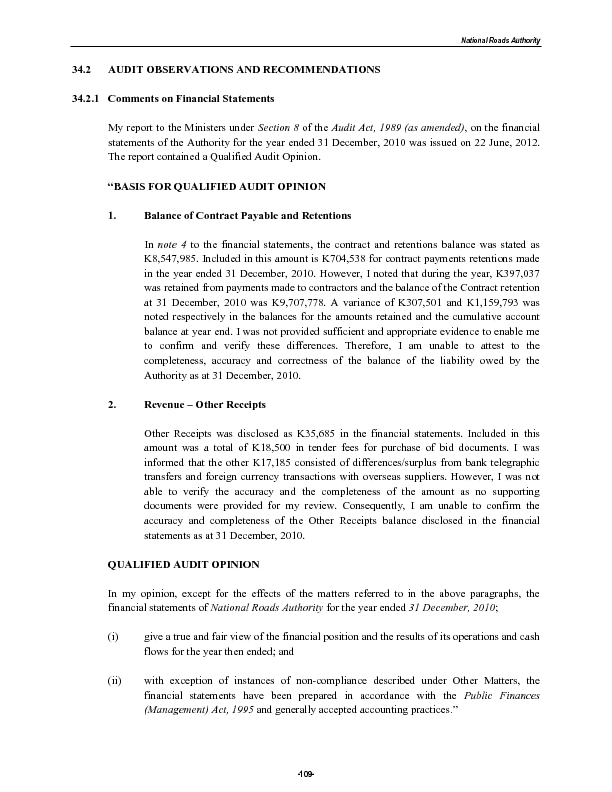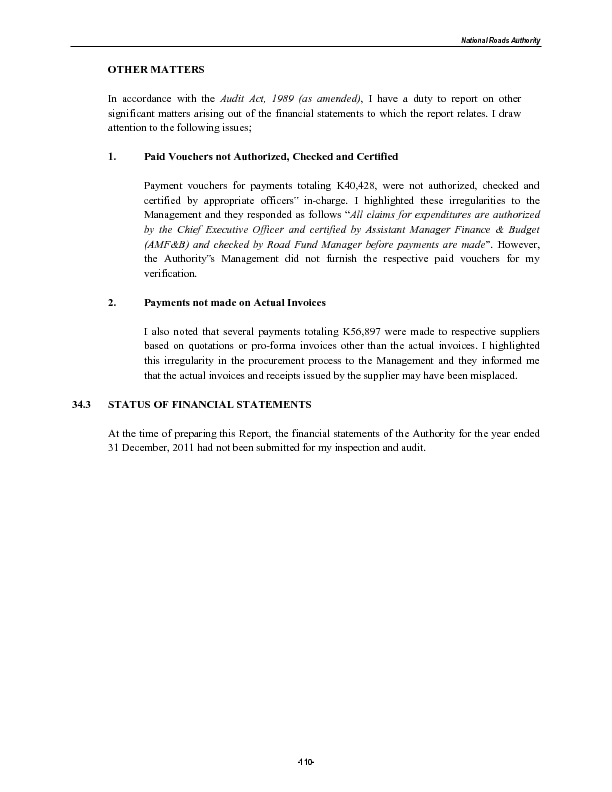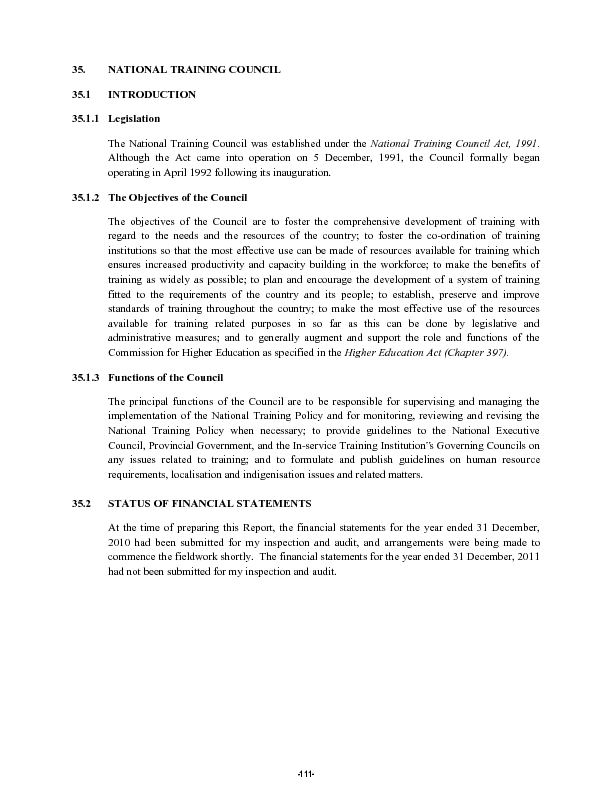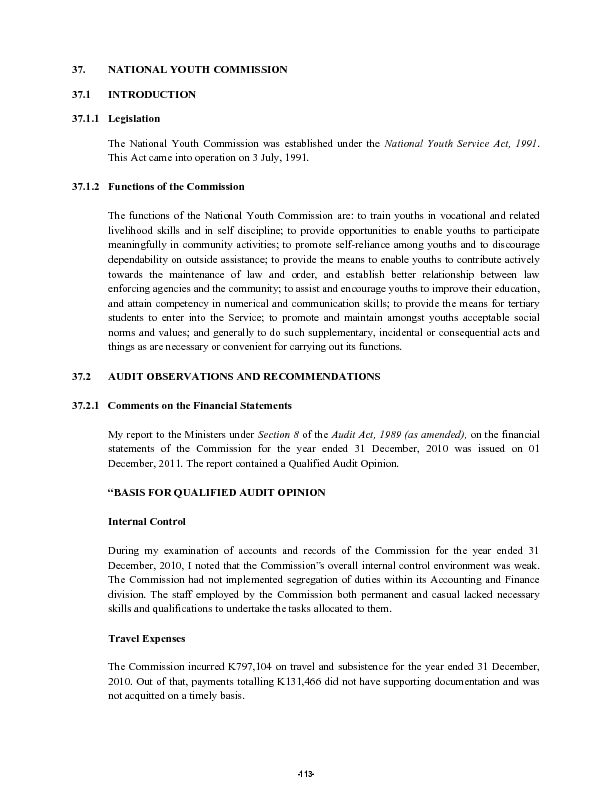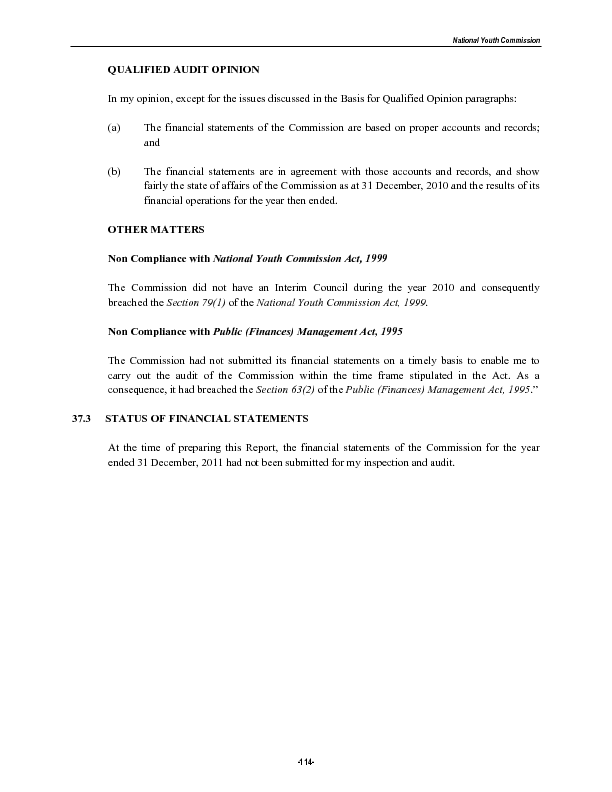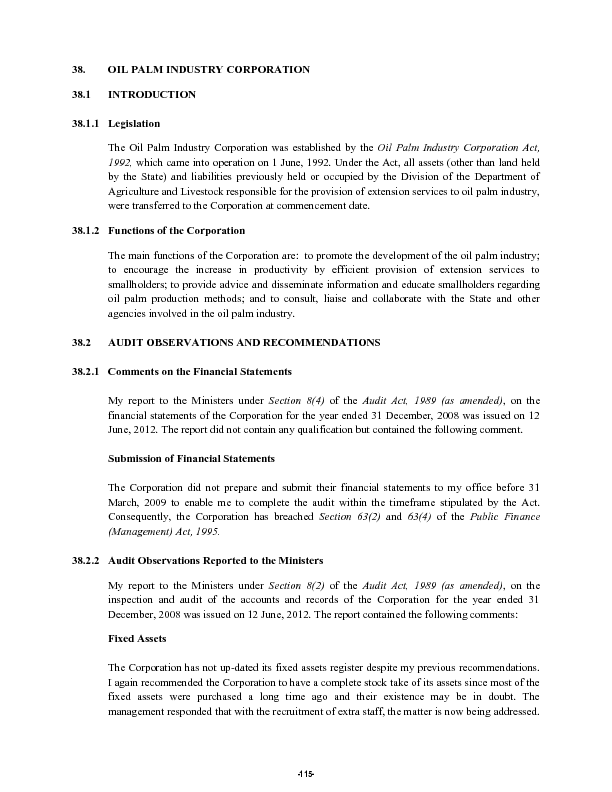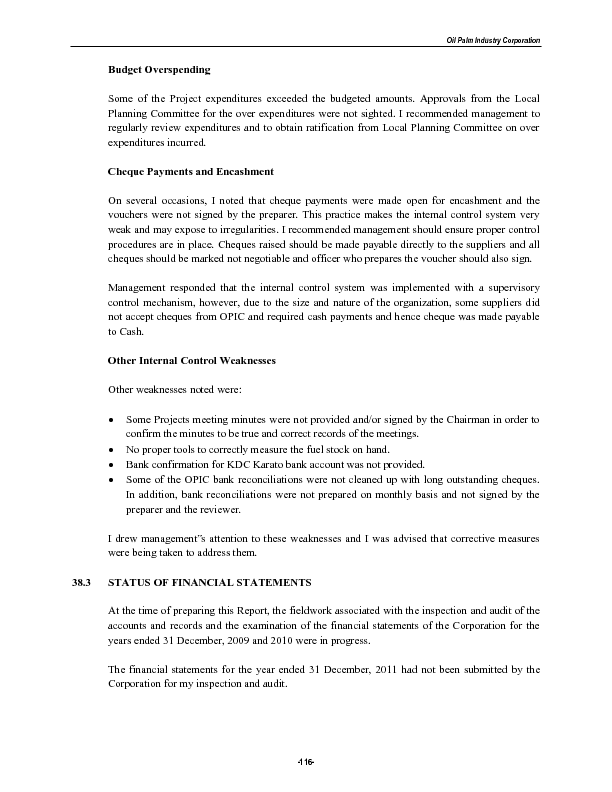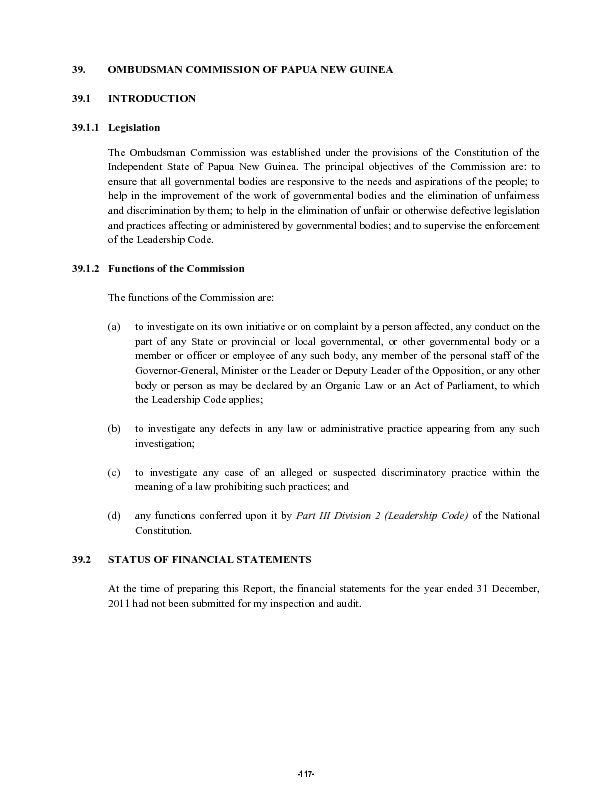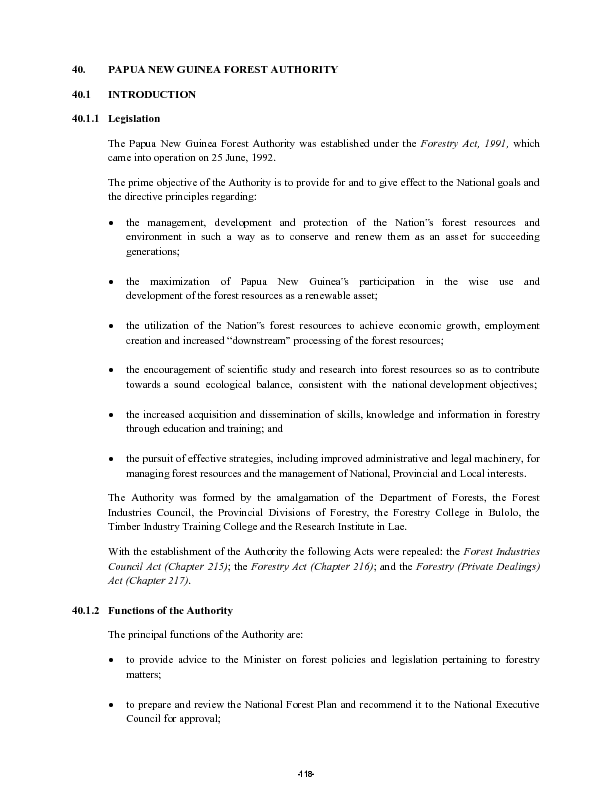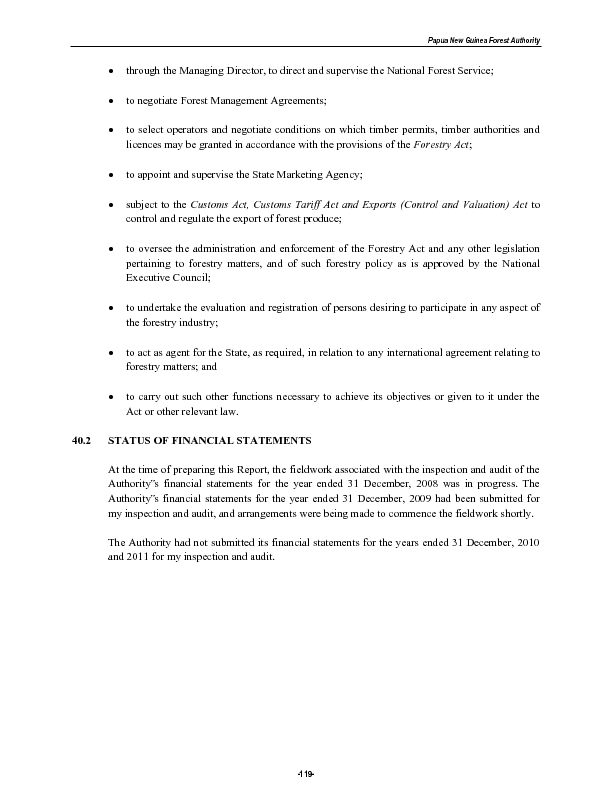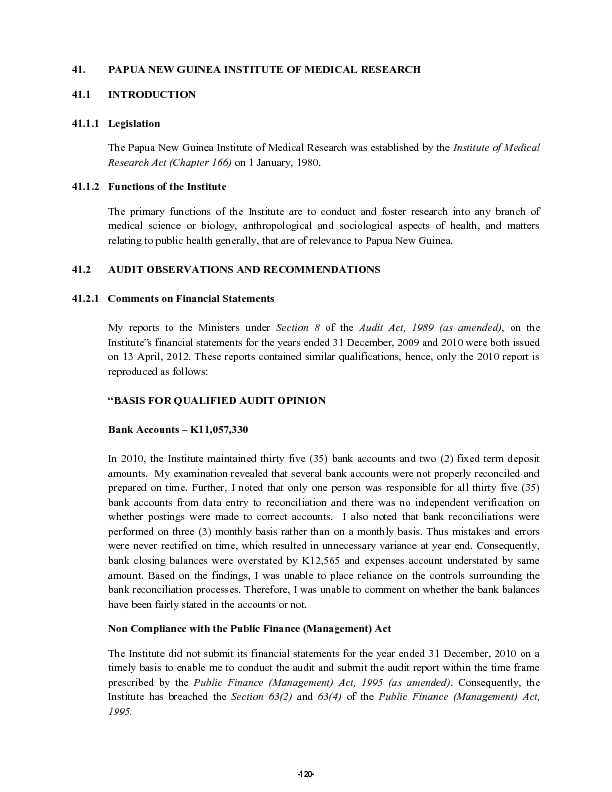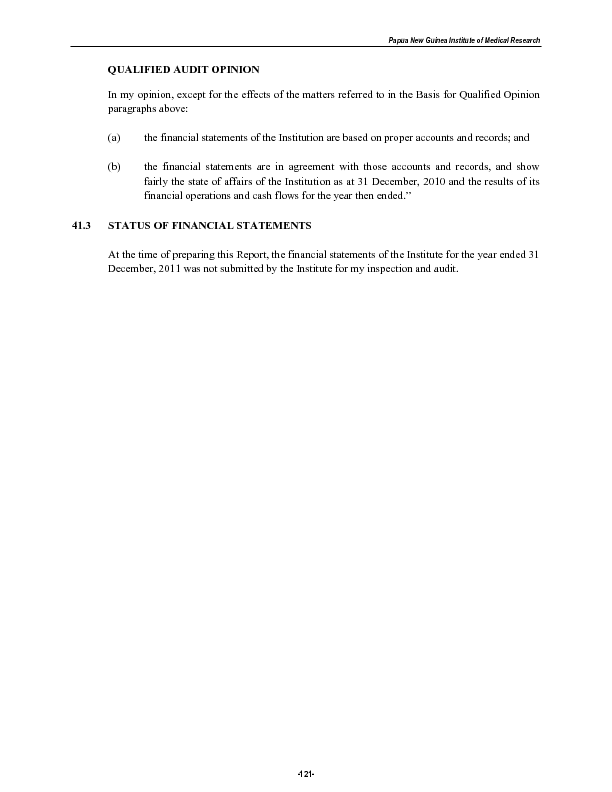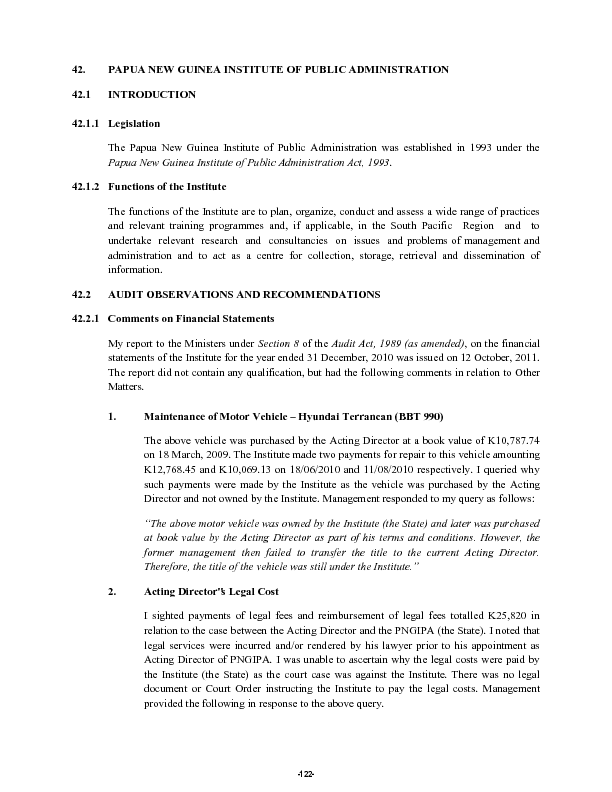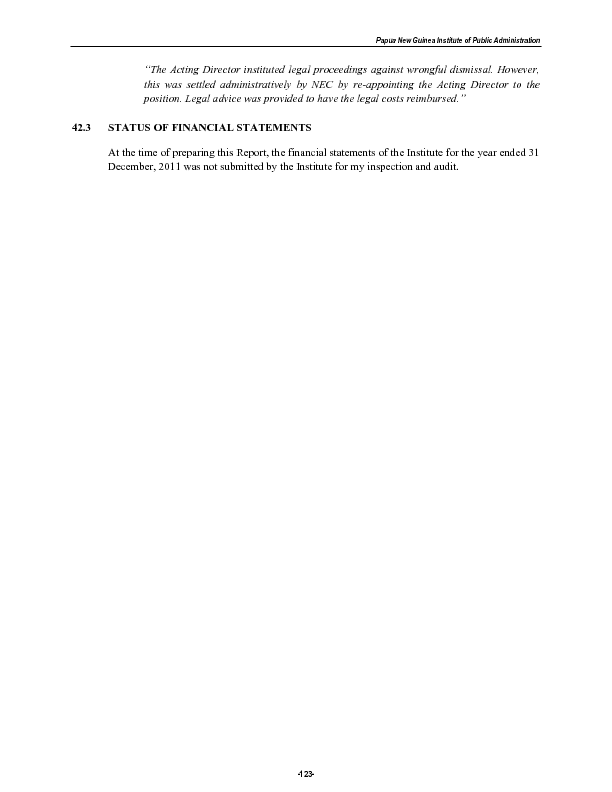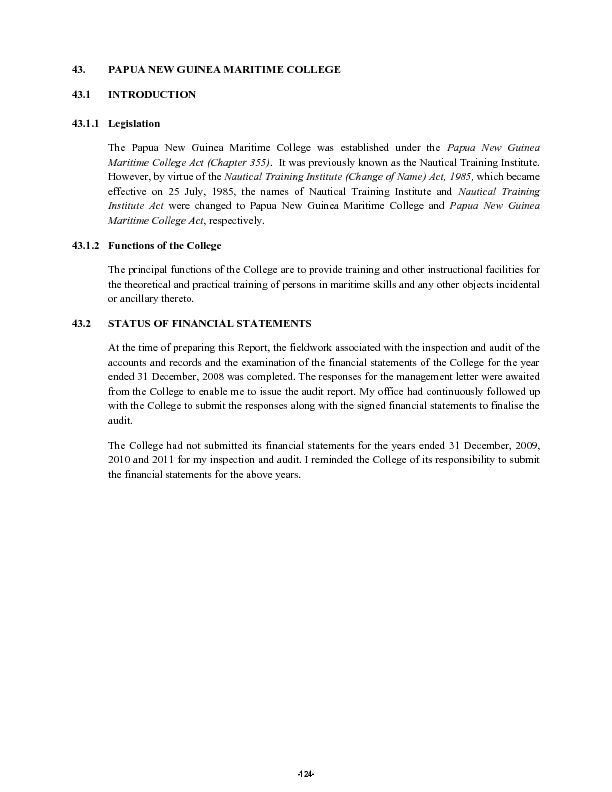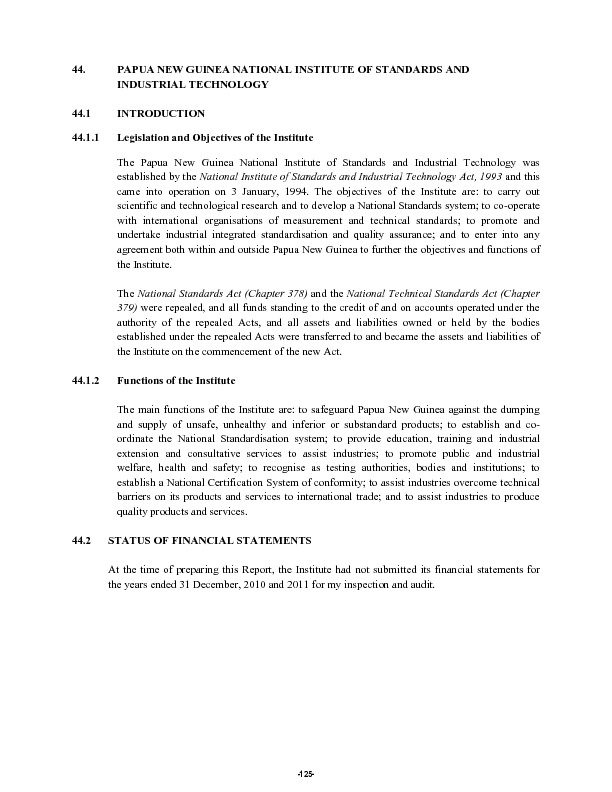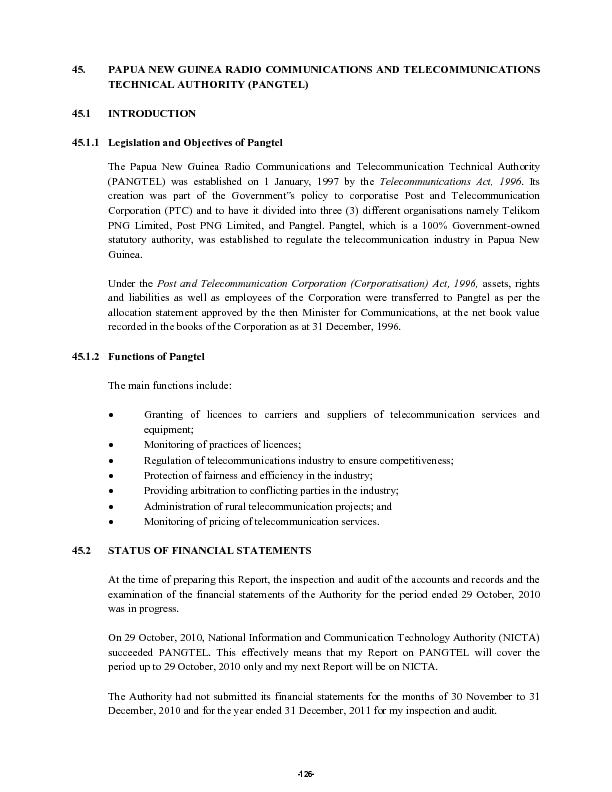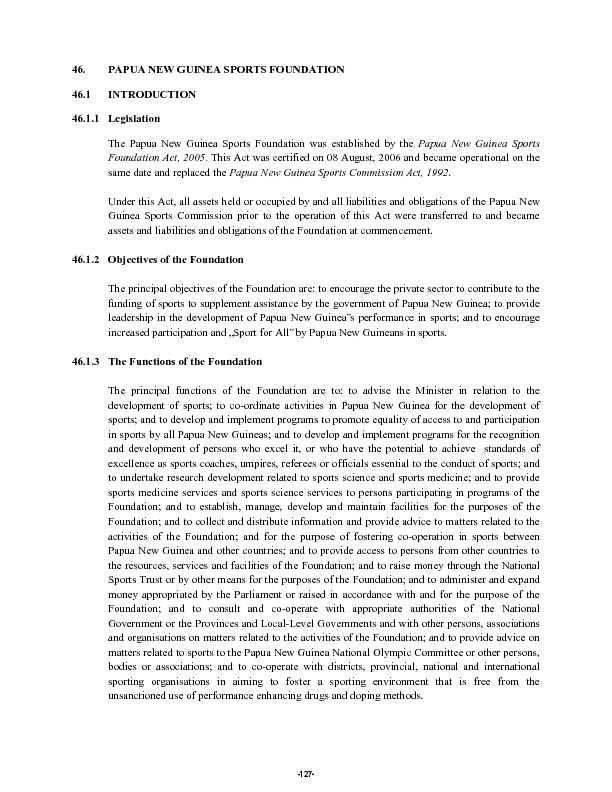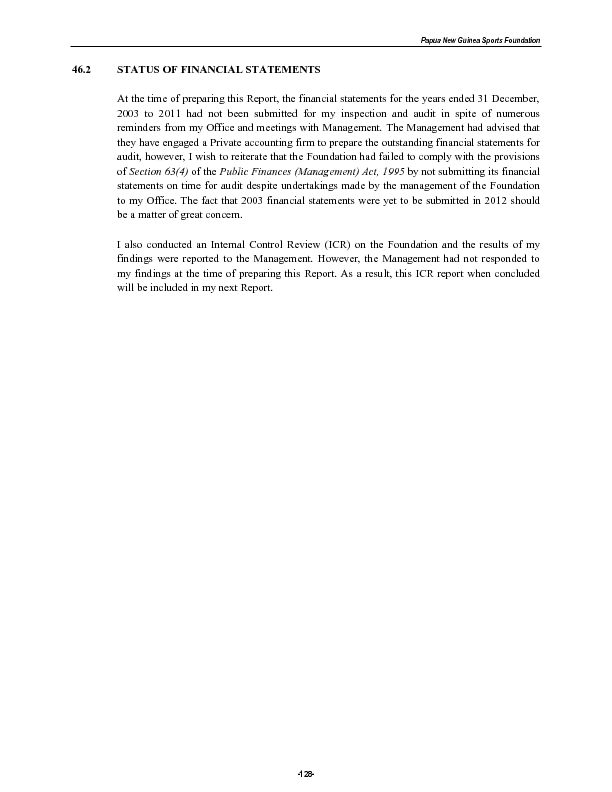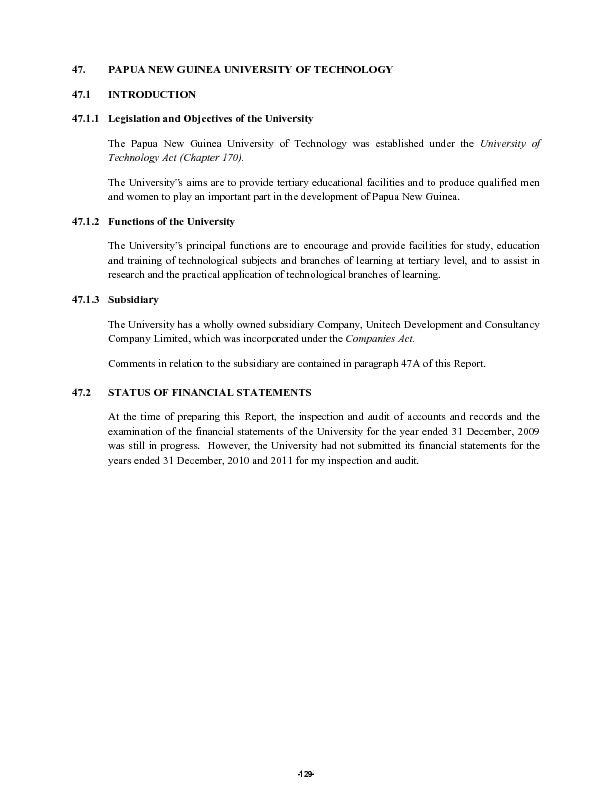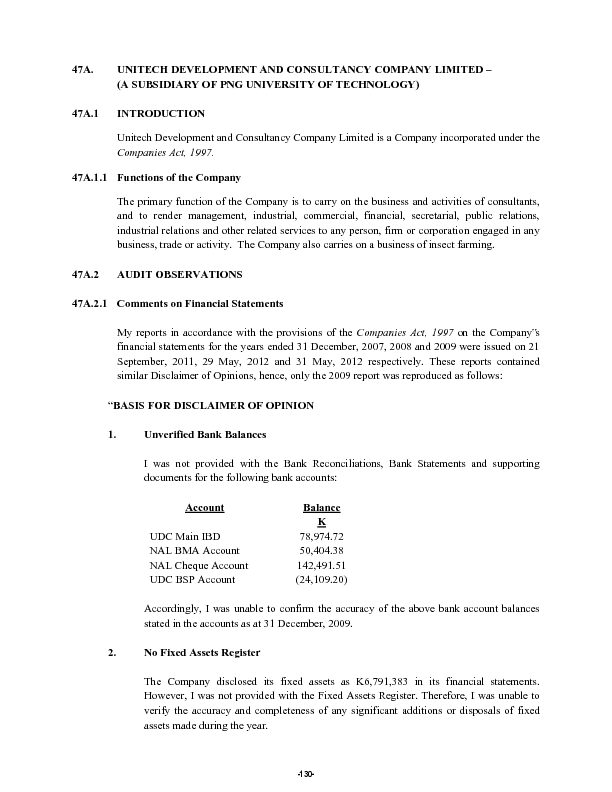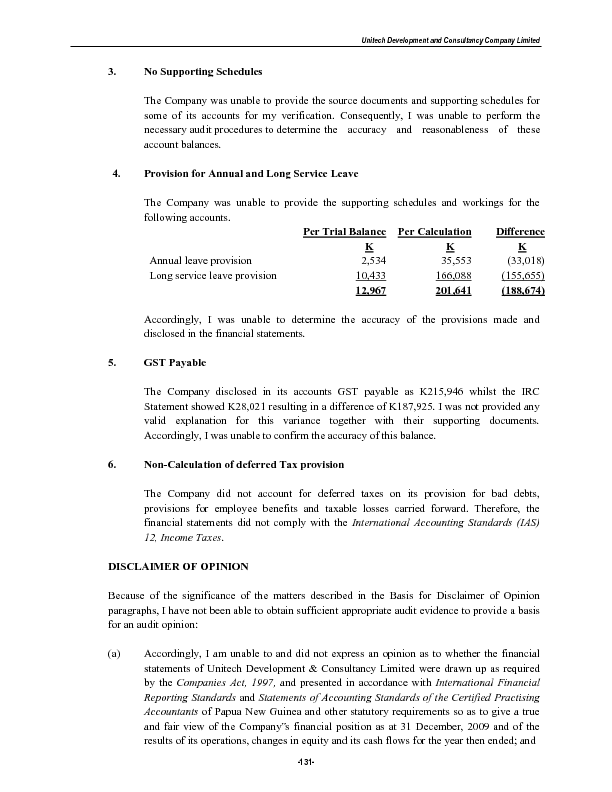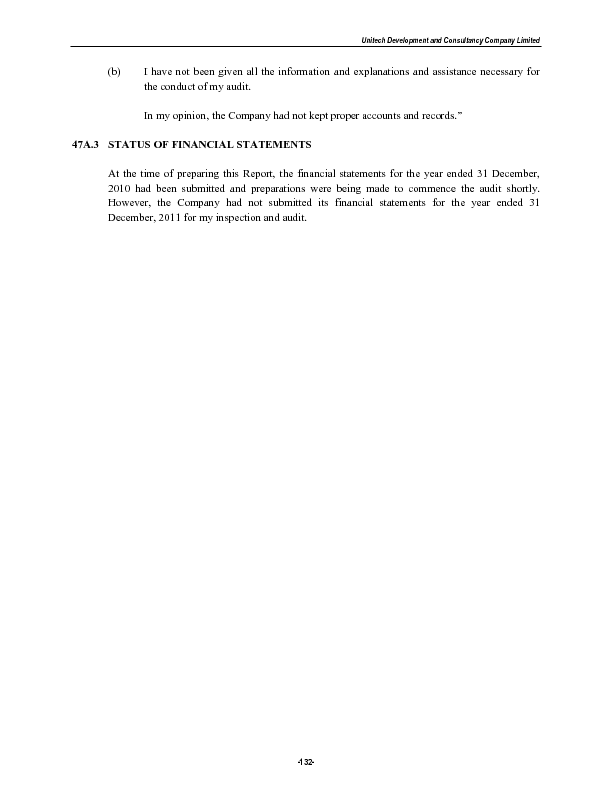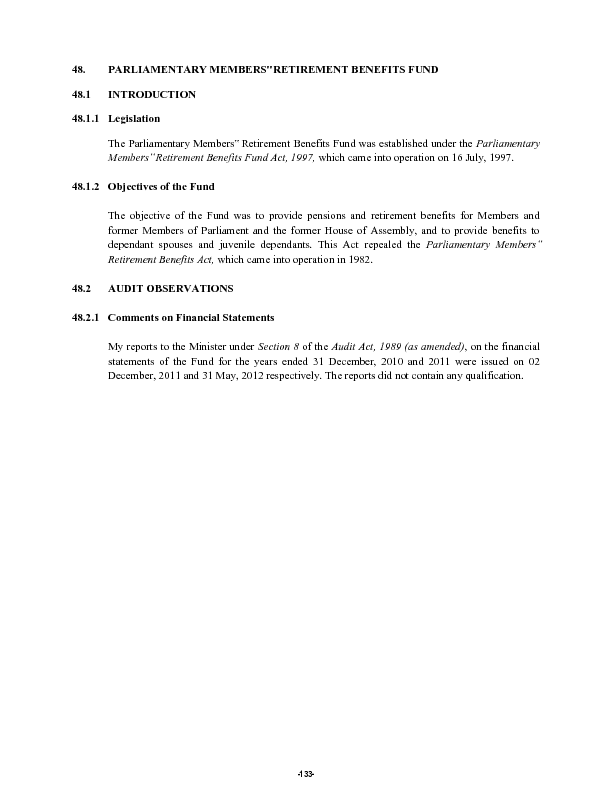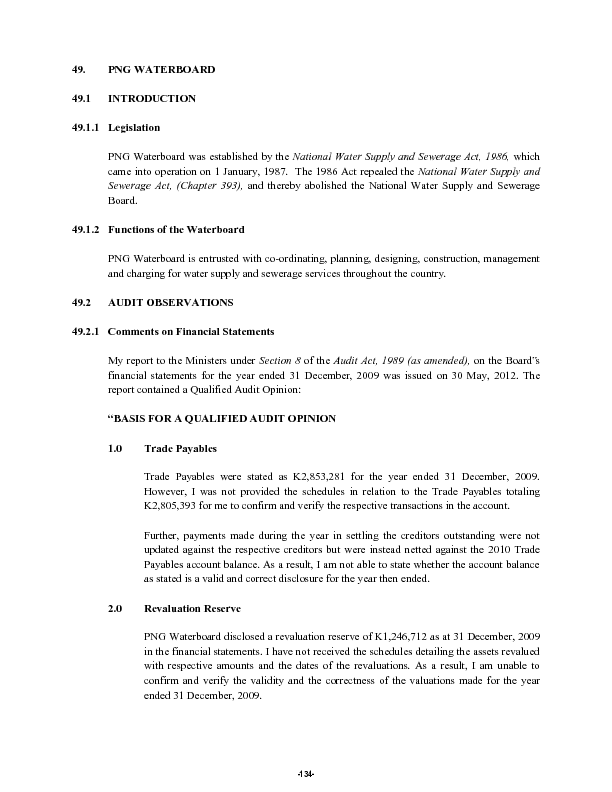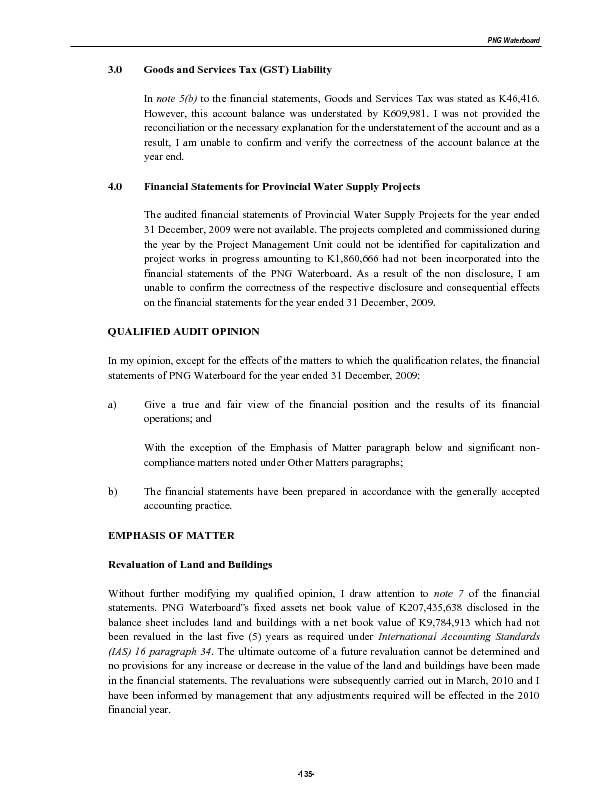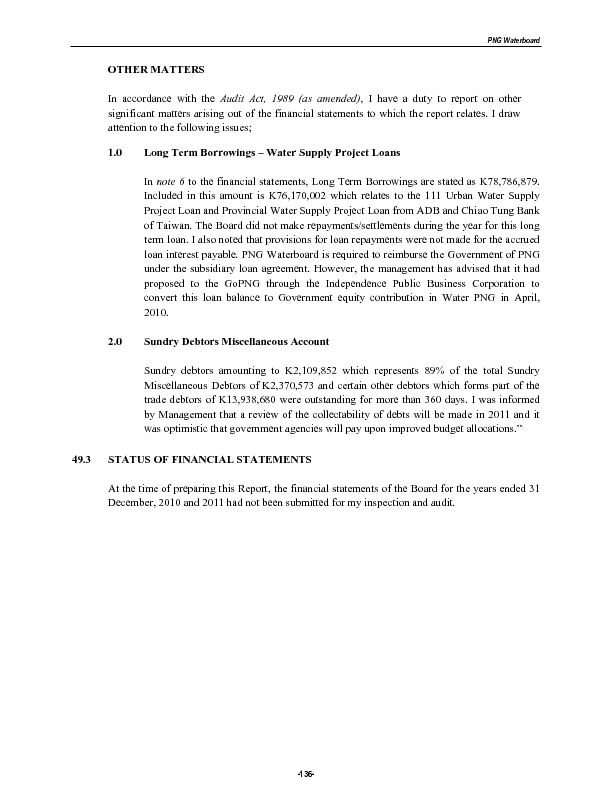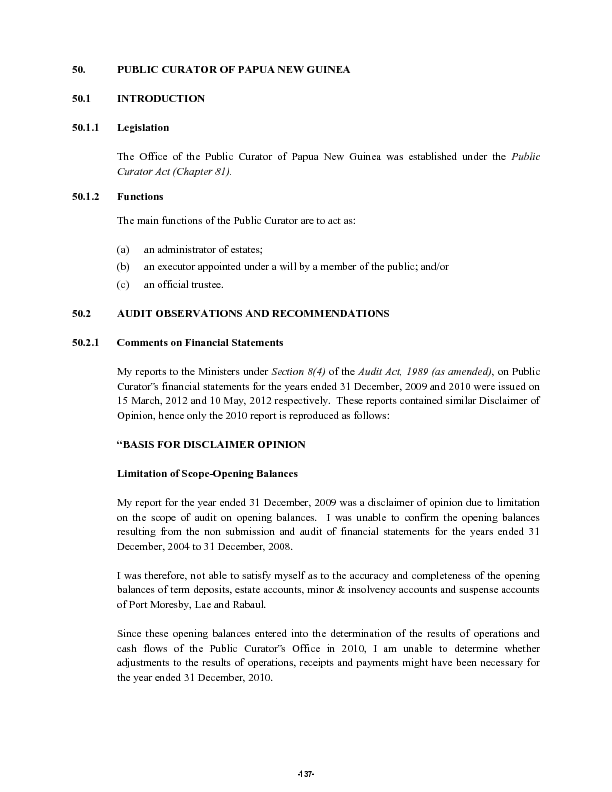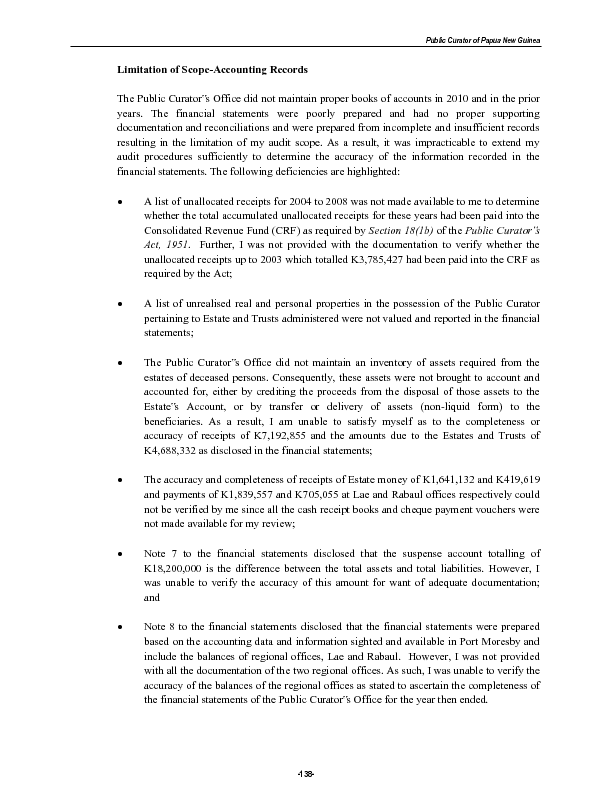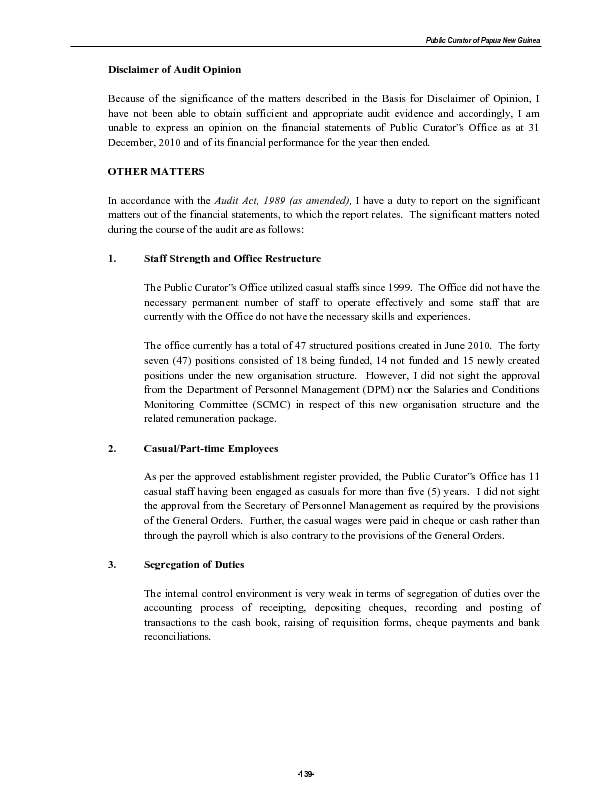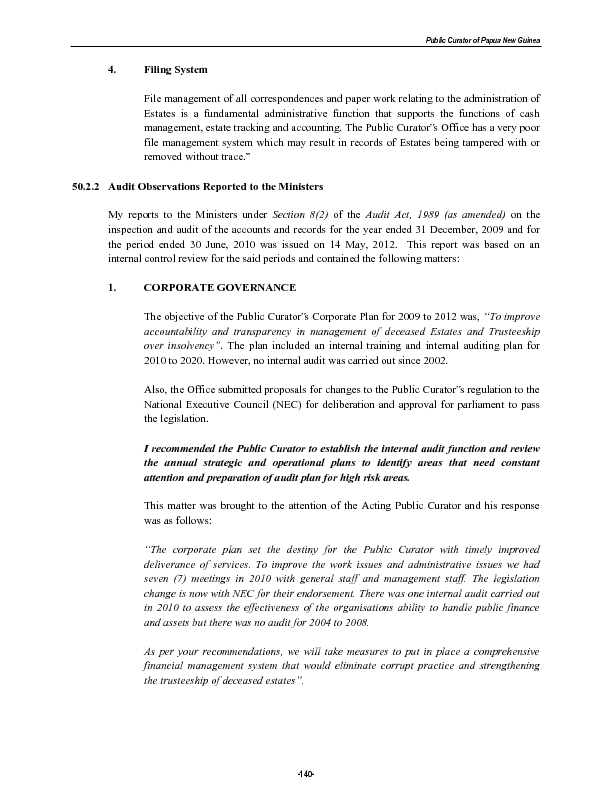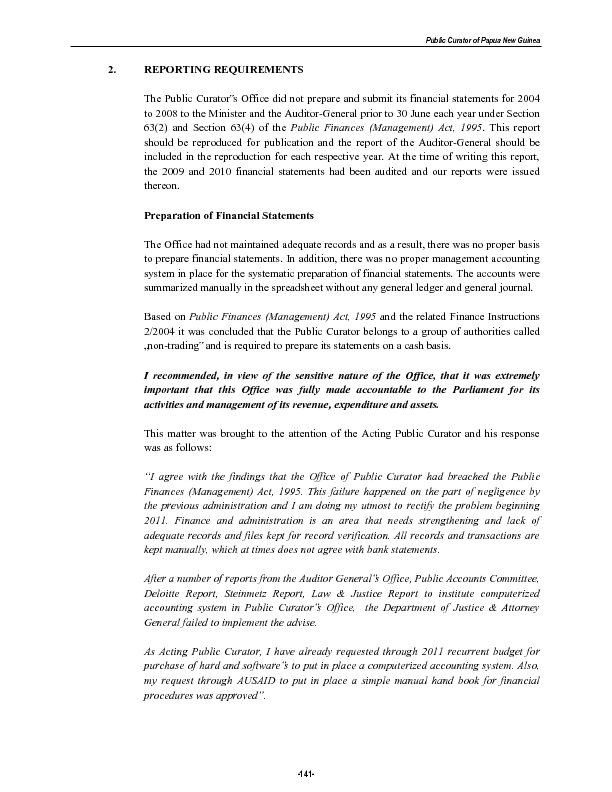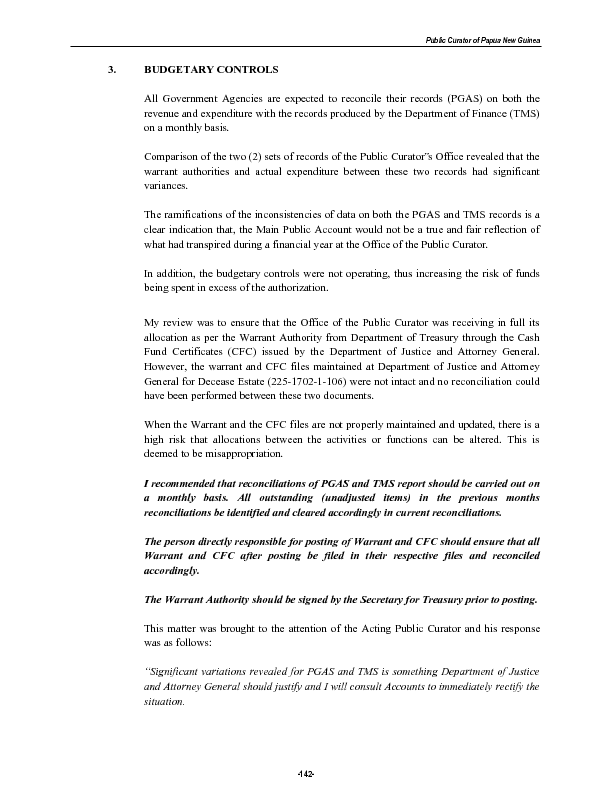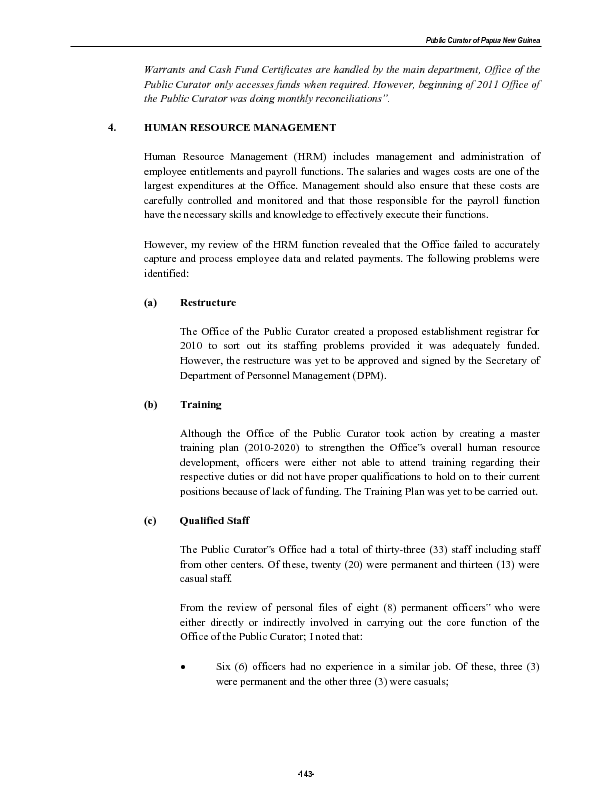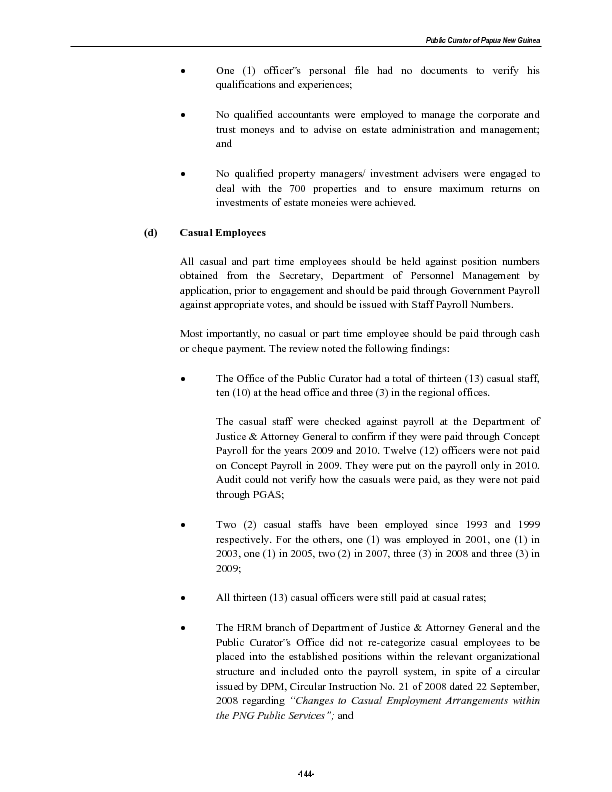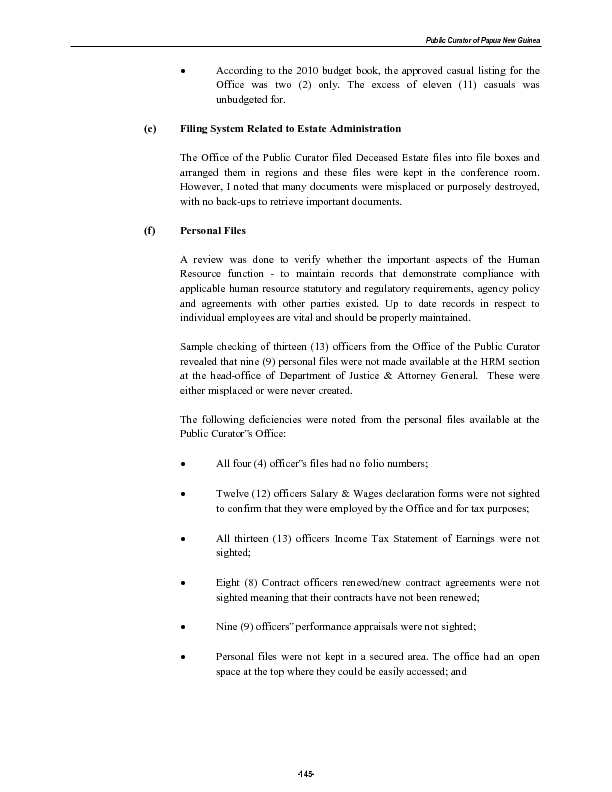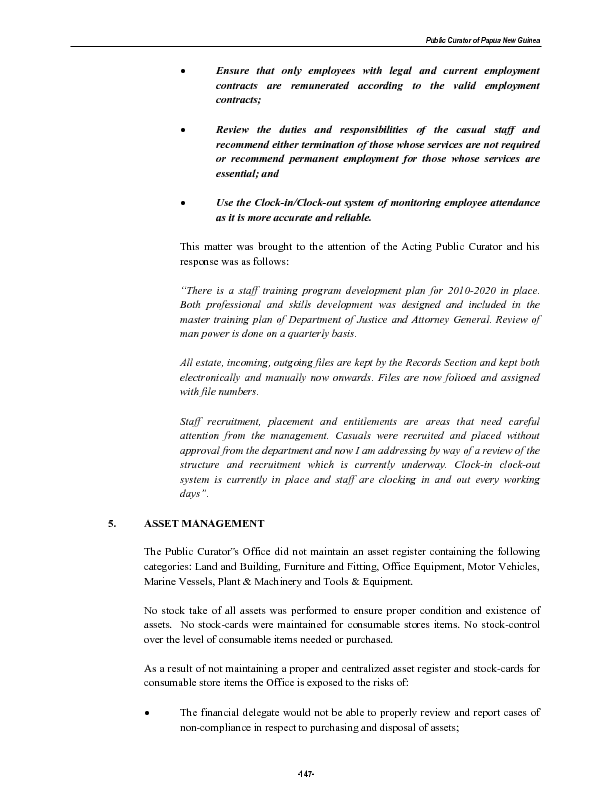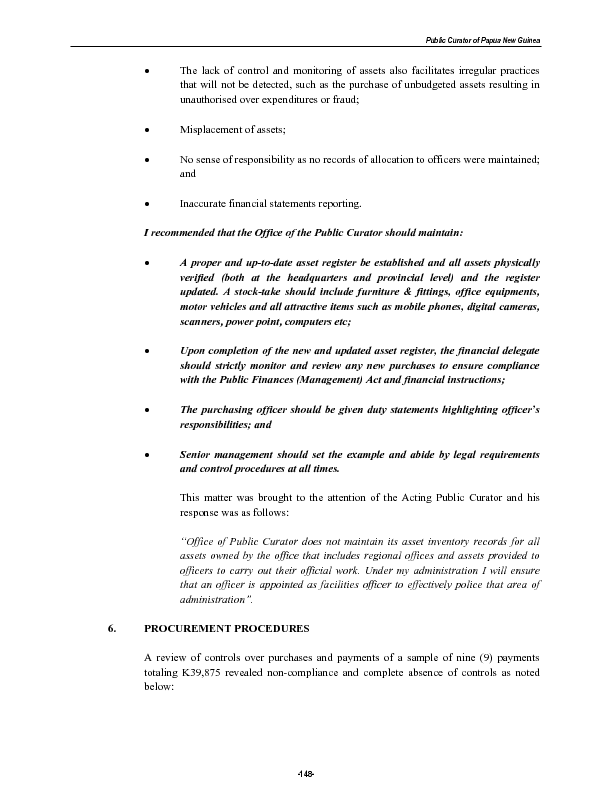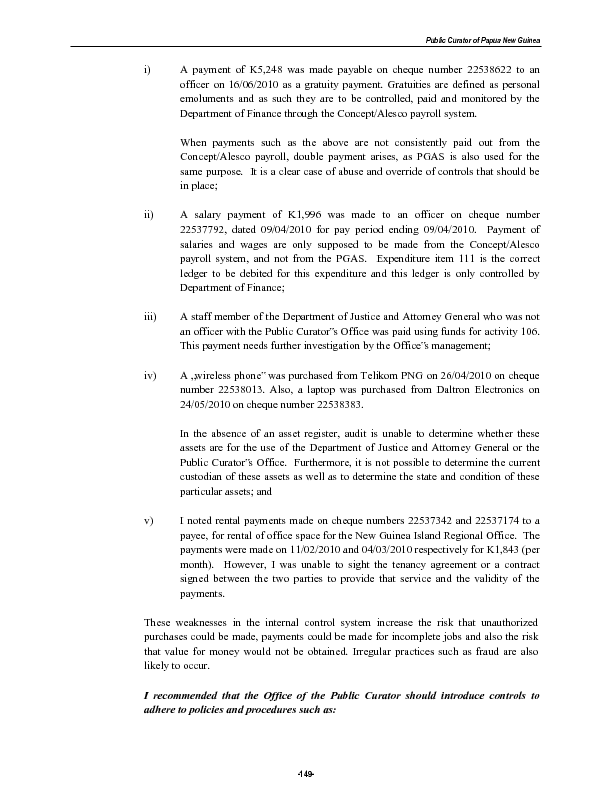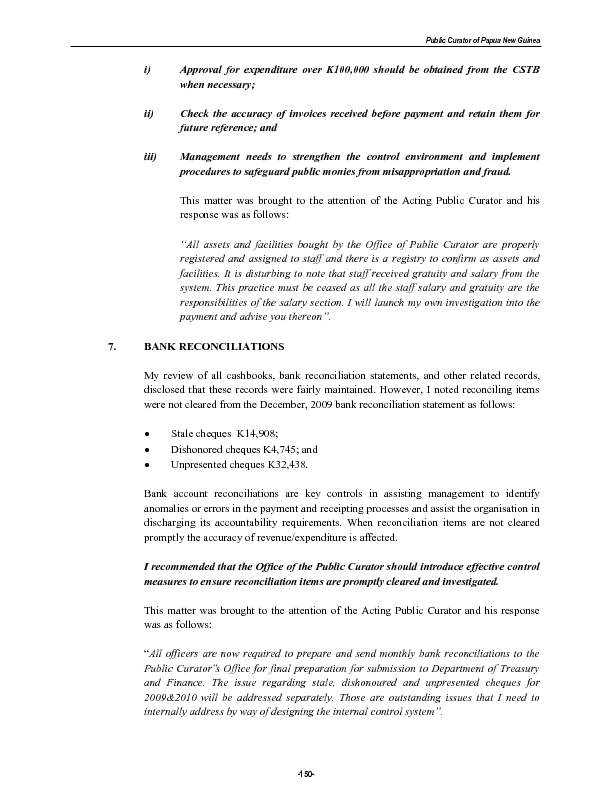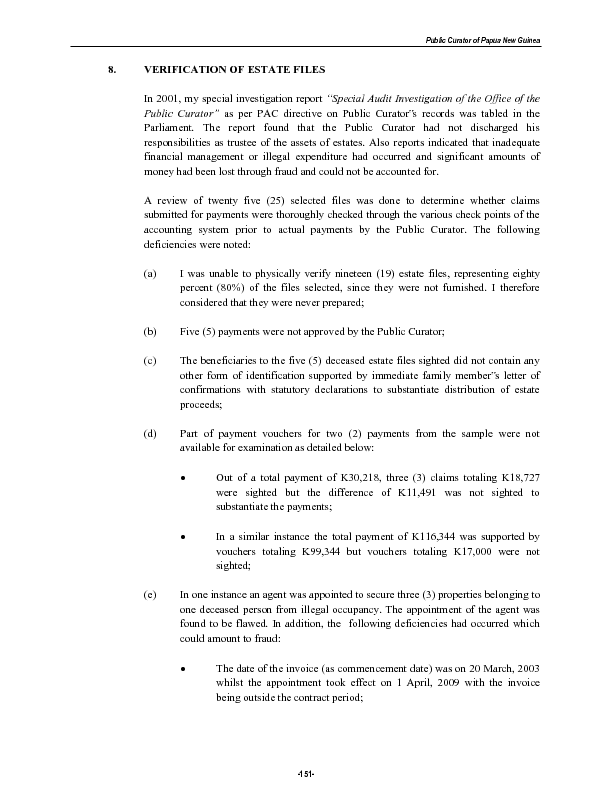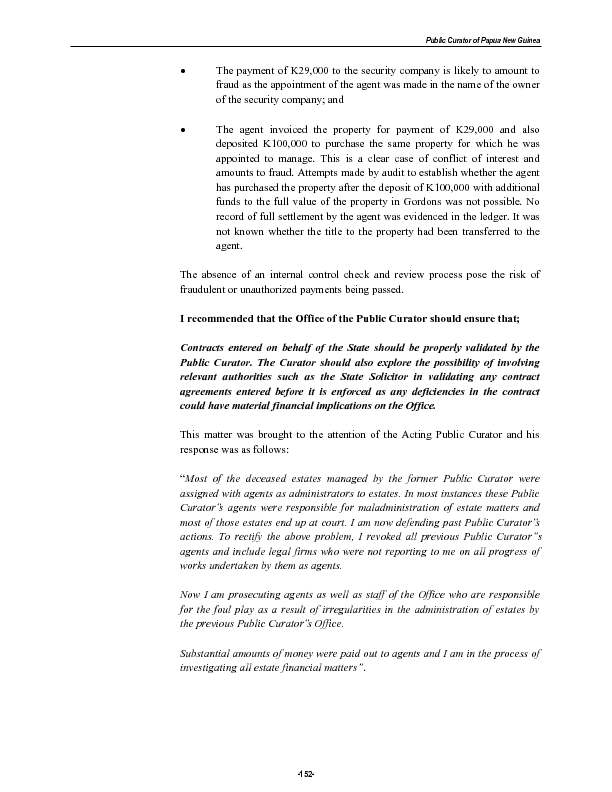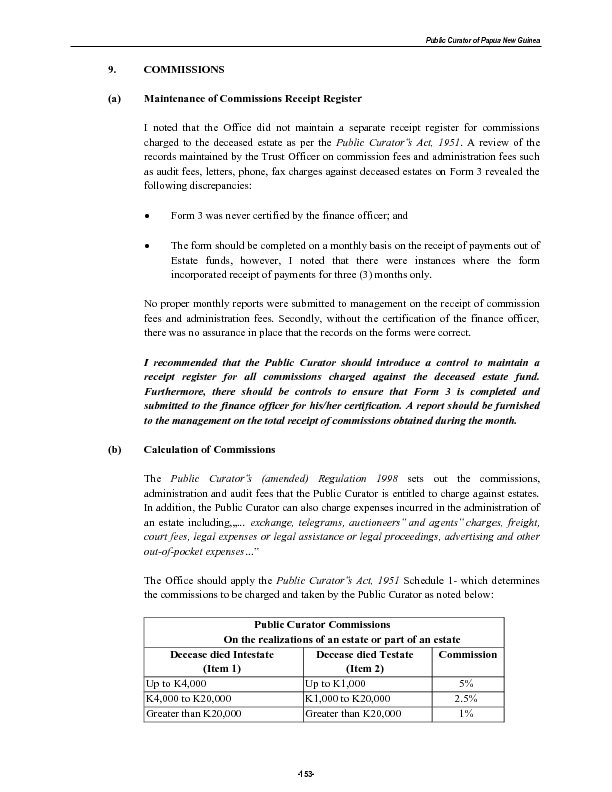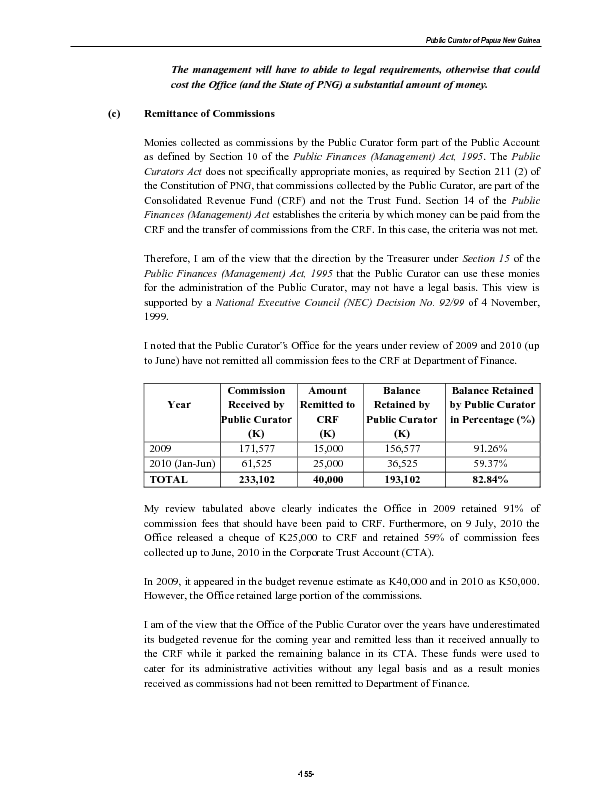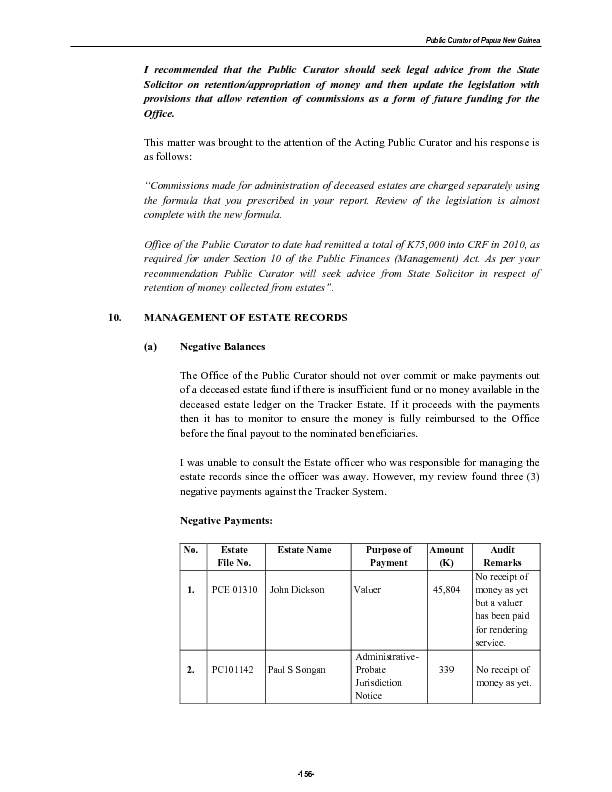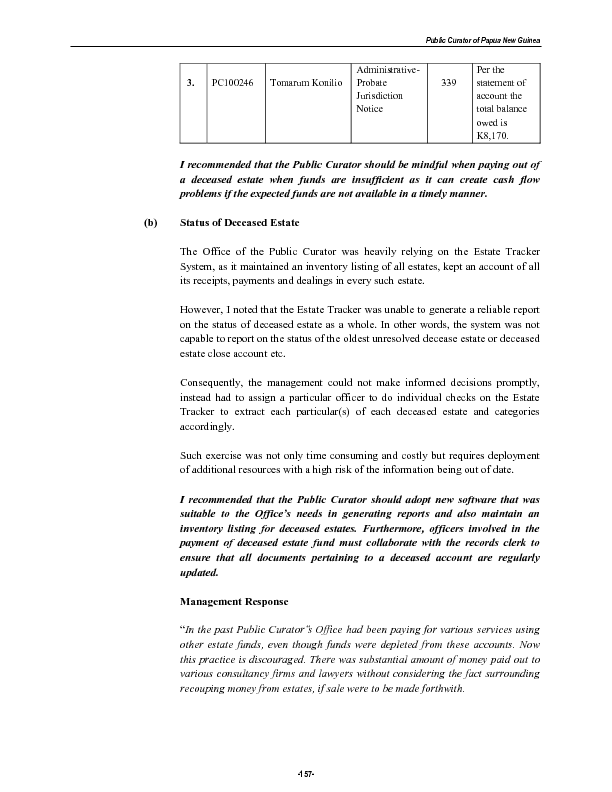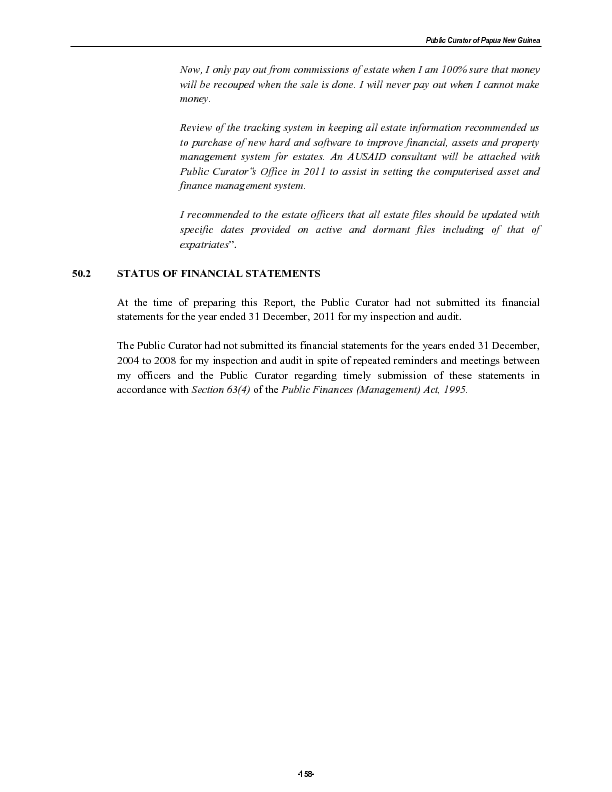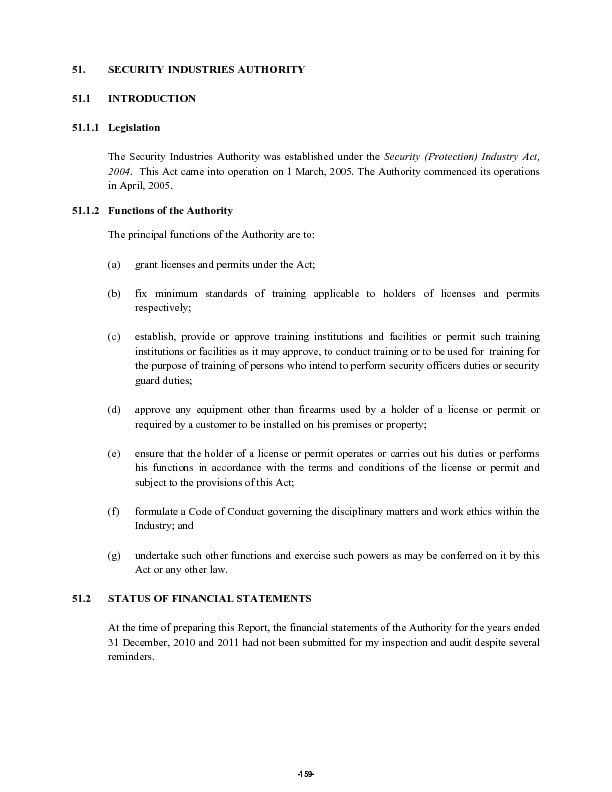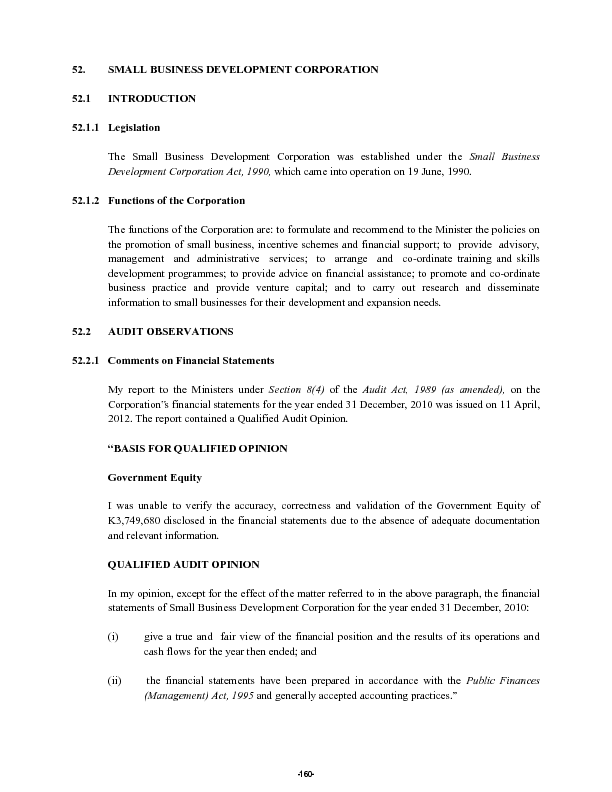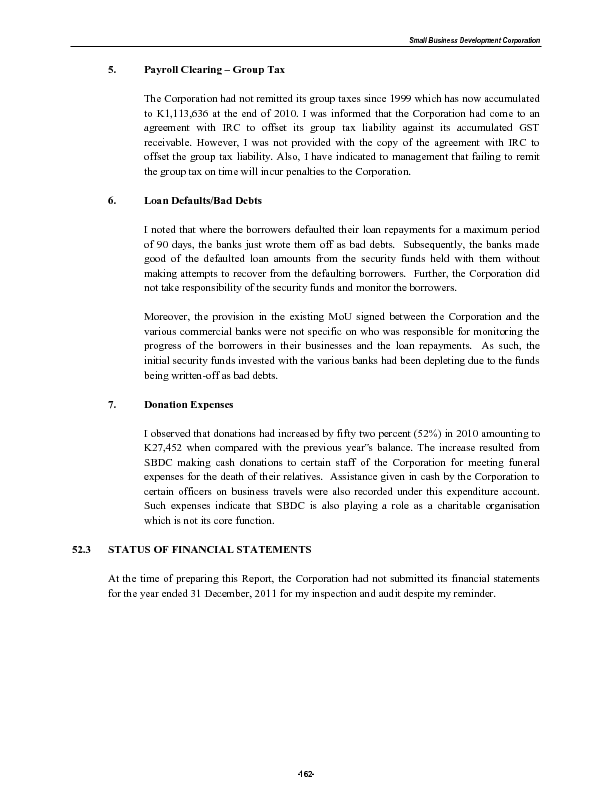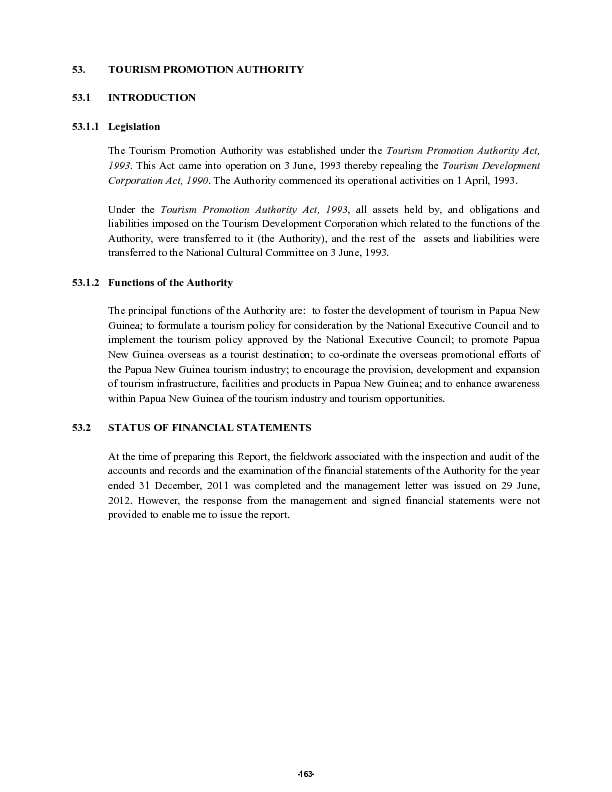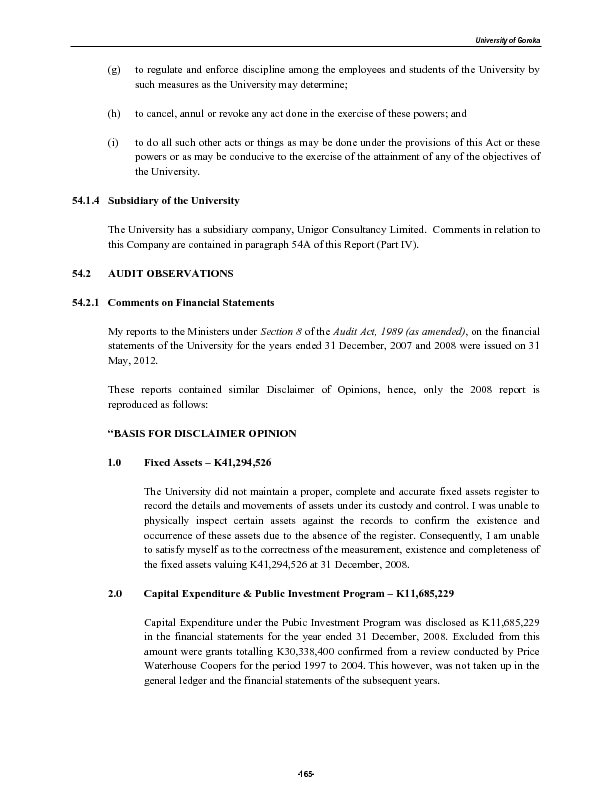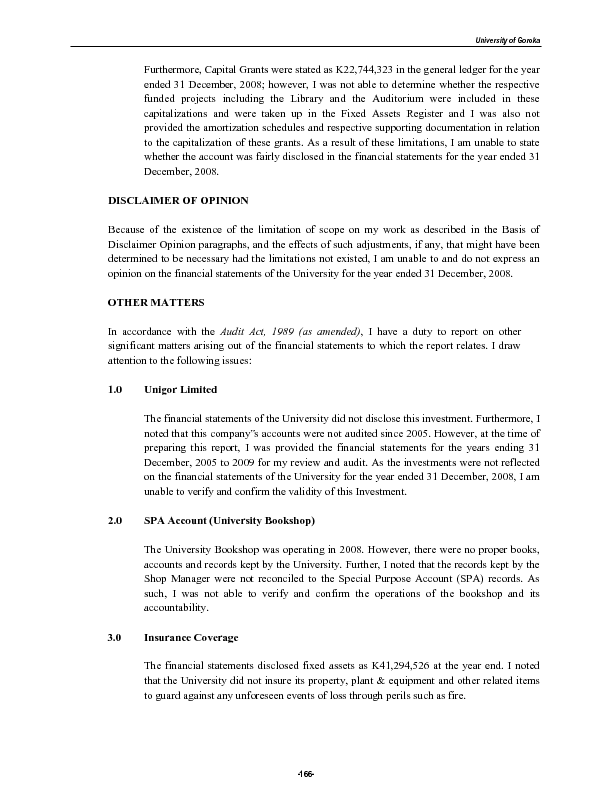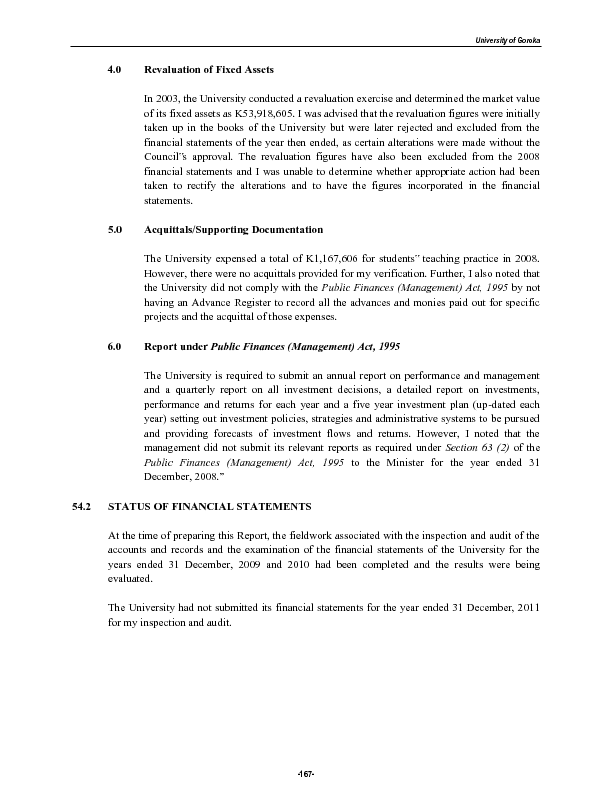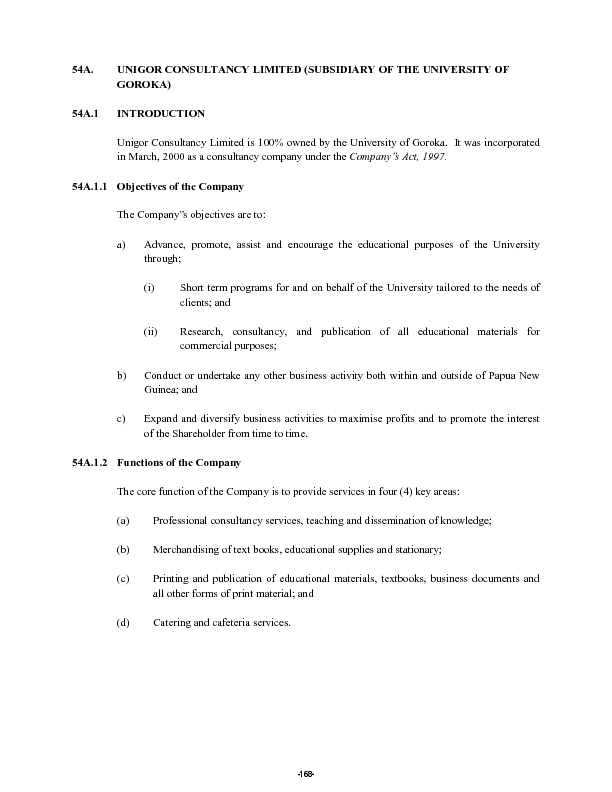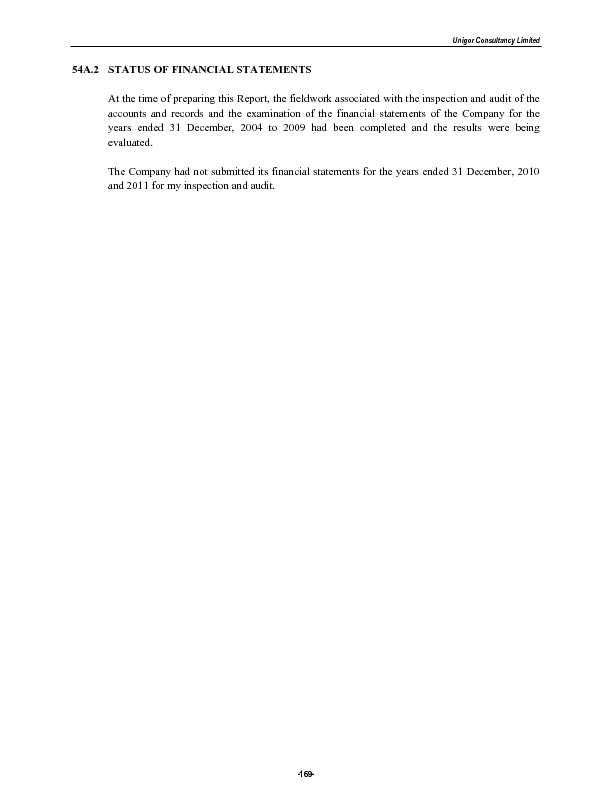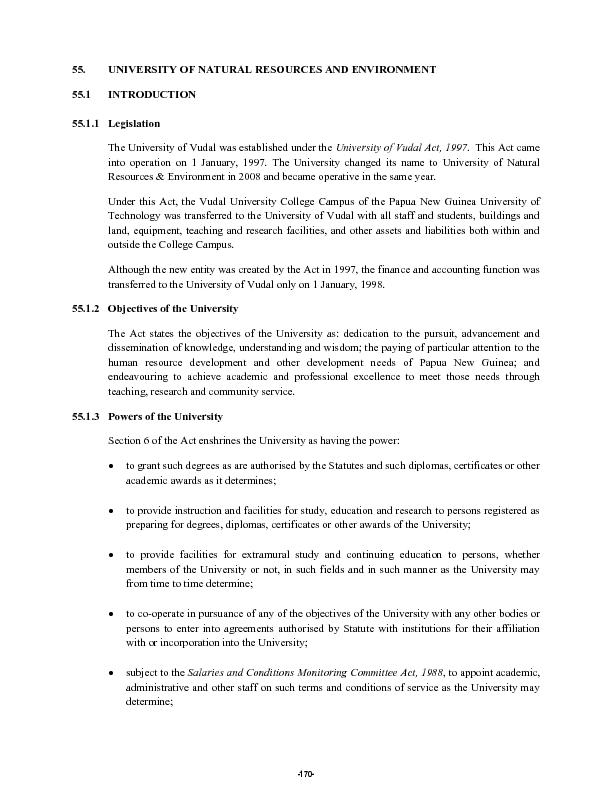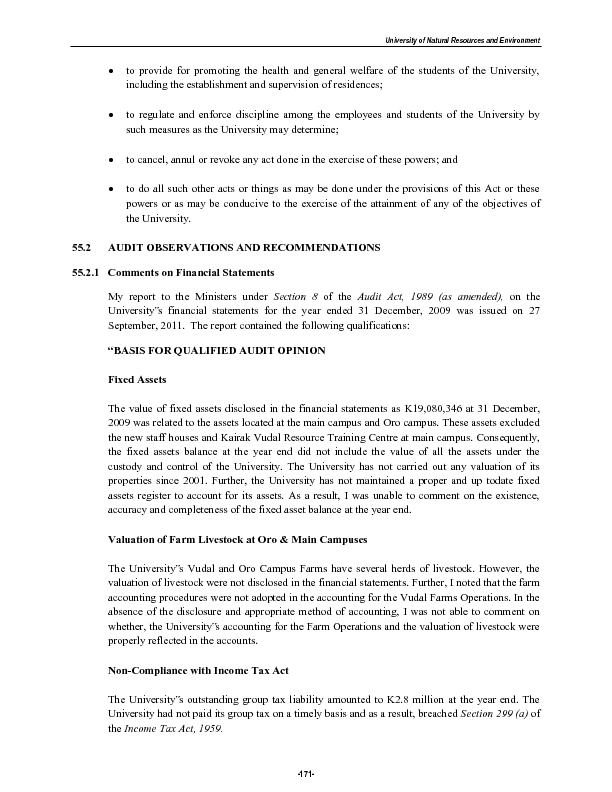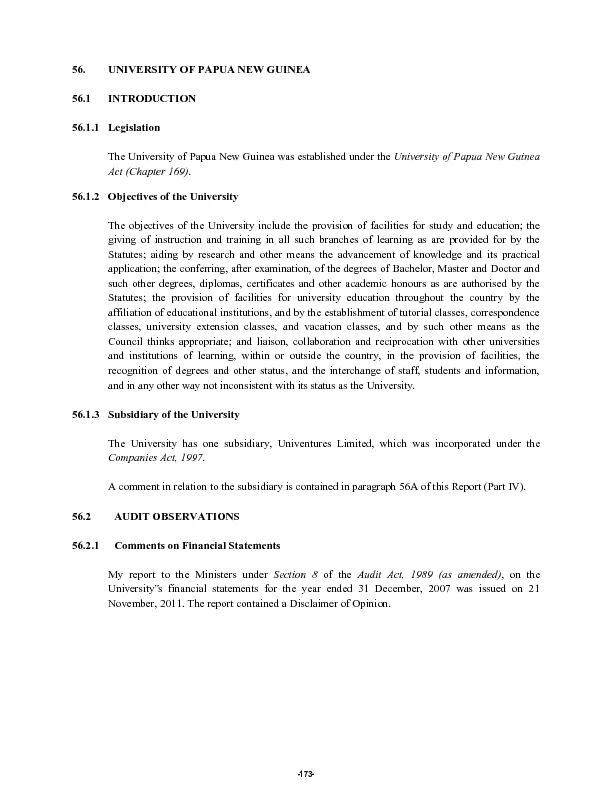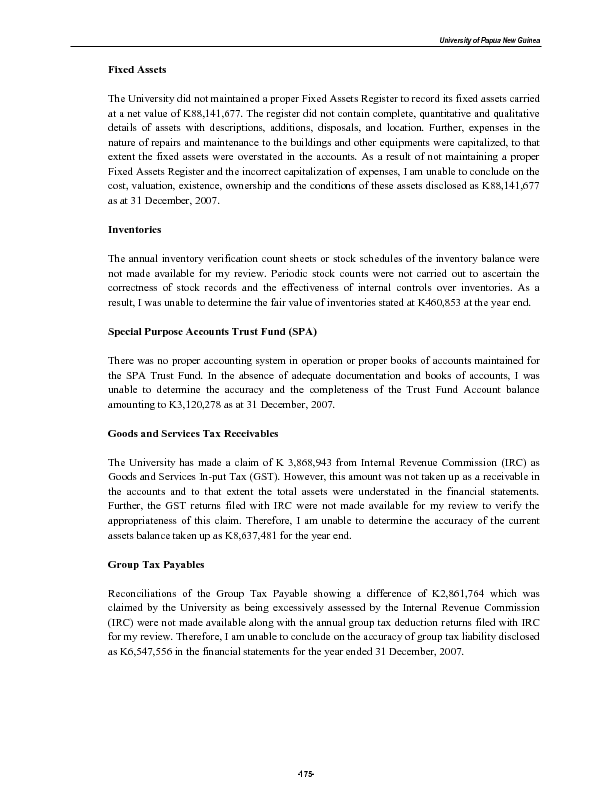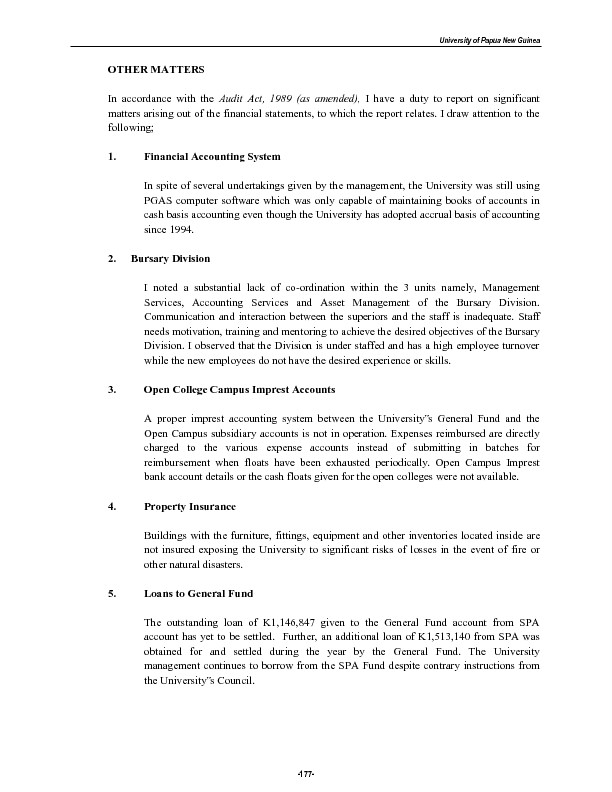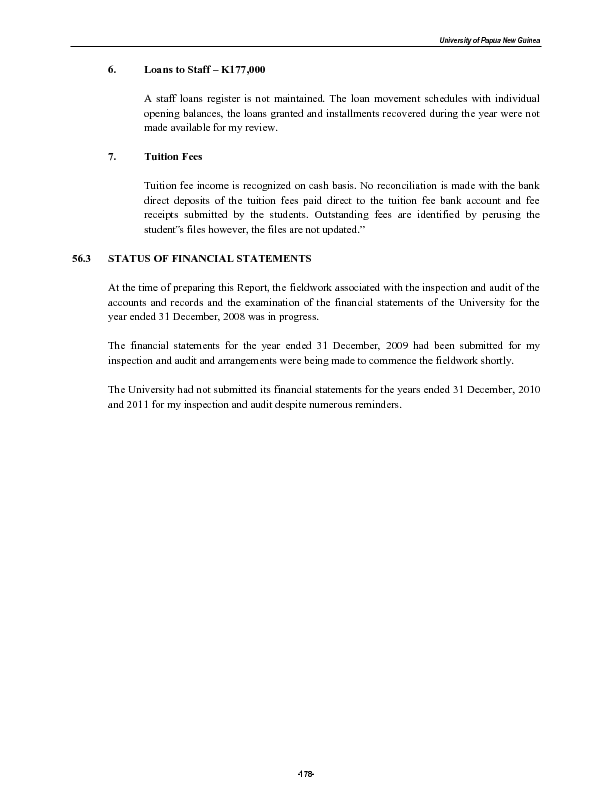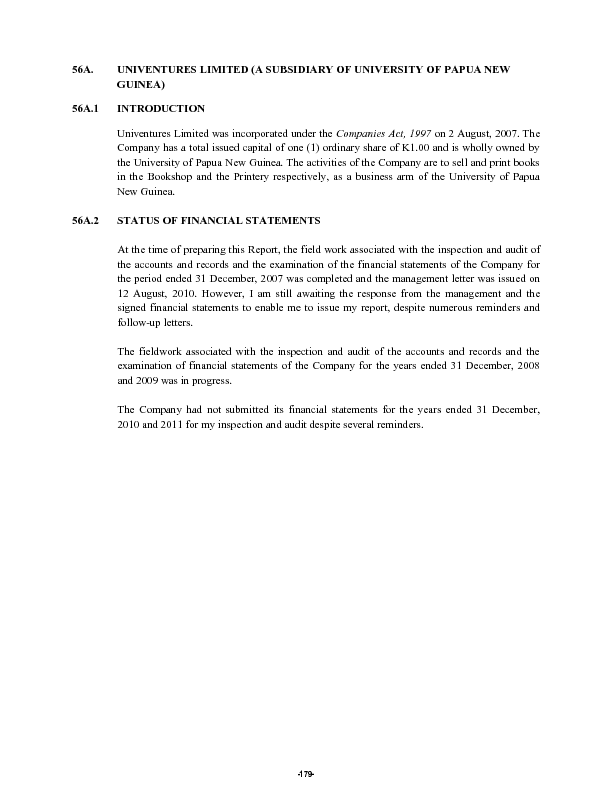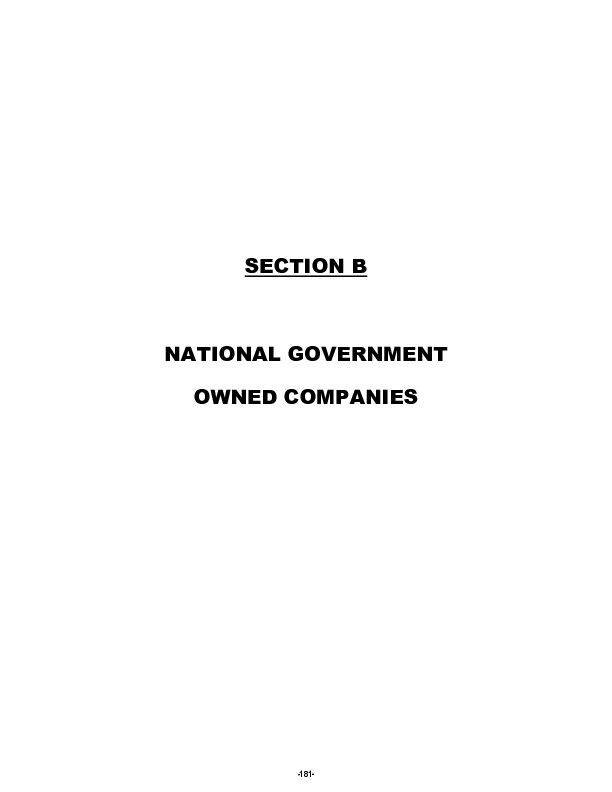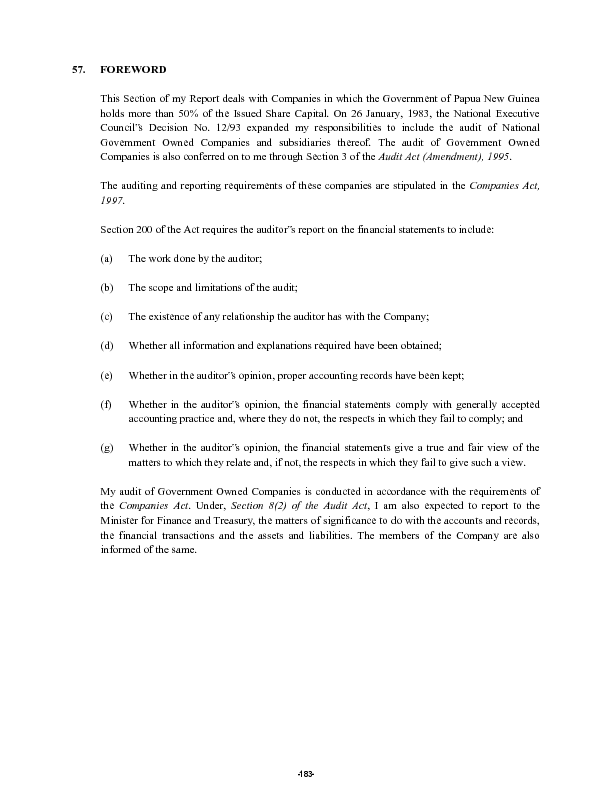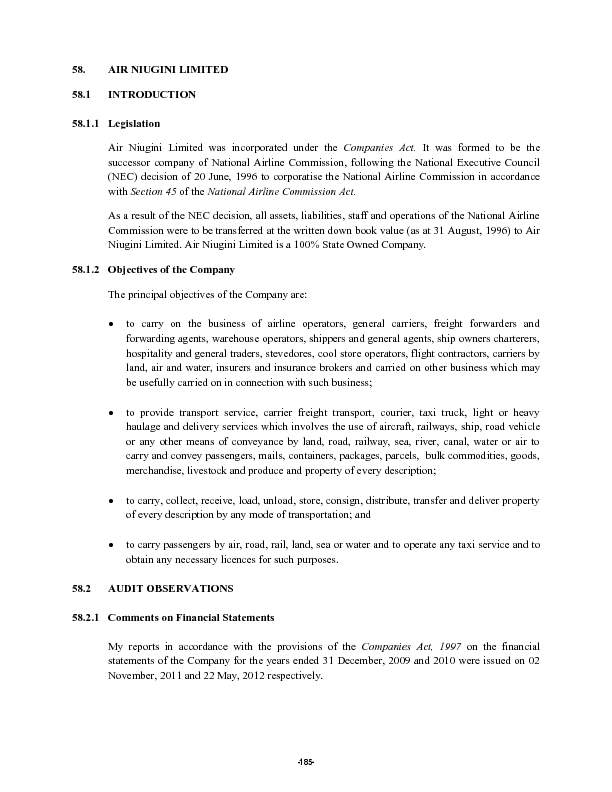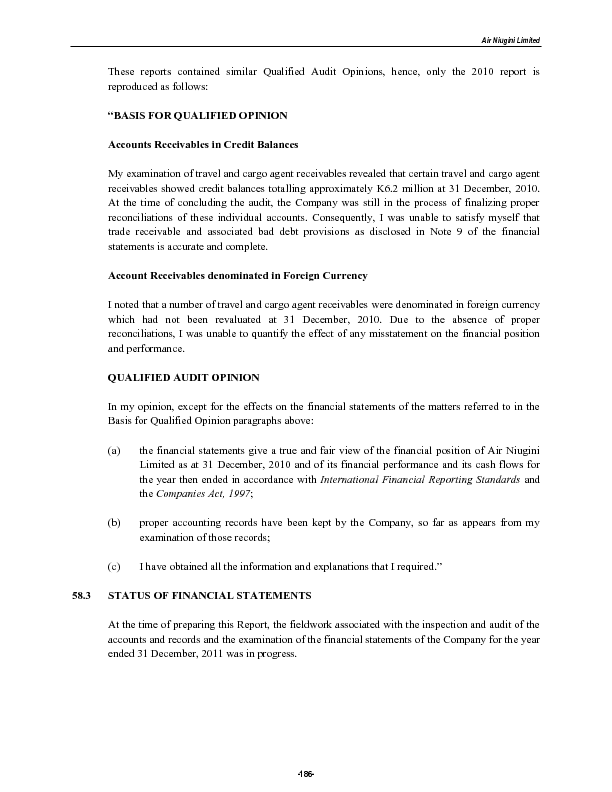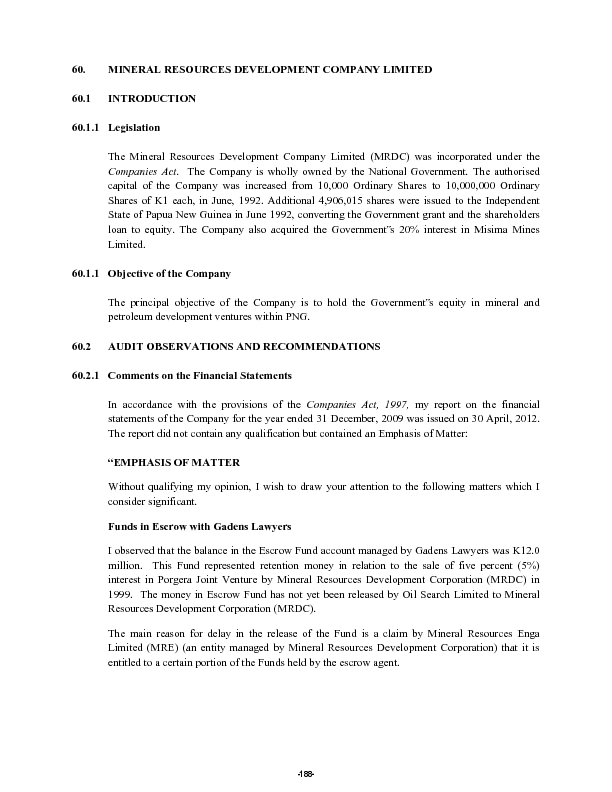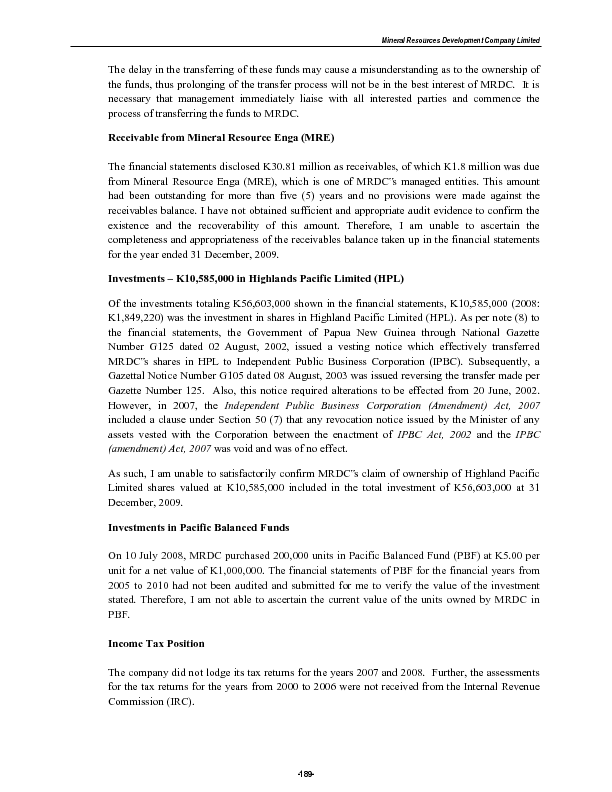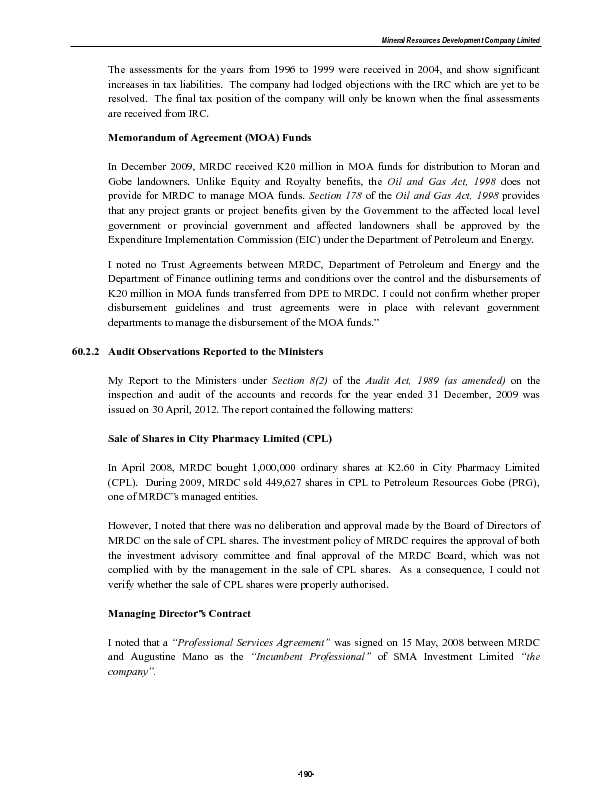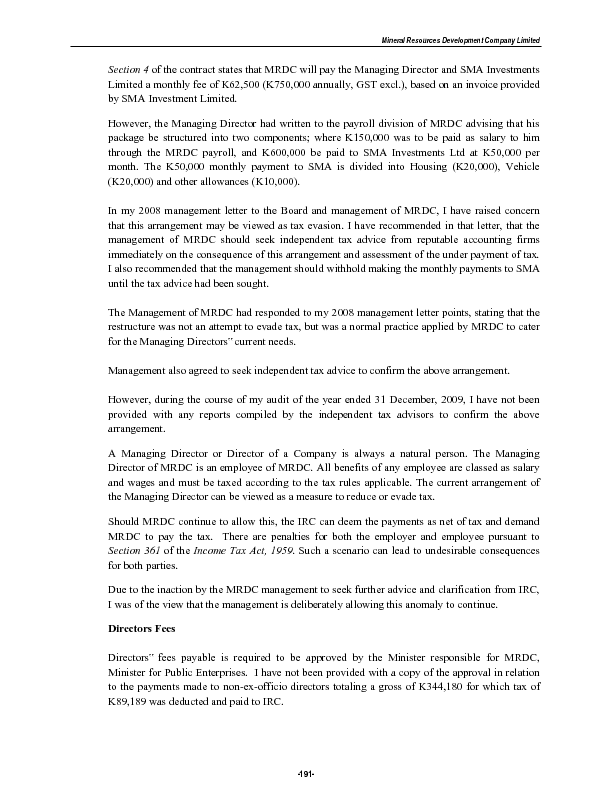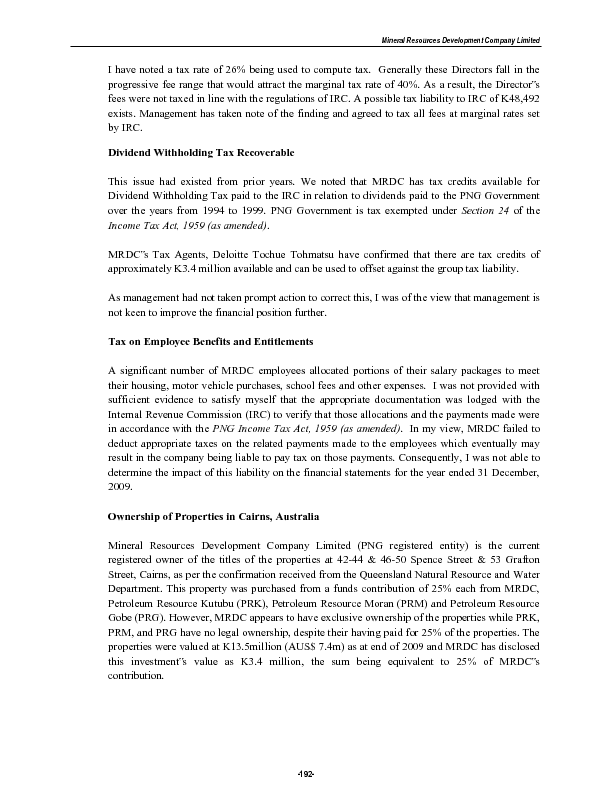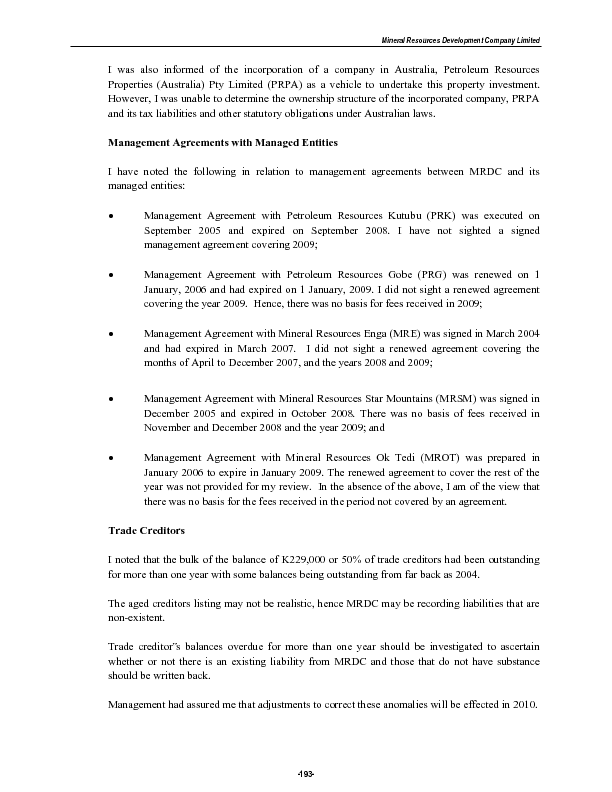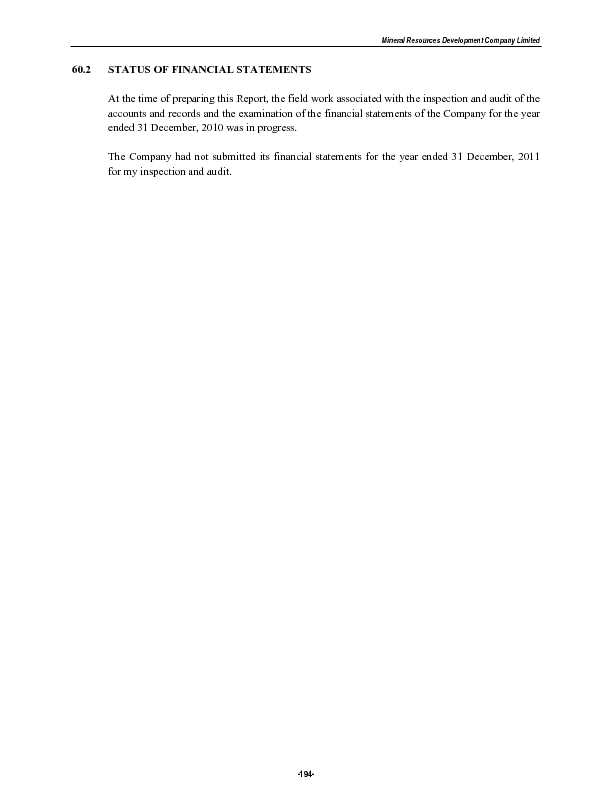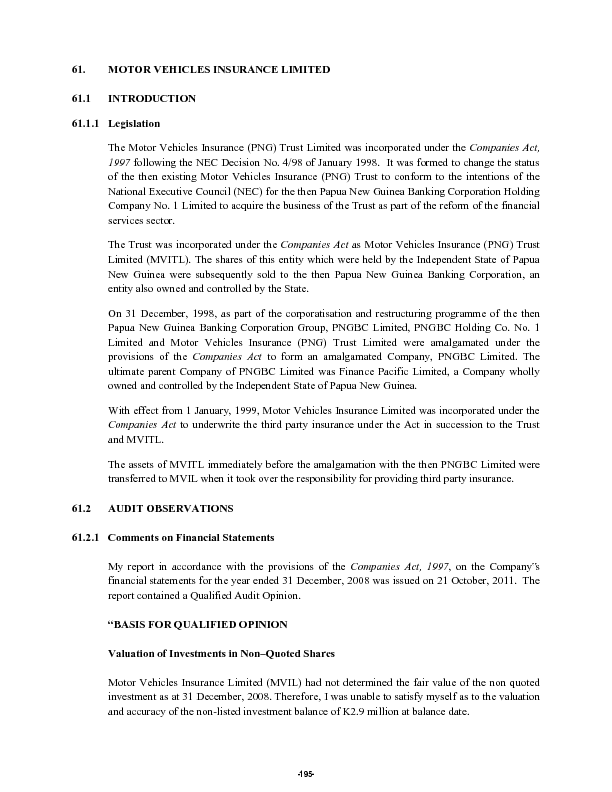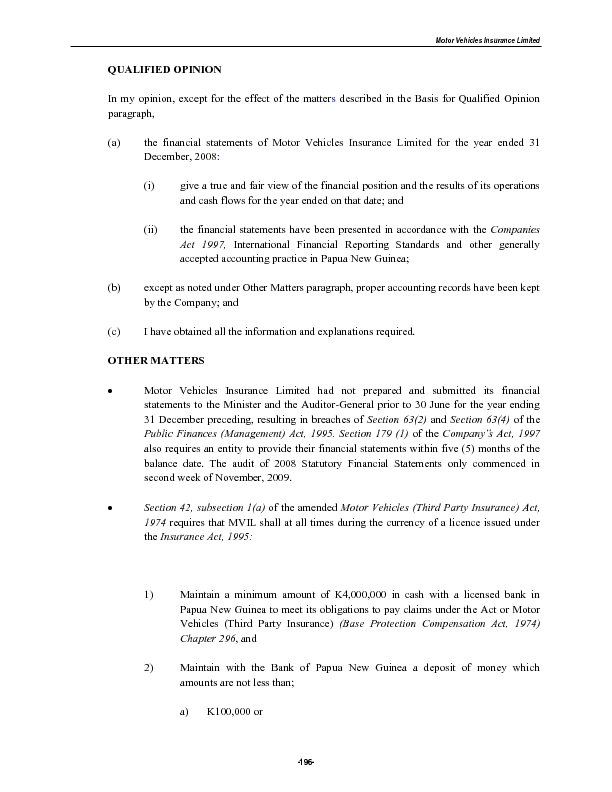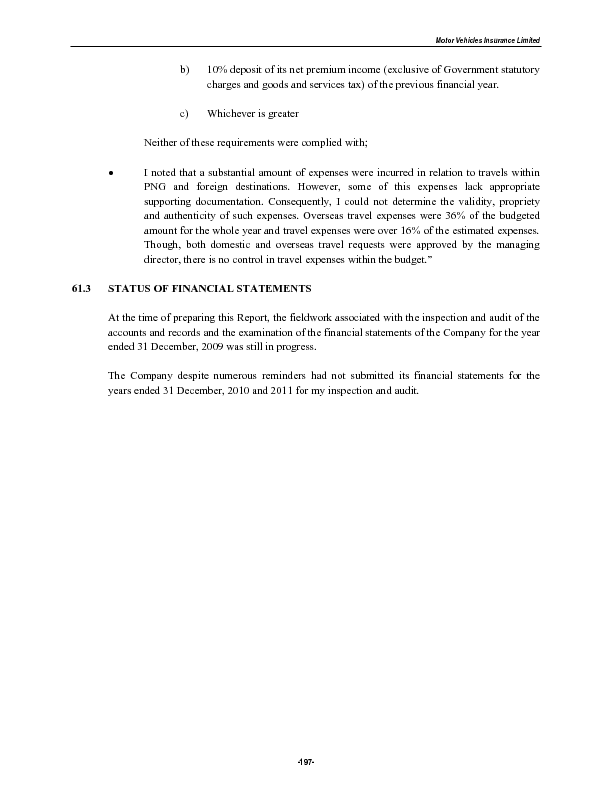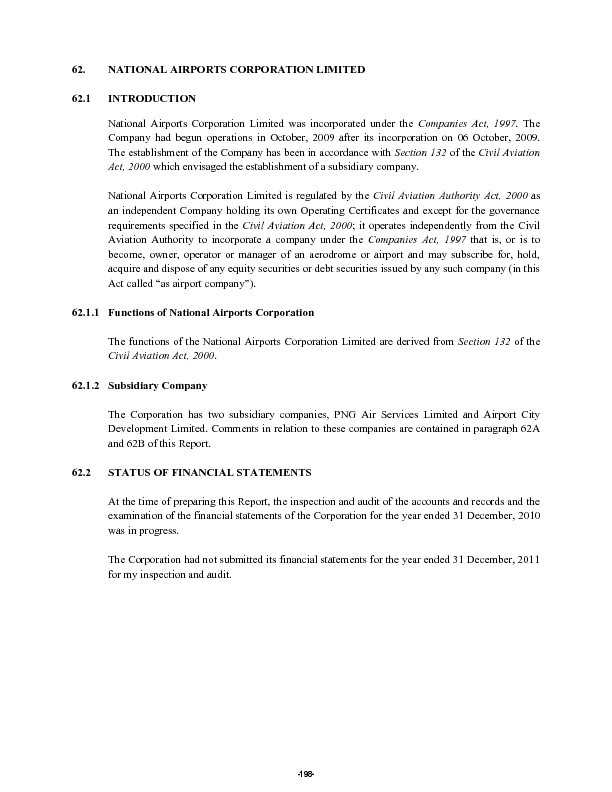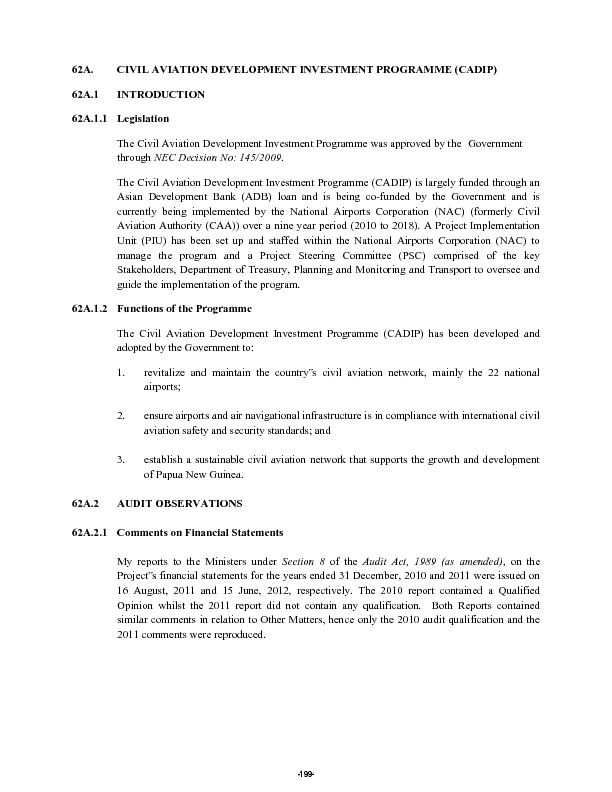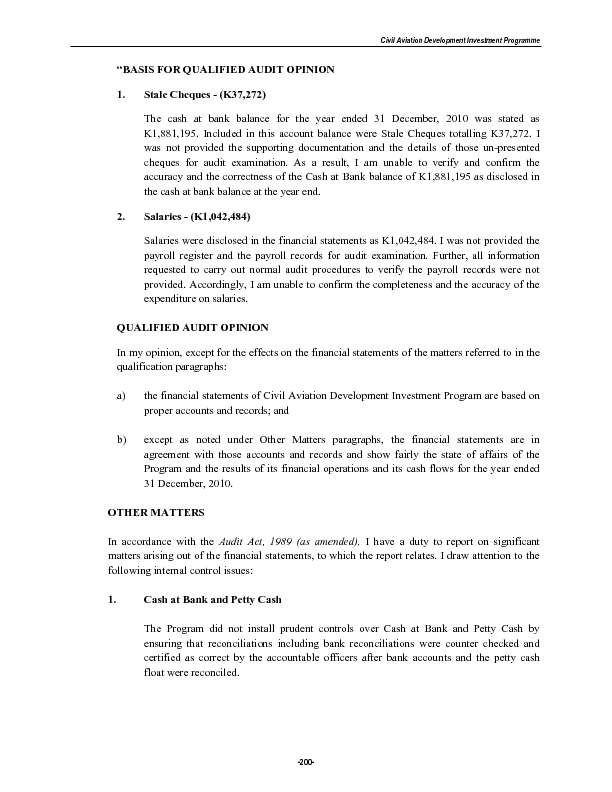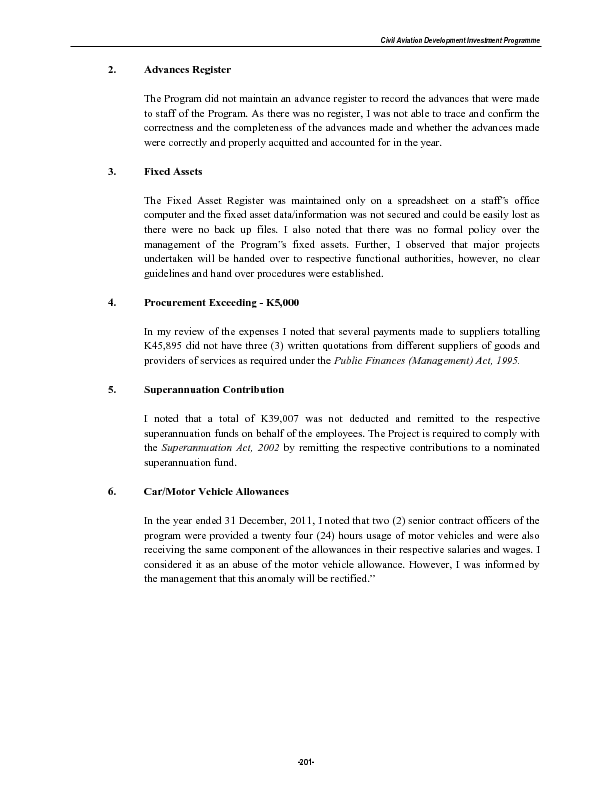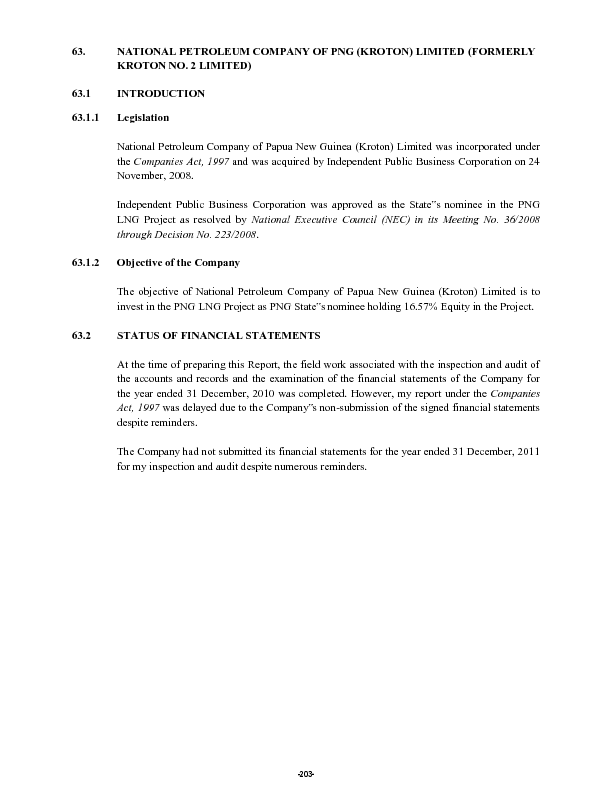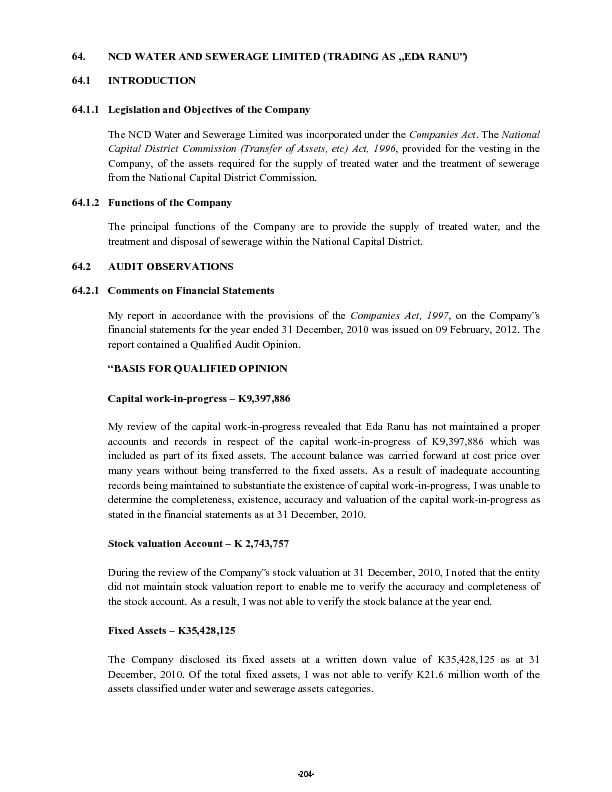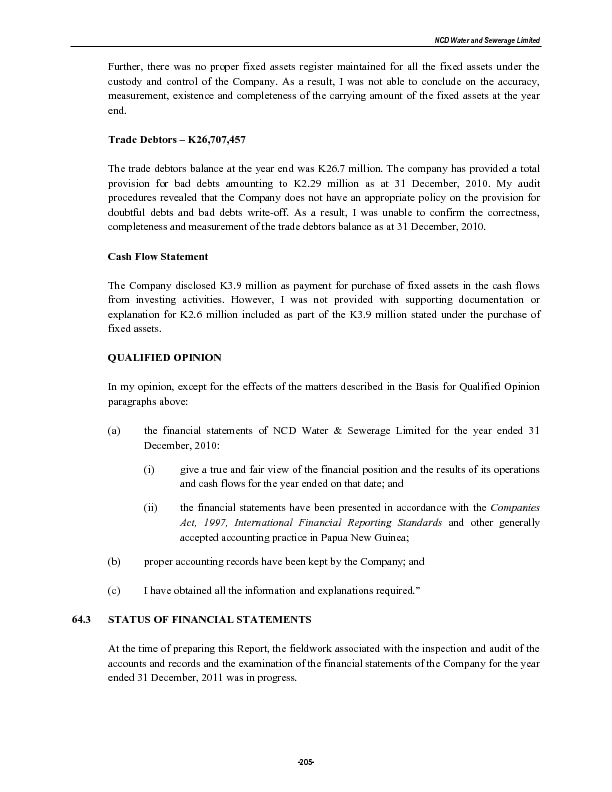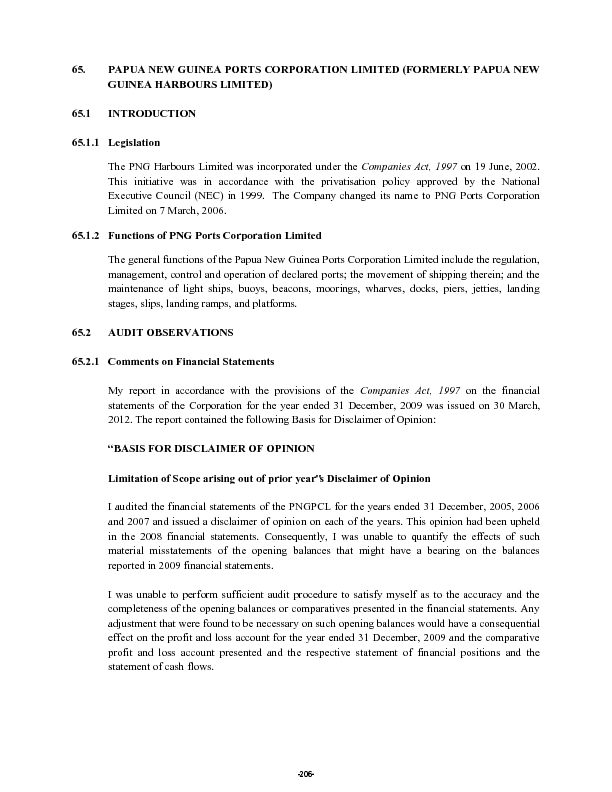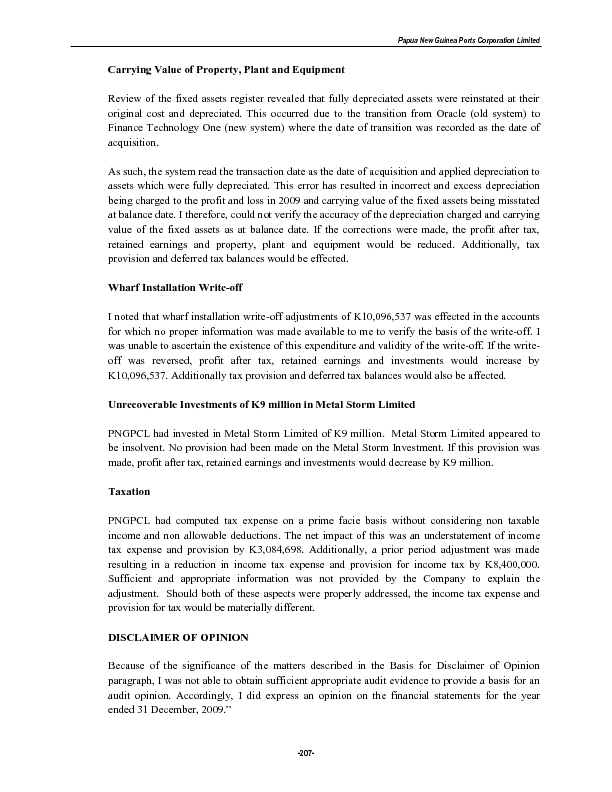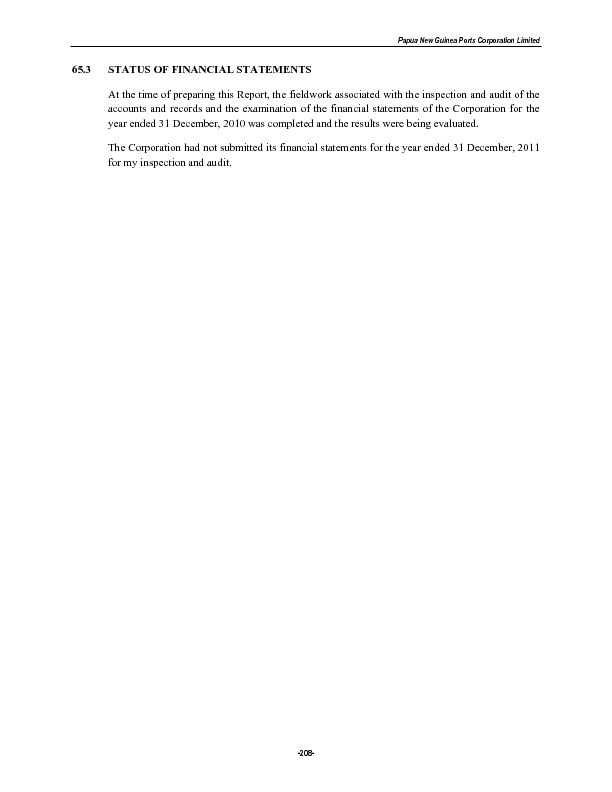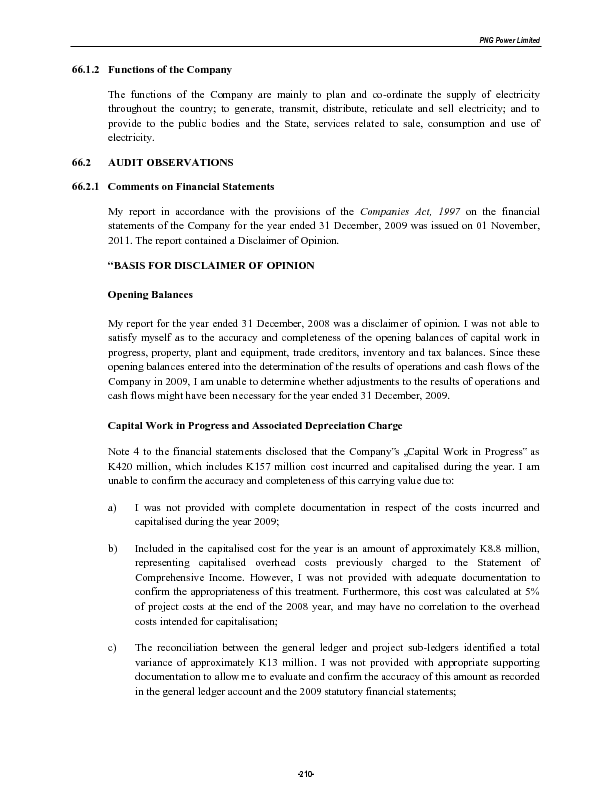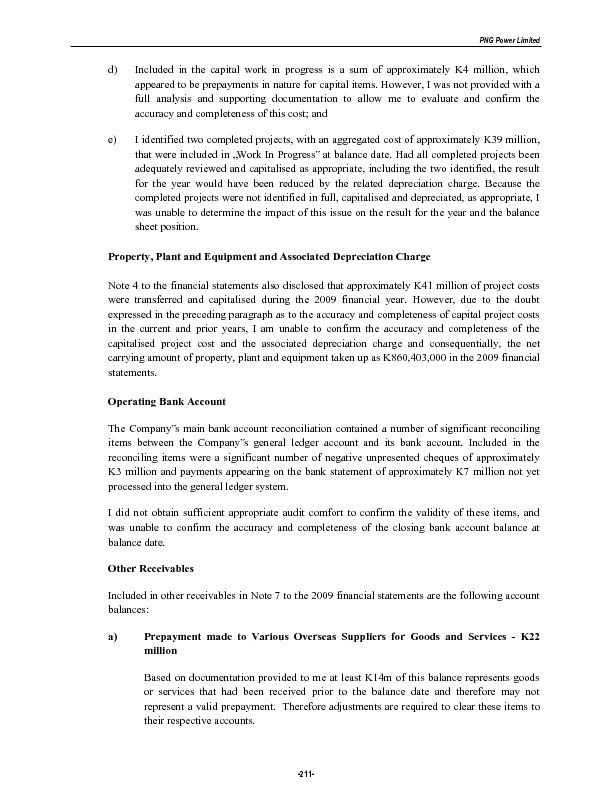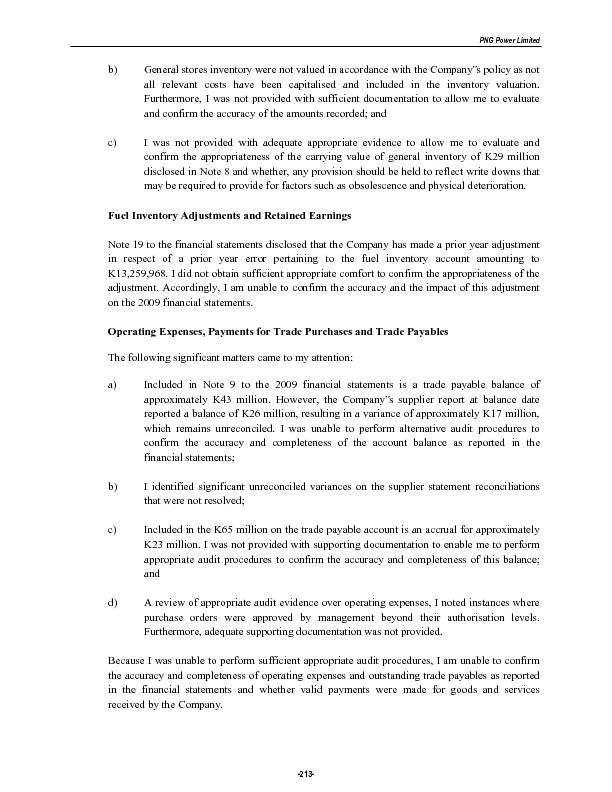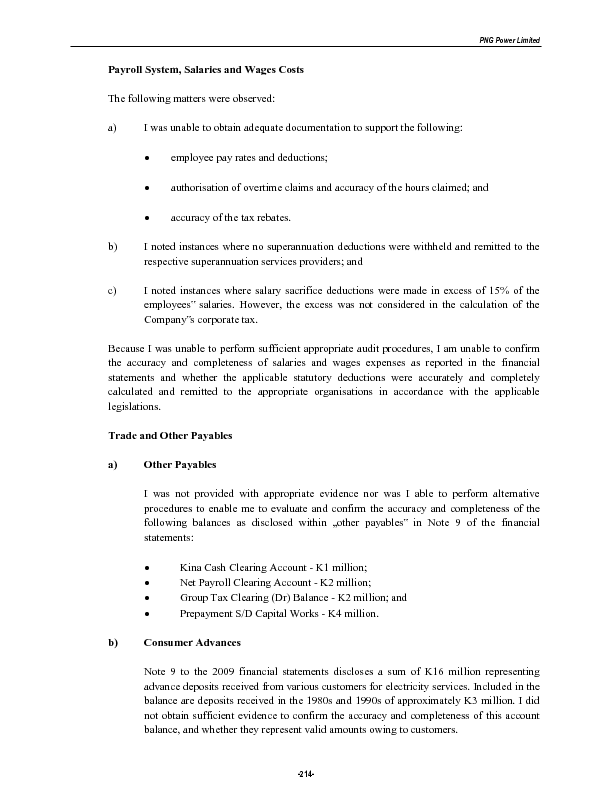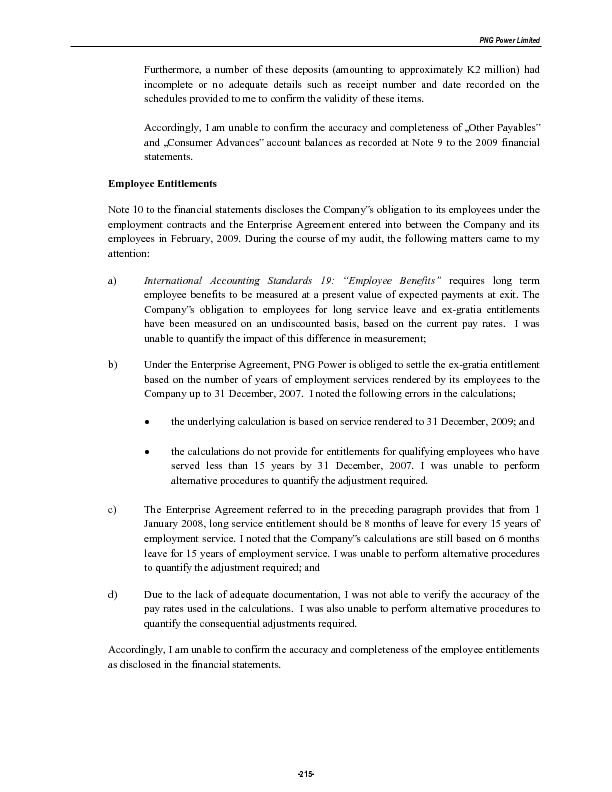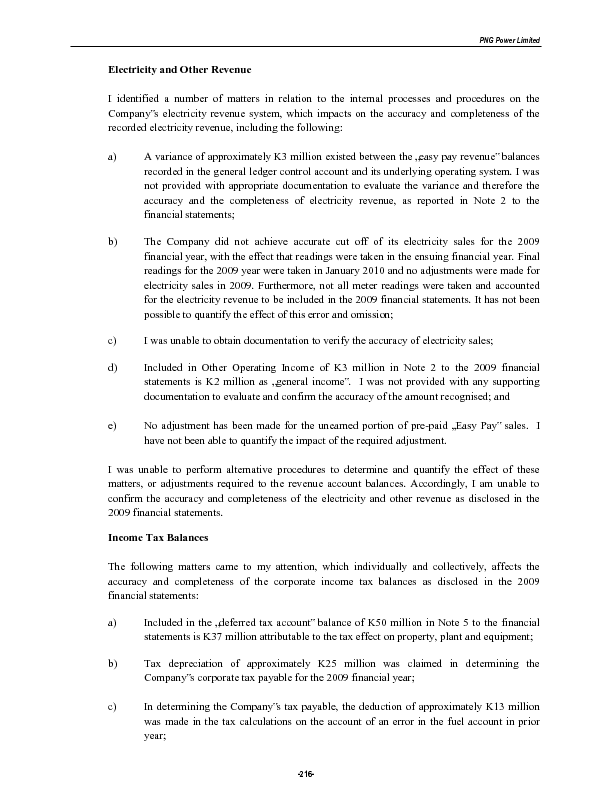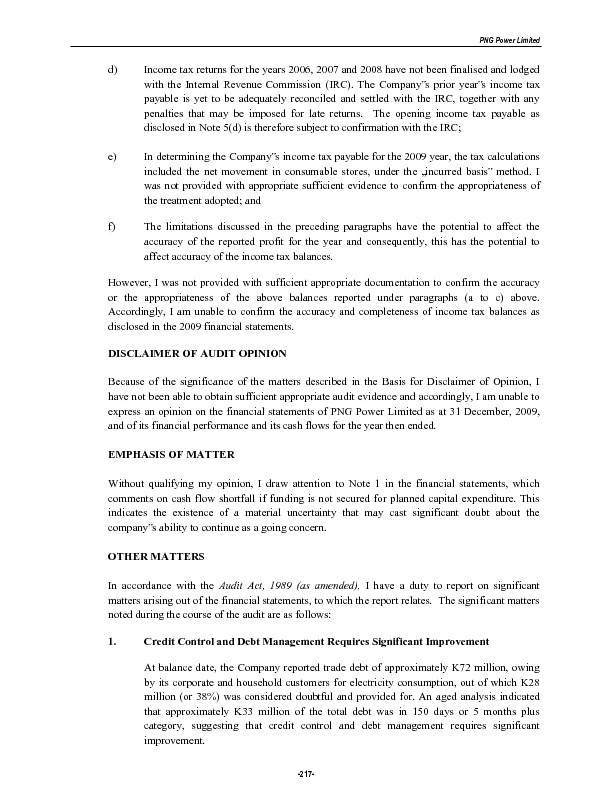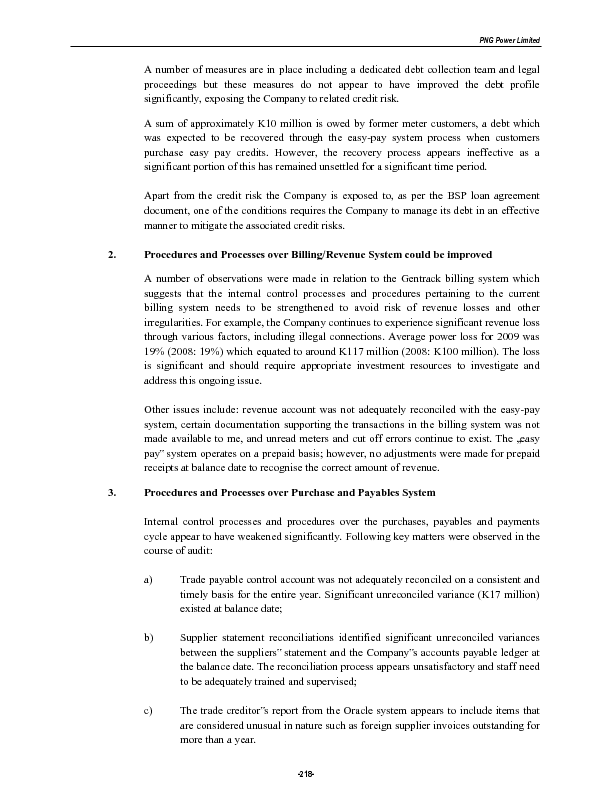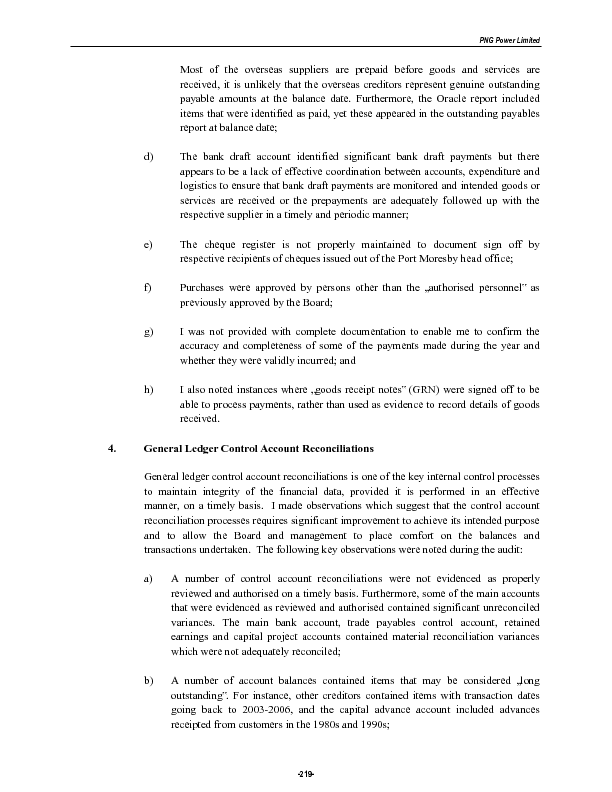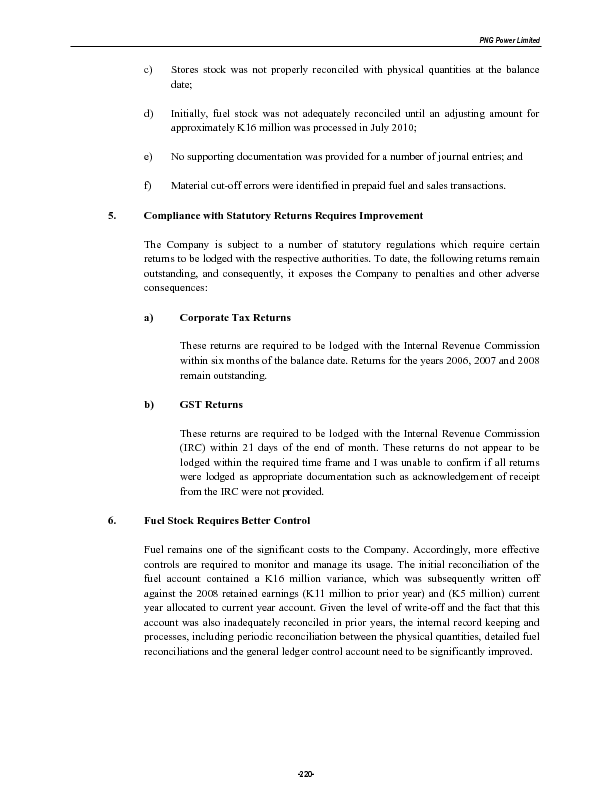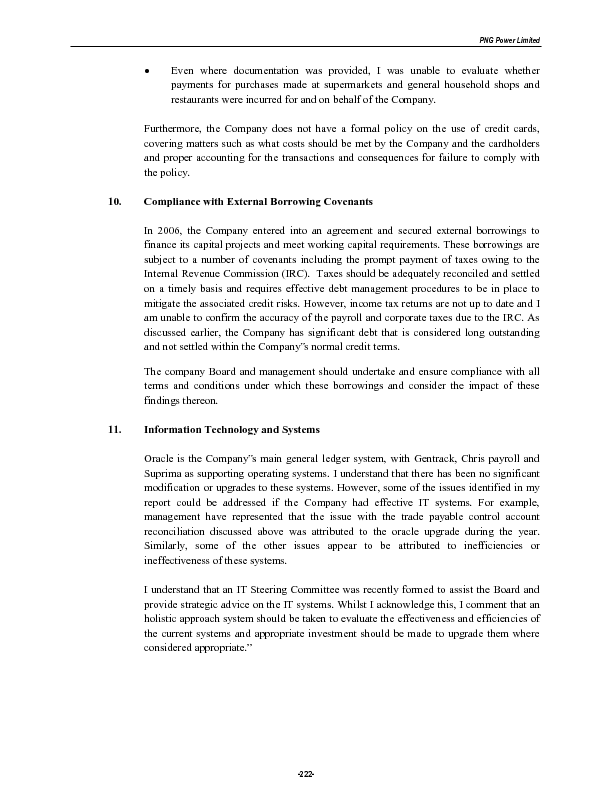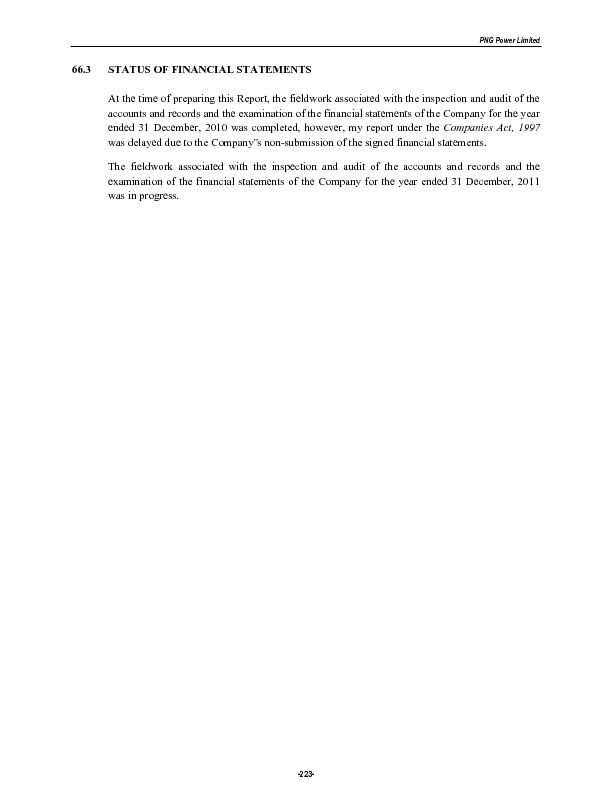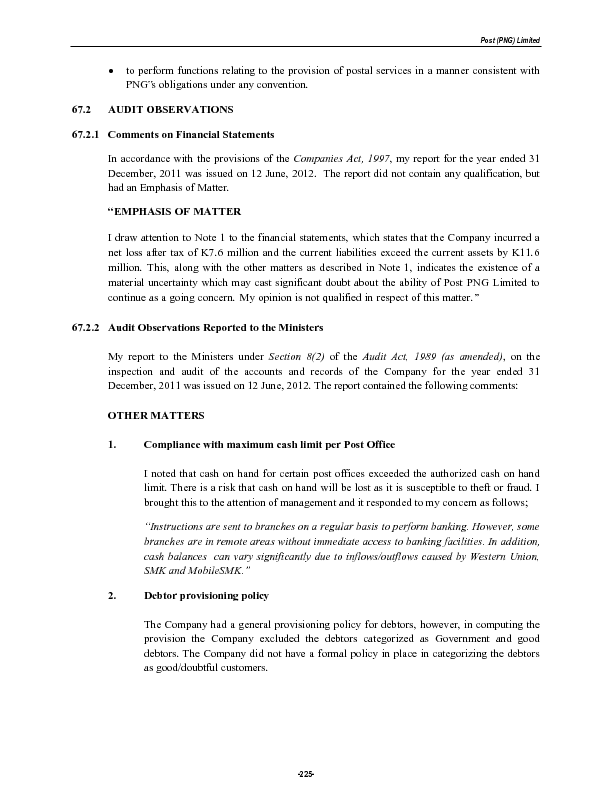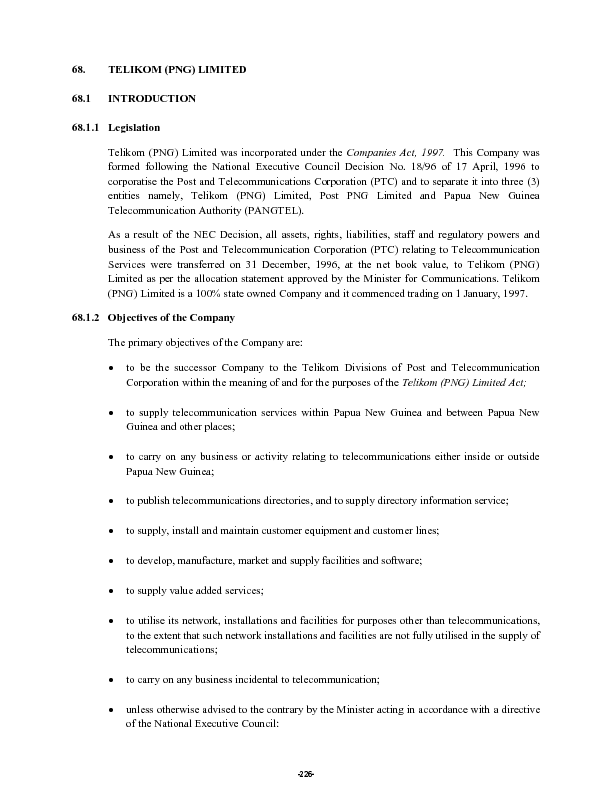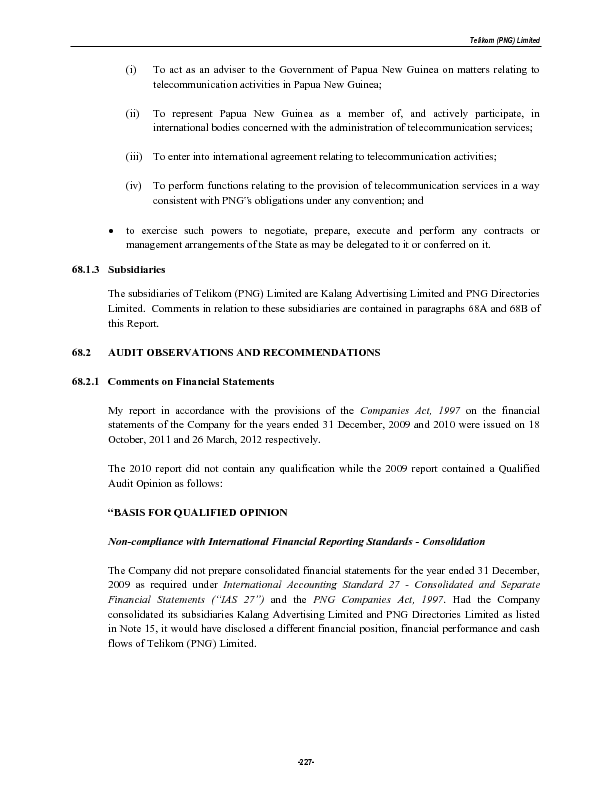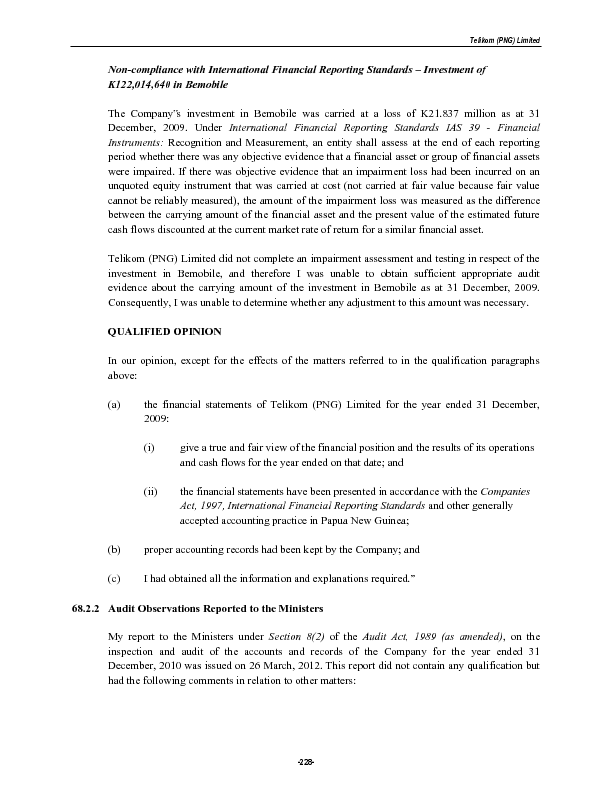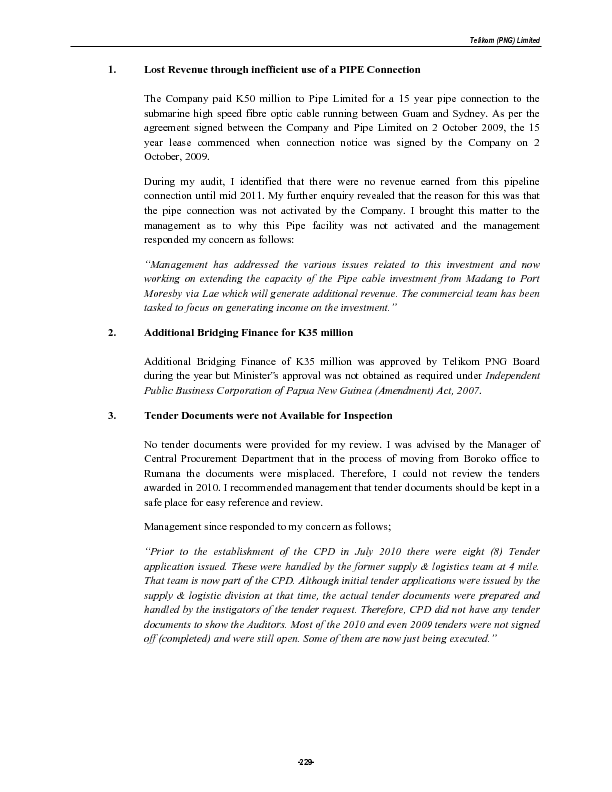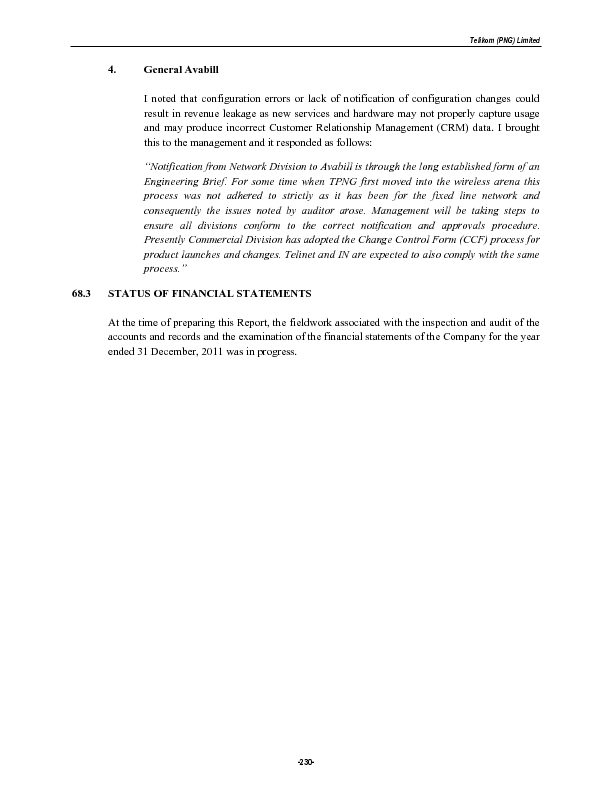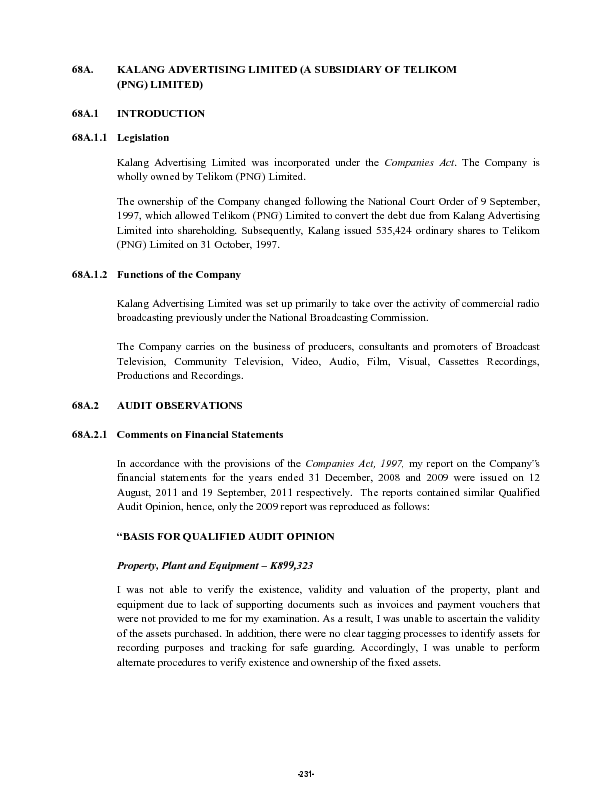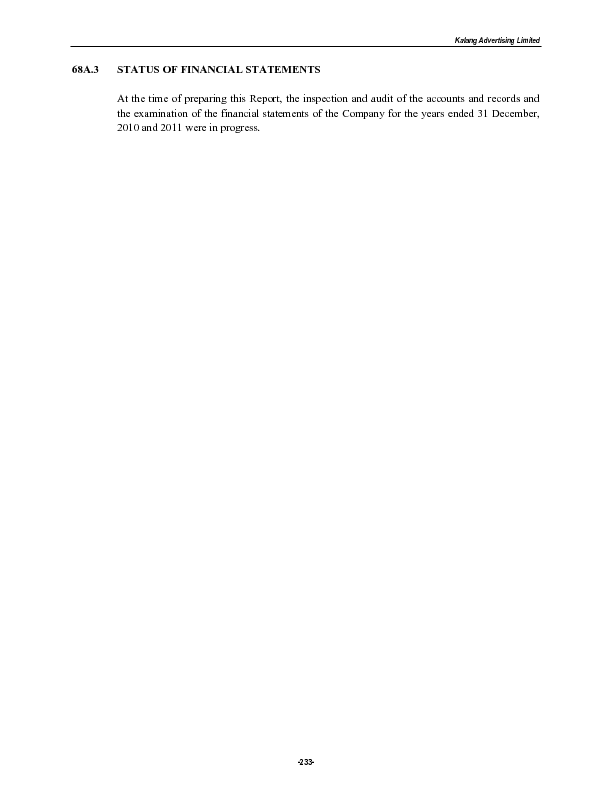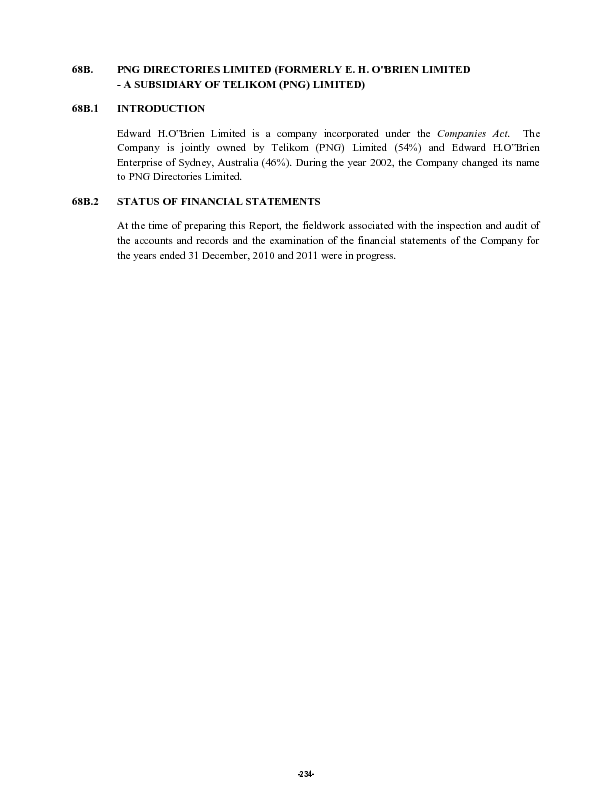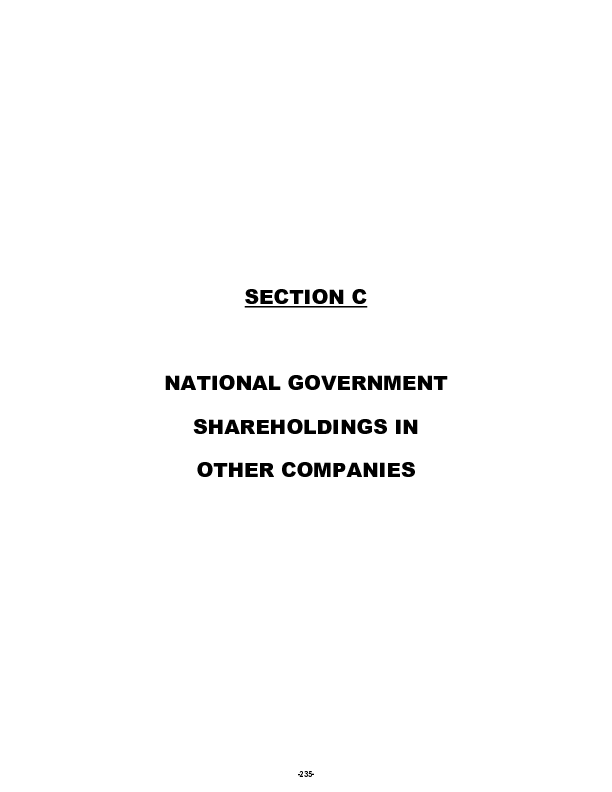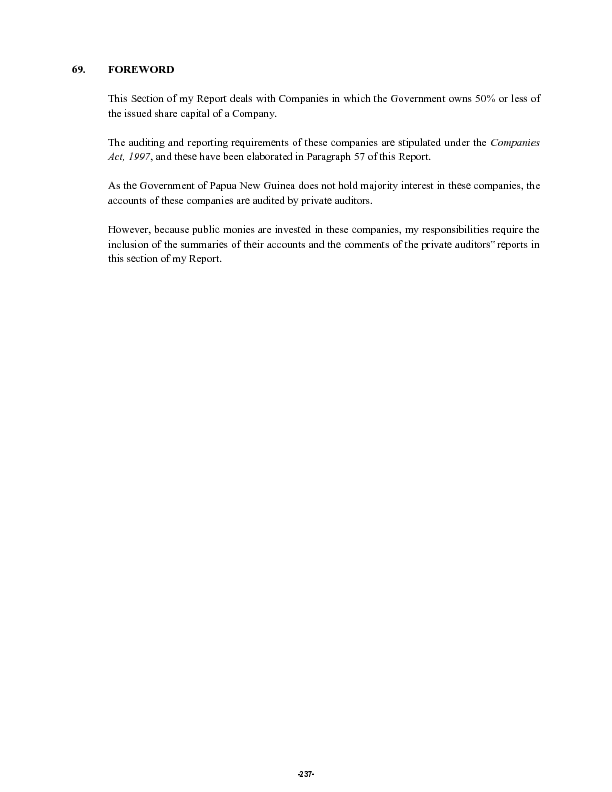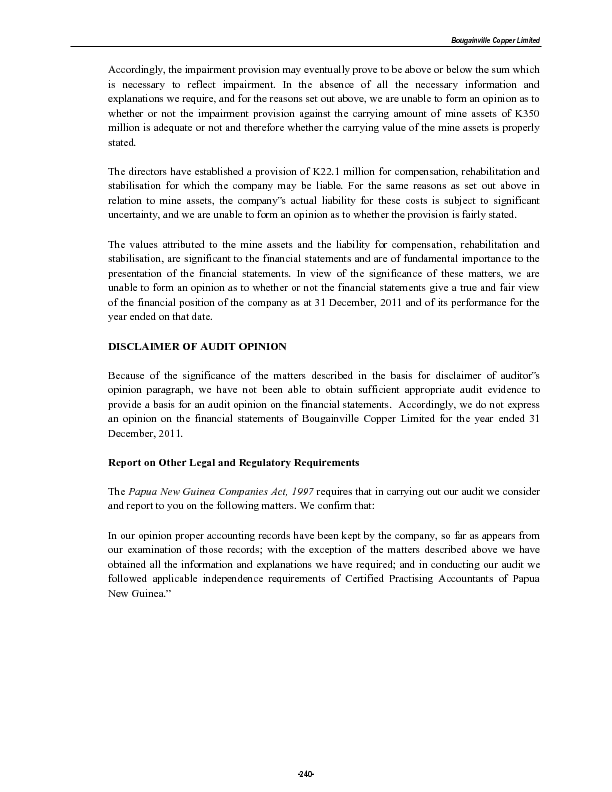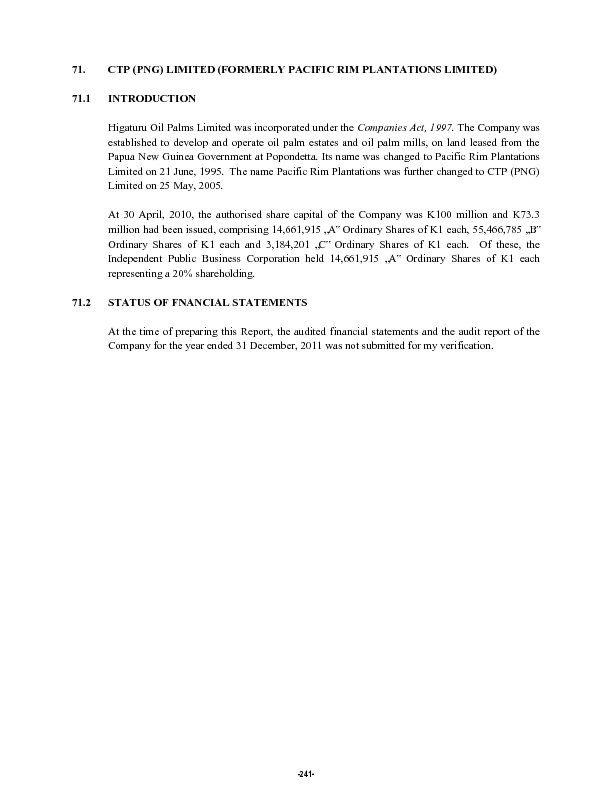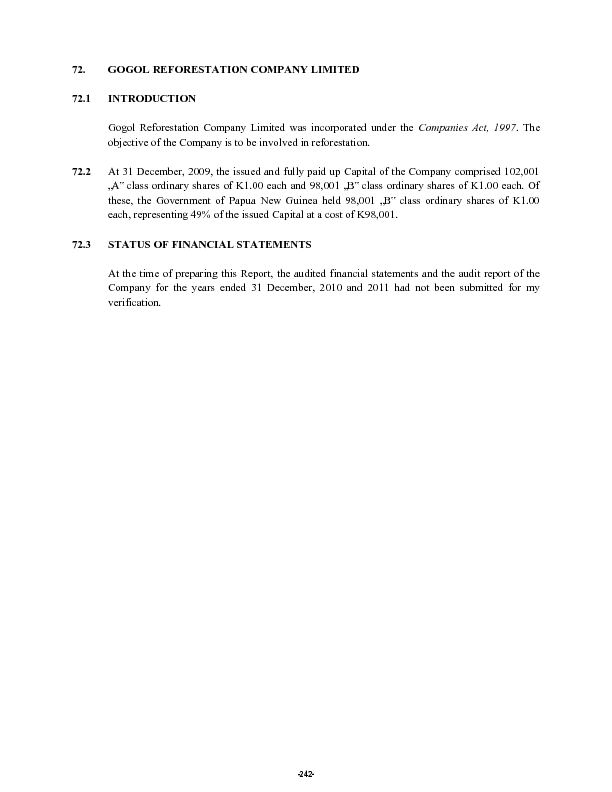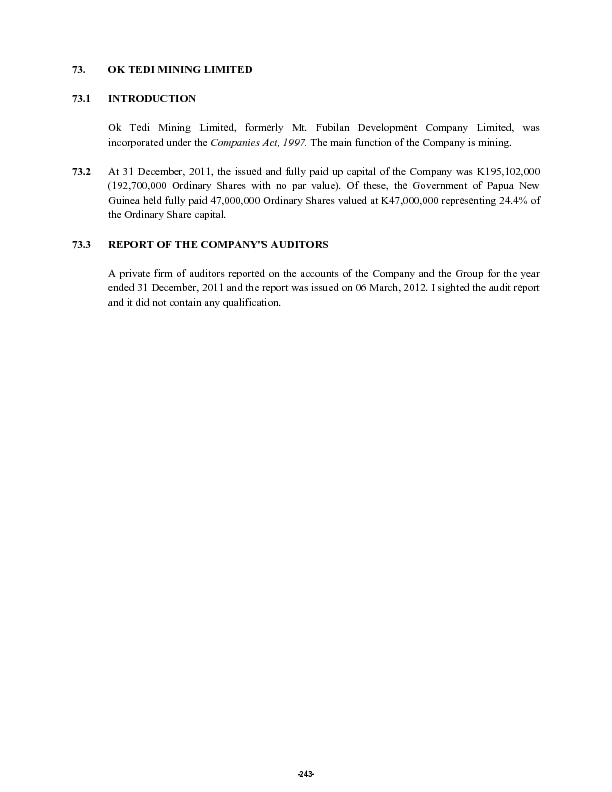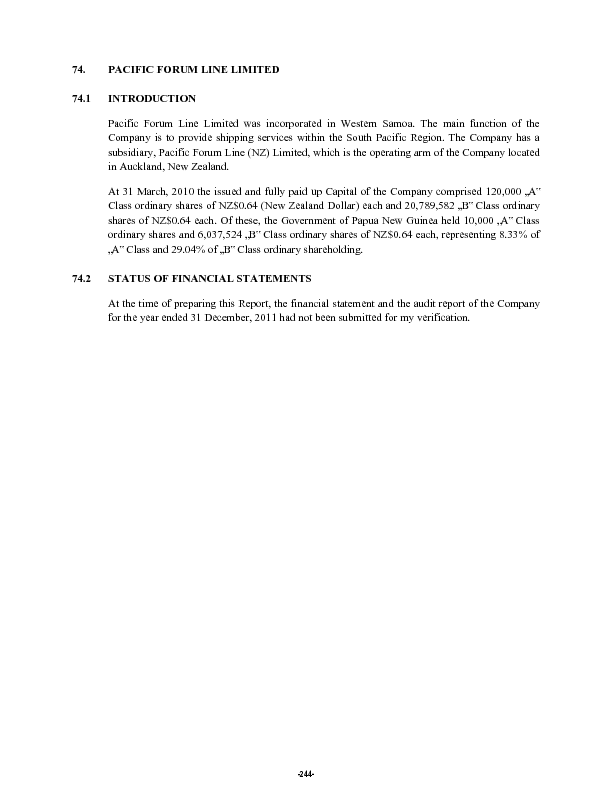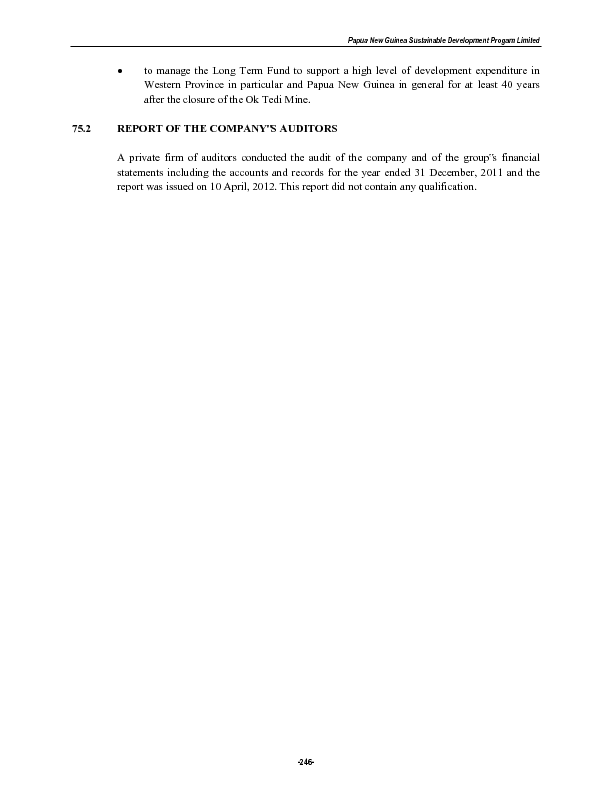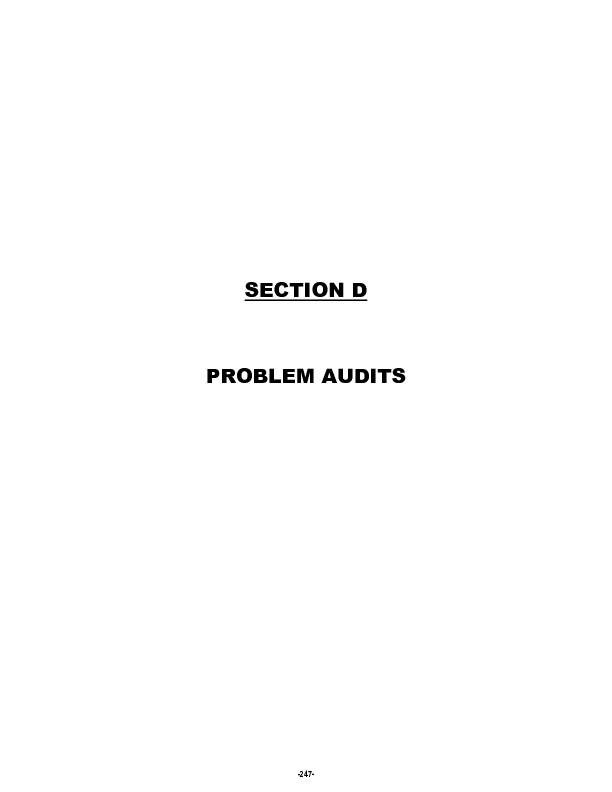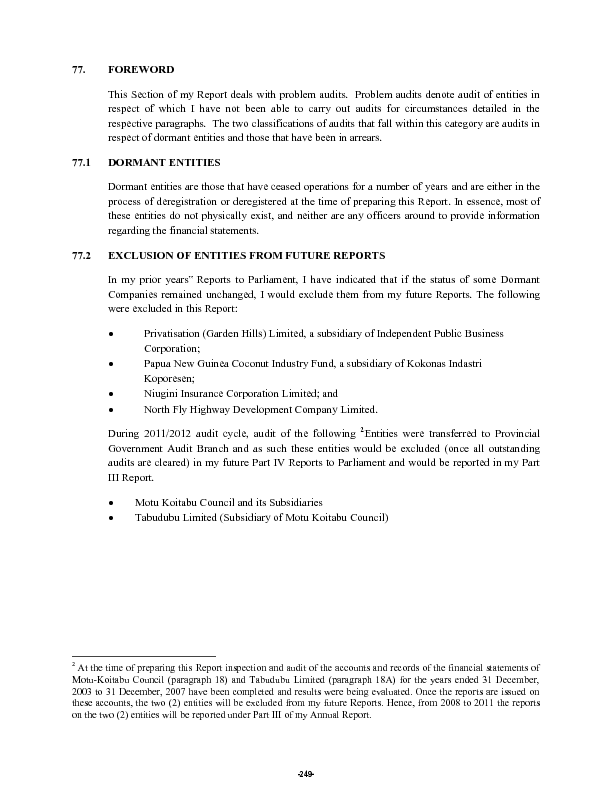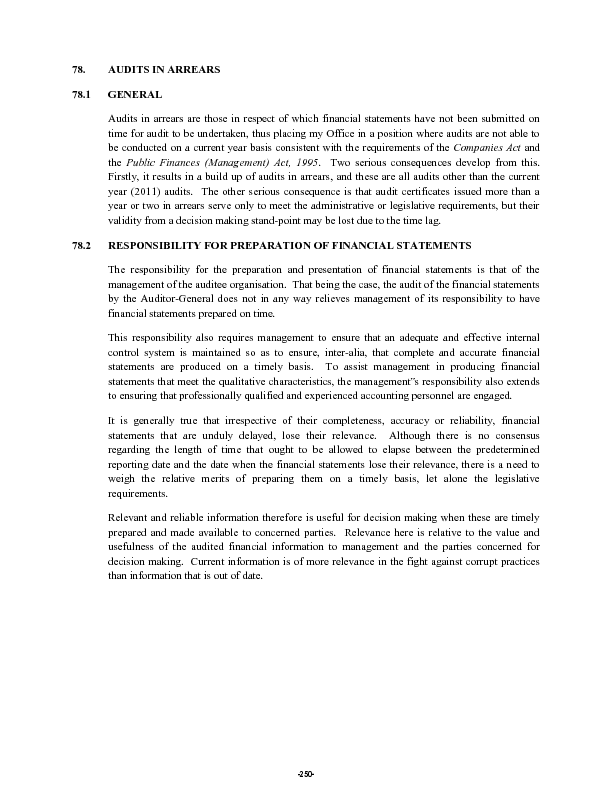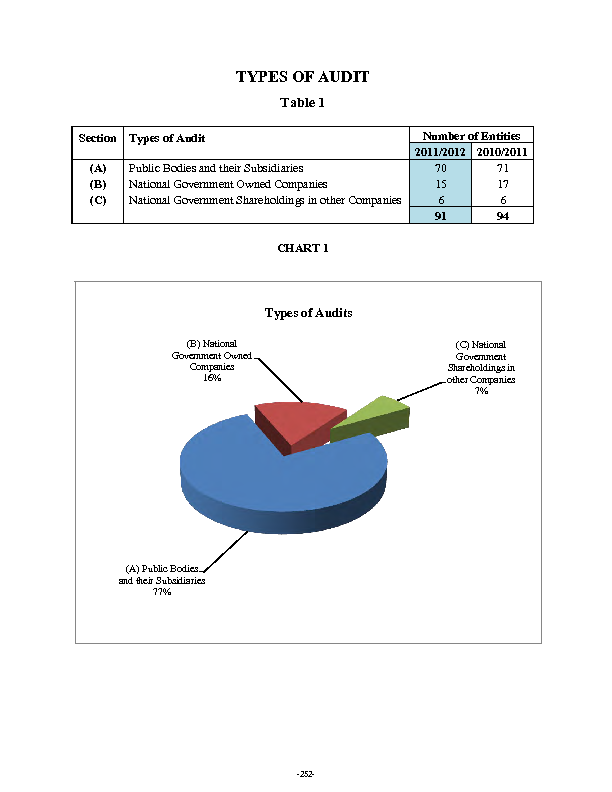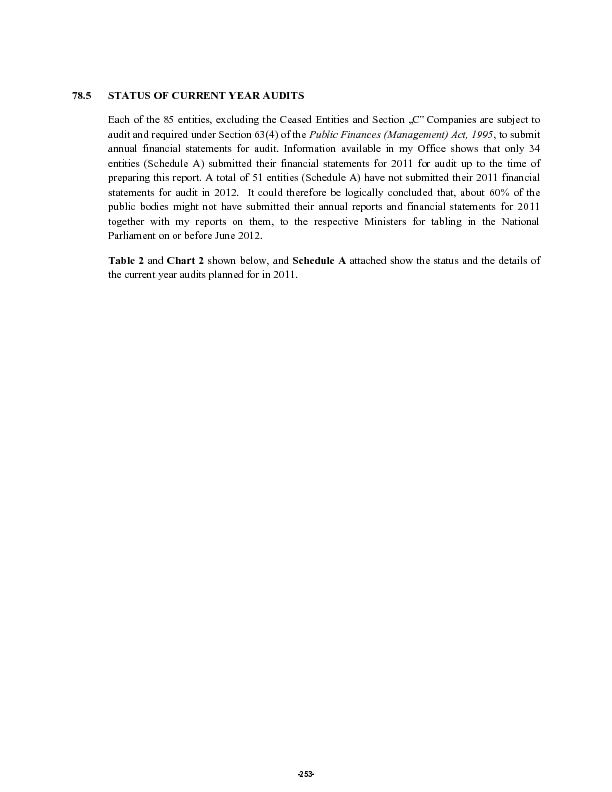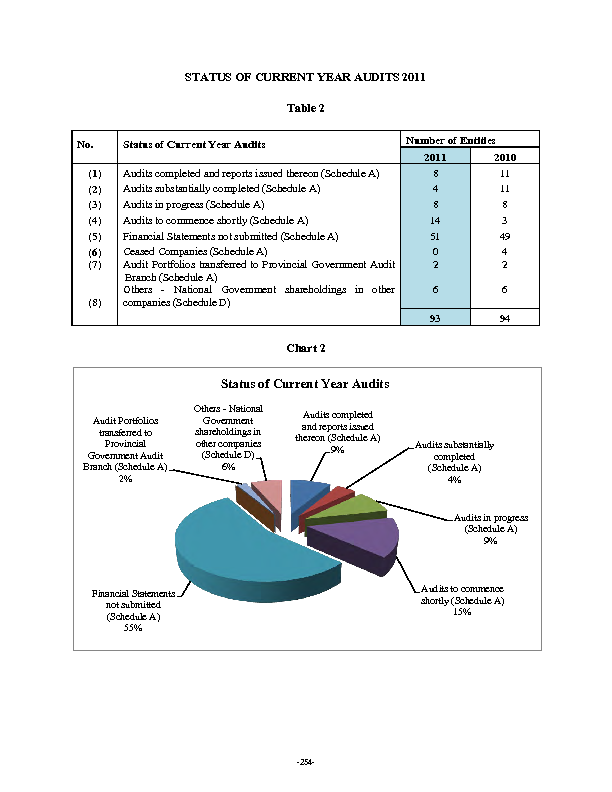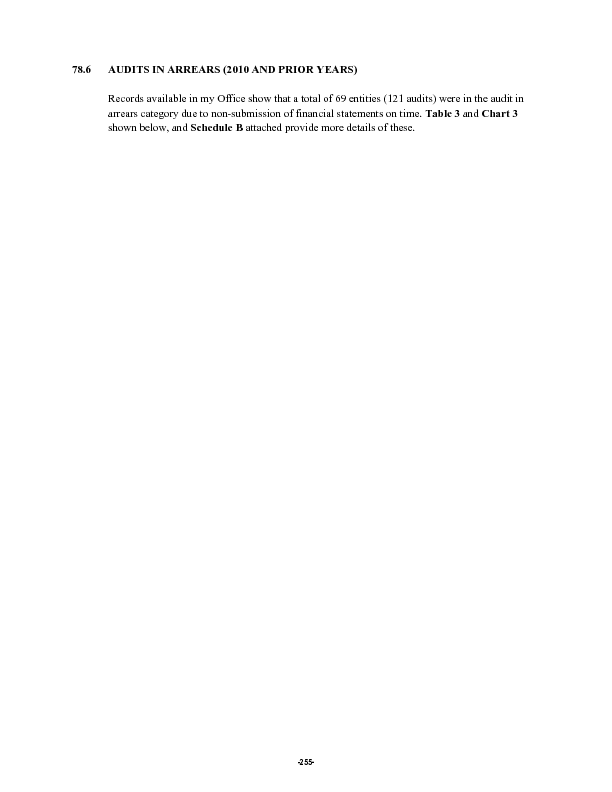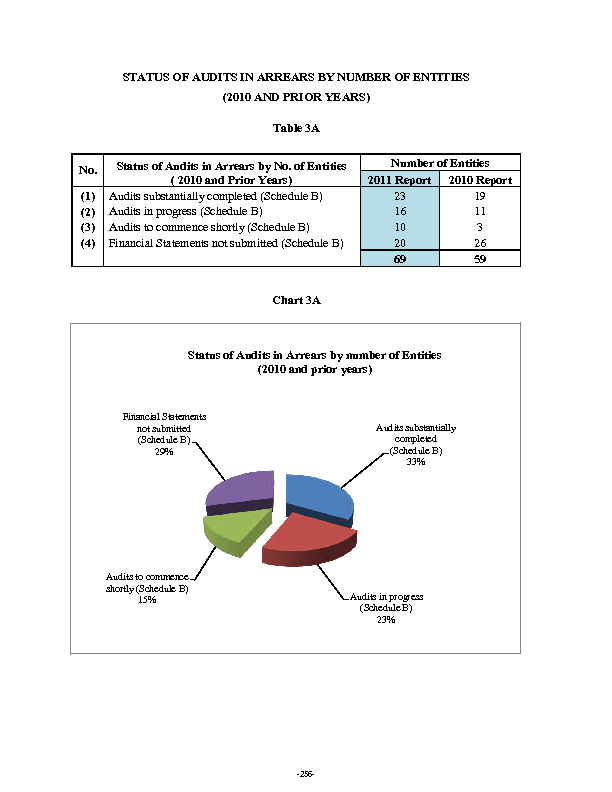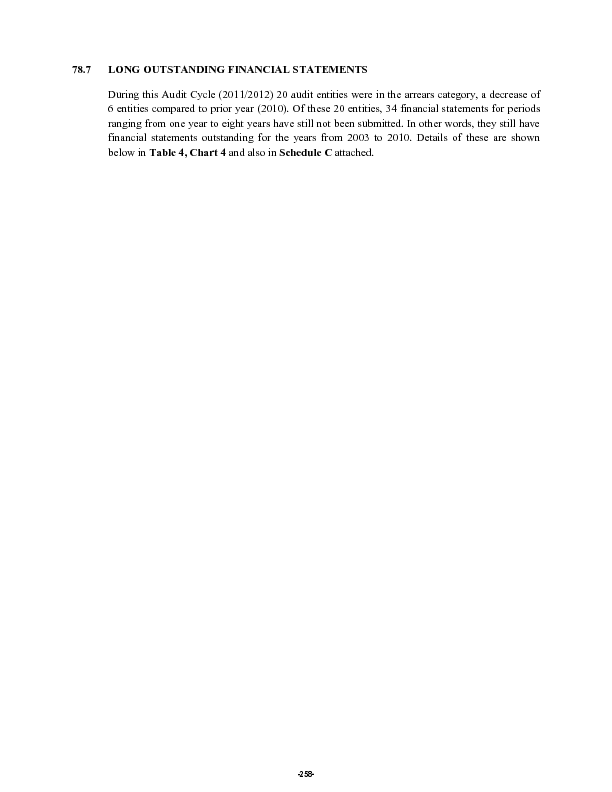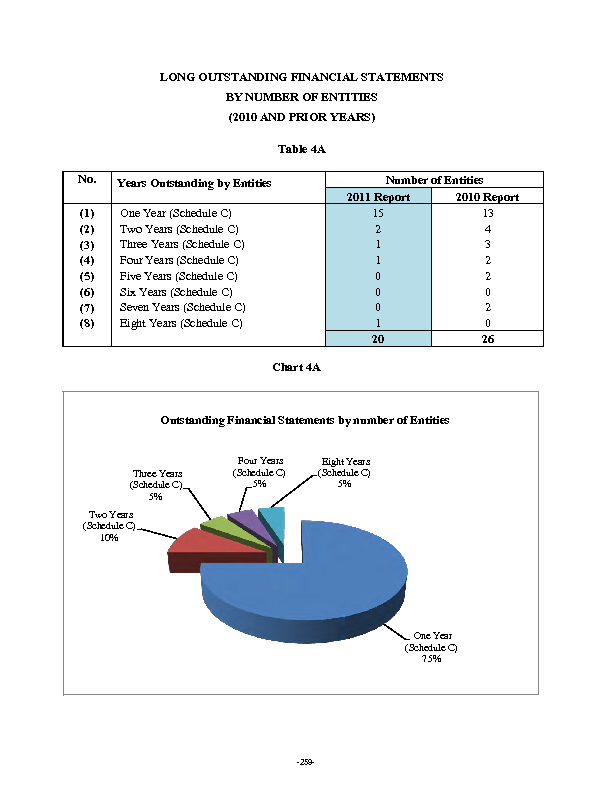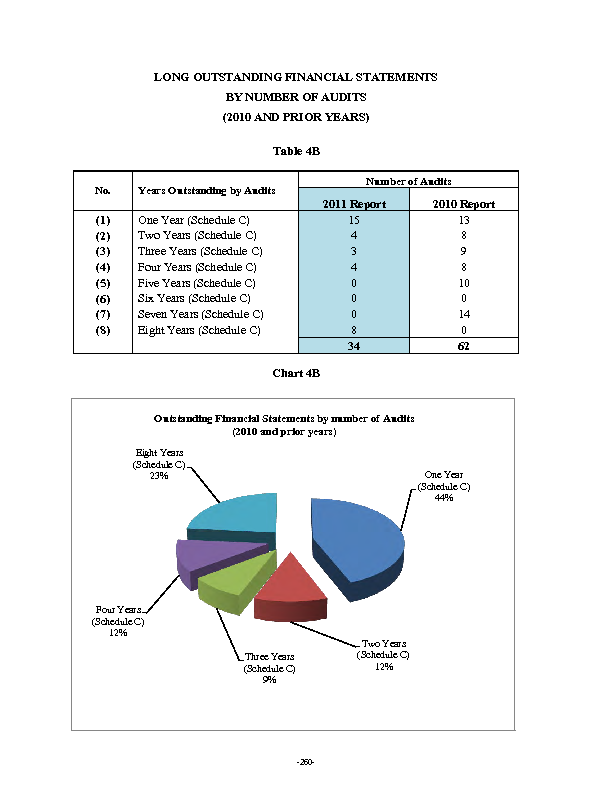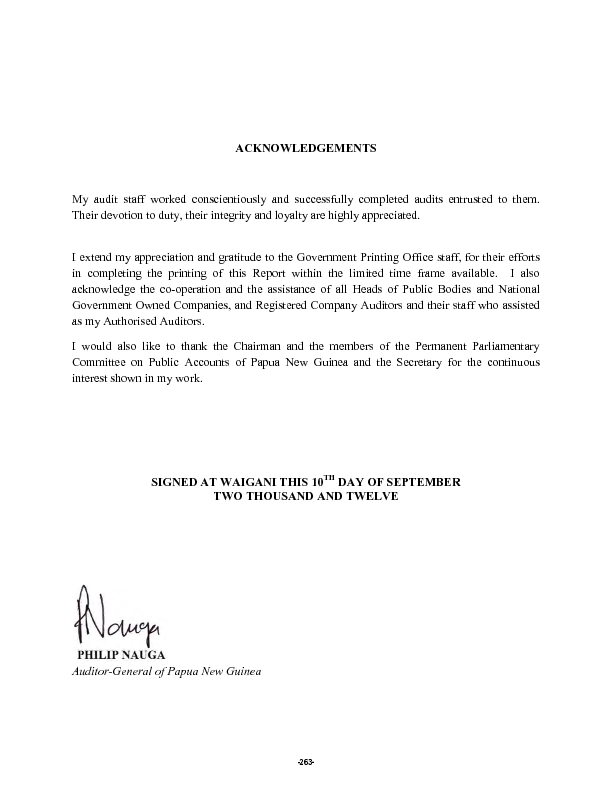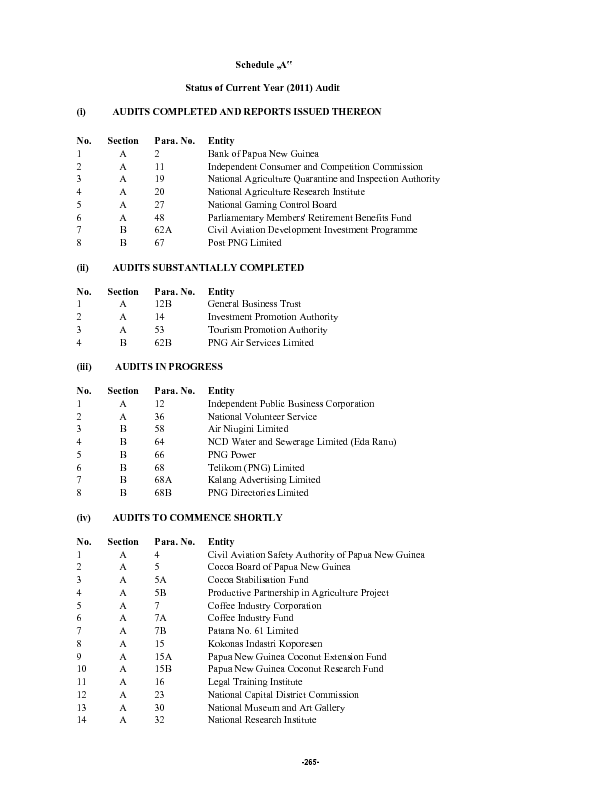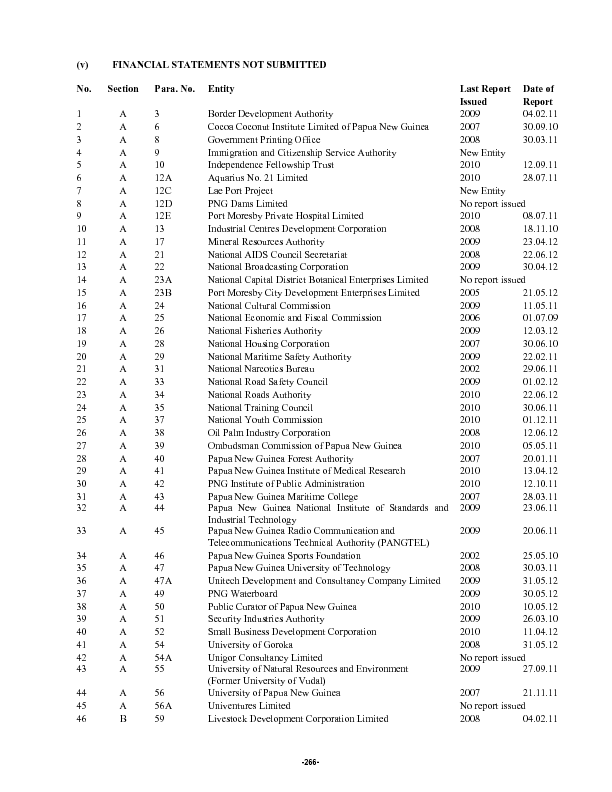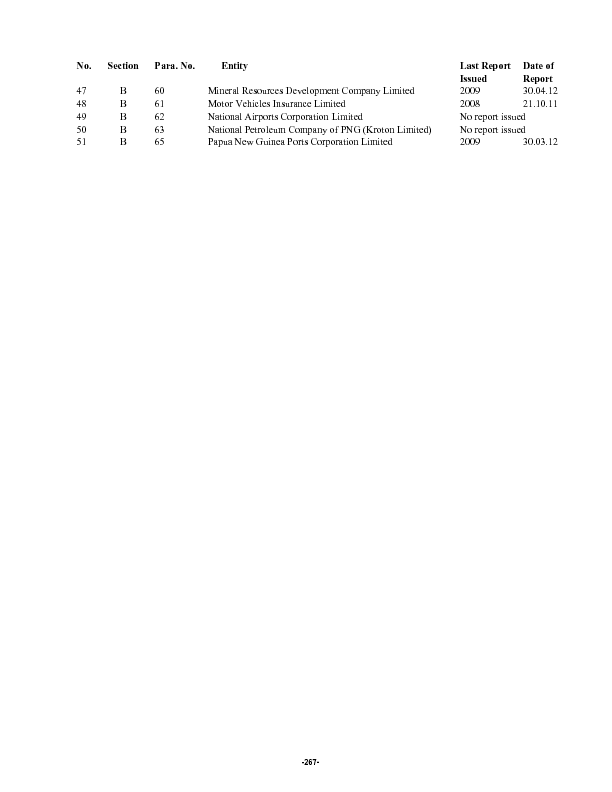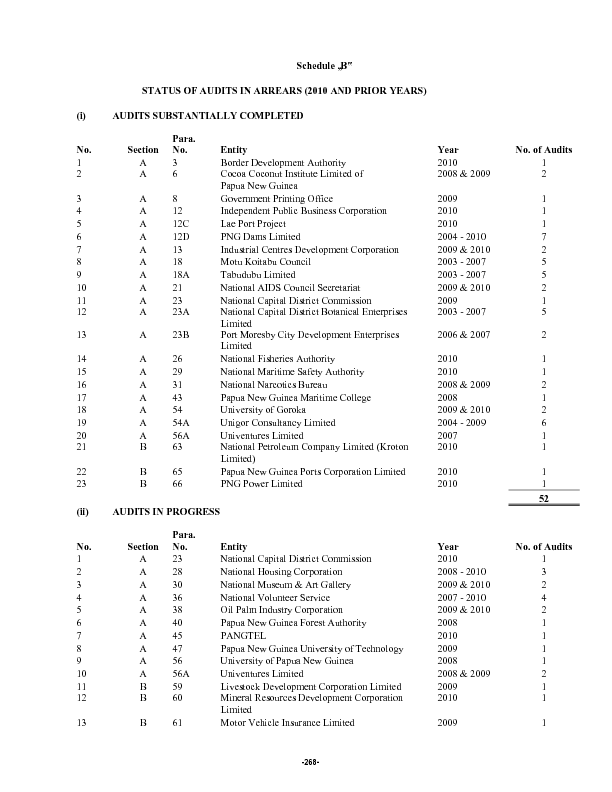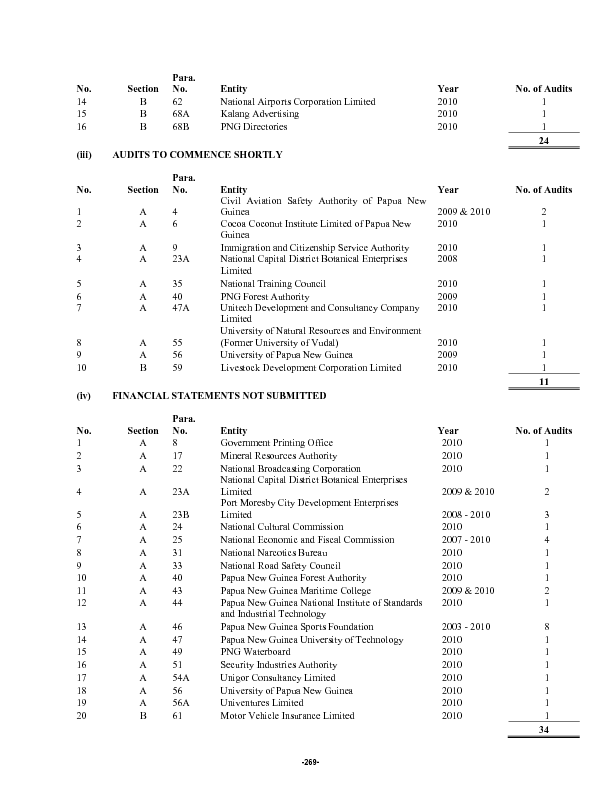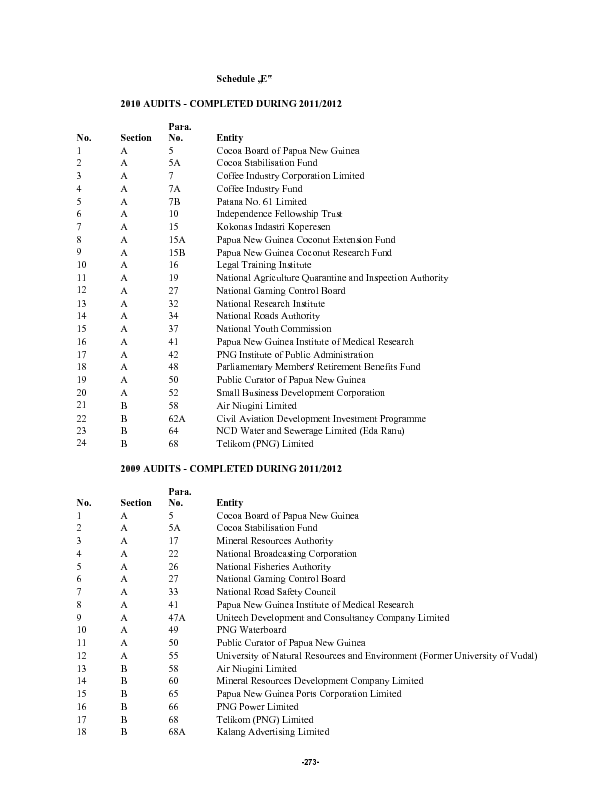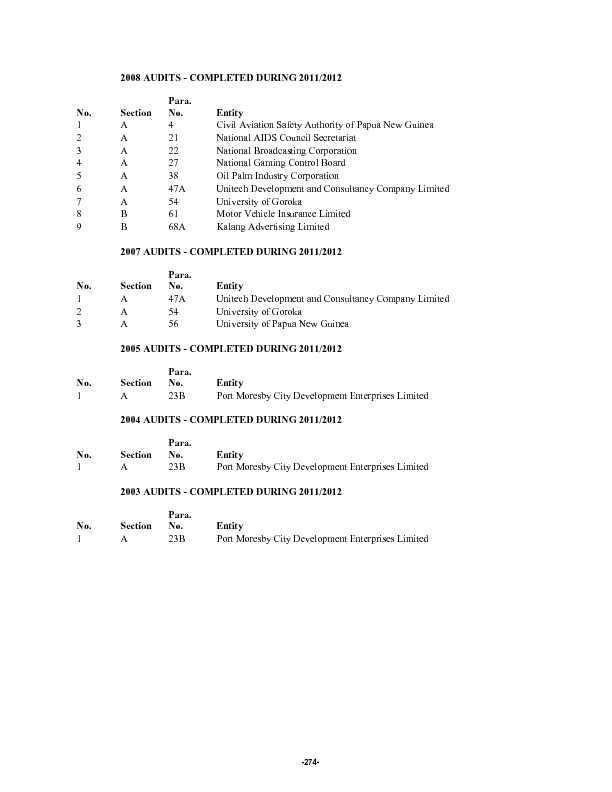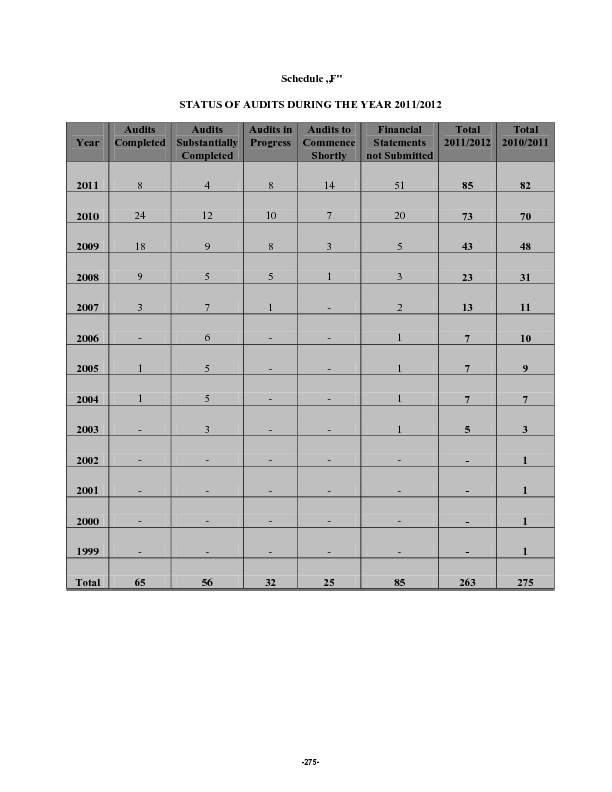Part IV- Report of the Auditor-General 2011 on the Accounts of Public Authorities and Statutory Bodies and Government Owned Companies
Mentions of people and company names in this document
It is not suggested or implied that simply because a person, company or other entity is mentioned in the documents in the database that they have broken the law or otherwise acted improperly. Read our full disclaimer
Document content
-
Report of the Auditor-General – 2011
on the Accounts of Public Authorities and Statutory Bodies established under the Act of Parliament and Government Owned Companies established under the Companies Act
Part IV
Public Bodies and their Subsidiaries National Government Owned Companies National Government Shareholdings in Other Companies
-
Page 2 of 305
-
Page 3 of 305
-
Report of the Auditor-General – 2011 on the Accounts of Public Authorities and Statutory Bodies established under the Act of Parliament and Government Owned Companies established under the Companies Act
Part IV
Public Bodies and their Subsidiaries National Government Owned Companies National Government Shareholdings in Other Companies
-
Page 4 of 305
-
Page 5 of 305
-
Page 6 of 305
-
Page 7 of 305
-
REPORT OF THE AUDITOR-GENERAL – 2011
PART IV
TABLE OF CONTENTS
PARA SUBJECT PAGE NO. NO.
General …………………………………………………………………………………………………………………………….. V
A. Foreword ……………………………………………………………………………………………………………….. V B. Authority of Audit ……………………………………………………………………………………………………… V C. Audit of Public Bodies …………………………………………………………………………………………….. VII D. Appointment and use of Authorised Auditors ……………………………………………………………… VII E. Executive Summary ………………………………………………………………………………………………. VIII Attachments A – D …………………………………………………………………………………………. XVI
SECTION A PUBLIC BODIES AND THEIR SUBSIDIARIES
PARA SUBJECT PAGE NO. NO.
1. Foreword …………………………………………………………………………………………………………………………… 1
2. Bank of Papua New Guinea …………………………………………………………………………………………………. 3 3. Border Development Authority ………………………………………………………………………………………………. 6 4. Civil Aviation Safety Authority of Papua New Guinea ……………………………………………………………….. 8 5. Cocoa Board of Papua New Guinea and its Subsidiaries ………………………………………………………… 11
5A. Cocoa Stabilization Fund ………………………………………………………………………………………… 15 5B. Productive Partnership In Agriculture Project …………………………………………………………….. 18
6. Cocoa Coconut Institute of Papua New Guinea ………………………………………………………………………. 20 7. Coffee Industry Corporation Limited and its Subsidiaries …………………………………………………………. .21
7A. Coffee Industry Fund………………………………………………………………………………………………. 29 7B. Patana No. 61 Limited ……………………………………………………………………………………………. 32
8. Government Printing Office ………………………………………………………………………………………………….. 35 9. Immigration and Citizenship Service Authority ………………………………………………………………………… 36 10 Independence Fellowship Trust …………………………………………………………………………………………. .. 38 11. Independent Consumer and Competition Commission …………………………………………………………….. 39 12 Independent Public Business Corporation and its Subsidiaries ………………………………………………… 40
12A. Aquarius 21 Limited ……………………………………………………………………………………………….. 42 12B. General Business Trust …………………………………………………………………………………………… 43 12C. Lae Port Development Project ………………………………………………………………………………… 44 12D. PNG Dams Limited ………………………………………………………………………………………………… 45 12E. Port Moresby Private Hospital Limited ………………………………………………………………………. 46
-i-
-
Page 8 of 305
-
PARA SUBJECT PAGE NO. NO.
13. Industrial Centres Development Corporation ………………………………………………………………………….. 47 14. Investment Promotion Authority …………………………………………………………………………………………… 48 15. Kokonas Indastri Koporesen and its Subsidiaries ……………………………………………………………………. 49
15A. Papua New Guinea Coconut Extension Fund …………………………………………………………….. 50 15B. Papua New Guinea Coconut Research Fund …………………………………………………………….. 51
16. Legal Training Institute ………………………………………………………………………………………………………… 52 17. Mineral Resources Authority ……………………………………………………………………………………………….. 57 18. Motu Koitabu Council and its Subsidiary ………………………………………………………………………………… 63
18A. Tabudubu Limited ………………………………………………………………………………………………….. 64
19. National Agriculture Quarantine and Inspection Authority …………………………………………………………. 65 20. National Agriculture Research Institute ………………………………………………………………………………….. 68 21. National AIDS Council Secretariat…………………………………………………………………………………………. 70 22. National Broadcasting Corporation Limited …………………………………………………………………………….. 76 23. National Capital District Commission and its Subsidiaries ………………………………………………………… 80
23A. National Capital District Botanical Enterprises Limited…………………………………………………. 82 23B. Port Moresby City Development Enterprises Limited …………………………………………………… 83
24. National Cultural Commission ………………………………………………………………………………………………. 85 25. National Economic and Fiscal Commission ……………………………………………………………………………. 86 26. National Fisheries Authority …………………………………………………………………………………………………. 88 27. National Gaming Control Board ……………………………………………………………………………………………. 91 28. National Housing Corporation ………………………………………………………………………………………………. 98 29. National Maritime Safety Authority ………………………………………………………………………………………… 99 30. National Museum and Art Gallery ……………………………………………………………………………………….. 101 31. National Narcotics Bureau………………………………………………………………………………………………….. 102 32. National Research Institute ……………………………………………………………………………………………….. 103 33. National Road Safety Council …………………………………………………………………………………………….. 105 34. National Roads Authority……………………………………………………………………………………………………. 107 35. National Training Council ………………………………………………………………………………………………….. 111 36. National Volunteer Service …………………………………………………………………………………………………. 112 37. National Youth Commission ……………………………………………………………………………………………….. 113 38. Oil Palm Industry Corporation ……………………………………………………………………………………………. 115 39. Ombudsman Commission of Papua New Guinea ………………………………………………………………….. 117 40. Papua New Guinea Forest Authority ……………………………………………………………………………………. 118 41. Papua New Guinea Institute of Medical Research …………………………………………………………………. 120 42. Papua New Guinea Institute of Public Administration …………………………………………………………….. 122 43. Papua New Guinea Maritime College …………………………………………………………………………………. 124 44. Papua New Guinea National Institute of Standards and Industrial Technology …………………………. 125 45. Papua New Guinea Radio Communications & Telecommunications Technical Authority (PANGTEL) …………………………………………………………………………………………………………………….. 126 46. Papua New Guinea Sports Foundation ……………………………………………………………………………….. 127 47. Papua New Guinea University of Technology and its Subsidiary ……………………………………………… 129
47A. Unitech Development and Consultancy Company Limited …………………………………………. 130
-ii-
-
Page 9 of 305
-
PARA SUBJECT PAGE NO. NO.
48. Parliamentary Members’ Retirement Benefits Fund ………………………………………………………………. 133 49. PNG Waterboard ………………………………………………………………………………………………………………. 134 50. Public Curator of Papua New Guinea…………………………………………………………………………………… 137 51. Security Industries Authority ……………………………………………………………………………………………….. 159 52. Small Business Development Corporation …………………………………………………………………………… 160 53. Tourism Promotion Authority ……………………………………………………………………………………………… 163 54. University of Goroka and its Subsidiary………………………………………………………………………………… 164
54A. Unigor Consultancy Limited …………………………………………………………………………………… 168
55. University of Natural Resources and Environment ………………………………………………………………… 170 56. University of Papua New Guinea and its Subsidiary ……………………………………………………………… 173
56A. Univentures Limited …………………………………………………………………………………………….. 179
SECTION B – NATIONAL GOVERNMENT OWNED COMPANIES
PARA SUBJECT PAGE NO. NO.
57. Foreword …………………………………………………………………………………………………………………………. 183 58. Air Niugini Limited …………………………………………………………………………………………………………….. 185 59 Livestock Development Corporation Limited …………………………………………………………………………. 187 60. Mineral Resources Development Company Limited ………………………………………………………………. 188 61. Motor Vehicles Insurance Limited ……………………………………………………………………………………….. 195 62. National Airports Corporation Limited and its Subsidiaries ……………………………………………………… 198
62A. Civil Aviation Development Investment Programme (CADIP) …………………………………….. 199 62B. PNG Air Services Limited ……………………………………………………………………………………… 202
63. National Petroleum Company of PNG (Kroton) Limited …………………………………………………………. 203 64. NCD Water and Sewerage Limited (Eda Ranu) …………………………………………………………………….. 204 65. Papua New Guinea Ports Corporation Limited ………………………………………………………………………. 206 66. PNG Power Limited …………………………………………………………………………………………………………… 209 67. Post PNG Limited …………………………………………………………………………………………………………….. 224 68. Telikom PNG Limited and its Subsidiaries ……………………………………………………………………………. 226
68A. Kalang Advertising Limited …………………………………………………………………………………….. 231 68B. PNG Directories Limited ………………………………………………………………………………………… 234
-iii-
-
Page 10 of 305
-
SECTION C – NATIONAL GOVERNMENT SHAREHOLDINGS IN OTHER COMPANIES
PARA SUBJECT PAGE NO. NO.
69. Foreword …………………………………………………………………………………………………………………………. 237 70. Bougainville Copper Limited ……………………………………………………………………………………………….. 239 71. CTP (PNG) Limited …………………………………………………………………………………………………………… 241 72. Gogol Reforestation Company Limited…………………………………………………………………………………. 242 73. Ok Tedi Mining Limited………………………………………………………………………………………………………. 243 74. Pacific Forum Line Limited …………………………………………………………………………………………………. 244 75. PNG Sustainable Development Program Limited ………………………………………………………………….. 245
SECTION D – PROBLEM AUDITS
PARA SUBJECT PAGE NO. NO.
77. Foreword………………………………………………………………………………………………………………………… 249
77.1 Dormant Entities…………………………………………………………………………………………………… 249 77.2 Exclusion of Entities from Future Reports ………………………………………………………………… 249
78. Audits in Arrears ……………………………………………………………………………………………………………… 250
78.1 General ……………………………………………………………………………………………………………… 250 78.2 Responsibility for preparation of Financial Statements ……………………………………………… 250 78.3 Legislative Requirements …………………………………………………………………………………….. 251 78.4 Current Year Audits (2011 Audits) …………………………………………………………………………. 251 78.5 Status of Current Year Audits ……………………………………………………………………………….. 253 78.6 Audits in Arrears (2010 and prior years) …………………………………………………………………. 255 78.7 Long Outstanding Financial Statements …………………………………………………………………. 258 78.8 Status of Audits as at 30 June 2011 ………………………………………………………………………. 261
Acknowledgements ………………………………………………………………………………………………………….. 263
Schedule A – Current Year Audits ………………………………………………………………………………………. 265
Schedule B – Status of Audits in Arrears ……………………………………………………………………………… 268
Schedule C – Long Outstanding Financial Statements ………………………………………………………….. 270
Schedule D – Non-Operational Entities and Others ………………………………………………………………. 272
Schedule E – Prior year Audits completed during 2011/2012 …………………………………………………. 273
Schedule F – Status of Audits during the year 2011/2012 ………………………………………………………. 275
-iv-
-
Page 11 of 305
-
GENERAL
A. FOREWORD
My Annual Report to the National Parliament for the 2011 financial year is presented in four Parts. Part I deals with the Public Accounts of Papua New Guinea. Part II deals with National Government Departments and the Provincial Treasury Offices, whilst Part III deals with the audit of the Provincial Governments and Local-Level Governments.
Part IV (this Part) of my Report deals with Public Bodies and their Subsidiaries, Government Owned Companies and National Government‟s shareholdings in Other Companies.
This Report is divided into four sections. Section A deals with Public Bodies and their subsidiaries, Section B deals with National Government owned companies and Section C deals with Companies in which the National Government has shareholdings. Section D is an additional section which provides details of entities that have ceased operating and those other entities the audits of which have been in arrears due to non-submission of financial statements.
The audit findings contained in Sections A and B of this Report have been reported to the Management of the respective entities and to the responsible Ministers.
B. AUTHORITY TO AUDIT
B.1 Constitution
Under Section 214(2) of the Constitution of the Independent State of Papua New Guinea, I am required to inspect and audit all bodies set up by Acts of the Parliament, or by Executive or Administrative Act of the National Executive for governmental or official purposes unless other provisions are made by law in respect of their inspection and audit.
I am also empowered under Section 214(3), if I consider it proper to do so, to inspect and audit and report to the Parliament on any accounts, finances or property of a body, insofar as they relate to, or consist of, or are derived from public moneys or property of Papua New Guinea.
B.2 Audit Act
By virtue of Section 214(4) of the Constitution, the Audit Act, 1989, which became effective from 1 May, 1989, provides more details of my functions under Sub-sections (1), (2) and (3) of the Constitution. The Audit Act that was derived from the Constitution elaborates the functions and the duties of the Auditor-General. This Act was amended in 1995, and the relevant provisions of the amended Act are explained below.
-v-
-
Page 12 of 305
-
General
B.3 Auditing and Reporting Requirements
In Section 8, Sub-sections 2 and 4 of the Act were amended to include provisions governing the auditing and the reporting requirements of public bodies including government owned companies incorporated under the Companies Act, 1997.
B.4 Matters of Significant Importance
Under Section 8(2) of the Act, I am required to inspect and audit the accounts and records of financial transactions and the records relating to the assets and liabilities of these public bodies and their subsidiaries, and to report to the Minister vested with the responsibility for the public body and the Minister in charge of Finance any irregularities found during the inspection and audit.
B.5 Audit Opinion on Financial Statements
Section 8(4) of the Act requires me to audit the financial statements of the public bodies and to report an opinion to the aforementioned Ministers on:
(i) whether the financial statements are based on proper accounts and records; (ii) whether the financial statements are in agreement with those accounts and records; and (iii) whether they show fairly the financial operations for the period which they cover and the state of affairs at the end of that period.
B.6 Public Finances (Management) Act, 1995
The submission of the financial statements of the public bodies for audit is required under Section 63(4) of the Public Finances (Management) Act, 1995.
The section requires each public body to prepare and furnish to its Minister before 30 June each year, a report on its operations for the year ended on 31 December preceding, together with financial statements in respect of that year duly audited by me.
The Minister is then required to table the report on the operations and the financial statements, together with my report on the financial statements, at the first meeting of the Parliament after receiving them.
B.7 Companies Act, 1997
I am required to audit National Government owned companies and subsidiary companies under the provisions of the Companies Act, 1997.
-vi-
-
Page 13 of 305
-
General
Though these companies are registered under the Companies Act, my responsibility to audit them is by virtue of Sections 48 and 63 of the Public Finances (Management) Act and Section 3 of the Audit Act.
C. AUDIT OF PUBLIC BODIES
C.1 Scope of Audit
Presently, the limited resources available to my Office are directed primarily towards financial attestation and compliance or regularity audit of Public Bodies. Due to resource constraints, I have not been able to venture into the audits of information systems and performance audits.
The full scope of my audit responsibility in respect of Public Bodies covers the Statutory Bodies and their subsidiaries, National Government owned companies and their subsidiaries, and the companies in which the government has minority interest.
C.2 Audit Objectives
Under the Companies Act, I am required to ascertain whether proper accounting records have been kept; whether the financial statements comply with generally accepted accounting practice; and whether those financial statements give a true and fair view of the matters to which they relate. The Act also requires the auditor to report the instances of non-compliance with these requirements. More details on the audit responsibilities under the Companies Act are provided in paragraph 57 which covers the National Government owned companies.
C.3 Reporting Framework
My audits are conducted in accordance with International Standards on Auditing to provide reasonable assurance that the financial statements are free of material misstatements. The audit procedures include examination, on a test basis, of evidence supporting the amounts and other disclosures in the financial statements, evaluation of accounting policies and significant accounting estimates, and ensuring that the financial statements are presented fairly and in accordance with International Accounting Standards and the Statutory requirements.
D. APPOINTMENT AND USE OF AUTHORISED AUDITORS
Section 8(5) of the Audit Act, 1989 (as amended), empowers me to employ registered company auditors to assist me in undertaking my constitutional duties, where such assistance is required.
During the period covered in the Report, I engaged a number of registered company auditors to perform audits of numerous Statutory Bodies and National Government owned companies.
-vii-
-
Page 14 of 305
-
2011 AUDITOR-GENERAL‟S REPORT – PART IV
E. EXECUTIVE SUMMARY
E.1 Report Coverage
This Report covers the audit reports issued by my Office on the audits of Public Bodies and their Subsidiaries, Government Owned Companies and National Government‟s shareholdings in Other Companies during the period July 2011 to June 2012 (2011/2012 Audit Cycle). The Report covers the audits of these entities‟ financial statements for a number of years, and not just 2011.
In 2011 there were 85 public entities subject to audit by my Office, consisting of 70 Public Bodies and their Subsidiaries and 15 National Government Owned Companies.
I am also responsible for reporting on the audits of 6 Companies, in which the National Government has a minority shareholding, that are audited by the private sector. These are reported under Section C of this Report.
E.2 Consistency in audit findings over a number of years
The Report‟s findings are consistent with those in my previous years‟ reports that have highlighted my concerns over the number of entities that do not submit current year financial statements for audit, and the poor state of the financial management structure in most public entities whose statements are subject to my audit and inspection.
E.3 Submission of current year Financial Statements
Section 63(4) of the Public Finances (Management) Act, 1995 requires a „… public body to prepare and furnish to its Minister before 30 June each year, a performance and management report of its operations for the year ended 31 December preceding, together with financial statements to enable the Minister to present such report and statements to the Parliament …‟ Before submitting the financial statements to the Minister, Section 63(4) requires a public body to submit the financial statements to the Auditor-General and for the Auditor-General to report to the Minister in accordance with Part II of the Audit Act, 1989 (as amended).
Despite these legislative requirements, 51 entities had not submitted their 2011 financial statements to be audited and overall some 34 financial statements for 2010 and prior years had not been submitted for audit (Refer Table 1).
-viii-
-
Page 15 of 305
-
Executive Summary
The details of the audits in arrears and those entities whose financial statements have been outstanding for a number of years are shown in Attachment „B‟.
Table 1
STATUS OF AUDITS DURING THE YEAR 2011 (END OF 2011/2012 CYCLE)
Audits Audits Audits in Audits to Financial Total Total Year Completed Substantially Progress Commence Statements 2011/2012 2010/2011 Completed Shortly not Submitted 2011 8 4 8 14 51 85 82 2010 24 12 10 7 20 73 70 2009 18 9 8 3 5 43 48 2008 18 5 5 1 3 23 31 2007 3 7 1 – 2 13 11 2006 – 6 – – 1 7 10 2005 1 5 – – 1 7 9 2004 1 5 – – 1 7 7 2003 1 3 – – 1 5 3 2002 – – – – – – 1 2001 – – – – – – 1 2000 – – – – – – 1 1999 – – – – – – 1 Total 65 56 32 25 85 263 275
Table 1 also shows that 153 audits were completed, substantially completed or still in progress as at 30 June, 2012. The details are graphically depicted in Attachment „C‟, which also included the arrears of prior years. Table 1 also shows that of the 65 audits completed, only 8 were for the current year (2011), with 12 current year‟s audits substantially completed or were in progress. A further 14 audits were to commence shortly. Graphical description of status of current year (2011) audits (excluding arrears) is given in Attachment „A‟. The list of entities is at Schedule „A‟ (i), (ii), (iii) and (iv).
E.4 Type of Audit Opinions Issued1
In the period covered by the audit, 65 audit opinions were issued. Of the 65 audit opinions issued, 17 were unqualified, 30 were qualified and 18 were Disclaimer Opinions.
1 The types of audit opinions are: Unqualified Opinion – A Company’s financial statements are presented fairly, in all material respects in conformity with generally accepted accounting principles. Qualified Opinion – The financial statements “except for” certain issues fairly present the financial position and operating results of the firm. The except for opinion relates to inability of the auditor to obtain sufficient objective and verifiable evidence in support of business transactions of the Company being audited. Disclaimer Opinion – When insufficient competent evidential matter exists to form an audit opinion due to scope limitation or uncertainties. Adverse Opinion – The Company’s financial statements do not present fairly the financial position, results of operations, or changes in financial position or are not in conformity with generally accepted accounting principles.
-ix-
-
Page 16 of 305
-
Executive Summary
Of the 17 unqualified opinions issued, 11 related to prior years and only 6 were for 2011 as follows:
Bank of Papua New Guinea; Independent Consumer and Competition Commission; Civil Aviation Development Investment Programme; National Agriculture Research Institute; Post (PNG) Limited; and Parliamentary Benefits Retirement Benefits Fund.
Two of the qualified opinions related to 2011 and others were for prior years. The numbers of Disclaimer Audit Opinions issued are reflection of the poor state of accounting record keeping in a number of public bodies.
The list of entities and the type of audit opinions issued during the period July 2011 to June 2012 are provided in Attachment „D‟.
E.5 Key Findings
The key findings from the audits centred around on the non-submission of the financial statements, non-compliance with the Salaries and Conditions Monitoring Committee (SCMC) regulatory mechanisms for salaries and wages, lack of basic accounting records and ineffective internal control systems. These issues are highlighted in the paragraphs below.
E.6 Non-Submission of Financial Statements
As stated earlier, Section 63(4) of the Public Finances (Management) Act, 1995, requires each public body to prepare and furnish to its Minister before 30 June each year, a report on its operations for the year ended 31 December preceding together with financial statements in respect of that year duly audited by me for tabling in Parliament.
This legislative requirement has not been strictly adhered to by all respective public entities‟ management. To comply with this requirement, the financial statements are required to be submitted to my Office well before 30 June each year for my audit and inspection. Consequently, out of 85 public entities (excluding 2 entities transferred to Provincial Government Audit Branch) only 34 entities (Refer Schedule A (i), (ii), (iii) & (iv) submitted their financial statements for 2011 for my audit and inspection up to the time of preparing this Report. Fifty-one (51) entities (Refer Schedule A(v)) failed to comply with these provisions.
-x-
-
Page 17 of 305
-
Executive Summary
The non-compliance of the public entities mentioned above has resulted in:
My Office not being able to report adequately on the accountability of the use of public resources in a timely manner;
A build up of audits in arrears; and
The non-tabling of Annual Reports on performance and management by public entities in the Parliament.
Responsibility for Submission of Financial Statements
An entity‟s management is responsible for preparing and presenting financial statements for my audit and inspection. It is also the responsibility of management to ensure that an adequate and effective internal control system is maintained to ensure that complete and accurate financial statements are produced on a timely basis.
My Office recommends
A vigorous enforcement of the provisions of Section 63 of the Public Finances (Management) Act; and
A legislative requirement to make the renewal of contracts of Chief Executive Officers subject to submission of financial statements and prudent financial management.
These recommendations are to help achieve accountability and good governance in the public sector.
Details of audits that have gone into arrears due to non-submission of financial statements from 2010 or earlier are given below in Table 2 and Schedule „C‟.
Table 2
Financial Statements not Submitted
No. Section Para Entity Year in Audits in Arrears 2010 No. Arrears & Prior Years 1 A 8 Government Printing Office 1 2010 2 A 17 Mineral Resources Authority 1 2010 3 A 22 National Broadcasting Corporation 1 2010 4 A 23A National Capital District Botanical Enterprises 2 2009 & 2010 Limited 5 A 23B Port Moresby City Development Enterprises 3 2008 – 2010 Limited
-xi-
-
Page 18 of 305
-
Executive Summary
No. Section Para Entity Year in Audits in Arrears 2010 No. Arrears & Prior Years 6 A 24 National Cultural Commission 1 2010 7 A 25 National Economic and Fiscal Commission 4 2007 – 2010 8 A 31 National Narcotics Bureau 1 2010 9 A 33 National Road Safety Council 1 2010 10 A 40 Papua New Guinea Forest Authority 1 2010 11 A 43 Papua New Guinea Maritime College 2 2009 & 2010 12 A 44 Papua New Guinea National Institute of 1 2010 Standards and Industrial Technology 13 A 46 Papua New Guinea Sports Foundation 8 2003 – 2010 14 A 47 Papua New Guinea University of Technology 1 2010 15 A 49 PNG Waterboard 1 2010 16 A 51 Security Industries Authority 1 2010 17 A 54A Unigor Consultancy Limited 1 2010 18 A 56 University of Papua New Guinea 1 2010 19 A 56A Univentures Limited 1 2010 20 B 61 Motor Vehicle Insurance Limited 1 2010
My Arrears Reduction Strategies
During the last Audit Cycle, I have taken steps as in the past to remind various entities of their responsibilities to submit the financial statements on a timely basis. These steps include but are not limited to the following:
(i) Forwarding reminder letters to entities on a regular basis until the submission of the financial statements.
(ii) Copies of these reminder letters were forwarded to the Public Accounts Committee and to the Secretary for Finance for their necessary action.
(iii) My officers have visited various entities and had meeting with the Chief Executive Officers regarding non-submission of the financial statements and drew their attention to the responsibility under the Public Finances (Management) Act and resultant breach of the Public Finances (Management) Act.
E.7 Non-Compliance of the Salaries and Conditions Monitoring Committee Act, 1988
The SCMC was established as the regulatory mechanism for salaries and wages in the public sector. Sadly, some public bodies do not comply with the provisions of this Act because of legislative changes in their constituent Acts. As a result, these bodies pay salaries and allowances without any monitoring from this Committee. Consequently, they have contravened Section (3) of the Salaries and Conditions Monitoring Committee Act, (SCMC) 1988 which stipulates:
-xii-
-
Page 19 of 305
-
Executive Summary
“(1) The provisions of this Act apply notwithstanding anything in any other law relating to the determination of salaries and conditions or employment of employees of a public authority; and (2) Where by or under any law, power is given to a public authority, to determine or vary the salaries and conditions of employment of employees of the public authority, that power shall be exercised subject to this Act.”
E.8 Non-compliance with the Audit Act, 1989
Some entities owned by the State have amended their enabling Acts to exclude my Office from performing the audit of those entities and appointed their own auditors contrary to the Audit Act. The following state owned entities have appointed their own Auditors.
(i) Petromin Limited (ii) National Development Bank Limited
E.9 Lack of Basic Accounting Records and Inadequate Control Systems
As reported in previous years, I noted serious deficiencies in accounting and record keeping and maintenance of internal controls during the course of audits. These deficiencies, which contributed to the limitation on the scope of my audit procedures, included:
bank reconciliation statements not being prepared in a timely way or not being prepared at all; transactions not having supporting documentation; fixed asset registers not being properly kept or maintained; no consistent and proper valuation of assets; physical asset stock-takes not being carried out; property being acquired or disposed of without proper procedures being followed; failure to comply with International Financial Reporting Standards in the preparation of the financial statements; travel and other allowances not being fully acquitted; Internal Revenue Commissions regulations on payment of taxes not being followed; entities paying housing allowances and Boards members allowances without tax but allowing officers to pay the tax; accounting, administrative and procedural manuals not being available; public servants serving on Statutory Boards receiving Board allowances contrary to regulations;
-xiii-
-
Page 20 of 305
-
Executive Summary
ineffective internal audit functions; and ineffective budget controls.
The above factors contributed to the limitations on the scope of my audits which resulted in issuance of Disclaimer Audit Opinions in respect of many of the reports issued during the year, as shown in Attachment „D‟.
E.10 Poor Financial Management
Over a number of years, I have expressed my concern about public bodies‟ poor accounting records, weaknesses in internal controls and management information systems, and non-compliance with legislative requirements and International Financial Reporting Standards.
I also consider that a large number of Chief Executive Officers do not pay sufficient attention to financial management in their entities. In my view, the concept of effective, prudent and efficient financial management is yet to be absorbed by many Chief Executive Officers.
E.11 Recommendations for Improvement
Consistent with comments in previous years‟ Reports, I will report to the Parliament in future that proper accounting records and adequate internal control systems must exist in all public entities subject to my audit. For that to be achieved, I believe that Chief Executive Officers are required to exercises proper leadership that provides an environment where there is:
Timely submission of financial statements; Improved record keeping and documentation; Maintenance and provision of quality information; Effective implementation of internal control systems; and Entity financial management that is carried out by qualified and experienced accountants.
E.12 Improvement Strategies
In my view, for improvement to occur:
Chief Executive Officers must employ trained accounting staff to manage the financial affairs of the organization;
-xiv-
-
Page 21 of 305
-
Executive Summary
Chief Executive Officers must understand the value of and how to implement a strong governance framework and their performance assessed against implementation of the framework; and
Parliament must increase its reviews of the management of public entities and provide Chief Executive Officers with the incentives to improve their management structures.
Department of Finance & Treasury must exercise its discretion to invoke on Section 63(8) of the Public Finances (Management) Act, 1995 (as amended) by withholding funds for those entities that have not submitted its financial statements until the financial statements are submitted and/or completion of the audit.
E.13 Structure of the Report
This Report is structured as follows:
Section A – Public Bodies and Their Subsidiaries; Section B – National Government Owned Companies; Section C – National Government Shareholdings in Other Companies; and Section D – Problem Audits.
-xv-
-
Page 22 of 305
-
Executive Summary
ATTACHMENT „A‟
STATUS OF CURRENT YEAR AUDITS 2011
No. Status of Current Year Audits Number of Entities 2011 2010 (1) Audits completed and reports issued thereon (Schedule A) 8 11 (2) Audits substantially completed (Schedule A) 4 11 (3) Audits in progress (Schedule A) 8 8 (4) Audits to commence shortly (Schedule A) 14 3 (5) Financial Statements not submitted (Schedule A) 51 49 (6) Ceased Companies (Schedule A) 0 4 (7) Audit Portfolios transferred to Provincial Government Audit 2 2 Branch (Schedule A) Others – National Government shareholdings in other 6 6 (8) companies (Schedule D) 93 94
Status of Current Year Audits
Others – National Audits completed Audit Portfolios Government and reports issued transferred to Audits substantially shareholdings in thereon (Schedule A) Provincial completed other companies 9% Government Audit (Schedule A) (Schedule D) Branch (Schedule A) 4% 6% 2% Audits in progress (Schedule A) 9%
Audits to commence shortly (Schedule A) 15%
Financial Statements not submitted (Schedule A) 55%
Please refer to Pages 265 to 275 for Schedules A to F.
-xvi-
-
Page 23 of 305
-
Executive Summary
ATTACHMENT „B‟
STATUS OF AUDITS IN ARREARS BY NUMBER OF AUDITS (2010 AND PRIOR YEARS)
No. Status of Audits in Arrears by No. of Audits Number of Audits (2010 & prior years) 2011 Report 2010 Report (1) Audits substantially completed (Schedule B) 52 28 (2) Audits in progress (Schedule B) 24 23 (3) Audits to commence shortly (Schedule B) 11 4 (4) Financial Statements not submitted (Schedule B) 34 62 121 117
Status of Audits in Arrears by number of Audits (2010 and prior years)
Financial Statements not submitted Audits substantially (Schedule B) completed 28% (Schedule B) 43%
Audits to commence shortly (Schedule B) Audits in progress 9% (Schedule B) 20%
-xvii-
-
Page 24 of 305
-
Executive Summary
ATTACHMENT „C‟
STATUS OF AUDITS AS AT 30 JUNE 2012
Number of Audits No. Status of Audits 2011/2012 2010/ 2011 (1) Audits completed and reports issued thereon (Schedule A & E) 65 87 (2) Audits substantially completed (Schedule A & B) 56 39 (3) Audits in progress (Schedule A & B) 32 31 (4) Audits to commence shortly (Schedule A & B) 25 7 (5) Financial Statements not submitted (Schedule A & B) 85 111 263 275
Status of Audits as at 30 June 2012
Financial Statements Audits completed and not submitted reports issued thereon (Schedule A & B) (Schedule A & E) 32% 25%
Audits substantially completed (Schedule A & B) 21%
Audits to commence shortly (Schedule A & B) 10% Audits in progress (Schedule A & B) 12%
-xviii-
-
Page 25 of 305
-
Executive Summary
ATTACHEMNT „D‟
TYPES OF AUDIT OPINIONS ISSUED
(i) UNQUALIFIED OPINION
No. Section Para. No. Entity Year No. of Audits
1 A 2 Bank of Papua New Guinea 2011 1 2 A 10 Independence Fellowship Trust 2010 1 Independent Consumer and Competition 3 A 11 Commission 2011 1 4 A 15 Kokonas Indastri Koperesen 2010 1 5 A 15A Papua New Guinea Coconut Extension Fund 2010 1 6 A 15B Papua New Guinea Coconut Research Fund 2010 1 7 A 16 Legal Training Institute 2010 1 8 A 20 National Agriculture Research Institute 2011 1 9 A 32 National Research Institute 2010 1 10 A 38 Oil Palm Industry Corporation 2008 1 11 A 42 PNG Institute of Public Administration 2010 1 Parliamentary Members’ Retirement Benefits 12 A 48 Fund 2010 & 2011 2 Mineral Resources Development Company 13 B 60 Limited 2009 1 Civil Aviation Development Investment 14 B 62A Programme 2011 1 15 B 67 Post PNG Limited 2011 1 16 B 68 Telikom (PNG) Limited 2010 1 17
(ii) QUALIFIED OPINION
No. Section Para. No. Entity Year No. of Audits
1 A 5 Cocoa Board of Papua New Guinea 2009 & 2010 2 2 A 5A Cocoa Stabilisation Fund 2009 & 2010 2 3 A 7 Coffee Industry Corporation Limited 2010 1 4 A 7A Coffee Industry Fund 2010 1 5 A 7B Patana No. 61 Limited 2010 1 National Agriculture Quarantine and 6 A 19 Inspection Authority 2010 & 2011 2 7 A 26 National Fisheries Authority 2009 1 8 A 27 National Gaming Control Board 2008 – 2011 4 9 A 33 National Road Safety Council 2009 1 10 A 34 National Roads Authority 2010 1 11 A 37 National Youth Commission 2010 1 Papua New Guinea Institute of Medical 12 A 41 Research 2009 & 2010 2 13 A 49 PNG Waterboard 2009 1 14 A 52 Small Business Development Corporation 2010 1 University of Natural Resources and 15 A 55 Environment (Former University of Vudal) 2009 1 16 B 58 Air Niugini Limited 2009 & 2010 2
-xix-
-
Page 26 of 305
-
Executive Summary
No. Section Para. No. Entity No. of Audits
17 B 61 Motor Vehicles Insurance Limited 2008 1 18 B 62A Civil Aviation Development Investment 2010 1 Programme 19 B 64 NCD Water and Sewerage Limited (Eda 2010 1 Ranu) 20 B 68 Telikom (PNG) Limited 2009 1 21 B 68A Kalang Advertising Limited 2008 & 2009 2 30
(iii) DISCLAIMED OPINION
No. Section Para. No. Entity No. of Audits
Civil Aviation Safety Authority of Papua 1 A 4 New Guinea 2008 1 2 A 17 Mineral Resources Authority 2009 1 3 A 21 National AIDS Council Secretariat 2008 1 4 A 22 National Broadcasting Corporation 2008 & 2009 2 Port Moresby City Development Enterprises 5 A 23B Limited 2003 – 2005 3 Unitech Development and Consultancy 6 A 47A Company Limited 2007 – 2009 3 7 A 50 Public Curator of Papua New Guinea 2009 & 2010 2 8 A 54 University of Goroka 2007 & 2008 2 9 A 56 University of Papua New Guinea 2007 1 Papua New Guinea Ports Corporation 10 B 65 Limited 2009 1 11 B 66 PNG Power 2009 1 18
65
(iv) INTERNAL CONTROLS REVIEW REPORTS
No. Section Para.No. Entity 1 A 50 Public Curator of Papua New Guinea 31 Dec 2009-30 1 Jun 2010 1
66
-xx-
-
Page 27 of 305
-
SECTION A
PUBLIC BODIES AND
THEIR SUBSIDIARIES
-
Page 28 of 305
-
Page 29 of 305
-
1. FOREWORD
This Section of my Report deals with the audit of public bodies and their subsidiaries.
The auditing and reporting requirements of the public bodies and their subsidiaries are stipulated in Section 8 of the Audit Act, 1989 (as amended). My findings in that regard are detailed in paragraphs 2 to 56A of this part of my Report.
-1-
-
Page 30 of 305
-
-2-
-
Page 31 of 305
-
2. BANK OF PAPUA NEW GUINEA
2.1 INTRODUCTION
2.1.1 Legislation and Objectives of the Bank
The Bank of Papua New Guinea was established under the Central Banking Act (Chapter 138). This Act was in operation until 16 June, 2000 when it was repealed and replaced by the Central Banking Act, 2000.
The main objectives of the Bank of Papua New Guinea as stipulated in the new Act are:
(a) to formulate and implement the monetary policy with a view to achieving and maintaining price stability;
(b) to formulate financial regulation and prudential standards to ensure stability of the financial system in Papua New Guinea;
(c) to promote an efficient national and international payments system; and
(d) subject to the above, to promote macro-economic stability and economic growth in Papua New Guinea.
2.1.2 Functions of the Bank
The primary functions of the Bank are to:
(a) issue currency;
(b) act as banker and agent of the Government;
(c) regulate banking, credit and other financial services as empowered by the Act or by any other law of the Independent State of Papua New Guinea;
(d) manage the gold, foreign exchange and other international reserves of Papua New Guinea;
(e) perform any function conferred on it by or under international agreement to which Papua New Guinea is a party;
(f) perform any other functions conferred on it by or under any other law of Papua New Guinea; and
(g) advise the Minister as soon as practicable where the Bank considers that a body regulated by the Central Bank is in financial difficulty.
-3-
-
Page 32 of 305
-
Bank of Papua New Guinea
2.1.3 Structural Reforms at the Bank
In addition to the Central Banking Act which was enacted in June 2000, three (3) other Acts were legislated in 2000 which gave enormous responsibilities to the Bank. These other Acts are:
(a) The Banks and Financial Institutions Act, 2000; (b) The new Superannuation Act, 2000; and (c) The new Life Insurance Act, 2000.
Each of these Acts provides additional responsibilities to the Bank.
2.2 AUDIT OBSERVATIONS
2.2.1 Comments on Financial Statements
My report to the Minister under Section 8(4) of the Audit Act, 1989 (as amended), on the financial statements of the Bank for the year ended 31 December, 2011 was issued on 12 June, 2012. The report did not contain any qualification.
2.2.2 Audit Observations Reported to the Minister
My report to the Minister under Section 8(2) of the Audit Act, 1989 (as amended), on the inspection and audit of the accounts and records of the Bank for the year ended 31 December, 2011 was issued on 12 June, 2012. The report contained the following comments:
1. Net Asset Deficiency – Going Concern
The Bank recorded a total comprehensive loss of K1,737 million (2010: Profit of K195 million) and experienced negative operating cashflows of K3,658 million (2010: positive cashflow of K216 million) for the year. The Bank‟s financial statement showed that the Bank was in a negative net asset position of K1,241 million as at 31 December, 2011. This was a direct result of significant loss incurred through revaluation of foreign currency asset as a result of substantial appreciation of kina against all major currencies.
The Bank also continued to incur losses after year end due to the effect of continuing appreciation of the kina against other foreign currencies denominated mostly in US Dollar, Euro and Australian Dollar. Appreciation of PNG Kina against these currencies has resulted in significant unrealized losses in relation to these investments.
Given the positive future outlook of the PNG economy there is reasonable expectation that kina could remain strong. Therefore, the condition of the loss and deficiency in net assets may continue. This situation may have some impacts on the financial independent and the ability of the Bank to maintain price stability.
-4-
-
Page 33 of 305
-
Bank of Papua New Guinea
The Central Banking Act, 2000, Section 50 (2) states that;
“where anytime the Central Bank incurs a loss due to value of any asset or liability held by the Central Bank, that in the opinion of the Board may lead to a significant reduction in the reserve funds of the Central Bank, the Minister shall cause to be paid to the Central Bank out of the Consolidated Revenue Fund such amount as the Board reasonably considers necessary to avoid such a reduction.”
2. Contravention of the Central Bank Act, 2000
The Bank distributed K22 million in dividends to the State based on the National Executive Council‟s decision in September, 2011. However, the Board of Directors of the Bank had passed a resolution in June 2011 not to make any distribution relating to 2011 and recommended to transfer the operating profit to Capital Reserves.
Section 49 (3) of the Central Banking Act, 2000 specifies that no distribution will be made where the distribution will result in a deficiency in net assets. This distribution was made in contravention to the Central Banking Act, 2000.
-5-
-
Page 34 of 305
-
3. BORDER DEVELOPMENT AUTHORITY
3.1 INTRODUCTION
3.1.1 Legislation
The Border Development Authority was established under the Border Development Authority Act, 2008. This Act came into operation on 7 October, 2008.
3.1.2 The Objectives of the Authority
The objectives of the Authority are to manage and fund development activities in the Border Provinces of Papua New Guinea and to make provision for the functions and powers of the Authority and for related purposes.
3.1.3 Functions of the Authority
The functions of the Authority generally are to consult with relevant agencies and to supervise and co-ordinate all development activities in each of the border provinces and, without prejudice to the generality of the foregoing, are:-
(a) the co-ordination of the planning, and implementation of capital works, infrastructure and socio-economic programs in respect to:-
(i) education, health care, road network, communication, transport system, electricity, water, sewerage and all activities relevant to the improvement of basic living standards in the border provinces;
(ii) liaison with public bodies, non-government organisations and private enterprise in identifying and negotiating sources of funding for short to medium term activities;
(iii) the co-ordination of the development of specifications for contracts for all capital and infrastructure works and the advertising, evaluation and awarding of such contracts;
(iv) the supervision and monitoring of the implementation of all contracts relating to such capital and infrastructure works;
(v) the transformation of border provinces into agro financial sector by developing their respective natural resources; and
(vi) the promotion of investors both foreign and local into the border provinces and to encourage and facilitate international cross border and inter border trade.
(b) the establishment of programs and regulatory framework for immigration including the monitoring of immigrants and immigrant activity along the border with respect to:-
-6-
-
Page 35 of 305
-
Border Development Authority
(i) establishment of proper state of the art offices, and facilities for relevant government agencies including customs, immigration, quarantine, police, defence force such as security monitoring systems, communication, transport, electricity, water, sewerage, staff accommodation, computers and all other facilities that would be relevant to the administration of border activities;
(ii) establishment of dialogue and co-operation with the respective cross border authority or government for the prevention of diseases, drug trafficking, human smuggling, money laundering and other illicit activities; and
(iii) the development of long term activities for the establishment of infrastructure and other facilities.
(c) such other functions as are likely to assist in the border administration activities.
3.2 STATUS OF FINANCIAL STATEMENTS
At the time of preparing this Report, the inspection and audit of the accounts and records and examination of the financial statements of the Authority for the year ended 31 December, 2010 was completed. The responses to the management letter were awaited from the Authority to enable me to issue the audit report.
The Authority did not submit its financial statements for the year ended 31 December, 2011 for my inspection and audit.
-7-
-
Page 36 of 305
-
4. CIVIL AVIATION SAFETY AUTHORITY OF PAPUA NEW GUINEA
4.1 INTRODUCTION
4.1.1 Legislation
The Civil Aviation Safety Authority of Papua New Guinea was established on 1 January, 2010 after the enactment of the Civil Aviation Act, 2000.
4.1.2 Functions of the Authority
The principal functions of the Authority are to undertake activities that promote safety in civil aviation at a reasonable cost; ensure the provision of air traffic services, aeronautical communications services and aeronautical navigation services; ensure the provision of meteorological services and science; and to own, operate, manage and maintain airports.
4.2 AUDIT OBSERVATIONS
4.2.1 Comments on Financial Statements
My report to the Ministers under Section 8 of the Audit Act, 1989 (as amended), on the Authority‟s financial statements for the year ended 31 December, 2008 was issued on 09 February, 2012. The report was a Disclaimer of Opinion.
“BASIS FOR DISCLAIMER OF OPINION
1. Limitation of Scope regarding Opening Balances
My report on the financial statements of the Authority for the year ended 31 December, 2007 was disclaimed on the basis of limitation of scope due to lack of information and adequate supporting evidence. Consequently, I am unable to determine the accuracy of the opening financial position of the Authority as at 1 January, 2008 because the results for the year ended 31 December, 2007 enter into the determination of the opening balances as at January, 2008 and therefore the financial performance for the year ended 31 December, 2008. Due to the size and fundamental nature of the matters referred to, I am unable to determine whether the results of the Authority for the year and the net assets at year end are fairly stated.
2. Fixed Assets – K1.425b (Transfer of State Assets – K1.420b)
As explained in Note 11 to the financial statements, the State transferred assets from the Department of Civil Aviation to Civil Aviation Authority at the net book value of K1,420,382,222. The value of these fixed assets was obtained from a “Kramer Report”.
-8-
-
Page 37 of 305
-
Civil Aviation Safety Authority of Papua New Guinea
As per the agreement between the State and Civil Aviation Authority, dated March 2007, all assets in the twenty two (22) airports and various other locations in the nineteen (19) provinces including National Capital District were transferred. However, the full Kramer Report was not provided for audit purposes and no detailed fixed assets register was provided to confirm the values and the items transferred. I was also not provided with any revaluation report and physical verification report to support the transfer of these significant assets. In addition, no internal audit report on fixed assets came to my notice.
Further, I was not provided the documentation to verify whether the prior year‟s carrying values of K1.418b were included or revalued at the same time. Due to the uncertainty, size and the fundamental nature of the transfers referred to, I am unable to determine the values, existence, location and the propriety of the fixed assets transfers and the value now stated for the year ended 31 December, 2008.
3. Trade & Other Creditors – K15.4m
Trade and Other Creditors are stated as K15.4m in the financial statements. However, no appropriate supporting documents to support the balances were disclosed and further, no third party confirmations regarding the account balances were presented in relation to trade creditors. Also, no invoice register was maintained to check and authenticate that all unrecorded liabilities had been properly recorded in the books of accounts for the year ended 31 December, 2008. Consequently, I was unable to satisfy myself as to the completeness and accuracy of the total liabilities balance of K71.2m which comprises K15.4m of trade and other payables and K55.8m of unused grants as at 31 December, 2008.
4. Total Revenue – K119m
Revenue was disclosed as K119m in the financial statements. However, revenue transactions totaling K112m were not verified to confirm their accuracy and completeness due to the lack of supporting documentation. Therefore, I am unable to confirm the completeness and accuracy of the total revenue disclosed in the financial statements at year end.
5. Total Expenses – K115m
The total expenditure of the Authority was disclosed as K115m in the financial statements. Included in this amount is depreciation expenses of K7m which related to assets transferred by the State as disclosed in Note 7 & 11. I am unable to confirm the completeness and accuracy of these balances disclosed in the financial statements as I was not provided the supporting documentation to verify these expenses for the year ended 31 December, 2008.
-9-
-
Page 38 of 305
-
Civil Aviation Safety Authority of Papua New Guinea
6. Equity – K1.43b
The total equity balance is made up of capital reserve (K1,418,863,000) and government reserve (K9,679,000). The capital reserve balance resulted from the transfer of fixed assets from the Department of Civil Aviation to the Authority, whereas the government reserve is made up of this year‟s opening and closing operating balances and adjustments. I was unable to verify the validity and the correctness of the account balance due to the lack of appropriate supporting documents and schedules.
DISCLAIMER OF AUDIT OPINION
Because of the significance of the matters described in the Basis for the Disclaimer of Opinion paragraphs, I have not been able to obtain sufficient audit evidence and accordingly, I am unable to express an opinion on the financial statements of the Civil Aviation Authority for the year ended 31 December, 2008.
OTHER MATTERS
In accordance with the Audit Act, 1989 (as amended), I have a duty to report on significant matters arising out of the financial statements, to which the report relates. I draw attention to the following issues:
Goods and Services Tax (GST)
The Authority did not prepare and submit GST returns to the Internal Revenue Commission (IRC) for the year under review. The failure to comply with the GST provisions may result in late payment and non-lodgement penalties being levied by IRC against the Civil Aviation Authority; and
Internal Audit
The Internal Audit Division of the Authority did not appear to be functioning effectively as was evidenced by the lack of internal audit work performed during the year under my review.”
4.3 STATUS OF FINANCIAL STATEMENTS
At the time of preparing this Report, the financial statements for the years ended 31 December, 2009, 2010 and 2011 had been submitted for my inspection and audit, and arrangements are being made to commence the fieldwork shortly.
-10-
-
Page 39 of 305
-
5. COCOA BOARD OF PAPUA NEW GUINEA
5.1 INTRODUCTION
5.1.1 Legislation
The Cocoa Board of Papua New Guinea was established under the provisions of the Cocoa Act, 1981.
5.1.2 Functions of the Board
The principal functions of the Board are: to control and regulate the growing, processing, marketing and export of cocoa and cocoa beans and the equalisation and stock holding arrangements within the cocoa industry; to promote research and development programmes for the benefit of the cocoa industry; and to promote the consumption of Papua New Guinea cocoa beans and cocoa products.
5.1.3 Subsidiary
Cocoa Coconut Institute Limited of PNG (formerly PNG Cocoa and Coconut Research Institute) was amalgamated with PNG Cocoa and Coconut Extension Agency Limited in 2003. The Institute is owned equally by the Cocoa Board and the Kokonas Indastri Koporesen of Papua New Guinea. Comments in relation to the PNG Cocoa Coconut Institute Limited are contained in paragraph 6 of this Report (Part IV).
5.2 AUDIT OBSERVATIONS
5.2.1 Comments on Financial Statements
My reports to the Ministers under Section 8 of the Audit Act, 1989 (as amended), on the financial statements of the Board for the years ended 30 September, 2009 and 2010 were issued on 20 February, 2012. These reports contained similar Qualified Audit Opinions hence, only the 2010 report is reproduced as follows:
“BASIS FOR QUALIFIED AUDIT OPINION
1. Debtors and Prepayments
Included in the total debtors and prepayments account balance of K312,971, are transactions totalling K68,067 which consist of fraudulent payments made to former employees who had left the employ of the Board. I was unable to satisfy myself as to the recoverability of these amounts, since no documentary evidence was provided for my review. Consequently, I am unable to satisfy myself as to the completeness of the closing debtors and prepayment balance for the year ended 30 September, 2010.
-11-
-
Page 40 of 305
-
Cocoa Board of Papua New Guinea
2. Investments
The financial statements disclose investments as K480,006 at year end of which K280,006 represents shares held in PNG Cocoa Coconut Institute Limited (Formerly PNG Cocoa and Coconut Research Institute & PNG Cocoa Coconut Extension Agency). However, PNG Cocoa Coconut Institute Limited disclosed only K266,003 as 50% investment from Cocoa Board in its financial statements. Since no share certificates were made available for my verification, I was unable to verify the accuracy of the investment balance as stated at year end.
3. Fixed Assets
The Board had not taken a physical count of its inventory and neither was the Assets Register up-dated. As such, a number of assets already disposed/traded-in still remain unadjusted. Further, the Fixed Assets Register does not show the dates of purchase for most of the assets. Consequently, I am unable to determine the depreciation charged, existence, proliferation, ownership and valuation of the assets valuing K1,534,000 at the year end.
4. Going Concern
The Board has prepared its financial statements on a going concern basis. However, the National Court in its ruling of 19 March, 2010 awarded Agmark Pacific Limited K4,885,260 plus 8% interest and costs. This was subsequent to an earlier decision on 27 July, 2007 whereby an award of K6,292,441 was made against Cocoa Board. These rulings resulted from legal proceedings against Cocoa Board of Papua New Guinea allegedly for collections of Stabilisation Bounty illegally without the Minister‟s approval.
Further, should the appeal made in 2010 fail, the Board will not be able to pay the K4,885,260 within its current financial position unless an agreement is reached with Agmark Pacific Limited to pay the award over a period of time, or the State agrees to bail out the Board by paying the award, otherwise the Board may be considered as insolvent and may be placed under receivership.
QUALIFIED AUDIT OPINION
In my opinion, except for the effects of the matters described in the Basis for Qualified Audit Opinion paragraphs, the financial statements of the Cocoa Board of Papua New Guinea for the year ended 30 September, 2010.
(a) give a true and fair view of the financial position and the results of its operations for the year then ended; and
-12-
-
Page 41 of 305
-
Cocoa Board of Papua New Guinea
(b) with exception of instances of non compliance described under Other Matters, the financial statements have been prepared in accordance with the Public Finances (Management) Act, 1995 and generally accepted accounting practice.”
OTHER MATTERS
In accordance with the Audit Act, 1989 (as amended), I have a duty to report on other significant matters arising out of the financial statements to which the report relates. I draw attention to the following issues:
i. Gratuity
In my review of the gratuities paid to members of the senior executive management, I observed that gratuities were not paid according to the stipulated amounts as stated in the respective contracts. The contracts including the CEO‟s had expired in 2007, however, these officers continued to receive gratuities without a valid and enforceable contract of employment. As a result of this oversight, I was not able to verify and confirm the validity of the gratuity payments totaling K36,640 made during the year.
ii. Meals and Accommodation
Meals and accommodation expenses contributed to a large proportion of the Board expenses during the year. I was not provided the documentation in relation to meals and accommodation expenses totalling K58,853. Consequently, I was unable to verify and confirm the validity and the authenticity of the payment of these expenses.
iii. Acquittals
In compliance with the Public Finances (Management) Act, 1995, overseas and domestic travels are supposed to be acquitted within 14 days and 7 days respectively. However, I was unable to ascertain whether, travel expenses totalling K199,553 was properly acquitted accordingly as the payment vouchers lack attachment of ticket butts, itineraries and boarding passes to confirm actual expenditure and as a result, I was unable to confirm and verify the validity, correctness and completeness of the travels undertaken.
iv. Duty Travels
Of the above, the Board incurred overseas travelling expenses totalling K108,712 for the year ended 30 September, 2010. In the absence of a properly constituted Board, I was unable to state whether the overseas travel expenditure had been properly approved.
-13-
-
Page 42 of 305
-
Cocoa Board of Papua New Guinea
v. Staff Appraisals
The Board did not review and appraise its staff in accordance with the requirements of the Public Service General Orders in the last three (3) years (30 September 2010, 30 September 2009 and 30 September 2008). As a result, there were no strategic control and monitoring on the performance of the Board staff.
vi. PNG Cocoa Coconut Institute Limited Liability – K2,590,192
As stated in note 9 to the financial statements PNG Cocoa Coconut Institute Limited was owed more than K2.5 million and to date this balance is not swiftly paid and reduced. I am of the view that due to the current liquidity and working capital deficiency situation, the Board may not be able to sustain this liability if the whole amount is requested for urgent remittance.
vii. Appointment of Board Directors
The Cocoa Board of PNG did not have a full composition of the Board of Directors in place. The Board was operating without a Board for the last three (3) years (30 September, 2010, 30 September, 2009 and 30 September, 2008). As there was no Board, executive and strategic decisions were made without the Board‟s consent and as a result, the Board‟s governance structure appeared weak and lacked effective executive direction and control.
viii. Report under Public Finances (Management) Act, 1995
The Board is required to submit an annual report on performance and management and a quarterly report on all investment decisions, a detailed report on investments, performance and returns for each year and a five year investment plan (up-dated each year) setting out investment policies, strategies and administrative systems to be pursued and providing forecasts of investment flows and returns. However, I noted that the management did not submit its relevant reports as required under Section 63 (2) of the Public Finances (Management) Act, 1995 to the Minister for the year ended 30 September, 2010.
5.3 STATUS OF FINANCIAL STATEMENTS
At the time of preparing this Report, the financial statements of the Board for the year ended 30 September, 2011 had been submitted and the inspection and audit of the accounts and records will commence shortly.
-14-
-
Page 43 of 305
-
5A. COCOA STABILISATION FUND
5A.1 INTRODUCTION
5A.1.1 Legislation
The Cocoa Stabilisation Fund was established under Section 18 of the Cocoa Act, 1981. The Fund is administered by the Cocoa Board of Papua New Guinea with the objective of establishing price stabilisation, price equalisation and stockholding arrangements within the cocoa industry.
5A.2 AUDIT OBSERVATIONS
5A.2.1 Comments on Financial Statements
My report to the Ministers under Section 8 of the Audit Act, 1989 (as amended), on the financial statements of the Fund for the years ended 30 September, 2009 and 2010 were issued on 02 February, 2012. The reports contained similar Qualified Audit Opinions, hence, only the 2010 audit report is reproduced as follows:
“BASIS FOR QUALIFIED AUDIT OPINION
1. In Note 2 to the financial statements, Loans advanced to the Cocoa Board of Papua New Guinea were stated as K622,240, however the audited financial statements of the Cocoa Board for the year ended 30 September, 2010 disclose the amount as K536,585 payable to the Stabilisation Fund. I was not provided the necessary explanations and the supporting documentation regarding the variance of K85,655 that was evident in the disclosure and as a result, I am unable to satisfy myself as to the accuracy or correctness of the account balance.
2. As stated in the Statement of Receipts and Payments, the total stabilisation receipts were disclosed as K51,389. I was not provided with confirmations from the exporters to substantiate the outstanding amount. Consequently, I am unable to conclude on the accuracy of this amount.
QUALIFIED AUDIT OPINION
In my opinion, except for the effects on the financial statements of the matters referred to in the Basis for Qualified Opinion paragraphs, the financial statements of Cocoa Stabilisation Fund for the year ended 30 September, 2010;
(i) give a true and fair view of the financial position and the results of its operations for the year then ended; and
-15-
-
Page 44 of 305
-
Cocoa Stabilisation Fund
(ii) with the exception of instances of non-compliance described under Other Matters, the financial statements have been presented in accordance with the Public Finances (Management) Act, 1995, International Financial Reporting Standards and other generally accepted accounting practice in Papua New Guinea.
OTHER MATTERS
In accordance with the Audit Act, 1989 (as amended), I have a duty to report on significant matters arising out of the financial statements to which the report relates. I draw attention to the following issues;
Stabilisation Receipts (K51,389)
As stated in the Statement of Receipts and Payments, the total stabilisation receipts were banked into the Cocoa Board‟s Account and was stated as K51,389. I was not provided with confirmations from the exporters to substantiate the outstanding amount. Consequently, I was unable to conclude on the accuracy of this amount. The management informed me that this amount represented levies that were incorrectly paid into the Cocoa Board‟s main account by an exporter, as proper records were not kept then. This amount was still being included in the provision for doubtful debts.
Cocoa Quality Improvement (K57,557)
As a directive from the then Vice Minister for Agriculture and Livestock, K57,557 was paid to several suppliers in the year ended 30 September, 2010 to comply with the National Government‟s export driven policy to increase the country‟s Cocoa production by increasing the supply of seedlings. However, the disbursement of these funds were made without following stipulated guidelines and policy for the application of these monies. The Fund‟s activities were to be measured against its outputs in the industry. Contrary to this, I was informed by the Board that, “the NEC had approved the amount of K2.5 million that was held in the Cocoa Stabilisation Fund Account for Grant Assistance to the industry and was to be used for Cocoa Quality Improvement program, Seeds Garden Establishment and Subsidy Scheme and a Strategic Review Program.”
Non Compliance with Cocoa Act, 1981
Section 24 of the Cocoa Act, 1981 relates to Payments from the Cocoa Stabilization Fund. All costs necessarily incurred by the Board in administering the Fund are to be reimbursed by the Fund with the approval of the Minister and in compliance with the Board’s duty under Section 10(e); and for the purchase of cocoa beans, and cocoa products in accordance with Section 23. However, in two (2) instances, the Fund may have unlawfully paid amounts totalling K8,725 of which I was not provided adequate supporting documentation to verify the validity and the correctness of these payments as required by the aforementioned legislation. In the absence of the documentation, I was not able to certify the legality of those payments.
-16-
-
Page 45 of 305
-
Cocoa Stabilisation Fund
I was informed by the management that, “the payments made from the Cocoa Stabilisation Fund were done after the National Executive Decision (NEC Decision No. 319/2006) to write off the outstanding Cocoa Industry Price Support Loan (K26.2 Million) and abolish the Cocoa Stabilisation Fund and convert the K2.5 million as Grants Assistance to the Industry.”
5A.3 STATUS OF FINANCIAL STATEMENTS
At the time of preparing this Report, the financial statements of the Fund for the year ended 30 September, 2011 had been submitted and the inspection and audit of the accounts and records will commence shortly.
-17-
-
Page 46 of 305
-
5B. PRODUCTIVE PARTNERSHIP IN AGRICULTURE PROJECT
5B.1 INTRODUCTION
5B.1.1 Legislation
The Productive Partnership in Agriculture Project (PPAP) has been approved by the Government through NEC Decision No. 26/2010, dated 01 March 2010 and commenced in April, 2011.
This Project is largely funded through the World Bank‟s International Development Association (IDA), International Fund for Agricultural Development (IFAD) with a total of US$ 46 m and co- funded by the Government and is currently being implemented by the Cocoa Board, Coffee Industry Corporation and the Department of Agriculture and Livestock. The project is intended to run for a period of six (6) years.
5B.1.2 Functions of the Project
The Productive Partnerships in Agriculture Project in Cocoa and Coffee Industry has been developed and adopted by the Government to improve financial returns to those in and along the value chains of the PNG Cocoa and Coffee Industries.
5B.1.3 Objectives of the Project
1. The development objective of the proposed project would be to improve the livelihoods of smallholder cocoa and coffee producers through the improvement of the performance and the sustainability of value chains in cocoa-and-coffee-producing areas. This would be achieved through strengthening industry coordination and institutions, facilitating linkages between farmers and agribusiness for the provision of market access, technologies and services, and through the provision of critical public infrastructure.
2. Key outcomes would be that:
(i) smallholder farmers adopt efficient, market responsive and sustainable production practices;
(ii) demand-drive productive partnerships are scaled-up and sustained; and
(iii) key infrastructure bottlenecks in the targeted value chains are addressed.
3. The project would like four groups of stakeholders into public-private partnerships to enhance the performance of the sector, these are:
smallholder farmers, agribusiness,
-18-
-
Page 47 of 305
-
Productive Partnership in Agriculture Project
governments (national, provincial and local) and knowledge providers (research and training institutions, technical experts).
5B.2 STATUS OF FINANCIAL STATEMENTS
At the time of preparing this Report, the financial statements of the Project for the year ended 31 December, 2011 had been submitted for my inspection and audit and arrangements are being made to commence the audit shortly.
-19-
-
Page 48 of 305
-
6. COCOA COCONUT INSTITUTE LIMITED OF PAPUA NEW GUINEA (FORMERLY PNG COCOA AND COCONUT RESEARCH COMPANY LIMITED)
6.1 INTRODUCTION
6.1.1 Legislation
Cocoa Coconut Institute Limited of PNG (formerly PNG Cocoa and Coconut Research Company Limited) was amalgamated with PNG Cocoa and Coconut Extension Agency Limited in 2003. The Company is owned equally between the PNG Cocoa Board and the Kokonas Indastri Koporesen of Papua New Guinea.
6.1.2 Functions of the Company
The principal functions of the Company are: to conduct research into all aspects of Cocoa and Coconut growing and production and all aspects of the Cocoa and Coconut industries; to promote research and beneficial programs for these industries; to provide assistance to all persons and bodies engaged in any aspect of the Cocoa and Coconut industries; to produce planting materials for the Cocoa and Coconut industries; and to provide consultancy services.
6.2 STATUS OF FINANCIAL STATEMENTS
At the time of preparing this Report, the fieldwork associated with the inspection and audit of the accounts and records and the examination of the financial statements of the Institute for the years ended 31 December, 2008 and 2009 had been completed and the results were being evaluated.
The financial statements for the year ended 31 December, 2010 had been submitted and the inspection and audit of the accounts and records will commence shortly. The financial statements for the year ended 31 December, 2011 had not been submitted for my inspection and audit.
-20-
-
Page 49 of 305
-
7. COFFEE INDUSTRY CORPORATION
7.1 INTRODUCTION
7.1.1 Legislation
The Coffee Industry Corporation Limited was incorporated under the Companies Act as a company limited by guarantee, and was conferred with statutory powers relating to the control and regulation of the production, processing, marketing and export of coffee by the Coffee Industry Corporation (Statutory Functions and Powers) Act, 1991. Under this Act, the undertakings of the Coffee Industry Board, the Coffee Development Agency and the Coffee Research Institute were, on 1 October, 1991, transferred to and vested in the Coffee Industry Corporation Limited.
The members of the Corporation, according to the Articles of Association are from the Growers Associations, the Coffee Exporters Association, the Plantation Processors Association, the Block Development Association, the Secretary – Department of Agriculture and Livestock, the Secretary – Department of Finance and the Secretary – Department of Trade and Industry. The liability of each member is limited to an amount not exceeding one hundred kina.
7.1.2 Functions of the Corporation
The principal functions of the Corporation are: to engage in research, extension, promotion, marketing, administration, management and control of the coffee industry in Papua New Guinea; to act in the best interests of coffee producers; and to promote development of the coffee industry in Papua New Guinea.
7.1.3 Subsidiary of the Corporation
The Corporation has a subsidiary company, Coffee Industry Fund and Patana No. 61 Limited. Comments in relation to the subsidiary and the Fund are contained in paragraphs 7A and 7B respectively, of this Report.
7.2 AUDIT OBSERVATIONS
7.2.1 Comments on the Financial Statements
In accordance with the provisions of the Companies Act, 1997, my report on the financial statements of the Corporation for the year ended 31 December, 2010 was issued on 02 December, 2011. The report contained a Qualified Audit Opinion:
-21-
-
Page 50 of 305
-
Coffee Industry Corporation Limited
“BASIS FOR A QUALIFIED AUDIT OPINION
1. TRADE AND OTHER DEBTORS-K5,284,185
1.1 Goods and Service Tax Receivables (GST)-K4,019,380
The financial statements disclosed K5,284,185 as Trade and Other Debtors, of which K4,019,380 was GST receivables. This amount had accumulated from 1999 but was not reconciled with the GST liability of the Corporation to arrive at a correct balance. The National Executive Council (NEC) had made a decision to waive the GST liability of the Coffee Industry Corporation for the period up to 2005 in respect of export levy. In that regard, an amount of K4,840,600 was paid in 2007 by the State to Internal Revenue Commission (IRC) to settle the GST liability.
Although this amount was paid to IRC and an assessment letter was received from them, the GST receivable was not properly adjusted in the accounts and disclosed.
1.2 Rent Receivables-K336,428
The financial statements disclosed K336,428 as rent receivables. However, I was not provided with all the lease agreements signed between the tenants and the complete schedule of the rent receivables. Further, some of the tenants vacated the property without settling their outstanding rents which have been outstanding for a long period. In addition, I was not provided with the Corporation‟s policy statement in respect of provision for unrecoverable outstanding debts to determine the completeness of the rental outstanding.
1.3 Directors‟ Advances-K52,198
Directors‟ advance of K52,198 was related to unrecovered advances made to Directors who are no longer with the Corporation‟s Board.
I was informed earlier that these Directors refused to have their debts deducted from their final entitlements/payouts. Therefore, the Management decided to keep these debts receivable so as to act as a deterrent mechanism to stop these individuals returning to the CIC Board.
However, I have now been informed that some of the Directors who refused to pay their debts are back as members of the CIC‟s Board.
I was not provided with the Corporation‟s policy statement on outstanding advances and also did not sight any evidence in the form of follow up letters notifying the Directors of their debts.
-22-
-
Page 51 of 305
-
Coffee Industry Corporation Limited
1.4 Department of Lands-K50,000
A receivable of K50,000 from the Lands Department has been outstanding since 1998. The previous correspondence and follow up letter was made in 2006 and a recent one was done on 28 June, 2010 after the field audit was completed.
1.5 Legal Fees Receivables-K3,400,000
An amount of K3,400,000 disclosed as a receivable related to the legal cost awarded to CIC by the National Court against Panga Coffee Factory. However, the principal owner who was the only shareholder of the company died in 2007. Further, the company was deregistered on 22 June, 2002. As a result, the recovery of this legal cost is considered doubtful.
1.6 Levy Receivables-K251,962
A sum of K251,962 was disclosed as levy receivable from Panga Coffee Factory. The recovery of this levy was also doubtful, since the company was deregistered in 2002 and the principal owner of the company died in 2007.
1.7 Other Debtors-K898,116
Other receivables amounted to K898,116. However, adequate source documents were not made available to me to review their accuracy and their receivable status at the time of audit.
Consequently, I am unable to ascertain the accuracy and completeness of the balance of K5,284,158 (after provision for doubtful debts of K3,759,354) taken up as trade and other receivables as at 31 December, 2010.
2. FIXED ASSETS–K9,922,199
2.1 Incomplete Depreciation Schedules/General Ledger; and Fixed Asset Register and Variances
The assets depreciation schedule provided was not updated with details of serial numbers and the identities of the custodians for control purposes. Further, the general ledger balances of the cost values of the assets, accumulated depreciations and depreciation charges for the year were not in agreement with the fixed assets register balances.
2.2 Non-Capitalisation of Completed Work in Progress
An amount of K769,487 was included in fixed assets as work in progress (WIP), of which K751,158 was carried forward since 2005. My physical verification of the Capital WIP revealed more than 95% of work was completed except the waste treatment system.
-23-
-
Page 52 of 305
-
Coffee Industry Corporation Limited
However, I was unable to determine the valuation of work completed for want of documentation. WIP completed and not transferred to the appropriate assets would overstate the net assets as depreciation on these assets would not be provided.
2.3 Lack of Valuation of Land and Buildings; and Policy
The Corporation has no policy in place in respect of valuation of its land and buildings and was not revalued for more than 7 to 10 years. As per IAS-16, Property, Plant and Equipment assets shall be carried either at the cost or at revaluation as per the policy of the organisation. Since the Corporation does not have a policy in this regard, I was unable to determine the value of land and building taken up in the financial statements totaling K6,689,174 is appropriate.
In the above circumstances, I am unable to determine whether the net assets of K9,922,199 have been appropriately depreciated, measured and accounted for at year end.
3. CREDITORS AND ACCRUALS-K10,726,578
3.1 Goods and Service Tax Payables (GST)-K6,508,764
The financial statements disclosed K10,586,264 as Creditors and Accruals, of which K6,508,764 as GST payables. This amount accumulated from 1999. The National Executive Council (NEC) made a decision to waive the GST liability of the Coffee Industry Corporation for the period up to 2005 in respect of export levy. In that regard, an amount of K4,840,600 was paid in 2007 to pay the GST liability to Internal Revenue Commission (IRC). Although this amount was paid to IRC and an assessment letter was received from them, the GST payable was not properly adjusted. As a result, the exact status whether there is a net receivable or payable to IRC cannot be established.
3.2 Group Tax-K3,121,007
Group tax payable to Internal Revenue Commission (IRC) amounting to K3,121,007 was outstanding and accumulated since 1992. I was informed that this liability will be off-set against the GST receivables, once the GST payables issue is resolved. However, the documents made available to me disclosed that K1,481,624 of the above outstanding tax liability has already been off-set against the balance of K4,840,600 paid to IRC in 2007 towards the Corporation‟s GST liability. The Corporation has not balanced the accounts based on the available documents and the amount disclosed was not appropriate.
-24-
-
Page 53 of 305
-
Coffee Industry Corporation Limited
Further, the IRC documents made available for my review disclosed that no returns were filed with IRC in respect of Group Tax for the period from 2007 to 2010, only assessment amounts were mentioned for 2006, 2007 and 2008 and not for 2009 and 2010. Also, in 2010 Group Tax amounting to K221,671 was paid to IRC but the same was not adjusted in the above liability and to that extent the liability was overstated.
In addition, the payroll did not include all the contract allowances of motor vehicle, telephone, entertainment and housing for the contract officers in determining the respective employee‟s taxable income. Therefore, the salary and wages tax deducted and paid to IRC was considerably less and these allowances were instead paid on monthly basis through cheque payments without tax being deducted. This practice is in violation of Income Tax Act, 1959 (as amended).
As such, I am unable to determine the appropriateness and completeness of the balance of K3,121,007 as group tax payable disclosed in the financial statements as at 31 December, 2010.
3.3 Rental Bond Payables-K66,153
The documents and schedules provided did not agree to the amount of K66,153 taken up as rental bonds in the financial statements. The internal controls in maintaining documents were not adequate and insufficient to confirm this balance.
3.4 Business Withholding Tax (BWHT)-K197,326
An amount of K197,326 was disclosed as business withholding tax (BWHT) outstanding as at 31 December, 2010. I was not provided with adequate documents to determine when this tax was deducted for the contractors and when it became due to Internal Revenue Commission (IRC).
3.5 Employee Provisions – K106,810; (current) and K593,595 – (non-current)
I was not provided with the detailed break-up listing or proper schedules of the accrued long service leave and annual leave as at 31 December, 2010 for me to verify the accuracy and appropriateness of the balance disclosed in the financial statements.
Consequently, I am unable to determine the appropriateness of the balance of K10,726,578 taken up as creditors and accruals in the financial statements as at 31 December, 2010.
-25-
-
Page 54 of 305
-
Coffee Industry Corporation Limited
4. RENTAL INCOME – K1,011,129
The Corporation did not provide me a complete schedule for all its rentals received during the year to determine the completeness of the income received.
In the above circumstances, I am unable to ascertain the accuracy of the balance of K1,011,129 taken up as Rental Income as at 31 December, 2010.
QUALIFED AUDIT OPINION
In my opinion, except for the effects on the financial statements of the matters referred to in the qualification paragraphs:
(a) The financial statements of Coffee Industry Corporation Limited;
(i) give a true and fair view of the financial position and the results of its operations and the cash flows for the year ended on that date; and
(ii) the financial statements have been presented in accordance with the Companies Act, 1997, International Financial Reporting Standards and other generally accepted accounting practice in Papua New Guinea.
(b) Except as noted under Other Matters paragraph, proper accounting records have been kept by Coffee Industry Corporation Limited; and
(c) I have obtained all the information and explanations required.
OTHER MATTERS
(i) Coffee Export Levy-K5,048,612
The Corporation collects levy from the coffee exports as empowered by the Coffee Industry Corporation Act, 1991. However, the act of determining the levy amount receivable by the Coffee Industry Corporation Board was not gazetted as required by Section 7(2) of the Act.
As such, the appropriateness of charging the levy could not be verified.
(ii) Short Term Loan-K138,755,002
I bring your attention to the matter noted in Note 11 to the financial statements. An amount of K138,755,002 was shown as loans receivable and then off-set by a provision of an equal amount thus reducing the net balance to nil. This loan represented the principal plus interest accrued for a number of years from a loan provided in 1988 to the exporter, Panga Coffee Factory Pty Limited.
-26-
-
Page 55 of 305
-
Coffee Industry Corporation Limited
However, the Panga Coffee Factory (the Company) was deregistered in 2002 by the Investment Promotion Authority (IPA) for non-compliance of its requirements. The only shareholder of the Company also died in 2007 and the company was subsequently liquidated. As such, the recoverability of the principal loan and interest thereon were considered not possible.
My review of the Board minutes revealed that in December, 2009 the board had resolved to write-off the amount in full, but was awaiting to seek the approval in the Annual General Meeting from the CIC shareholders.
Therefore, the Corporation should make a final decision to determine whether to carry this amount as an asset in its books in future.
(iii) Salaries and Allowances
The Corporation‟s senior officers were paid accommodation and motor vehicle allowances in accordance with their contracts of employment in full but without deducting appropriate taxes as per the Income Tax Act, 1959 (as amended).
I was informed that an accounting firm advised the Corporation to pay the allowances in full and the respective officers to lodge their annual returns with Internal Revenue Commission (IRC).
My review of the advice revealed that unless a variation has been obtained from the IRC by the respective officers both housing and motor vehicle allowances must be fully taxed.
(iv) Inventories
The operation of internal control over inventories was inadequate. My stock-take attendance revealed that records of movements of inventories were not properly maintained. Officers responsible for recording the movements of the stock did not update the stock cards and some did not maintain these cards. No monthly stock-takes were conducted.
The value of the stock-take taken was not recorded at cost or net realizable value whichever is less in accordance with CIC Financial Procedure Manual and to that extent the value may be misstated in the financial statements.
(v) Goods and Services Tax
The GST rate applied on the coffee export levy was below the approved 10% rate as per GST Act, 2003. The Corporation has to ensure that it complies with the relevant legislation.
-27-
-
Page 56 of 305
-
Coffee Industry Corporation Limited
(vi) Status of the Coffee Industry Corporation Limited
Audit was provided with the copy of the Coffee Industry Corporation (Statutory Functions and Powers) Act, 1991 and according to this Act, this Coffee Industry Corporation was a Corporation and not a “Limited Company”. Unless Parliament by an Act amended the existing Act to corporatize the Coffee Industry Corporation the word “Limited” used by the Corporation may not be appropriate.
(vii) Lease Agreement
The lease agreements made available for my review, expired and some tenants paid rent more than the rates specified in the lease agreements.”
7.3 STATUS OF FINANCIAL STATEMENTS
At the time of preparing this Report, the Corporation had submitted its financial statements for the year ended 31 December, 2011 for my inspection and audit and arrangements are being made to commence the audit shortly.
-28-
-
Page 57 of 305
-
7A. COFFEE INDUSTRY FUND
7A.1 INTRODUCTION
The Coffee Industry Corporation (Statutory Functions and Powers) Act, 1991 provided for the establishment of the Coffee Industry Fund (CIF). The main purpose of the Coffee Industry Fund is to stabilize the coffee industry by giving the Coffee Industry Corporation the financial ability to implement schemes relating to stabilization and equalization of coffee prices and stock holding of coffee.
7A.2 AUDIT OBSERVATIONS AND RECOMMENDATIONS
7A.2.1 Comments on Financial Statements
My report to the Ministers under Section 8 of the Audit Act, 1989 (as amended), on the financial statements of the Fund for the year ended 31 December, 2010 was issued on 02 December, 2011. The report contained a Qualified Audit Opinion.
“BASIS FOR A QUALIFIED AUDIT OPINION
1. OTHER DEBTORS AND PREPAYMENTS-K273,347
1.1 Goods and Service Tax Receivables (GST)-K77,902
The financial statements disclosed K273,347 as Other Debtors and Prepayments, of which K77,902 was GST receivables. The GST receivables were accumulated from 2002. However, the receivables figure is not certain as no proper reconciliation of receivables and payables was made by CIC after the NEC had made a decision to waive all tax liabilities for periods up-to 2005 and the payment of K4,840,600 paid in 2007 for the same liabilities.
As such, I am unable to determine the appropriateness of showing K77,902 as receivables in the financial statements.
1.2 Interest Withholding Tax- K52,321
Coffee Industry Corporation (CIC) as a non limited company and Coffee Industry Fund (CIF) are exempted from income tax under Section 27(c) of the Income Tax Act, 1959 and therefore, not subject to Income Withholding Tax (IWHT) under Section 186 (4) (a) of the Income Tax Act, 1959.
However, the interest withholding tax was deducted from the interest received on the interest bearing deposit (IBD) since the Coffee Industry Corporation (CIC) was incorporated as a company.
-29-
-
Page 58 of 305
-
Coffee Industry Fund
Consequently, I am unable to ascertain whether it is appropriate that K52,321 taken up as interest withholding tax receivable as at 31 December, 2010.
1.3 Short-Term Loan – K143,124
The loan documents were not made available for my review. As a result, I was unable to determine the terms and conditions of this loan and its repayment schedule. Further, a current asset should be receivable within one year. However, this amount was outstanding for more than one year now and as such being treated as current asset is not appropriate.
Therefore, I am unable to confirm the status of the loan balance.
2. TRADE AND OTHER CREDITORS – K309,338
2.1 Business Withholding Tax-K47,000
An amount of K47,000 was deducted from various contractors as business withholding tax and not paid to Internal Revenue Commission (IRC) since 2003. I was not provided with adequate documentation for not remitting this long outstanding liability.
Therefore, I am unable to determine the appropriateness of the balance of K47,000 shown as business withholding tax as at 31 December, 2010.
2.2 Group Tax-K231,250
The amount of K231,250 group tax has been payable since 2003. This was deducted from the remuneration of the employees and liable to be paid within seven (7) days in the following month of the deduction but was outstanding for the last six (6) years.
I was not provided with adequate documentation for not remitting this long outstanding tax liability.
As such, I am unable to determine the appropriateness of the balance of K231,250 as group tax payable in the financial statements as at 31 December, 2010.
-30-
-
Page 59 of 305
-
Coffee Industry Fund
3. GOODS AND SERVICES TAX (GST) PAYABLE – K1,421,157
According to Note 8 of the financial statements, this amount was the Goods and Service Tax (GST) on variable levy for the period July, 1999 to December, 2000. However, I was not provided with the complete documentation in respect of total GST liability to determine the exact liability of the Fund.
In the above circumstance, I am unable to ascertain the accuracy of the balance of K1,421,157 taken up as Goods and Services Tax as at 31 December, 2010.
QUALIFIED AUDIT OPINION
In my opinion, except for the effects on the financial statements of the matters referred to in the Basis for Qualified Opinion paragraphs, the financial statements of Coffee Industry Fund for the year ended 31 December, 2010:
(i) give a true and fair view of the financial position and the results of its operations for the year then ended; and
(ii) the financial statements have been presented in accordance with the Public Finances (Management) Act, 1995, IFRS and other generally accepted accounting practice in Papua New Guinea.”
7A.3 STATUS OF FINANCIAL STATEMENTS
At the time of preparing this Report, the financial statements of the Fund for the year ended 31 December, 2011 had been submitted for my inspection and audit and arrangements were being made to commence the audit shortly.
-31-
-
Page 60 of 305
-
7B. PATANA NO. 61 LIMITED (A SUBSIDIARY OF COFFEE INDUSTRY CORPORATION LIMITED)
7B.1 INTRODUCTION
Patana No. 61 Limited was incorporated under the Companies Act, 1997. The Company was acquired by the Coffee Industry Corporation Limited on 10 February, 1994 and has a total issued capital of two (2) ordinary shares of K1.00 each. The Company is wholly owned by the Coffee Industry Corporation Limited. The principal activity of the Company is to invest in property.
7B.2 AUDIT OBSERVATIONS
7B.2.1 Comments on the Financial Statements
My report to the members of Patana No. 61 Limited in accordance with the provisions of the Companies Act, 1997, on the financial statements for the year ended 31 December, 2010 was issued on 02 December, 2011. The report contained a Qualified Audit Opinion:
“BASIS FOR A QUALIFIED AUDIT OPINION
Fixed Assets-K607,797 The Company has not maintained a fixed assets register to enable me to verify the measurement and completeness of the assets, its present status and the accuracy of the depreciation claimed on these assets for the year ended 31 December, 2010. Further, the assets purchased over the years and used by the Company were accounted for in the parent company‟s (Coffee Industry Corporation) (CIC) fixed assets register, which is not appropriate. In the above circumstances, I am unable to determine the measurement of the assets and the accuracy of the depreciation claimed on these assets and the net value of the fixed assets stated as K607,797 in the financial statements for the year ended 31 December, 2010. Inter-Company Loan-K806,393 I was not provided with the loan agreement entered into between the Company and the parent organization – CIC to verify the terms and conditions of the loan and the repayment schedule. There was no movement in the loan amount since the loan was obtained from the parent entity. I am therefore, unable to ascertain the validity and accuracy of the loan amount disclosed as K806,393 in the financial statements at 31 December, 2010. Going Concern The attached financial statements are prepared on a going concern basis. However, the Company has not generated any income since being incorporated except claiming only depreciation on the fixed assets and disclosed a negative balance of K198,600 as reserves. I was also not provided with any documentary evidence that the parent Corporation will provide all the necessary financial support for its continued operation.
-32-
-
Page 61 of 305
-
Patana No. 61 Limited
In the above circumstance, I was unable to determine the appropriateness of preparing the financial statements on a going concern basis.
Non-Compliance of International Financial Reporting Standards (IFRS)
The financial statements did not include the Cash Flow and the Changes in Equity Statements which are mandatory. As a consequence, the Company did not comply with the International Financial Reporting Standards, Presentation of Financial Statements (IAS-1) and Statement of Cash Flows (IAS-7). Operating Loss – K8,648 No rental income was received from the tenants occupying the Company‟s facilities (units and houses) for the year. I was informed that CIC officers are occupying these properties, but no rents had been collected from the occupants. Alternatively, no lease rentals were paid by the parent organization – CIC. This practice of rent free accommodation provided to another organization was not a sound business practice. Once a company is incorporated it becomes a legal person doing commercial business and as such, it should be operating on its own to generate income and meet the expenses and determine whether any profit or loss is made for the year. Consequently, I was unable to ascertain the appropriateness of the business practice followed by the Company and disclosing a business loss of K8,648 on account of providing depreciation on its fixed assets for the year ended 31 December, 2010.
QUALIFIED AUDIT OPINION
In my opinion, except for the effects on the financial statements of the matters referred to in the qualification paragraphs:
(a) The financial statements of Patana No. 61 Limited for the year ended 31 December, 2010;
(i) give a true and fair view of the financial position and the results of its operations for the year ended on that date; and
(ii) the financial statements have been presented in accordance with the Companies Act, 1997, IFRS and other generally accepted accounting practice in Papua New Guinea.
(b) Proper accounting records have been kept by Patana No. 61 Limited as far as appears from my examination of those records; and
(c) I have obtained all the information and explanations required except for the matters referred to in the qualification paragraphs.”
-33-
-
Page 62 of 305
-
Patana No. 61 Limited
7B.3 STATUS OF FINANCIAL STATEMENTS
At the time of preparing this Report, the Company had submitted its financial statements for the year ended 31 December, 2011 for my inspection and audit and arrangements are being made to commence the audit shortly.
-34-
-
Page 63 of 305
-
8. GOVERNMENT PRINTING OFFICE
8.1 INTRODUCTION
The Government Printing Office was established by the British Colonial Administration in 1888.
The functions of the Printing Office is empowered by Section 252 of the Constitution, Interpretation Act (Chapter 2) and Printing of the Laws.
8.1.2 Objective of the Government Printing Office
The main objective of the Printing Office is to provide efficient and quality printing services to the executive arm of the government, judicial arm of the government, government departments and various statutory bodies at affordable cost.
8.2 STATUS OF FINANCIAL STATEMENTS
At the time of preparing this Report, the inspection and audit of the accounts and records and the examination of the financial statements of the Printing Office for the year ended 31 December, 2009 was completed and the results were being evaluated.
The Government Printing Office had not submitted its financial statements for the years ended 31 December, 2010 and 2011 for my inspection and audit.
-35-
-
Page 64 of 305
-
9. PAPUA NEW GUINEA IMMIGRATION AND CITIZENSHIP SERVICE AUTHORITY
9.1 INTRODUCTION
9.1.1 Legislation
The Papua New Guinea Immigration and Citizenship Services Authority was established under the Immigration and Citizenship Service Act, 2010. This Act came into operation on 9 July, 2010.
Under this Act, all assets used for the Authority services (other than land held by the State) which immediately before the coming into operation of this Act, were held by the Department of Foreign Affairs and Trade and which, by agreement between the Department Head of that Department and the Authority, are necessary to be transferred to the Authority for the purposes of the Authority, are, on that coming into operation, transferred to and become assets of the Authority.
9.1.2 The Objectives of the Authority
The objectives of the Authority are the following:
(a) the management, development and protection of the nation‟s interest in so far as the security of the nation is protected; (b) elimination of corruption and increase in accountability; (c) provision of a more flexible operational working environment; (d) increased operational and management efficiency in financial management, accountability and performance management; (e) provision of a mechanism for the achievement of best practice; (f) provision of financial and administrative autonomy; (g) increased levels of client service delivery; (h) encouragement of study and research in areas which will contribute to the protection and security of the nation; (i) increased acquisition and dissemination of skill, knowledge and information in immigration and citizenship through education and training; (j) pursuit of effective strategies including improved administrative and legal machinery for managing immigration, citizenship and passport matters; (k) ensure the Authority retains its primacy and leadership role with regard to the provision of effective border control and security through the effective management of entry and stay of people of Papua New Guinea.
9.1.3 FUNCTIONS OF THE AUTHORITY
(1) The functions of the Authority are:- (a) to perform the functions and exercise the powers conferred on an authorised person or an officer under the Migration Act (Chapter 16) or the Passports Act (Chapter 17);
-36-
-
Page 65 of 305
-
Papua New Guinea Immigration and Citizenship Service Authority
(b) to assist the Ministers responsible for the administration of the Migration Act (Chapter 16) and Passport Act (Chapter 17) in the performance of their functions under those Acts respectively; (c) to assist the Minister responsible for citizenship in the performance of his functions under Part IV of the Constitution and the Citizenship Act (Chapter 12); (d) to collect fees, penalties and other revenue authorised under the Migration Act (Chapter 16), Passport Act ( Chapter 17) and Citizenship Act (Chapter 12); (e) to administer the APEC Business Travel Card Scheme under the Migration Act (Chapter 16); (f) to collect, monitor, secure and maintain information and technological systems to enable fully integrated and supported immigration, citizenship and passport operations; (g) undertaken development of legislation and policy to support the operations of the Authority and the effective administration of the Migration Act (Chapter 16), Passport Act (Chapter 17) and the Citizenship Act (Chapter 12); (h) advise the Minister on policy issues which relate to this Act and the effective administration of the Migration Act (Chapter 16), Passport Act (Chapter 17) and the Citizenship Act (Chapter 12); (i) exercise and carry out such functions and powers and perform all duties which under any other written law are or may be or become vested in the Authority or delegated to the Authority by this Act or any other law; and (j) carry out such other duties as are necessary, supplementary, incidental to or consequential to achieve the objectives or the discharge of its functions under this Act.
9.2 STATUS OF FINANCIAL STATEMENTS
At the time of preparing this Report, the financial statements for the period ended 31 December, 2010 had been submitted for my inspection and audit and arrangements were being made to commence the fieldwork shortly. The financial statements for the year ended 31 December, 2011 had not been submitted for my inspection and audit.
-37-
-
Page 66 of 305
-
10. INDEPENDENCE FELLOWSHIP TRUST
10.1 INTRODUCTION
10.1.1 Legislation
The Independence Fellowship Trust was established under the Independence Fellowship Trust Act (Chapter 1040).
The object of the Trust is to benefit village development by making annual awards to selected citizens for the purposes of broadening their knowledge and experience, as well as implementing and encouraging that development.
10.1.2 Functions of the Trust
The functions of the Trust are:
to make selections of candidates to receive the awards of fellowships; to determine the number and value of awards; and to invest the funds of the Trust.
10.2 AUDIT OBSERVATIONS
10.2.1 Comments on the Financial Statements
My report to the Ministers under Section 8 of the Audit Act, 1989 (as amended), on the financial statements for the year ended 31 December, 2010 was issued on 12 September, 2011. The report did not contain any qualification.
10.3 STATUS OF FINANCIAL STATEMENTS
At the time of preparing this Report, despite my reminders, the financial statements for the year ended 31 December, 2011 had not been submitted by the Trust for my inspection and audit.
-38-
-
Page 67 of 305
-
11. INDEPENDENT CONSUMER AND COMPETITION COMMISSION
11.1 INTRODUCTION
11.1.1 Legislation
The Independent Consumer and Competition Commission was established by the Independent Consumer and Competition Commission Act, 2002. The Act came into operation in January 2003.
11.1.2 Functions of the Commission
The main functions of the Commission are: to formulate and submit to the Minister, policies in the interest of consumers; consider and examine and, where necessary, advise the Minister on the consolidation or updating of legislation providing protection to the consumer; liaise with Departments and other agencies of Government on matters relating to consumer protection legislation; receive and consider complaints from consumers on matters relating to the supply of goods and services; investigate any complaint received; make available to consumers general information affecting the interests of consumers; liaise with business, commercial and professional bodies and associations in order to establish codes of practice to regulate the activities of their members in their dealings with consumers; advise consumers of their rights and responsibilities under laws relating to consumers protection; promote and participate in consumer education activities; establish appropriate systems whereby consumer claims can be considered and redressed; liaise with consumer organisations, consumer affairs authorities and consumer protection groups overseas and to exchange information on consumer issues with those bodies; arrange for the representation of consumers in court proceedings relating to consumer matters; and to do all other things relating to consumer affairs.
11.2 AUDIT OBSERVATIONS
11.2.1 Comments on the Financial Statements
My report to the Ministers under Section 8 of the Audit Act, 1989 (as amended), on the financial statements for the year ended 31 December, 2011 was issued on 13 February, 2012. The 2011 report did not contain any qualification.
-39-
-
Page 68 of 305
-
12. INDEPENDENT PUBLIC BUSINESS CORPORATION
12.1 INTRODUCTION
The Independent Public Business Corporation was established under the Independent Public Business Corporation of Papua New Guinea Act, 2002 (as amended) which came into operation on 27 March, 2002.
The above Act was amended through the Independent Public Business Corporation of Papua New Guinea (Amendment) Act, 2007 and the objectives and functions of the Corporation were changed.
A major impact of the amendments made in the amended Act was that the Corporation, the Trusts, the State Owned Enterprises or any other enterprises in which the Corporation, the Trusts or a State Owned Enterprise holds any interest shall not be subject to the Public Finances (Management) Act, 1995. The amended Act also excludes the Corporation from the application of the Public Services (Management) Act, 1995 and the Salaries and Conditions Monitoring Committee Act, 1988.
These amendments came into operation on 08 June, 2007.
12.1.1 The objectives of the Corporation shall be:-
(a) to act as trustee of the Trust and hold assets and liabilities that have been vested in or acquired by it, on behalf of the State;
(b) to act as a financial institution for the benefit of and the provision of financial resources and services to State Owned Enterprises and the State, where this is approved by the National Executive Council;
(c) to enhance the financial position of the State or State Owned Enterprises; and
(d) to enter into and perform financial and other arrangements that in the opinion of the Corporation have as their objective either:-
(i) the advancement of the financial interests of the State or State Owned Enterprises; or
(ii) the development of the State or any part thereof.
12.1.2 Functions of the Corporation
(1) The Corporation shall administer the Trusts and monitor the performance of the assets of the Trusts in such manner as provided under this Act and shall perform such other functions as are required under this Act.
(2) Without limiting the generality of Subsections (1) but subject to the provisions of this Act, the Corporation:
-40-
-
Page 69 of 305
-
Independent Public Business Corporation
(a) may undertake the function of holding and monitoring corporation for State owned assets and Majority State Owned Enterprises;
(b) may undertake the function of planning, coordinating and managing State assets, infrastructure and projects; and
(c) may determine policies regarding:
(i) the conduct of its affairs and the affairs of any of the Trusts;
(ii) the administration, management and control of the Corporation and any of the Trusts; and
(d) may borrow, raise or otherwise obtain financial accommodation in Papua New Guinea;
(e) may advance money or otherwise make financial accommodation available to the State or State Owned Enterprises;
(f) may act as a central borrowing and capital raising authority for State Owned Enterprises;
(g) may act as agent for State Owned Enterprises in negotiating, entering into and performing financial arrangements;
(h) may provide a medium for the investment of funds of State Owned Enterprises;
(i) may manage or cause to be managed the Corporation‟s financial rights and obligations; and
(j) has such other functions and duties as are prescribed by the Act or any other Act.
12.2 STATUS OF FINANCIAL STATEMENTS
At the time of preparing this Report, the inspection and audit of the accounts and records and the examination of the financial statements of the Corporation for the year ended 31 December, 2010 was completed and the report will be issued shortly.
The inspection and audit of the accounts and records and examination of the financial statements of the Corporation for the year ended 31 December, 2011 was in progress.
-41-
-
Page 70 of 305
-
12A. AQUARIUS NO. 21 LIMITED (A SUBSIDIARY OF INDEPENDENT PUBLIC BUSINESS CORPORATION)
12A.1 INTRODUCTION
12A.1.2 Legislation
Aquarius No. 21 Limited was incorporated under the Companies Act, 1997. It was acquired by the Motor Vehicles Insurance (PNG) Trust, now Motor Vehicles Insurance Limited, in 1998.
The objective of Aquarius No. 21 Limited is to purchase property to improve, develop, sell and let any part thereof where necessary.
The Company was transferred to the General Business Trust on 2 August, 2002 as per the Settlement Deed between the Independent Public Business Corporation (IPBC) and the Motor Vehicles Insurance Limited dated 3 April, 2002.
12A.2 STATUS OF FINANCIAL STATEMENTS
At the time of preparing this Report, the Company had not submitted its financial statements for the year ended 31 December, 2011 for my inspection and audit.
-42-
-
Page 71 of 305
-
12B. GENERAL BUSINESS TRUST (TRUST UNDER INDEPENDENT PUBLIC BUSINESS CORPORATION)
12B.1 INTRODUCTION
The General Business Trust was established under Section 31 of the Independent Public Business Corporation of Papua New Guinea Act, 2002 (as amended) which came into operation on 20 June, 2002.
12B.1.1 Objectives of the Trust
The Independent Public Business Corporation of Papua New Guinea (IPBC) was appointed as Trustee of the Trust and all moneys belonging to the Trust shall be invested or dealt with by IPBC in accordance with the Act.
At anytime before or after the commencement date of the Act, the Minister responsible for privatization matters may vest certain assets and liabilities in the IPBC as Trustee of the Trust.
All the State Owned Enterprises and other investments owned by the State of Papua New Guinea are vested in the Trust by the Minister responsible for privatisation as approved by the National Executive Council from time to time.
12B.2 STATUS OF THE FINANCIAL STATEMENTS
At the time of preparing this Report, the fieldwork associated with the inspection and audit of the accounts and records and the examination of the financial statements of the Trust for the year ended 31 December, 2011 had been completed and the results were being evaluated.
-43-
-
Page 72 of 305
-
12C. LAE PORT DEVELOPEMENT PROJECT
12C.1 INTRODUCTION
12C.1.1 Legislation
The Lae Port Development Project has been approved by the Government through NEC Decision No: NG39/2007.
This Project was mainly funded by Asian Development Bank loan and is being co-funded by the Government and is currently being implemented by Independent Public Business Corporation. A Project Management Unit (PMU) has been set up and staffed within the IPBC to manage the project.
12C.1.2 Functions of the Project
The function of the Project is to construct a tidal basin (700mX400m), a multipurpose berth, terminal work including all buildings, storage areas, roads, drainage, water, electricity, and sewerage service, with built-inflexibility to increase the capacity further in a cost effective manner; and Consulting service in project management, construction supervision, financial management, resettlement and socioeconomic monitoring.
12C.2 STATUS OF FINANCIAL STATEMENTS
At the time of preparing this Report, the inspection and audit of the accounts and records and examination of the financial statements of the Project for the year ended 31 December, 2010 was completed and awaiting the management response and signed financial statements to enable me to issue the report.
The financial statements for the year ended 31 December, 2011 had not been submitted for my inspection and audit.
-44-
-
Page 73 of 305
-
12D. PNG DAMS LIMITED (A SUBSIDIARY OF INDEPENDENT PUBLIC BUSINESS CORPORATION)
12D.1 INTRODUCTION
12D.1.1 Legislation
PNG Dams Limited was incorporated under the Companies Act, 1997 on 05 June, 2002. This Company was established under Section 3(1) of the Electricity Commission (Privatisation) Act, 2002 (the „Act‟) by transferring to it the Sirinumu Dam and Yonki Dam from Papua New Guinea Electricity Commission (“ELCOM”). This was Gazetted through Gazettal Notification No. G114 dated 16 July, 2002. The Company was vested with Independent Public Business Corporation (IPBC) through the Gazettal Notification No. G125 dated 02 August, 2002.
12D.1.2 The Objective of the Company
The objective of the Company is to store water in the two dams for the controlled release of water from the storage to the generation of electricity.
12D.2 STATUS OF FINANCIAL STATEMENTS
At the time of preparing this Report, the inspection and audit of the accounts and records and the examination of the financial statements of the Company for the years ended 31 December, 2004 to 2010 were completed. I am awaiting the responses to my management letters and signed financial statements from the Company to enable me to issue the audit reports under the Companies Act, 1997.
The Company had not submitted its financial statements for the year ended 31 December, 2011 for my inspection and audit.
-45-
-
Page 74 of 305
-
12E. PORT MORESBY PRIVATE HOSPITAL LIMITED (A SUBSIDIARY OF INDEPENDENT PUBLIC BUSINESS CORPORATION)
12E.1 INTRODUCTION
12E.1.1 Legislation
Port Moresby Private Hospital Limited (formerly Negliw No. 81 Limited) was incorporated under the Companies Act, 1997 and was acquired by the Motor Vehicles Insurance (PNG) Trust, now Motor Vehicles Insurance Limited, on 30 September, 1994 as a subsidiary. Port Moresby Private Hospital Limited changed its name from Negliw No. 81 Limited in 1996.
The Company was later transferred to the General Business Trust on 2 August, 2002.
12E.1.2 Objective of the Company
The objective of Port Moresby Private Hospital Limited was to construct, furnish and equip a building to operate as a hospital.
12E.2 STATUS OF FINANCIAL STATEMENTS
At the time of preparing this Report, the Company had not submitted its financial statements for the year ended 31 December, 2011 for my inspection and audit.
-46-
-
Page 75 of 305
-
13. INDUSTRIAL CENTRES DEVELOPMENT CORPORATION
13.1 INTRODUCTION
13.1.1 Legislation
The Industrial Centres Development Corporation was established under the Industrial Centres Development Corporation Act, 1990, which came into operation on 23 August, 1990. The Corporation commenced trading on 5 January, 1994.
13.1.2 Functions of the Corporation
The main functions of the Corporation are overall planning and implementation of the Government‟s industrial centre development programme; preparation of feasibility studies in order to identify appropriate forms of industrial development, to identify therewith or otherwise, regions and sites in the country for industrial centres, and to do such supplementary, incidental or consequential acts, as are necessary for the development and promotion of industrial centres in Papua New Guinea.
13.2 STATUS OF FINANCIAL STATEMENTS
At the time of preparing this Report, the inspection and audit of the accounts and records and examination of the financial statements of the Corporation for the year ended 31 December, 2009 was completed. Management responses were awaited from the Corporation for my management letter to enable me to conclude the audit and issue the audit report.
The fieldwork associated with the inspection and audit of the accounts and records and the examination of the financial statements for the year ended 31 December, 2010 was completed and the results were being evaluated. The financial statements for the year ended 31 December, 2011 had not been submitted for my inspection and audit.
-47-
-
Page 76 of 305
-
14. INVESTMENT PROMOTION AUTHORITY
14.1 INTRODUCTION
14.1.1 Legislation and Objective of the Authority
The Investment Promotion Authority was established under the Investment Promotion Act, 1992. The objective of the Act was to provide for the promotion of investment in the interests of national, social and economic development. This Act repealed the National Investment and Development Act (Chapter 120) and the Investment Promotion Act, 1991.
14.1.2 Functions of the Authority
The principal functions of the Authority are: to provide information to investors in the country and overseas; to facilitate the introduction of citizens and foreign investors to each other and to activities and investments of mutual benefits; to provide a system of certification of foreign enterprises; to advise the Minister on policy issues which relate to the Act; and to maintain a register of foreign investment opportunities.
14.2 STATUS OF FINANCIAL STATEMENTS
At the time of preparing this Report, the fieldwork associated with the inspection and audit of the accounts and records and the examination of the financial statements of the Authority for the year ended 31 December, 2011 was completed and results were being evaluated.
-48-
-
Page 77 of 305
-
15. KOKONAS INDASTRI KOPORESEN (FORMERLY COPRA MARKETING BOARD OF PAPUA NEW GUINEA)
15.1 INTRODUCTION
15.1.1 Legislation
The National Executive Council (NEC) through its Gazettal Notice No. G19 abolished the Copra Marketing Board Act, 1992 on 4 June, 2002 and replaced it with Kokonas Indastri Koporesen Act, 2002 which established the Kokonas Indastri Koporesen (KIK). The new Act decentralised copra buying and selling in Papua New Guinea and required KIK to only regulate the copra price in Papua New Guinea.
The Kokonas Indastri Koporesen Act, 2002 subsequently established Papua New Guinea Coconut Extension Fund and Papua New Guinea Coconut Research Fund. Comments in relation to these Funds are contained in paragraphs 15A and 15B respectively, of this Report (Part IV).
15.1.2 Functions of the Koporesen
The principal functions of the Koporesen are to regulate and assist in the export and marketing of copra in the best interest of the copra producers of Papua New Guinea, and to administer the Papua New Guinea Coconut Extension Fund and the Papua New Guinea Coconut Research Fund.
15.2 AUDIT OBSERVATIONS
15.2.1 Comments on Financial Statements
My report to the Ministers under Section 8 of the Audit Act, 1989 (as amended), on the financial statements of the Koporesen for the year ended 31 December, 2010 was issued on 15 February, 2012. The 2010 report did not contain any qualification.
15.3 STATUS OF FINANCIAL STATEMENTS
At the time of preparing this Report, the financial statements for the year ended 31 December, 2011 had been submitted and arrangements were being made to commence the audit shortly.
-49-
-
Page 78 of 305
-
15A. PAPUA NEW GUINEA COCONUT EXTENSION FUND
15A.1 INTRODUCTION
The Copra Marketing Board (Amendment) Act, 1997, provides for the establishment of the Papua New Guinea Coconut Extension Fund for the purpose of receiving levies and engaging in extension services and related programmes in accordance with the terms of the Act.
15A.1.1 Objective of the Fund
The objective of the Fund is to engage in extension services and related programmes by itself or in co-operation with other persons or bodies for the benefit of the Copra Industry.
The Fund was administered by the Copra Marketing Board, up to 3 June, 2002 and has since been administered by Kokonas Indastri Koporesen.
15A.2 AUDIT OBSERVATIONS
15A.2.1 Comments on Financial Statements
My report to the Ministers under Section 8 of the Audit Act, 1989 (as amended), on the financial statements of the Fund for the year ended 31 December, 2010 was issued on 15 February, 2012. The report did not contain any qualification, but had the following comment:
Payment Out of Extension Fund
Section 41 of Kokonas Indastri Koporesen Act, 2002 states that no money shall be paid out of the Extension Fund except for the purpose of extension under Section 4 (1) (e). However, I noted that payments were made for purchase of motor vehicle for the Institute‟s acting Chief Executive Officer, audit fees, board stipends, hire cars and other board meeting expenses. Although these payments were made for the benefit of coconut extension projects, the payments were made in violation of the above Act.
15A.3 STATUS OF FINANCIAL STATEMENTS
At the time of preparing this Report, the financial statements for the year ended 31 December, 2011 had been submitted and arrangements were being made to commence the audit shortly.
-50-
-
Page 79 of 305
-
15B. PAPUA NEW GUINEA COCONUT RESEARCH FUND
15B.1 INTRODUCTION
15B.1.1 Legislation and Objective of the Fund
The Papua New Guinea Coconut Research Fund was established by the Kokonas Indastri Koporesen Act, 2002 following the repeal of the Copra Marketing Board (Amendment) Act, 1986, and the cessation of the Papua New Guinea Copra Research Fund. The Kokonas Indastri Koporesen deducts a copra research CESS of K4 per tonne of copra purchased from producers and pays it to the Research Fund. The Research Fund in turn, pays this CESS to the Cocoa Coconut Institute of Papua New Guinea.
15B.2 AUDIT OBSERVATIONS
15B.2.1 Comments on Financial Statements
My report to the Ministers under Section 8 of the Audit Act, 1989 (as amended), on the financial statements of the Fund for the year ended 31 December, 2010 was issued on 15 February, 2012. The report did not contain any qualification, but had the following comment.
Payment Out of Research Fund
Section 37 of Kokonas Indastri Koporesen Act, 2002 states that no money shall be paid out of the Research Fund except for the purpose of research under Section 4 (1) (c). However, I noted that payments were made for purchase of motor vehicle for the Institute‟s acting Chief Executive Officer, audit fees, board stipends, hire cars and other board meeting expenses. Although these payments were made for the benefit of coconut research projects, the payments were made in violation of the above Act.
15B.3 STATUS OF FINANCIAL STATEMENTS
At the time of preparing this Report, the financial statements for the year ended 31 December, 2011 had been submitted and arrangements were being made to commence the audit shortly.
-51-
-
Page 80 of 305
-
16. LEGAL TRAINING INSTITUTE
16.1 INTRODUCTION
16.1.1 Legislation
The Legal Training Institute was established in 1972 under the Post Graduate Legal Training Act (Chapter 168).
16.1.2 Functions of the Institute
The functions of the Institute are to provide practical training in law, the conduct and management of legal offices, trust accounts and related subjects for candidates for admission, to a standard sufficient to qualify them for admission to practice as lawyers under the Admission Rules as contained in the Lawyers Act of 1986.
16.2 AUDIT OBSERVATIONS
16.2.1 Comments on Financial Statements
My report to the Ministers under Section 8 of the Audit Act, 1989 (as amended), on the financial statements of the Institute for the year ended 31 December, 2010 was issued on 21 October, 2011. The report contained an Emphasis of Matter.
“EMPHASIS OF MATTER
Without qualifying my opinion, I wish to draw your attention to the following matter which I consider significant.
Fixed Assets
The Institute does not have a fixed assets register to date. The Notes to the financial statements as at 31 December, 2010 disclosed that the Institute owned fixed assets with a total value of K1,496,734. However, I observed that the Institute had records only for the additions made in 2009 (K242,797) and in 2010 (K474,696), but there were no records to confirm or verify for the balance of K779,241 brought forth from prior years. Therefore, I am unable to attest to the completeness, accuracy and correctness of the fixed assets value stated in the financial statements as at 31 December, 2010.
-52-
-
Page 81 of 305
-
Legal Training Institute
OTHER MATTERS
In accordance with the Audit Act, 1989 (as amended), I have a duty to report on the significant matters out of the financial statements, to which the report relates. I draw your attention to the following issues:
1. Internal Controls
The internal controls on; receipting and depositing of cash and cash equivalents, checking and verifying the accuracy of bank reconciliations, payroll processes and raising of payments had been generally ineffective. There was no proper supervision and monitoring in respect of the above functions and responsibilities.
Therefore, I have highlighted to management that in the absence of supervision and proper segregation of duties, risks of fraudulent acts, embezzlement or mishandling of cash and cash equivalents may occur. Also, errors in computation of taxes and other deductions may not be detected in a timely manner if the payroll is not supervised and reviewed by a senior officer for accuracy.
2. Proper Accounting System
The Institute did not have an appropriate accounting package to prepare regular management accounts on a timely manner. The accounts were summarized manually in a spreadsheet without any general ledger and general journals. I have highlighted to management that without having a proper accounting package in place all accounting transactions and information might not be captured and recorded accurately and in a timely manner resulting in the financial statements provided being not accurate.
3. Council Meeting Minutes
The Council of the Institute held seven (7) meetings in 2010. However, I observed that minutes of meeting number three (3) held on 2 March, 2010 was not signed by the Chairman and the Director of the Institute. I have highlighted to management that where minutes are not signed, the resolutions passed may not be valid and applicable.
4. Cash at Bank – Project Account
The Project Account was previously operated under the name of Trust Account. However, neither Trust Instruments governing the operation of the account nor approval from the Department of Treasury was with the Institute. Therefore, in 2010 the Institute changed its name to Project Account. However, I did not sight any Council approval or resolution regarding change of the trust account to project account and any documents as to the purpose of the project account.
-53-
-
Page 82 of 305
-
Legal Training Institute
5. Payment made to Supplier without an Agreement
The review of the expenses for the year 2010 revealed that a cheque payment of K25,000 (cheque#563349) was paid as 50% installment to a supplier for the purchase of 46 chairs for the computer lab. This payment was approved by the Acting Director, but only 17 benches were collected from the company before the supplier went into liquidation. I was not provided with the contract agreement entered into between the Institute and the supplier for verification and copies of the quotes including others received in determining the award.
6. Fixed Assets Register
There was no fixed assets register maintained by the Institute. I have highlighted to the management that a Fixed Assets Register serves as the main control of all properties owned by the Institute. If a loss or theft occurs it may be difficult to identify the loss by the Institute.
Also, the Institute should undertake a periodic stock take of all fixed assets currently in place to establish their existence, custody and value.
7. Receipts
I noted that apart from the Government Grants received and other direct deposits being made, the Institute receipted K14,088 (cash and cheques) in 2010. However, I observed that only K12,852 had been deposited in to the bank. The balance of K1,236 may have been misused or used for other daily operational needs without keeping proper records in the cash book.
It was obvious that cash or cash equivalent was handled without proper accountability. The non segregation of duties and lack of supervision may lead to theft or misuse of the fund.
8. Payroll/Staff Personnel Records
8.1 Salaries and Tax Deductions
My review of the payroll revealed that certain officers were not paid according to their contracts. I was unable to justify the increases in their base salaries as their personal files were not up to date. Information indicating the increases such as rewards for improved performance or CPI increases was not available in their personal files.
Consequently, I noted that overall tax calculation on the gross earnings of the staff in 2010 was not as per Income Tax Act, 1959 (as amended).
-54-
-
Page 83 of 305
-
Legal Training Institute
Therefore, I recommended to management that appropriate care and expertise must be utilized in managing the payroll efficiently and to ensure that personal files of individual officers are maintained and updated regularly.
8.2 Allowances for Utilities, Telephone and Entertainment
I noted from the payroll selected that the allowances for utilities, telephone and entertainment for the Acting Director and the Deputy Director (Course Work & Legal Aid) were not taxed. Therefore, I have requested management to provide the IRC approval and the signed employment contract stipulating that these allowances are non- taxable but they were not made available for my review at the time of issuing this report.
8.3 Director‟s Employment Contract
I observed that in the Council meeting number four (4) held on 17 March, 2010 (agenda item 5), the Council resolved that the position of the incumbent Director of the Institute was extended for a term of another four (4) years. However, I was not provided with the signed contract instruments issued by the Department of Personnel Management (DPM) validating the contract.
8.4 Staff Ledgers
I noted that maintenance of staff ledgers/employees history cards was not up to date. As a consequence, I was unable to determine the accuracy of the accrued annual leave, leave availed, sick leave, compassionate leave and leave without pay accorded to staff members.
I highlighted to management that inadequate record keeping of the staff details/history exposes the Institute to the risk of paying incorrect employee benefits.
8.5 Overtime
I noted that the control over the checking and verification of overtime paid was weak. In numerous instances, the payee did not sign to confirm the accuracy of the number of overtime hours worked and there was no officer counter-signing to confirm the hours claimed as overtime. I have indicated to management that without proper approval for overtime, checking and verification, false claims and payments can be made.
8.6 Group Tax
I observed that the Institute was not remitting Group Tax payments to Internal Revenue Commission (IRC) for each month on the 7th day of the following month as stipulated in the Income Tax Act, 1959 (as amended). Also, Group Tax for the months of April and May 2010 had not been remitted to date.
-55-
-
Page 84 of 305
-
Legal Training Institute
I have highlighted to management that by not complying with Income Tax Act, 1959 (as amended) the Institute may be subject to penalties.
9. Repair/Adding Capital Goods to Director‟s House
In 2010, a washing machine and a lawn mower costing K3,209 had been purchased for the Director‟s residence. The house rented for the Director is owned by the National Housing Corporation (NHC) and they have no legal obligation to do major renovations and equip the house with properties and household white goods. These expenses were not recurring in nature and not budgeted. Also, the house was not owned by the Institute which gives incorrect information in the financial statements.
Consequently, I recommended to management that the Institute should initiate all possible steps to recover the above replacement costs from the NHC by deducting an agreed amount from the monthly rental. Also, it would be appropriate to disclose this replacement costs separately to notes to and forming part of the financial statements since the issue of recouping the money is still pending.
10. Council Approved Shut Down Period Extension of One Week and CPI Increases
I noted that as per meeting minute number 1/2010 dated 20th January, 2010 agenda 4.1.4, the Council approved CPI increases in 2010 and an extra one week extension of shut down period in addition to the official DPM issued closure of work of five (5) days at year end 2009. The DPM‟s approval for the CPI increases and the extra one week extension was not provided for my review.”
16.3 STATUS OF FINANCIAL STATEMENTS
At the time of preparing this Report, the Institute had submitted its financial statements for the year ended 31 December, 2011 for my inspection and audit and preparations were being made to commence the audit shortly.
-56-
-
Page 85 of 305
-
17. MINERAL RESOURCES AUTHORITY
17.1 INTRODUCTION
17.1.1 Legislation
The Mineral Resources Authority was established by the National Parliament under the Mineral Resources Act, 2005 on 9 November, 2005. This Act came into force on January 2006 but commenced operations in June 2007.
17.1.2 Objectives of the Authority
The objective of the Authority is to able to achieve stability, industry growth and a degree of assurance of future revenues from the mineral industry. More effective management of issues concerning landowners and their participation in the development process and allow for the development of a more settled investment climate and industry development.
17.1.3 Functions of the Authority
The functions of the Authority are described as follows:
(a) to advise the Minister on matters relating to mining and the management, exploitation and development of Papua New Guinea‟s mineral resources;
(b) to promote the orderly exploration for the development of the country‟s mineral resources;
(c) to oversee the administration and enforcement of the Mining Act, 1992, the Mining (Safety) Act (Chapter 195A), the Mining Development Act (Chapter 197), the Ok Tedi Acts and the Ok Tedi Agreement, the Mining (Bougainville Copper Agreement) Act (Chapter 196) and the agreements that are scheduled to that Act, and any other legislation relating to mining or to the management, exploitation or development of Papua New Guinea‟s mineral resources;
(d) to negotiate mining development contracts under the Mining Act, 1992 as agent for the State;
(e) to act as agent for the State, as required, in relation to any international agreement relating to mining or to the management, exploitation or development of Papua New Guinea‟s mineral resources;
(f) to receive and collect, on its own account and on behalf of the State, any fee, levy, rent, security, deposit, compensation, royalty, costs, penalty, or other money, or other account payable under the Mining Act, 1992, the Mining (Safety) Act (Chapter 195A), the Mining Development Act (Chapter 197), the Ok Tedi Acts and the Ok Tedi Agreement, the Mining (Bougainville Copper Agreement) Act (Chapter 196) and the agreements that are scheduled to that Act, or any other Act the administration of which is the responsibility of the Authority from time to time;
-57-
-
Page 86 of 305
-
Mineral Resources Authority
(g) on behalf of the State, to receive and collect from persons to whom a tenement has been granted under the Mining Act, 1992 the security for compliance with the person‟s obligations under the Mining Act, 1992 required to be lodged with the Registrar, and to hold and such security received or collected;
(h) on behalf of the State, to administer and be responsible for the administration of any public investment programme relating to mining;
(i) to conduct systematic geoscientific investigations into the distribution and characteristics of Papua New Guinea‟s mineral and geological resources, located on, within or beneath the country‟s land mass, soil, subsoil and the sea-bed;
(j) to provide small scale mining and hydrogeological survey data services, and occupational health and safety community awareness programs;
(k) to collect, analyse, store, archive, disseminate and publish (in appropriate maps and publications) on behalf of the State geoscientific information about Papua New Guinea‟s mineral and geological resources;
(l) to carry out such other functions as are given to the Authority by this Act or by any other law; and
(m) generally to do such supplementary, incidental, or consequential acts and things as are necessary or convenient for the Authority to carry out its functions.
17.2 AUDIT OBSERVATIONS AND RECOMMENDATIONS
17.2.1 Comments on Financial Statements
My report to the Ministers under Section 8(4) of the Audit Act, 1989 (as amended) on the financial statements of the Authority for the year ended 31 December, 2009 was issued on 23 April, 2012. This report contained a Disclaimer of Opinion.
“BASIS FOR DISCLAIMER OF OPINION
Production Levy
Production levy of K17,684,742 was recognized as an income in the period in which it was received with a computation done by the respective operating/producing mines. The Authority did not have any mechanism to ensure the accuracy of the production levy of K17,684,742 computed during the year. As a result, I was unable to verify the accuracy of the production levy income recognized in the financial statements.
-58-
-
Page 87 of 305
-
Mineral Resources Authority
Tenement Rent Income
The Authority had recorded K7,687,031 as tenement income and K4,339,941 as deferred income for the year ended 31 December, 2009. As of the date of my audit report, I was unable to reconcile the difference of K1,247,078 between tenement rental income per general ledger and tenement division records. The Authority did not maintain proper documentation for tenement rentals, as a result, I was unable to determine the completeness of deferred income and tenement rental income earned during the year due to non availability of information.
Operating Expenses
The Authority had recorded K9,969,302 as operating expenses which excluded personnel cost of K4,801,358. I was not provided with any supporting document to perform my audit tests. As a result, I was unable to verify the existence and accuracy of the operating expenses.
Recovery of Goods and Service Tax Inputs
The Authority does not render any taxable activities which are defined by the Goods and Services Tax (GST) Act, 2003. According to the Act, input tax in relation to the acquisition of goods and services by a registered person for the principle purpose of making taxable activities can claim only in relation to the taxable activities. Due to unavailability of reconciliations, I was unable to extent my audit tests to verify the recoverable amount of GST for K995,352 as reported in the financial statements.
Interest Income and Accrued Interest
The Authority had recorded K1,860,990 as interest income and K2,446,303 as accrued interest. There were no calculations or any other evidence to test the interest income and accrued interest from Interest Bearing Deposits. Therefore, I was unable to verify these amounts and balances reported in the financial statements.
Cash and Cash Equivalents
There were no proper reconciliations done for cash at bank and no evidences provided for interest bearing deposits. As a result, I was unable to verify the existence and accuracy of these balances.
Other Payables and Security Deposit
Other payables include unallocated receipts of K1,226,881 of which there was no supporting documents provided for my verification. In addition, I was also not provided with the supporting documents for the Security Bond Refundable of K1,268,060. As a result, I was unable to conclude on the accuracy and existence of these balances.
-59-
-
Page 88 of 305
-
Mineral Resources Authority
Non Compliance with Public (Finances) Management Act and Mineral Resource Authority Act
The audit of the 2009 Statutory Financial Statements was not finalized by 31 May, 2010 due to weaknesses in Authority‟s accounting system and overall internal control environment. As such management was unable to meet the deadline required by Section 36(1) of the Mineral Resource Authority Act, 2005 which requires audited financial statements of the Authority to be furnished to the Minister before 31 May, 2010.
Disclaimer of Opinion
Because of the significance of the matters described in the Basis for Disclaimer of Opinion, I was not able to obtain sufficient appropriate audit evidence to provide a basis for an audit opinion. Accordingly, I was unable to express an opinion on the financial statements of Mineral Resources Authority for the year ended 31 December, 2009.”
17.2.2 Audit Observations Reported to the Ministers
My report to the Ministers under Section 8(2) of the Audit Act, 1989 (as amended), on the inspection and audit of the accounts and records of the Authority for the year ended 31 December, 2009 was issued on 23 April, 2012. The report contained the following comments:
1. Internal Control Environment
During the course of my audit I identified several weaknesses in the Authority‟s accounting system and overall internal control environment operated during the year under audit. It should also be noted that inefficient management information systems resulted in an undue delay in the preparation and audit of the financial statements.
2. Bank Reconciliation
Differences between bank balance per bank ledger and bank balance per bank reconciliation were not investigated or corrected during the year. I further noted that bank reconciliations were not reviewed and approved by an authorized officer.
I recommended management that bank reconciliation differences should be investigated, corrected and should be reviewed and signed off by an authorized officer on a monthly basis. The management concurred with my recommendation.
3. Recording of Trade Debtors
Tenement rental income sub ledger was not integrated with the general ledger and no tenement rental debtors sub ledger was maintained by the Authority. I recommended management to integrate tenement rental sub ledger to the general ledger and also maintain tenement rental sub debtor ledger.
-60-
-
Page 89 of 305
-
Mineral Resources Authority
In addition, these sub ledgers should be reconciled with the general ledger on a monthly basis. Any differences should be investigated and corrected.
The management responded to my observation as follows:
“The Mineral Tenement system to be developed and funded by the World Bank will greatly enhance MRA‟s tenement management including rental income. In the meantime, Tenement Branch is finalising their records so we can conduct proper reconciliations between the tenement rental income and tenement rental sub ledgers with the general ledger against tenement branch records.”
4. Board of Directors and Other Committee Meetings Minutes
The board meeting minutes and other board sub-committee (e.g. Human Resource & Finance) meeting minutes were not provided for my review. I recommended management to begin recording detailed minutes of all Board of Directors and other committee meetings to provide adequate documentation of corporate decisions made throughout the year. This will ensure that every top-level decision relating to MRA‟s strategic direction, executive compensation, and other important matters are documented and supported from a financial and legal standpoint.
5. Purchase Orders (Originally raised in 2007)
As pointed out in prior year audit report, the Authority did not raise purchase orders for procurements of goods and services. However, I was unable to test purchase of goods and services due to unavailability of information and documentation. The management responded to my observation as follows:
“Most purchases now are on the basis of cheque for supply of goods and services and have limited procurement by purchase orders. Management plans to review MRA‟s procurements methods to ensure proper accountability and efficient implementation of operational activities including procurement by purchase orders.”
6. Monthly Accruals
I was unable to determine if journals were processed at the year end as I was not provided with a list of processed journals that related to December 2009. Moreover, as I was not provided with a list of processed journals, I could not verify the authorization, accuracy and validity of journals. I recommend to management that a monthly journals listing should be prepared and authorized by a senior officer. Journals should only be processed after the approval from the senior officer.
-61-
-
Page 90 of 305
-
Mineral Resources Authority
7. Internal Audit Function
It was a requirement under Section 39(5) of the Mineral Resources Authority Act, 2005 to establish an internal audit division. Even though management stated that an internal auditor was appointed, I did not receive any written audit reports on work carried out by the internal auditor. I recommended management to establish the internal audit division in line with the terms of the MRA Act. The management responded that they would establish an internal audit division within the Authority.
17.3 STATUS OF FINANCIAL STATEMENTS
At the time of preparing this Report, the Authority had not submitted its financial statements for the years ended 31 December, 2010 and 2011 for my inspection and audit.
-62-
-
Page 91 of 305
-
18. MOTU-KOITABU COUNCIL
18.1 INTRODUCTION
18.1.1 Legislation
The Motu-Koitabu Interim Assembly was established under Section 12 of the National Capital District Government (Preparatory Arrangements) Act (Chapter 392).
18.1.2 Functions of the Interim Assembly
The Principal functions of the Interim Assembly were: to control, manage and administer the Motu-Koitabu areas, and to ensure the welfare of the Motu-Koitabu areas and of the persons therein; to assist in the preparations for the establishment of the proposed Assembly; and to make preparations for the establishment of a Motu-Koitabu business arm.
This Act was repealed by the National Capital District Commission Act, 1990, which came into operation on 5 November, 1990. The assets and liabilities of the Interim Assembly were transferred to the Commission by virtue of the requirements of the new Act. Subsequent to this, the National Capital District Commission (Amendment) Act, 1992, came into effect on 30 November, 1992 and hence the establishment of the Motu-Koitabu Council.
This Act was further amended by the National Capital District Commission (Amendment) Act, 1995, which became effective on 19 July, 1995 and this facilitated the establishment of a system of Local Level Government for National Capital District. The government of the National Capital District comprises the National Capital District Commission, the Motu-Koitabu Council and the Local-Level Governments in the National Capital District.
The Interim Assembly had a subsidiary Company, Tabudubu Limited, which operated as the business arm of the Interim Assembly. The shares in the Company were transferred to the Commission as required by the National Capital District Commission Act, 1990, and are held in trust for the Motu-Koitabuan people. Comments in relation to this subsidiary are contained in paragraph 18A of this Report (Part IV).
With the introduction of the Motu Koita Assembly Act, 2007, a system of Local Government was established for the Motu Koita people of the National Capital District.
18.2 STATUS OF FINANCIAL STATEMENTS
At the time of preparing this Report, the fieldwork associated with the inspection and audit of the accounts and records and the examination of the financial statements of the Council for the years ended 31 December, 2003 to 31 December, 2007 had been completed and the results were being evaluated.
My reports on the entities for the years ended 31 December, 2008 to 31 December, 2011 will be reported under Part III of my Annual Report.
-63-
-
Page 92 of 305
-
18A. TABUDUBU LIMITED (A SUBSIDIARY OF MOTU-KOITABU COUNCIL)
18A.1 INTRODUCTION
18A.1.1 Legislation
Tabudubu Limited was incorporated under the Companies Act, 1997. It is a subsidiary of Motu-Koitabu Council.
Motu-Koitabu Interim Assembly, which held 99 percent of the shares in Tabudubu Limited, was established under the National Capital District Government (Preparatory Arrangement) Act (Chapter 392). This Act was repealed by the National Capital District Commission Act, 1990, which became effective on 5 November, 1990.
With the introduction of the National Capital District Commission Act, 1990, Motu-Koitabu Interim Assembly was amalgamated with the Commission and the “Interim Assembly” became the Council. The assets, liabilities and the obligations of the Interim Assembly were absorbed by the Commission on the commencement date.
The shares in Tabudubu Limited were transferred to the Commission to be held in Trust for the Motu-Koitabu people of the National Capital District by virtue of Section 47(2) of the National Capital District Commission Act, 1990.
18A.1.2 Functions
The main functions of the Company as per the Memorandum of Association are:
(a) to promote the development of the Motu-Koitabu people living within the National Capital District by the promotion of trade, commerce, communication and co-operation; and
(b) to implement the directives of the Motu-Koitabu Council and the National Capital District Commission.
18A.2 STATUS OF FINANCIAL STATEMENTS
At the time of preparing this Report, the fieldwork associated with the inspection and audit of the accounts and records and the examination of the financial statements of the Company for the years ended 31 December, 2003 to 31 December, 2007 had been completed and the results were being evaluated.
My reports on the entities for the years ended 31 December, 2008 to 31 December, 2011 will be reported under Part III of my Annual Report.
-64-
-
Page 93 of 305
-
19. NATIONAL AGRICULTURE QUARANTINE AND INSPECTION AUTHORITY
19.1 INTRODUCTION
19.1.1 Legislation
The National Agriculture Quarantine and Inspection Authority (NAQIA) was established by the National Agriculture Quarantine and Inspection Authority Act, 1997. This Act came into operation on 29 May, 1997.
Under this Act, all assets used for Quarantine and Inspection Services (other than land held by the State) and previously held by the Department of Agriculture and Livestock which were necessary to be transferred to the Authority for the purposes of the Authority, were transferred to and became the assets of the Authority at commencement.
19.1.2 Objective of the Authority
The main objective of the Authority as mentioned in the Act, are the conduct of quarantine and inspection of: any animal and species; any fish species; any plant species; any products derived from animals, fish and plants; and to prevent pests or diseases from entering in or going out of Papua New Guinea.
19.1.3 Functions of the Authority
The functions of the Authority, as mentioned in the Act, are:
to advise the Ministry and the National Government on policy formulations and legislative changes pertaining to agriculture quarantine and inspection matters;
to monitor and inspect all imports of animals, fish and plants and their parts and products, including fresh, frozen and processed food to ensure that the imports are free from pests, diseases, weeds and any other symptoms;
to regulate and control all imports of animals, fish and plants and their parts and products, including fresh, frozen and processed food to ensure the imports are free from pests, diseases, weeds and any other symptoms;
to undertake all necessary actions to prevent arrival and spread of pests, diseases, contamination, weeds, and any undesirable changes pertaining to animals, fish and plants and their parts and products, including fresh, frozen and processed foods;
to monitor, inspect and control the export of animals, fish and plants and their parts and products to ensure that they are free from pests, diseases, weeds and any other symptoms;
-65-
-
Page 94 of 305
-
National Agriculture Quarantine and Inspection Authority
to undertake all necessary actions to ensure that the export of animals, plants, fish and their parts and products are free from pests, diseases, weeds and any other symptoms so as to provide quality assurance to meet the import requirements of importing countries;
to issue permits, certificates and endorsements pertaining to imports and exports of animals, fish and plants and their parts and products to provide quality assurance and to ensure that they are free from pests, diseases, weeds and any other symptoms;
to inspect and treat vessels, aircraft, vehicles, equipment and machinery, that are used in importing and exporting animals, fish and plants to ensure that they are free from pests, diseases, weeds and any other symptoms;
to regulate the movement of animals and plants from one part of the country to another, to control and prevent the spread of pests, diseases, weeds and any other symptoms;
to undertake and maintain inspection and quarantine surveillance pertaining to pests, diseases, weeds and any other symptoms on animals, fish and plants within and on the borders of the country;
to monitor, assess and carry out tests on animals, fish and plants and their parts and products that are introduced into the country, to ensure that they are free of pests, diseases, weeds and any other symptoms;
to liaise with other countries, international agencies and other organizations in developing policies, strategies and agreements relating to quarantine, quality and inspection matters in respect of animals and plants;
to provide quarantine and inspection information and services to individuals, agencies and other organizations within the country and overseas in respect of animals and plants;
to levy fees and charges for any of the purposes of this Act and any regulations made thereunder;
to exercise all functions and powers and perform all duties which, under any other written law, are or may be or become vested in the Authority or are delegated to the Authority; and
to do such matters and things as may be incidental to or consequential upon the exercise of its power or the discharge of its functions under this Act.
19.2 AUDIT OBSERVATION
19.2.1 Comments on Financial Statements
My report to the Ministers under Section 8 of the Audit Act, 1989 (as amended), on the Authority‟s financial statements for the years ended 31 December, 2010 and 2011 were issued on 27 February, 2012 and 22 June, 2012 respectively. These reports contained similar Qualified Audit Opinion, hence, only the 2011 report is reproduced.
-66-
-
Page 95 of 305
-
National Agriculture Quarantine and Inspection Authority
“BASIS FOR QUALIFIED AUDIT OPINION
Fees and Charges – K14,855,320
The Authority disclosed its revenue as K14,855,320 at the year end. My examination of invoices on a sample basis revealed that some of the sales invoices were missing from the file. All of the missing invoices related to cash sale. I was unable to quantify the actual sales amount unaccounted for from the missing sales invoices. I also noted that customers were allowed to pay at a later date for cash sales by the Authority. This highlights the weakness in the internal control surrounding the sales and cash receipt function. As a result of the internal control weakness in the revenue cycle, I was unable to confirm the accuracy and completeness of the fees and charges stated in the financial statements.
QUALIFIED AUDIT OPINION
In my opinion, except for the effects of the matters referred to in the Basis for Qualification paragraph above:
(a) the financial statements of the Authority are based on proper accounts and records; and
(b) the financial statements are in agreement with those accounts and records, and show fairly the state of affairs of the Authority as at 31 December, 2011, and the results of its financial operations and cash flows for the year then ended.”
-67-
-
Page 96 of 305
-
20. NATIONAL AGRICULTURAL RESEARCH INSTITUTE
20.1 INTRODUCTION
20.1.1 Legislation
The National Agricultural Research Institute (NARI) was established by the National Agricultural Research Institute Act, 1996. This Act came into operation on 10 October, 1996.
Under this Act, all monies allocated to or standing to the credit of the research division of the Department of Agriculture and Livestock, and all assets used for research and research related functions (other than Land held by the State) and previously held by the Department of Agriculture and Livestock prior to the operationalisation of the Act, were transferred to the Institute to become the assets of the Institute at commencement.
20.1.2 Objectives of the Institute
The main objectives of the Institute stated in the Act are to conduct and foster research into:
any branch of biological, physical and natural sciences related to agriculture;
cultural and socioeconomic aspects of the agricultural sector, especially of the smallholder agriculturalists; and
matters relating to rural development, relevant to Papua New Guinea.
20.1.3 Functions of the Institute
The primary functions of the Institute spelt out by the Act are:
to generate and adapt agricultural technologies and resource management practices appropriate to the needs, circumstances and goals of smallholder agriculturalists;
to promote and facilitate applied and adaptive research in food crops, livestock, alternative cash crops, and resource management;
to promote the use of appropriate agricultural technologies and provide essential technical services to improve the productivity, income, nutritional status and food security, resource base and quality of life of rural households and communities;
to develop and promote ways of improving the output, quality, harvesting, post-harvesting, handling and processing, and marketing of food crops, livestock produce and alternative crops;
to maintain and conserve the diversity of genetic resources for food and agriculture, act as custodian for these resources and promote the effective utilization of these resources in the country;
-68-
-
Page 97 of 305
-
National Agricultural Research Institute
to update and maintain the national inventory on soil resources; and to develop, promote and maintain sustainable practices in agriculture;
to provide agricultural information services, extension service support and other such assistance packages to the agricultural sector; and to provide liaison and access to international agencies that promote agricultural development;
to perform such other functions as are given to it under this Act or any other law;
to formulate national agricultural research policies, define sectoral research priorities and allocate funds and advise the Minister and the National Executive Council on these matters; and
generally, to do all such things as may be incidental or consequential upon the exercise of its powers and the performance of its functions.
20.2 AUDIT OBSERVATIONS
20.2.1 Comments on Financial Statements
My report to the Ministers under Section 8 of the Audit Act, 1989 (as amended), on the financial statements for the year ended 31 December, 2011 was issued on 21 May, 2012. The report did not contain any qualification.
-69-
-
Page 98 of 305
-
21. NATIONAL AIDS COUNCIL SECRETARIAT
21.1 INTRODUCTION
21.1.1 Legislation
The National AIDS Council Secretariat was established under the National AIDS Council Act, 1997. This Act was certified and became operational on 19 January, 1998.
21.1.2 The Objectives of the Council
The objectives of the Council are to take multi sectoral approaches with a view to prevent, control and to eliminate HIV/AIDS transmission in PNG; to organise measures to minimise the personal, social and economic impact of HIV/AIDS; and safeguard personal privacy, dignity and integrity in the face of the HIV/AIDS epidemic in PNG.
21.1.3 Functions of the Council
The functions of the Council include formulation, implementation, review and revision of national policy in accordance with its objects for the prevention, control and management of HIV/AIDS:
(a) to make recommendations and provide guidelines on the related issues to the NEC, PGs and LLGs;
(b) to foster, co-ordinate and monitor HIV/AIDS prevention, control and management strategies and programme;
(c) to accept, administer and account for the funds and other resources allocated to it;
(d) to consult and co-ordinate with the appropriate state agencies and other persons and organisations on matters related to its activities;
(e) to initiate, encourage, facilitate and monitor preparation and dissemination of information, counselling, care and legal services, research on or in relation to HIV/AIDS; and
(f) to perform such other functions given to it under Section 5 of this Act or any other law.
21.2 AUDIT OBSERVATIONS AND RECOMMENDATIONS
21.2.1 Comments on Financial Statements
My report to the Ministers under Section 8(4) of the Audit Act, 1989 (as amended), on the financial statements for the year ended 31 December, 2008 was issued on 22 June, 2012. The report contained a Disclaimer of Audit Opinion.
-70-
-
Page 99 of 305
-
National AIDS Council Secretariat
“BASIS FOR DISCLAIMER OF AUDIT OPINION
1. Opening Balance
My report for the year ended 31 December, 2007 was a disclaimer due to the qualifications of opening balances, fixed assets, prior year adjustments, adjustments to opening balances and limitation of scope arising from the Council‟s disclosures. I am not able to satisfy myself as to the accuracy and completeness of the opening balances of the above accounts and these opening balances entered into the determination of the results of the operations and cash flows of the Council in 2008. Consequently, I am unable to determine whether, adjustments to the results of the operations and cash flows might have been necessary for the year ended 31 December, 2008.
2. Departure from Accounting Policies
In Note 1 to the financial statements, the accounting policy was altered from the former Accrual Basis of Accounting to the Cash Basis of Accounting method. This policy change was not approved by the Governing Council of the Secretariat for the year ending 31 December, 2008. In the absence of a legitimate authority for the accounting policy change, I was unable to state whether the change was legitimate.
3. Development Funds Records
The balance of the Development Fund was stated as K6,621,389 in the financial statements. However, no financial statements were prepared for the account in the prior years and only the recurrent funds were reported and not the non recurrent funds. Consequently, no audits were conducted on these accounts as the subsidiary records in relation to these funds were kept separately from the recurrent account. Further, the financial statements in relation to the non recurrent funds were incomplete. Therefore, I am unable to verify and confirm whether, the funds allocated for each province were used for the intended purposes.
4. Assets Register
In Note 9 to the financial statements, assets purchased for the year ended 31 December, 2008 were stated as K13,879. However, the Council did not maintain a proper Asset Register to record all the assets purchased, nor a stock take conducted annually to verify their existence and values. The Assets Register furnished for my review was incomplete and had inaccurate listing of assets without any depreciation schedule and proper classification of all assets, including costs. The schedule of assets in the financial statements was prepared without any basis as it did not properly reflect the real value of the fixed assets as at 31 December, 2008. Further, a total of forty-eight (48) items stated in the assets register were purchased in 2008, but the assets register did not disclose the respective costs of those assets. As a result of this discrepancy, I am unable to verify and confirm the total amounts as stated in the assets register and the amount disclosed at 31 December, 2008.
-71-
-
Page 100 of 305
-
National AIDS Council Secretariat
5. External Confirmation
Government appropriation was stated as K5,587,400 in the financial statements. However, I was not provided any grant confirmation certificate from the Department of Finance to confirm the monthly and total appropriation received by the Council. Further, grants and other assistance were stated as K78,397 in the financial statements, however, supporting schedules and documentation such as telegraphic transfer certificates or transfer advices from donors were not provided for my review and verification and as a result, I was unable to verify and confirm the grants and other assistance received during the year.
6. Expenditure of the Council
The Council expended a total of K28,016,708 during the year ended 31 December, 2008. Included in this amount is K7,591,157 and K20,425,551 from its Operational and Development Accounts respectively. I was not provided with sufficient and appropriate supporting documentation in relation to expenses totaling K918,359 for Administrative and Consultancy (K649,051), Consultancy Agreements (K238,908) and Property Rental (K30,400). Consequently, I was unable to verify and confirm the validity and the correctness of these payments for the year ended 31 December, 2008.
DISCLAIMER OF OPINION
Because of the significance of the matters referred to in the Basis for Disclaimer Opinion, I have not been able to obtain sufficient appropriate evidence and accordingly, I am unable to express an opinion on the Council‟s financial statements for the year ended 31 December, 2008.”
21.2.2 Audit Observations Reported to the Ministers
My report to the Ministers under Section 8(2) of the Audit Act, 1989 (as amended), on the inspection and audit of the accounts and records of the Council for the year ended 31 December, 2008 was issued on 22 June, 2012. The report contained the following observations:
1. Vehicle Expense
A total of K119,141 was paid to a hire car company for negligent damages caused to a hired vehicle. The claim was improperly paid from the recurrent account for the motor vehicle which was hired for a Development Budget Activity. As this issue was raised in the October 2008 FMIU report and was addressed by the NACS Disciplinary Committee, I was informed by management that it had instructed its lawyers to issue a Garnishee Order against the concerned officer to effect recovery proceedings over the period of his employment contract.
-72-
-
Page 101 of 305
-
National AIDS Council Secretariat
2. Fixed Assets Register
The Council did not maintain an Assets Register to record all its assets purchased, nor a stock take conducted annually to verify their existence and values. The Assets Register furnished for my review was incomplete and had inaccurate listing of assets without any depreciation schedule and proper classification of all assets, including costs. As such, the schedule of assets in the financial statements was prepared without any basis as it did not properly reflect the real value of the fixed assets as at 31 December, 2008. I was informed by management that an administration team has been tasked by the Procurement and Assets Disposal Committee to immediately commence a complete stock take of the existing assets and update the fixed assets register and dispose obsolete assets.
3. Payroll Liabilities
The payroll liabilities included employee contributions to POSF (Nambawan Super) (K46,806) and group tax (K205,537) which were not settled during the year. I was not provided with any explanations for these delays. I informed the Council that such delays may incur penalties under the Superannuation Act, 2002 as well as the Income Tax Act, 1959. Delays in remitting POSF (Nambawan Super) contributions would adversely affect any interest calculations that may have been added for its members during the year.
4. Payroll Allowances
A total of K175,537 paid to some officers of the Council was in excess of the normal fortnightly rates. I raised this concern with management and its response was that some staff had repaid their advances through salary deductions whilst others were advised to produce acquittals for all monies disbursed to them.
5. Retirement Benefits and Gratuities
My review of the retirement benefits and gratuities revealed that some contract staff whose employment contracts had expired after three (3) years from the commencement of their respective contracts were not renewed since then. Therefore, I was unable to verify the correctness and the validity of the salary and gratuities that were paid to these contract officers during the year.
6. Government Grants
Government grants were stated as K5,587,400 in the financial statements, however, I was not provided the Grants Confirmation Certificates from the Department of Finance for my verification. In the absence of the independent confirmation from the Department of Finance and Treasury, I was not able to confirm and verify the account balance of K5,587,400 as stated.
-73-
-
Page 102 of 305
-
National AIDS Council Secretariat
7. Administrative Consultancy Cost
A total of K649,051 was spent on consultancy fees during the year ended 31 December, 2008. Included in this amount, is a total of K325,000 paid to a consultant for consultancy services provided. I noted that there were no supporting documents provided to justify the amounts paid. I raised this concern with management and its response was that it was unsuccessful in locating the documents and the matter was referred to the Fraud Squad for investigation in 2009.
8. Consultancy Agreements
The Council engaged two (2) law firms to provide legal services. I noted that a total of K211,838 and K27,070 was paid to the law firms respectively. However, I was not able to verify the completeness, correctness and validity of the rates used and the payments made as their contracts or letters of engagement were not provided for my review and verification.
9. Property Rental
A total of K30,400 was paid to a company for renting a property to store condoms. However, the lease agreement was not provided for my review and verification and as a result, I was unable to confirm the correctness and the validity of the monthly rentals paid.
10. Employment Contracts
In my review of payroll, I noted that there were no employment contracts in place for most of the Contract Officers of the Council. Further, I noted that there were no letters of offer and acceptance for most of the officers of the Council. Consequently, I was unable to determine the validity and the correctness of the salary and gratuity paid to the respective officers.
11. Tax Declaration Forms
In my review of the staff personal files, I noted that there were no records of tax declaration forms to verify the number of dependents claimed and the validity of tax computations. Further, I noted that the personnel files were not updated. I raised this concern with management and it responded that this was as a result of poor record management and maintenance and they are working to ensure that records are properly recorded and kept.
12. Procurement Procedures
The National AIDS Council Secretariat, as a government entity, is required to comply with the provisions of the Public Finances (Management) Act, 1995. However, in many instances, I observed that the Council failed to comply with these requirements and had committed public monies totaling K684,500 to two (2) suppliers without due care to economy, wastage and extravagant usage. -74-
-
Page 103 of 305
-
National AIDS Council Secretariat
13. Payment Vouchers
In my review of the expenses, I noted several instances where payment vouchers totaling K658,597 were missing and could not be located. As a result, I was not able to verify the validity and the correctness of these payments. I raised the issue with management and they responded that due to the poor filing of records the missing paid vouchers could not be located.
14. General Advance Management
In my review of the advance register, I observed that advances made during the year were not recorded and traced to the beneficiaries and perused for acquittal purposes. I was unable to verify the appropriateness and the completeness of the register due to inadequate information provided in the advance register. I noted that travel and accommodation related expenses revealed a substantial amount of K510,649 was paid for overseas and domestic travels but the acquittals were not provided for my review. This practice was contrary to the requirements of the Public Finances (Management) Act, 1995 in relation to acquittal of advances.
15. Report under Public Finances (Management) Act, 1995
The Council is required to submit an annual report on performance and management and a quarterly report on all investment decisions, a detailed report on investments, performance and returns for each year and a five (5) year investment plan (up-dated each year) setting out investment policies, strategies and administrative systems to be pursued and providing forecasts of investment flows and returns. However, I noted that the management did not submit its relevant reports as required under Section 63(2) of the Public Finances (Management) Act, 1995 to the Minister for the year ended 31 December, 2008.
21.3 STATUS OF FINANCIAL STATEMENTS
At the time of preparing this Report, the inspection and audit of the accounts and records and the examination of the financial statements of the Council for the year ended 31 December, 2009 was completed. The Management however, had not responded to the matters raised in my management letter to date in order for me to finalise and issue my report under the Audit Act, 1989 (as amended).
The fieldwork associated with the inspection and audit of the accounts and records and the examination of the financial statements of the Council for the year ended 31 December, 2010 had been completed and the results were being evaluated.
The financial statements for the year ended 31 December, 2011 had not been submitted by the Council for my inspection and audit.
-75-
-
Page 104 of 305
-
22. NATIONAL BROADCASTING CORPORATION
22.1 INTRODUCTION
22.1.1 Legislation
The National Broadcasting Commission was established under the Broadcasting Commission Act (Chapter 149). This Act was amended in 1995 by the National Broadcasting Commission (Change of Name and Corporate Structure) Act, 1995.
In terms of Section 4 of the Broadcasting Commission (Change of name and Corporate Structure) Act No.49 of 1995, the name of the Commission was changed to Corporation.
The Amendment Act No.49 of 1995 came into operation on 23 April, 1996 as per Gazettal Notification No.G.32.
22.1.2 Functions of the Corporation
The principal functions of the Corporation are to provide balanced, objective and impartial broadcasting services and in so doing, to take in the interests of the community, all such measures as in its opinion are conducive to the full development of suitable broadcasting programmes.
The Corporation‟s other functions are: to ensure that the services that it provides, when considered as a whole, reflect the drive for national unity and at the same time give adequate expression to the culture, characteristics, affairs, opinions and needs of the people of the various parts of the country and in particular of rural areas; to do all in its power to preserve and stimulate pride in the indigenous and traditional cultural heritage of Papua New Guinea; to take extreme care in broadcasting material that could inflame racial or sectional feelings; and to co-operate with the Government in broadcasting social, political, economic and educational programmes.
22.2 AUDIT OBSERVATIONS AND RECOMMENDATIONS
22.2.1 Comments on Financial Statements
My reports to the Ministers under Section 8 of the Audit Act, 1989 (as amended), on the financial statements of the Corporation for the years ended 31 December, 2008 and 2009 were issued on 25 October, 2011 and 30 April, 2012 respectively. The reports contained similar Disclaimer of Opinions, hence only the 2009 report is reproduced.
“BASIS OF DISCLAIMER OF OPINION
Internal Control Environment
During my review, I identified significant weakness in the Corporation‟s overall internal control environment operated during the period under audit.
-76-
-
Page 105 of 305
-
National Broadcasting Corporation
The accounting system (Attaché) and internal control environment at the National Broadcasting Corporation continued to be severely deficient. The inefficient management information system, inexperienced and/or incompetent staff and inadequate financial reporting structure had contributed to the undue delay in the preparation of the financial statements and delay in providing information for management decision making. The reports that were produced by the system were inaccurate and management was unable to substantiate most of the balances included in the general ledger. This effectively meant that the management could not place reasonable reliance on the accounting system for ensuring completeness and accuracy of the books of the accounts maintained.
Limitation of Scope due to Disclaimer of Audit Opinion on the previous year‟s Financial Statements
I issued a disclaimer of opinion in my audit report for the year ended 31 December, 2008. The reason for such a disclaimer of opinion was the limitation of scope arising from my inability to obtain accounting records and proper explanations for the differences that arose between the general ledger balances and the financial statements. Consequently, I was unable to quantify the effects of any material misstatements in the opening balances that might have a consequential effect on the financial statements of the Corporation for the year ended 31 December, 2009. As a result, I was unable to perform sufficient audit procedures to satisfy myself as to the completeness and accuracy of the opening balances or the comparatives presented in the financial statements.
Limitation of Scope on the General Ledgers
As noted in prior year audit, the Corporation did not provide a General Ledger and Trial Balance for the year ended 31 December, 2009 which forms the basis for the preparation of the annual financial reports. The accrual basis of accounting for debtors and creditors was incorrectly applied. I noted that the Corporation‟s chart of accounts had so many unnecessary similar accounts where only one could be used to record same transactions.
Posting of transactions to their correct accounts was also inconsistent. Due to the above, I was unable to place reliance on the accounts and records submitted for my audit verification to establish whether the National Broadcasting Corporation had fully complied with the statutory requirements for maintaining proper accounts and records.
Limitation of Scope Arising from Lack of Information/Records on Fixed Assets
The carrying value of the Corporation’s fixed assets was K41,516,804 as at 31 December, 2009. This represents 73% of the total assets of the Corporation. During my review, I was neither able to establish nor confirm the ownership of the revalued land and buildings totaling K38,052,277. Further, the evidence of ownership of various fixed assets and details of their effective lives were not made available for my examination and verification. Also, no proper fixed assets register was maintained and the Corporation did not undertake a physical stock-take of its fixed assets during the year under review.
-77-
-
Page 106 of 305
-
National Broadcasting Corporation
In addition, I could not confirm the depreciation amount for the year totaling K6,700,446 as correct because of poor maintenance of the fixed assets register and depreciation schedule. As a result, I was unable to verify the physical existence, ownership, usefulness and valuation including the adequacy or otherwise of the provision for depreciation of fixed assets.
Scope Limitation – Accounts Receivable and Other Debtors – K8,388,348
The financial statements disclosed trade debtors as K2,416,844 and prepayments as K5,971,504 at the year end. In the absence of sufficient documentary evidence of the trade debtors and prepayment balances, I was unable to verify the accuracy, completeness and validity of the account balance at the year end.
Scope Limitation – Cash and Cash Equivalents – K7,156,868
The cash and cash equivalents disclosed as K7,156,868 at 31 December, 2009. The Bank reconciliations were not available for some of the bank accounts operated by the National Broadcasting Corporation. Further, the Corporation disclosed an overdraft bank balance of K18,671,828 as a current liability in the financial statements. However, I noted that the Corporation did not have overdraft facility with any banking institutions. In the absence of proper reconciliations of the bank accounts and overdraft facilities, I was unable to confirm on the completeness, accuracy and existence of the bank and petty cash balances and the bank overdraft balances disclosed in the financial statements at the year end.
Scope Limitation – Trade Creditors and Accruals – K10,251,550
The Corporation disclosed trade creditors balance as K6,455,766 and accruals balance of K3,795,784 respectively in the financial statements at the year end. The Corporation did not provide any reconciliations and appropriate documentary evidence to support the amounts. As a result, I was not able to confirm the accuracy, completeness and existence of trade creditors and accruals at the balance date. Furthermore, I was unable to perform the cut-off procedures test of sundry creditors to ascertain whether all credit transactions were recorded in the correct accounting period and that the accruals were fairly recorded and that the method of accounting for accruals was consistently applied. As a result, I was unable to confirm whether the account balances were fairly stated at the year end.
Scope Limitation – Deferred Income – Donations
The Corporation disclosed K10,699,324 as deferred income for donations at the year end, however, the amount lacked appropriate supporting documentation. The annual amortization amount as K3,728,669 was transferred to grant income which I could not verify due to the lack of supporting documentations. As a result, I was unable to confirm the validity, completeness and accuracy of the deferred income and the amortized amounts as stated in the financial statements.
-78-
-
Page 107 of 305
-
National Broadcasting Corporation
Scope Limitation – Provisions
Note 10 to the financial statements, disclosed staff entitlements totaled K5,731,526 at the year end. This amount comprised of K4,377,131 for recreation leave and K1,354,395 for furlough leave. I was unable to validate the existence, accuracy and completeness of the account balance due to the absence of sufficient and appropriate documentary evidence.
Scope Limitation – Profit and Loss Account
The Corporation reported total revenue as K29,621,512, expenditure as K39,280,831 and recorded a net loss of K9,659,319 for the year ended 31 December, 2009. I was not provided with appropriate supporting documentary evidence in respect of the sources of revenue and expenditure accounts for the period under review to substantiate the subsidiary account balances. Because of the limitation in documentary evidence, I was unable to verify the accuracy, completeness and validity of the account balances at the year end.
Non-Compliance with the Public Finance (Management) Act, 1995
The Corporation failed to comply with the Public Finance (Management) Act, 1995, Section 64(2) by not submitting the financial statements on a timely basis to enable me to conduct the audit and support the results before the statutory deadline.
DISCLAIMER OF OPINION
In my opinion, because of the limitation of the scope of my work and other matters referred to in the Basis for Disclaimer Opinion paragraphs, and the effects of such adjustments, if any, as might have been determined to be necessary had the limitations and other matters not existed, I am unable to and did not express an opinion on the financial statements of the National Broadcasting Corporation for the year ended 31 December, 2009.”
22.3 STATUS OF FINANCIAL STATEMENTS
At the time of preparing this Report, the financial statements of the Corporation for the years ended 31 December, 2010 and 2011 had not been submitted for my inspection and audit, despite my reminder correspondences to the Corporation.
-79-
-
Page 108 of 305
-
23. NATIONAL CAPITAL DISTRICT COMMISSION
23.1 INTRODUCTION
23.1.1 Legislation
The National Capital District Government (Preparatory Arrangements) Act, 1982, established the National Capital District Interim Commission. The purpose of this Act was to establish an interim government for the National Capital District, and make preparatory arrangements for the establishment of a government for the National Capital District as required by Section 4(4) of the National Constitution. The National Capital District Government (Preparatory Arrangements) [Amendment] Act, 1987, came into operation in 1987.
The National Capital District Commission Act, 1990, which became operational on 5 November, 1990, established the National Capital District Commission.
The introduction of this Act resulted in the amalgamation of Motu-Koitabu Interim Assembly with National Capital District Commission. Consequently, the assets, liabilities and the obligations of the Interim Assembly were absorbed by the Commission on the commencement date.
Amendments through the National Capital District Commission (Amendment) Act, 1992, which came into effect on 30 November, 1992 resulted in the establishment of the Motu-Koitabu Council.
That was followed by the establishment of the system of government for the National Capital District through the National Capital District Commission (Amendment) Act, 1995, which came into operation on 19 July, 1995. The National Capital District comprises the National Capital District Commission, the Motu-Koitabu Council and Local-Level Governments in the National Capital District.
23.1.2 Functions of the National Capital District Commission
The functions of the National Capital District Commission are:
(a) to control, manage and administer the National Capital District, to ensure its welfare and that of the persons in its jurisdiction; and
(b) to ensure that an adequate level of assistance is given towards the successful operation of Tabudubu Limited – the Company established by the Motu-Koitabu Interim Assembly for the Motu-Koitabu people of the National Capital District.
-80-
-
Page 109 of 305
-
National Capital District Commission
23.2 STATUS OF FINANCIAL STATEMENTS
At the time of preparing this Report, the inspection and audit of the accounts and records and the examination of the financial statements of the Commission for year ended 31 December, 2009 had been completed and the results were being evaluated.
The fieldwork associated with the inspection and audit of the accounts and records and the examination of the financial statements of the Commission for the year ended 31 December, 2010 was in progress.
The financial statement for the year ended 31 December, 2011 had been submitted for my inspection and audit, and arrangements are being made to commence the fieldwork shortly.
-81-
-
Page 110 of 305
-
23A. NATIONAL CAPITAL DISTRICT BOTANICAL ENTERPRISES LIMITED (A SUBSIDIARY OF NATIONAL CAPITAL DISTRICT COMMISSION)
23A.1 INTRODUCTION
The National Capital District Botanical Enterprises Limited was incorporated under the Companies Act, 1997 on 17 January, 2000.
The main objective of the Company was to take control over the operations of the Botanical Gardens.
Port Moresby City Development Enterprises Limited, a 100% owned subsidiary of the National Capital District Commission, holds 94% of the shares and the National Capital District Commission holds the remaining 6% shares directly or indirectly through trust.
23A.1.1 Activities
The Company‟s activities includes the sale of flowers and conducting research relating to orchids and horticulture.
23A.2 STATUS OF FINANCIAL STATEMENTS
At the time of preparing this Report, the fieldwork associated with inspection and audit of the accounts and records and the examination of the financial statements of the Company for the years ended 31 December, 2003 to 31 December, 2007 had been completed and the results were being evaluated.
The Company had submitted its financial statements for the year ended 31 December, 2008 and preparations were being made to commence the audit shortly.
The financial statements of the Company for the years ended 31 December, 2009, 2010 and 2011 had not been submitted for my inspection and audit.
-82-
-
Page 111 of 305
-
23B. PORT MORESBY CITY DEVELOPMENT ENTERPRISES LIMITED (A SUBSIDIARY OF NATIONAL CAPITAL DISTRICT COMMISSION)
23B.1 INTRODUCTION
The National Capital District Commission acquired 100% shares of Vatar No. 16 Pty Limited in 1994 with the intention to utilise the land called „Duran Farm‟ for the construction of houses for its staff on the Home Ownership Scheme. The Company changed its name in November, 1996 to Port Moresby City Development Enterprises Limited. This Company is a fully owned subsidiary of National Capital District Commission.
23B.1.1 Activities
The Company‟s activities include business promotions in NCD and the management of Taurama Leisure Centre‟s Gymnasium.
23B.2 AUDIT OBSERVATIONS
23B.2.1 Comments on Financial Statements
My report to the Ministers under Section 8 of the Audit Act, 1989 (as amended), on the financial statements of the City Development Enterprises Limited for the years ended 31 December, 2003, 2004 and 2005 were issued on 21 May, 2012. These reports contained similar Disclaimer of Opinions, hence, only the 2005 report is reproduced as follows:
“BASIS FOR DISCLAIMER OF OPINION
1. Limitation of Scope Regarding Accounting Records
I did not receive the accounting records and other necessary information from the management of the company for the year ended 31 December, 2005. I am therefore unable to perform appropriate audit procedures.
2. Going Concern
The company has been making losses in the past and is in a net liability position at year end. The continuity of the entity a going concern depends on the grants received from the National Capital District Commission, however, the entity has not received any written commitment from the Commission that grants will continue to be given for the foreseeable future. Accordingly, there is significant uncertainty about the ability of the company to continue as a going concern should the Commission discontinue the grants. No disclosures are made in the financial statements in relation to this uncertainty.
-83-
-
Page 112 of 305
-
Port Moresby City Development Enterprises Limited
DISCLAIMER OF OPINION
Because of the significance of the matters described in the Basis for Disclaimer of Opinion, I have not been able to obtain sufficient appropriate audit evidence and accordingly I am unable to express an opinion on the financial statements of Port Moresby City Development Enterprises Limited for the year ended 31 December, 2005.
OTHER MATTER
In accordance with the Audit Act, I have duty to report on significant matters arising out of the financial statements, to which the report relates. Without qualifying the audit opinion, I draw attention to the following issue:
Port Moresby City Development Enterprises Limited has not prepared its financial statements within five months after the balance date and has consequently breached Section 179 (1) of the Companies Act, 1997.”
23B.3 STATUS OF FINANCIAL STATEMENTS
At the time of preparing this Report, the fieldwork associated with the inspection and audit of the accounts and records and the examination of the financial statements of the Company for the years ended 31 December, 2006 and 2007 had been completed and the results were being evaluated.
The Company had not submitted its financial statements for the years ended 31 December, 2008 to 2011 for my inspection and audit inspite of numerous reminders.
-84-
-
Page 113 of 305
-
24. NATIONAL CULTURAL COMMISSION
24.1 INTRODUCTION
24.1.1 Legislation
The National Cultural Commission was established under the National Cultural Commission Act, 1994. This Act came into operation on 15 November, 1994 thereby repealing the National Cultural Committee (Interim Arrangements) Act, 1993.
Under the Act, all assets held by, and obligations and liabilities imposed on the former National Cultural Committee immediately before the operationalisation of the Act, were, on that date, transferred to the Commission.
24.1.2 Functions of the Commission
The main functions of the Commission are to perform the cultural functions of the former National Cultural Committee and in this connection: to assist and facilitate, preserve, protect, develop and promote the traditional cultures of the indigenous people of Papua New Guinea; to encourage the development, promotion and protection of the contemporary cultures of Papua New Guinea; to facilitate the marketing of selected and approved aspects of the cultures of Papua New Guinea; to co-ordinate with related Government and Non-Government Agencies on cultural matters; to co-ordinate cultural activities with Provincial Cultural Bodies; to liaise with Non- Government Organisations on cultural matters; and to liaise with International Cultural Organisations.
24.2 STATUS OF FINANCIAL STATEMENTS
At the time of preparing this Report, the Commission had not submitted its financial statements for the years ended 31 December, 2010 and 2011 for my inspection and audit, despite my various reminder letters to the Commission.
-85-
-
Page 114 of 305
-
25. NATIONAL ECONOMIC AND FISCAL COMMISSION
25.1 INTRODUCTION
25.1.1 Legislation
The National Economic and Fiscal Commission was established in April 1996 under the National Economic and Fiscal Commission Act, 1996 and Section 117 of the Organic Law on Provincial and Local Level Governments.
25.1.2 Functions of the Commission
The main functions of the Commission are to:
(a) provide assessment and views on national macro and micro economic issues and their relevance on the overall development of rural and urban communities;
(b) consider and co-ordinate requests by Provincial Governments and Local-Level Governments for foreign grants, loans and other financial assistance for development purposes;
(c) ensure that Provincial Governments and Local-Level Governments obtain a fair share of national wealth and make recommendations to the National Executive Council on the allocation of grants to Provincial Governments and Local-Level Governments;
(d) recommend suitable economic development strategies and sound fiscal management policies to the Minister responsible for financial matters;
(e) carry out cost and benefit analysis on the development of all natural resources and the impact of such development on national development and make such analysis available to the National Executive Council;
(f) review public accounting and related practices;
(g) make yearly reports and recommendations to the National Executive Council through the Minister responsible for financial matters;
(h) assist the Provincial and Local-Level Service Monitoring Authority with assessments and views on the planning and implementation systems of the Provincial Governments and Local-Level Governments;
(i) establish and maintain a gradation system for the purpose of classifying provinces and districts according to the stages of development of each;
(j) assist the Provincial and Local-Level Service Monitoring Authority in carrying out its other functions; and
-86-
-
Page 115 of 305
-
National Economic and Fiscal Commission
(k) provide advice to the Minister responsible for Provincial Government and Local-Level Government (now Inter Government Relations) matters as and when required.
25.2 STATUS OF FINANCIAL STATEMENTS
At the time of preparing this Report, the financial statements for the years ended 31 December, 2007, 2008, 2009, 2010 and 2011 were not submitted for my inspection and audit, despite numerous reminders from my Office.
In my correspondences to the Commission, I requested it to comply with the provisions of the Public Finances (Management) Act, 1995, especially its responsibilities under Section 63 where amongst other things, it is required to furnish its financial statements around March of the subsequent year for my inspection and audit and for that report to be tabled in Parliament.
The Commission did not comply with these requirements.
-87-
-
Page 116 of 305
-
26. NATIONAL FISHERIES AUTHORITY
26.1 INTRODUCTION
26.1.1 Legislation
The National Fisheries Authority was established under the Fisheries Management Act, 1998. This Act came into operation on 11 February, 1999 and replaced the Fisheries Act, 1994. Under this Act, all assets including monies held in trust accounts which were held or occupied by the National Fisheries Authority established under the Fisheries Act, 1994, were transferred to and became assets of the Authority.
26.1.2 Functions and Powers of the Authority
The primary functions and powers of the Authority are described as follows:
(1) The Authority shall:-
(a) manage the fisheries within the fisheries waters in accordance with this Act, taking into account the international obligations of Papua New Guinea in relation to tuna and other highly migratory fish stocks;
(b) make recommendations to the Board on the granting of licences and implement any licensing scheme in accordance with this Act;
(c) liaise with other agencies and persons, including regional and international organisations and consultants, whether local or foreign, on matters concerning fisheries;
(d) operate research facilities aimed at the assessment of fish stocks and their commercial potential for marketing;
(e) subject to the Pure Foods Act, the Commerce (Trade Descriptions) Act, the Customs Act, the Customs Tariff Act, and the Exports (Control and Valuation) Act, control and regulate the storing, processing and export of fish and fish products;
(f) appraise, develop, implement and manage projects, including trial fishing projects;
(g) prepare and implement appropriate public investment programmes;
(h) collect data relevant to aquatic resources;
(i) act on behalf of the government in relation to any domestic or international agreement relating to fishing or related activities or other related matters to which the Independent State of Papua New Guinea is or may become a party;
(j) make recommendations on policy regarding fishing and related activities;
-88-
-
Page 117 of 305
-
National Fisheries Authority
(k) establish any procedures necessary for the implementation of this Act, including tender procedures; and
(l) implement any monitoring, control, and surveillance scheme, including co- operation, agreements or arrangements with other States or relevant international, regional or sub-regional organisations, in accordance with this Act.
(2) The Authority has, in addition to the powers otherwise conferred on it by this Act and any other law, full powers to do all things that are necessary or convenient to be done for or in connection with the performance of its functions and the achievement of its objectives.
26.2 AUDIT OBSERVATIONS AND RECOMMENDATIONS
26.2.1 Comments on Financial Statements
My report to the Ministers under Section 8 of the Audit Act, 1989 (as amended), on the Authority‟s financial statements for the year ended 31 December, 2009 was issued on 12 March, 2012. The report contained a Qualified Audit Opinion.
“BASIS FOR QUALIFIED OPINION
Limitation of scope and departure from International Financial Reporting Standards.
1. Non-Compliance with IAS 16 “Property, Plant and Equipment”
The Authority adopts the revaluation model for the measurement of property, plant and equipment. The last revaluation of property, plant and equipment was undertaken in 2001. This, in my opinion, is not in accordance with International Accounting Standard 16 “Property, Plant and Equipment” (IAS 16). Where this revaluation model is being adopted, International Accounting Standard 16 (IAS 16) paragraph 31 requires that the revaluations should be made with sufficient regularity to ensure that the carrying amounts of property, plant and equipment do not materially differ from the fair values determined through revaluation. As a result of non compliance with IAS 16 paragraph 31, I was unable to satisfy myself as to the carrying value of property, plant and equipment of K37,211,116 at the balance date.
2. Limitation of Scope – Land and Buildings
The Authority has been physically verifying and compiling all its land and building to ensure that appropriate title deeds are in place as evidence of ownership of property. The documentation provided for audit examination was inadequate to enable me to perform the audit procedures and satisfy myself that the Authority holds appropriate titles to its recorded land and buildings. As a result, I was unable to verify the Authority‟s ownership of land and buildings.
-89-
-
Page 118 of 305
-
National Fisheries Authority
3. Limitation of Scope – Long Term Loan Transfer to Equity – K19,139,858
The statement of changes in Government Reserve reflects that a long term loan of K19,139,858 was transferred to equity during the year ended 31 December, 2006. I understand that the Independent State of Papua New Guinea (the “State”) negotiated with the Asian Development Bank (“ADB”) and then signed a subsidiary loan agreement with the Authority. The loan was completely drawn down in 2003 and was forgiven by the State hence the write back to equity. I have not been provided with the subsidiary loan agreement or documentation to support the fact that the loan was forgiven and is now the responsibility of the State. In the absence of such documentation, I was unable to satisfy myself as to the validity and completeness of this account balance at the year end.
4. Limitation of Scope – Asian Development Bank Loan – K11,793,695
The Independent State of Papua New Guinea (the “State”) negotiated a loan amounting to K11,793,695 (4,284,000 Special Drawing Rights (SDR)) with the Asian Development bank for the Coastal Development and Fisheries Management and Development Project. As in 3 above, the State signed a subsidiary agreement with the Authority. I have not been provided with independent confirmation of the loan amount and the terms from the State and accordingly I was unable to satisfy myself as to the validity and completeness of the loan amount of K11,793,695 at the year end.
QUALIFIED AUDIT OPINION
In my opinion, except for the effects on the financial statements of the matters referred to in the Basis for Qualified Opinion paragraphs above:
a) the financial statements are based on proper accounts and records;
b) the financial statements are in agreement with those accounts and records, and show fairly the state of affairs of the National Fisheries Authority as at 31 December, 2009 and the results of its financial operations, its cash flows and the changes in equity for the year then ended.”
26.3 STATUS OF FINANCIAL STATEMENTS
At the time of preparing this Report, the inspection and audit of the accounts and records and the examination of the financial statements of the Authority for the year ended 31 December, 2010 had been completed and the results were being evaluated. The financial statements of the Authority for the year ended 31 December, 2011 had not been submitted for my inspection and audit.
-90-
-
Page 119 of 305
-
27. NATIONAL GAMING CONTROL BOARD
27.1 INTRODUCTION
27.1.1 Legislation
The National Gaming Control Board was established in September, 1993 by the enactment of the Gaming Machine Act, 1993.
27.1.2 Functions of the Board
The principal functions of the Board are to consider applications for, and where appropriate, grant permits and licences under this Act and to control the operations of gaming machines as specified in this Act, and any other law.
27.2 AUDIT OBSERVATIONS AND RECOMMENDATIONS
27.2.1 Comments on Financial Statements
My reports to the Ministers under Section 8(4) of the Audit Act, 1989 (as amended), on the Board‟s financial statements for the years ended 31 December, 2008, 2009, 2010 and 2011 were issued on 25 June, 2012. These reports contained similar Qualified Opinions, hence, only the 2011 report is reproduced as follows:
“BASIS FOR QUALIFIED OPINION
Opening Balances
I am unable to confirm the correctness of the opening balances as at 1st January, 2011 due to errors and material limitations of scope expressed in previous audit reports. As a result of these limitations, I was unable to perform tests to verify the completeness and accuracy of these balances as at 31 December, 2011.
Fixed Assets
Included in the fixed assets balance in the balance sheet and elaborated in Note 10 of the financial statements, is an amount of K16,882,031 and related to depreciation charge of K11,342,031 in relation to poker machines. The Board did not maintain a proper assets register for the poker machines. In the absence of a proper register, I am unable to comment on the completeness, accuracy and existence of the poker machines. Further, included in the K16,882,031 is an amount of K4,000,000, funds advanced from Community Benefit Fund for the purpose of purchasing poker machines. I am not able to determine whether the poker machines were purchased and delivered.
-91-
-
Page 120 of 305
-
National Gaming Control Board
QUALIFIED OPINION
In my opinion, except for the effect of the matters described in the Basis for Qualified Opinion, the financial statements of the National Gaming Control Board for the year ended 31 December, 2011:
(a) give a true and fair view of the financial position and the results of its operations for the year then ended; and
(b) with exception of instances of non-compliance described under Other Matters, the financial statements have been prepared in accordance with International Financial Reporting Standards, Public Finance (Management) Act and other generally accepted accounting practices in Papua New Guinea.”
27.2.2 Audit Observations Reported to the Ministers
My reports to the Ministers under Section 8(2) of the Audit Act, 1989 (as amended) on the inspection and audit of the accounts and records for the years ended 31 December, 2008, 2009, 2010 and 2011 were issued on 25 June, 2012. These reports contained similar observations, hence, only the 2011 observations are reproduced as follows:
Board Composition and Decisions
Pursuant to Section 11 of Gaming Control Act, 2007, board membership comprised of ten people, (six (6) non ex officio members and four (4) ex officio members). Pursuant to Section 20, five (5) members constitute a quorum for any board meetings and deliberation issues. For the period 1 January, 2011 to 30 September, 2011, the chairman was the only non ex officio board member appointed and made all decisions relating to the affairs of the Gaming Board.
Community Benefit Fund
For the period under review, K7,470,293 was transferred from the Community Benefit Fund to the main operating account of National Gaming Control Board. The purpose of the transfer was to enable the Chief Executive Officer to approve and make payments falling under his delegated expenditure limit of K50,000. No proper reconciliation of the transfers was carried out during the period under review, thus resulting in a difference of K5,562,699 in the fund balance. The difference is shown in Note 9 of the financial statements as Transfers (Main Operating Account).
Board Meetings
I noted during my review that no board meetings have being called for and issues of the NGCB deliberated and resolved. Instead, the acting chairman solely acted as the board and unilaterally decided and acted on the issues of National Gaming Control Board.
-92-
-
Page 121 of 305
-
National Gaming Control Board
I recommended that management seek legal opinion on the decisions made by the chairman with a view to ratifying them or to recover assets lost. Management noted my views and stated that they now have a full board in place and meetings are held frequently and issues deliberated via board meetings.
Strategic Business Plan
I noted that the management did not have a strategic business plan or at least a business plan for the period under review. As a result, the operations were on an ad hoc basis. I recommended management to ensure a strategic plan is in place.
Under and Over Banking of Daily Takings by Site Owners
I noted differences in respect of reports generated by Central Control Monitoring System (CCMS) and actual bank deposits. This is mainly due to site owners over or under banking. I recommended management to ensure that the site owners are inducted to do banking in line with the CCMS reports. Management stated that the finance section is in constant dialogue with the site owners to ensure such differences are kept to minimum levels.
Segregation of Duties over end user Function, System Administration and Software Development Functions
At present, the software Developer Company is using the Central Control Monitoring System (CCMS) to monitor the gaming machines, also administers the system and further is the developer of the CCMS software. The three functions are incompatible functions (from internal controls perspective) and need to be segregated and brought under different company or organizational structure and reporting arrangements to safeguard the integrity of the information channeled through the system. I recommended management to ensure the functions are segregated.
CCMS Source Code
Management has not yet obtained the source code from the CCMS developer. Source code is the basis upon which the software was built. Any modifications to the system will be via the source code, which without it, is impossible. I recommended management to make attempts to secure the source codes.
Business Continuity Plan
At present, the only person who has the knowledge of the CCMS is the Operations Manager of the Software Developer Company. There is also only one person from another Company, an Australian based company (Contractor to the Software Developer Company) who has knowledge about the software. No other persons are understudying them to ensure continuity in the event that the two persons are absent.
-93-
-
Page 122 of 305
-
National Gaming Control Board
I recommended management to bring back the function under its purview so that it can control the overall operation.
Register of Poker Machines
I noted from my review that NGCB does not maintain a comprehensive register of poker machines purchased by the Software Developer Company. I have requested the Company to forward us a complete list of poker machines purchased by them. To date, a list is yet to be furnished. I recommended management to ensure a comprehensive register of poker machines is in place.
Purchase of Poker Machines – K5,540,000
Payments totaling K5,540,000 were paid to the Software Developer Company during the period under review for purchase of gaming machines. Whilst proper tendering procedures were not followed in the engagement of the Company, the company is carrying on business only restricted to licensed operators. Only National Gaming Control Board is required to import gaming machines under Section 130(3) of the constituent Act. I recommended management to ensure processes are in place to ensure National Gaming Control Board is compliant with the requirements of its own Act. I also recommended that the matter be referred to fraud squad for further investigation. On the process, management noted my recommendations for actioning. On the fraud squad referral, management stated that an internal investigation was carried out and the issues raised are before the fraud squad for further investigation.
Book Making System Upgrade – K1,705,000
A payment of K1,705,000 was paid to the Software Developer Company to supply software and equipment to monitor Horse race gaming activity which will replace the current manual system. The contract was given to the Company via Certificate of Inexpediency (COI) and Central Supplies and Tenders Board (CSTB) approved the contract at K5,100,000. I noted the following issues in respect of the payments.
– The board is responsible for licensing bookmakers. The system developed does not fit into the functions of the board. It is considered more a function of the Internal Revenue Commission to ensure tax revenue is protected.
– My enquiry into the physical existence of the system proved futile. Management is not aware of whether the system has been completed and delivered.
I recommended management to ensure appropriate measures are taken to ensure that the system is delivered. I also recommended that the matter be referred to fraud squad for further investigation. On the system delivery, management stated that they would take measures to ensure that the system is delivered. On the fraud squad referral management stated that an internal investigation was carried out and the issues raised are before the fraud squad for further investigation.
-94-
-
Page 123 of 305
-
National Gaming Control Board
Trust Deed – Community Benefit Fund
The Trust Deed was never gazetted as required. I recommended that the Trust Deed is gazetted with retrospective effect to 4 December, 2007.
Adequacy of Trust Deed Guidelines
I have reviewed the Trust Deed signed between the NGCB and the Trustees and noted that the deed is inadequate in the following areas:
i) Application of Public Finances (Management) Act, 1995 – Public Finances (Management) Act, 1995 requirements are still applicable to the operations of the trusts and a mention of that was not made in the deed. The trustees must have a process of ensuring that funds are spent in accordance with Public Finances Management Act;
ii) Who should apply for the fund – The trust deed is too general in terms of who should apply. It should make it very specific to avoid ambiguity;
iii) Acquittal of funds – The acquittal process was not explicitly defined;
iv) Investment of excess funds – The deed was in silent on investment of excess funds; and
v) Accountability – Certain clause of the trust deed appeared to waive scrutiny and accountability for the actions of the Trustees.
I recommended management to review the Trust Deed with a view to incorporating the deficiencies.
Payments to Consultants and Contractors
Payments totaling K236,000 were paid to various consultants and contractors during the period under review. Proper bidding process was not followed in their engagements.
I recommended management to ensure requirements of Public Finances (Management) Act, 1995 are complied with in awarding contracts.
Gaming Machine Monitoring Fees – K2,884,552
Payments totalling K2,884,552 were paid to the Software Developer Company as Gaming Machine Monitoring Fees during the period under review. Proper tendering procedures were not followed in engaging the company. I also noted that the amount of fees paid to the company was excessive considering that the system is owned by NGCB and the nature of work was not complex.
-95-
-
Page 124 of 305
-
National Gaming Control Board
I recommended management to ensure Public Finances (Management) Act, 1995 requirements are complied with in awarding of contracts. I also recommended that the matter be referred to fraud squad for further investigation. On the compliance aspect, management noted my recommendations for actioning.
On the fraud squad referral, management stated that an internal investigation was carried out and the issues raised are before the fraud squad for further investigation.
Management Fees – K1,272,816
Payments totaling K1,272,816 were paid to a Management Company as Gaming Machine Management Fees during the period under review. Proper tendering procedures were not followed in engaging the company to supply the poker machines. I recommended management to ensure Public Finances (Management) Act, 1995 requirements are complied with in awarding of contracts. I also recommended that the matter be referred to fraud squad for further investigation. On the compliance aspect, management noted my recommendations for actioning. On the fraud squad referral, management stated that an internal investigation was carried out and the issues raised are before the fraud squad for further investigation.
Community Benefit Fund – Check and Balance System
I noted that a dedicated unit within the National Gaming Control Board (NGCB) is established to facilitate the activities of the Trustee. The unit at present is performing a secretarial function in that they put together the incoming applications for trustee approval and facilitating payments after approval by the Trustees. They were not involved in active screening of the applications and making sure that the applications were within the terms of the trust deed and comply with other funding criteria. I also noted that the Director is remunerated equivalent to the director, Corporate Affairs or Director, Operations with National Gaming Control Board. I recommended to management to ensure the CBF Unit within NGCB make proper assessment of the funding applications prior to deliberating on them and approval.
Trustee Remuneration
I noted that Trustee remuneration is far in excess of normal public service standards. Refer Details below:
Annual Stipend Per Trust Deed Per Ministers Directive K K Chairman 70,000 15,000 Deputy Chair 60,000 10,500 Members 50,000 8,500
Sitting Allowances Chairman 2,500 300 Deputy Chair 2,000 200 Members 1,000 100
-96-
-
Page 125 of 305
-
National Gaming Control Board
I recommended that the management should bring down the remuneration levels down to public service standards.
Unacquitted Payments – K24,782,391
I noted during my review that payments made by the trustees amounting to K24,782,391 for the period 1 January to 31 December, 2011 remain unacquitted. The trustees have written off the payments against the community benefit fund. Further, approvals to write off the payments have not being sighted within the requirements of Section 51 to 61 of the Public Finances (Management) Act, 1995. I recommended management to ensure recipients sign grant agreement with certain conditions and acquit in line with the grant agreement.
Payments made to NGCB Operating Account – K7,470,293
I noted during the year under review that funds amounting to K7,470,293 were transferred to NGCB main operating account from the CBF account. The amount represents 15% of CBF monthly receipts from gaming revenue and the transfer was approved by the Board of Trustees. The purpose of the transfer was to enable the CEO to make funding requests below K50,000 submitted by applicants. There were no proper reconciliation and acquittal of this funds back to the CBF account thus resulting in deficiencies of K5,562,699 in the fund balance as at year end. I recommended that timely acquittals should be made of the transfers to NGCB operating account.
Gaming Machine Operators Accounts not being Checked for Compliance
I noted from my review that the operators trust accounts have never being checked to ensure that moneys coming into the account from site owners are correctly taken up in line with CCMS reports and the payments to various parties are correctly made. I recommended management to carry out a review of the operators to ensure that the operations of the operators are in line with requirements of the NGCB and constituent Act.
Disposal of Motor Vehicles – K580,142
I noted from my review that management disposed off the motor vehicles at the cost of K580,142. In most cases the vehicles were disposed off to persons using the vehicles and at depreciated values. The practice has resulted in a loss of K16,996 to the Board. I recommended that management should ensure public tendering procedures are followed in the disposal of vehicles.
-97-
-
Page 126 of 305
-
28. NATIONAL HOUSING CORPORATION
28.1 INTRODUCTION
28.1.1 Legislation
The National Housing Commission Act (Chapter 79) was repealed by the National Housing Corporation Act, 1990. The assets and liabilities of the former National Housing Commission were transferred to the National Housing Corporation in March 1990.
28.1.2 Functions of the Corporation
The principal functions of the Corporation are: to improve housing conditions; to provide adequate and suitable housing or letting to eligible persons; to sell houses to eligible persons; to make advances to eligible persons and approved applicants to enable them to become the owners of houses occupied by them; to develop residential land by way of providing adequate services for human settlements; to carry out and promote research or investigations into matters connected with urban development and human settlements; and to maintain dwellings and associated buildings vested in the Corporation.
28.2 STATUS OF FINANCIAL STATEMENTS
At the time of preparing this Report, the inspection and audit of the accounts and records and the examination of the financial statements of the Corporation for the years ended 31 December, 2008, 2009 and 2010 were in progress.
The financial statements of the Corporation for the year ended 31 December, 2011 had not been submitted for my inspection and audit.
-98-
-
Page 127 of 305
-
29. NATIONAL MARITIME SAFETY AUTHORITY
29.1 INTRODUCTION
29.1.1 Legislation
The National Maritime Safety Authority was established by the National Maritime Safety Authority Act, 2003.
29.1.2 Functions of the Authority
The functions of the Authority are:
(a) to perform the functions and exercise the powers as are conferred upon it by this Act or under any other law; and
(b) to co-ordinate search and rescue operations for vessels in distress or lost at sea pursuant to the terms and conditions of a search and rescue plan prepared by the Minister, from time to time, and approved by the Authority; and
(c) to co-ordinate with other agencies and persons, including regional and international organizations and consultants, whether local or foreign, on matters concerning maritime safety, marine pollution prevention or search and rescue operations at sea; and
(d) to collect data relevant to maritime safety, marine pollution prevention and search and rescue operations at sea; and
(e) to act on behalf of the State in relation to any domestic or international agreement relating to maritime safety, marine pollution prevention or search and rescue operations at sea to which the State is or may become a party; and
(f) to make recommendations on policy to the Minister regarding maritime safety, marine pollution prevention and search and rescue operations at sea; and
(g) to provide consulting services, training and management services relating to any of its functions whether in Papua New Guinea or overseas; and
(h) where appropriate to consult with:
(i) other agencies of National Government; or (ii) Provincial Governments; or (iii) Local Level Governments; or (iv) commercial, industrial and other relevant bodies and organizations, in relation to matters affecting them in the performance of its functions; and
-99-
-
Page 128 of 305
-
National Maritime Safety Authority
(i) generally to do such supplementary, incidental or consequential acts and things as are necessary or convenient for carrying out its functions.
29.2 STATUS OF FINANCIAL STATEMENTS
At the time of preparing this Report, the fieldwork associated with the inspection and audit of the accounts and records and the examination of the financial statements for the year ended 31 December, 2010 was completed. However, the Management had not responded to the matters raised in my management letter to date in order for me to finalise and issue my report under the Audit Act, 1989 (as amended).
The financial statements for the year ended 31 December, 2011 had not been submitted by the Authority for my inspection and audit.
-100-
-
Page 129 of 305
-
30. NATIONAL MUSEUM AND ART GALLERY
30.1 INTRODUCTION
30.1.1 Legislation
The National Museum and Art Gallery was established under the provisions of the National Museum and Art Gallery Act, 1992. This Act came into operation on 15 April, 1992.
30.1.2 Functions of the Museum
The main functions of the Museum are: to protect and conserve the cultural and natural heritage of Papua New Guinea; to research and document the prehistory of Papua New Guinea and manage the national archaeological collections, and monitor archaeological research in Papua New Guinea; maintain the national register of traditional and archaeological sites; identify, maintain a register of national cultural property and monitor the collection and export of artefacts; and issue permits and perform other duties as required by the National Cultural Property (Preservation) Act (Chapter 156).
30.2 STATUS OF FINANCIAL STATEMENTS
At the time of preparing this Report, the inspection and audit of the accounts and records and the examination of the financial statements of the Museum for the years ended 31 December, 2009 and 2010 were in progress.
The Museum had submitted its financial statements for the year ended 31 December, 2011 and preparations were being made to commence the audit shortly.
-101-
-
Page 130 of 305
-
31. NATIONAL NARCOTICS BUREAU
31.1 INTRODUCTION
31.1.1 Legislation
The National Narcotics Bureau was established in April, 1992 by the enactment of the National Narcotics Control Board Act, 1992.
31.1.2 Functions of the Bureau
The principal functions of the Bureau are to make recommendations to the Board on policies, plans, matters or projects relating to abuse of drugs; coordinate and monitor the Government and Non-Government drug education, awareness and re-habilitation program, and conduct surveys and gather and evaluate information, on the consumption, cultivation, trafficking and manufacture of drugs.
31.2 STATUS OF FINANCIAL STATEMENTS
At the time of preparing this Report, the fieldwork associated with the inspection and audit of the accounts and records and the examination of the financial statements for the years ended 31 December, 2008 and 2009 were completed and the results were being evaluated. The Bureau had not submitted its financial statements for the years ended 31 December, 2010 and 2011 for my inspection and audit.
The Bureau was also requested to resubmit the financial statements for the years ended 31 December, 2003 to 2007 on 20 October, 2008, 6 July, 2009 and 16 February, 2010 as these financial statements were incomplete. These requests and reminders were not responded and adhered to respectively.
I also conducted an Internal Control Review (ICR) on the Bureau and the results of my findings were reported to the Management. However, the Management had not responded to my findings at the time of preparing this Report. As a result, this ICR report when concluded will be included in my next Report.
-102-
-
Page 131 of 305
-
32. NATIONAL RESEARCH INSTITUTE
32.1 INTRODUCTION
32.1.1 Legislation
The National Research Institute (NRI) was established under the Institute of Applied Social and Economic Research Act (Chapter 165). The name of the Institute was changed from „Papua New Guinea Institute of Applied Social & Economic Research‟ to „National Research Institute‟ following the approval of the National Executive Council through its Decision No. 42/90 of 7 March, 1990.
The Institute of Applied Social and Economic Research (Amendment) Act, 1987, came into operation on 1 January, 1988, and on this date, the promotion and cultural functions of the former Institute of Papua New Guinea Studies; and functions to do with Educational Research for National and Provincial Departments of Education carried out by the former Educational Research Unit (UPNG), formed part of the National Research Institute.
32.1.2 Functions of the Institute
The functions of the Institute include the promotion of research into Papua New Guinea society and economy; the undertaking of research into social, political and economic problems of Papua New Guinea in order to formulate practical solutions to such problems; where practicable, the provision, by agreement with the body concerned, of consultancy services to the Government and to Government institutions; the promotion of the functions and objects of the Institute of Papua New Guinea Studies; and research into all aspects of education for National and Provincial Departments of Education.
32.2 AUDIT OBSERVATIONS
32.2.1 Comments on Financial Statements
My report to the Ministers under Section 8 of the Audit Act, 1989 (as amended) on the financial statements for the year ended 31 December, 2010 was issued on 28 March, 2012. The report did not contain any qualification, but had the following comment in relation to other matters.
OTHER MATTERS
1. Title Deeds to Leasehold Land
The Institute did not have title deeds for three (3) properties located at Section 482 Allotment 61, Section 482 Allotment 62 and Section 484 Allotment 35. These three properties were registered under Mimino & Associates and not under the Institute‟s name.
2. Appointment of Council Members
The appointment of Institute Board Chairman and the Council member representing the Community expired in January 2010, but have not been renewed during the year under audit.
-103-
-
Page 132 of 305
-
National Research Institute
3. Security Contracts
Security contracts with the two security firms providing security services to NRI main campus and real estate properties did not have proper contracts in place.
32.3 STATUS OF FINANCIAL STATEMENTS
At the time of preparing this Report, the financial statements for the year ended 31 December, 2011 had been submitted and arrangements were being made to commence the audit shortly.
-104-
-
Page 133 of 305
-
33. NATIONAL ROAD SAFETY COUNCIL
33.1 INTRODUCTION
33.1.1 Legislation
The National Road Safety Council was established under the National Road Safety Council Act, 1997. This Act came into operation on 1 May, 1998. The Council commenced its operational activities from May 1998.
33.1.2 Functions of the Council
The principal functions of the Council are:
(a) to determine the goals and objectives in the promotion of road safety in Papua New Guinea;
(b) to advise the National Government on all matters relating to road safety which the Council may from time to time consider desirable or which the National Government may refer to the Council;
(c) to recommend to appropriate authorities the adoption of precautionary measures of all kinds calculated to prevent accidents involving the use of motor vehicles;
(d) to foster, promote and conduct educational campaigns designed to stimulate compliance with acceptable and proven principles of road safety;
(e) to enlist the aid of all agencies and individuals who in the opinion of the Council are able to promote any acceptable and proven principles of road safety;
(f) to procure sufficient personnel and finance for purposes of the Council and to co-ordinate and control their use;
(g) to foster and promote road safety research;
(h) to determine measures which will lead to the improvement of road safety and implementation of such measures;
(i) to monitor and evaluate the effectiveness of programs and strategies of organizations involved in the promotion of road safety;
(j) to formulate, monitor and update an appropriate long term national programme for the improvement of road safety in Papua New Guinea and to supervise its implementation;
(k) to consider and implement any other aspects of road safety as may be referred to it from time to time;
(l) to perform such other functions as are given to it under this Act or any other law;
(m) to advise the Minister and the National Executive Council on all or any of its functions specified in this section; and
-105-
-
Page 134 of 305
-
National Road Safety Council
(n) generally to do all such things as may be incidental or consequential upon the exercise of its powers and the performance of its functions.
33.2 AUDIT OBSERVATIONS
33.2.1 Comments on Financial Statements
My report to the Ministers under Section 8 of the Audit Act, 1989 (as amended), on the financial statements of the Council for the year ended 31 December, 2009 was issued on 01 February, 2012. The report contained a Qualified Audit Opinion:
“BASIS FOR QUALIFIED AUDIT OPINION
1. Traffic Infringement Fees – K1,015,579
The Council disclosed in its financial statements K1,015,579 as motor traffic infringement fees collected for various offences committed by motor vehicle users during the year. The break-up and the supporting documents in relation to this balance were not provided for my verification and examination. As such, I was unable to verify the accuracy and completeness of this balance as at 31 December, 2009.
2. Fixed Assets
Audit noted that the Council‟s accounts were prepared on cash basis. As such, the fixed assets register is a vital record of all assets purchased by the Council, their estimated market condition and their movements. I also noted that the Council did not maintain a proper fixed assets register. The fixed assets register maintained by the Council did not include all the assets disclosed in the Statement of Assets. Further, supporting documents for new assets purchased during the year totalling K37,566 were not provided for my examination. As such, I was unable to verify the accuracy and completeness of the fixed assets balance as disclosed in the financial statements.
QUALIFIED AUDIT OPINION
In my opinion, except for the effects of the matters described in the Basis for Qualified Audit Opinion paragraphs above:
(a) the financial statements are based on proper accounts and records; and
(b) the financial statements are in agreement with those accounts and records and show fairly the state of affairs of the Council as at 31 December, 2009 and the results of its financial operations for the year then ended.”
33.3 STATUS OF FINANCIAL STATEMENTS
At the time of preparing this Report, the Council did not submit its financial statements for the years ended 31 December, 2010 and 2011 for my inspection and audit.
-106-
-
Page 135 of 305
-
34. NATIONAL ROADS AUTHORITY
34.1 INTRODUCTION
34.1.1 Legislation
The National Roads Authority was established by the National Roads Authority Act, 2003, and came into operation in 2004.
34.1.2 Objectives of the Authority
The objectives of the Authority are:
(a) to raise funds for the maintenance of public roads;
(b) to ensure the efficient preparation of effective annual road maintenance programmes; and
(c) to ensure that all routine, specific and emergency maintenance of roads and road rehabilitation and reconstruction funded by the Authority are executed in a transparent, effective and efficient manner, in order to optimise the contribution of road assets to the economic and social development of Papua New Guinea.
34.1.3 Functions of the Authority
The functions of the Authority are:
(a) to establish and operate a Road Fund from road user charges, budget and other sources;
(b) to establish resources and an organization to enable the Authority to perform its functions;
(c) to maintain and manage updated data on asset conditions using the Road Asset Management System, Bridge Inventory and Bridge Maintenance and other approved systems;
(d) to formulate and determine prioritised annual road maintenance plans and programmes using the Road Asset Maintenance System, Bridge Inventory and Bridge Maintenance and other approved systems to be supported by the road sector cost recovery revenues;
(e) to establish annual road maintenance funding requirements in accordance with the future annual road maintenance plans;
(f) to determine and implement road user charges in accordance with the financial resource requirements of the annual road maintenance plans;
-107-
-
Page 136 of 305
-
National Roads Authority
(g) to deliver the required routine, specific and emergency road maintenance in accordance with the maintenance service levels established for each class or type or road, through the contracting of independent contractors, and to monitor and supervise the contracts as they are executed;
(h) to deliver road improvement, and road restoration when required, by undertaking the design studies necessary for the programmed road improvement or rehabilitation projects:
(i) by preparing corresponding construction plans, specifications, cost estimates, and the other documents required for the proper tendering of the programmed works;
(ii) by monitoring and supervising the works as are executed, by such qualified consultants and/or contractors as are engaged; and
(iii) by ensuring safety audits on design, construction, maintenance and safety aspects of road; and
(i) to establish and sustain contract management capacity to ensure the validity of contracts and the effective management of contracts awarded for the execution of agreed road maintenance works and rehabilitation and reconstruction projects;
(j) to ensure that all contracts are tendered through a transparent and competitive procedure to ascertain economic efficiency and sustainability in delivery of road maintenance and rehabilitation works;
(k) to keep adequate records and to maintain a management information system which provides the Board and staff with accurate and timely information on commitments, expenditures and revenue for the purchase of consultancy and contracting services and other purchases and outlays;
(l) to report publicly and transparently on collection of user charges, revenues, and in detail on the use of the revenues on the road maintenance programmes in accordance with internationally accepted accounting principles;
(m) to establish environmental management capacity;
(n) to provide a continuing programme of professional staff development and required skills training for non-professional staff; and
(o) to construct, erect or affix signs or marks on road transport infrastructure in accordance with the Motor Traffic Act (Chapter 243).
-108-
-
Page 137 of 305
-
National Roads Authority
34.2 AUDIT OBSERVATIONS AND RECOMMENDATIONS
34.2.1 Comments on Financial Statements
My report to the Ministers under Section 8 of the Audit Act, 1989 (as amended), on the financial statements of the Authority for the year ended 31 December, 2010 was issued on 22 June, 2012. The report contained a Qualified Audit Opinion.
“BASIS FOR QUALIFIED AUDIT OPINION
1. Balance of Contract Payable and Retentions
In note 4 to the financial statements, the contract and retentions balance was stated as K8,547,985. Included in this amount is K704,538 for contract payments retentions made in the year ended 31 December, 2010. However, I noted that during the year, K397,037 was retained from payments made to contractors and the balance of the Contract retention at 31 December, 2010 was K9,707,778. A variance of K307,501 and K1,159,793 was noted respectively in the balances for the amounts retained and the cumulative account balance at year end. I was not provided sufficient and appropriate evidence to enable me to confirm and verify these differences. Therefore, I am unable to attest to the completeness, accuracy and correctness of the balance of the liability owed by the Authority as at 31 December, 2010.
2. Revenue – Other Receipts
Other Receipts was disclosed as K35,685 in the financial statements. Included in this amount was a total of K18,500 in tender fees for purchase of bid documents. I was informed that the other K17,185 consisted of differences/surplus from bank telegraphic transfers and foreign currency transactions with overseas suppliers. However, I was not able to verify the accuracy and the completeness of the amount as no supporting documents were provided for my review. Consequently, I am unable to confirm the accuracy and completeness of the Other Receipts balance disclosed in the financial statements as at 31 December, 2010.
QUALIFIED AUDIT OPINION
In my opinion, except for the effects of the matters referred to in the above paragraphs, the financial statements of National Roads Authority for the year ended 31 December, 2010;
(i) give a true and fair view of the financial position and the results of its operations and cash flows for the year then ended; and
(ii) with exception of instances of non-compliance described under Other Matters, the financial statements have been prepared in accordance with the Public Finances (Management) Act, 1995 and generally accepted accounting practices.”
-109-
-
Page 138 of 305
-
National Roads Authority
OTHER MATTERS
In accordance with the Audit Act, 1989 (as amended), I have a duty to report on other significant matters arising out of the financial statements to which the report relates. I draw attention to the following issues;
1. Paid Vouchers not Authorized, Checked and Certified
Payment vouchers for payments totaling K40,428, were not authorized, checked and certified by appropriate officers‟ in-charge. I highlighted these irregularities to the Management and they responded as follows “All claims for expenditures are authorized by the Chief Executive Officer and certified by Assistant Manager Finance & Budget (AMF&B) and checked by Road Fund Manager before payments are made”. However, the Authority‟s Management did not furnish the respective paid vouchers for my verification.
2. Payments not made on Actual Invoices
I also noted that several payments totaling K56,897 were made to respective suppliers based on quotations or pro-forma invoices other than the actual invoices. I highlighted this irregularity in the procurement process to the Management and they informed me that the actual invoices and receipts issued by the supplier may have been misplaced.
34.3 STATUS OF FINANCIAL STATEMENTS
At the time of preparing this Report, the financial statements of the Authority for the year ended 31 December, 2011 had not been submitted for my inspection and audit.
-110-
-
Page 139 of 305
-
35. NATIONAL TRAINING COUNCIL
35.1 INTRODUCTION
35.1.1 Legislation
The National Training Council was established under the National Training Council Act, 1991. Although the Act came into operation on 5 December, 1991, the Council formally began operating in April 1992 following its inauguration.
35.1.2 The Objectives of the Council
The objectives of the Council are to foster the comprehensive development of training with regard to the needs and the resources of the country; to foster the co-ordination of training institutions so that the most effective use can be made of resources available for training which ensures increased productivity and capacity building in the workforce; to make the benefits of training as widely as possible; to plan and encourage the development of a system of training fitted to the requirements of the country and its people; to establish, preserve and improve standards of training throughout the country; to make the most effective use of the resources available for training related purposes in so far as this can be done by legislative and administrative measures; and to generally augment and support the role and functions of the Commission for Higher Education as specified in the Higher Education Act (Chapter 397).
35.1.3 Functions of the Council
The principal functions of the Council are to be responsible for supervising and managing the implementation of the National Training Policy and for monitoring, reviewing and revising the National Training Policy when necessary; to provide guidelines to the National Executive Council, Provincial Government, and the In-service Training Institution‟s Governing Councils on any issues related to training; and to formulate and publish guidelines on human resource requirements, localisation and indigenisation issues and related matters.
35.2 STATUS OF FINANCIAL STATEMENTS
At the time of preparing this Report, the financial statements for the year ended 31 December, 2010 had been submitted for my inspection and audit, and arrangements were being made to commence the fieldwork shortly. The financial statements for the year ended 31 December, 2011 had not been submitted for my inspection and audit.
-111-
-
Page 140 of 305
-
36. NATIONAL VOLUNTEER SERVICE
36.1 INTRODUCTION
36.1.1 Legislation
The National Volunteer Service was established on 12 April, 1990 under the National Volunteer Service Act, 1990.
36.1.2 Functions of the Service
The principal functions of the National Volunteer Service are to promote a spirit of sacrifice and service to the people of Papua New Guinea; to provide labour, skills, education and training to the community for development projects; to cooperate and assist National and Provincial Government agencies as well as other organisations whose goals include the development of the people of Papua New Guinea, in achieving their plans and purposes; and to encourage and participate generally in the advancement of the development of Papua New Guinea.
36.2 STATUS OF FINANCIAL STATEMENTS
At the time of preparing this Report, the inspection and audit of the accounts and records and the examination of the financial statements of the Service for the years ended 31 December, 2007 to 2011 were in progress.
-112-
-
Page 141 of 305
-
37. NATIONAL YOUTH COMMISSION
37.1 INTRODUCTION
37.1.1 Legislation
The National Youth Commission was established under the National Youth Service Act, 1991. This Act came into operation on 3 July, 1991.
37.1.2 Functions of the Commission
The functions of the National Youth Commission are: to train youths in vocational and related livelihood skills and in self discipline; to provide opportunities to enable youths to participate meaningfully in community activities; to promote self-reliance among youths and to discourage dependability on outside assistance; to provide the means to enable youths to contribute actively towards the maintenance of law and order, and establish better relationship between law enforcing agencies and the community; to assist and encourage youths to improve their education, and attain competency in numerical and communication skills; to provide the means for tertiary students to enter into the Service; to promote and maintain amongst youths acceptable social norms and values; and generally to do such supplementary, incidental or consequential acts and things as are necessary or convenient for carrying out its functions.
37.2 AUDIT OBSERVATIONS AND RECOMMENDATIONS
37.2.1 Comments on the Financial Statements
My report to the Ministers under Section 8 of the Audit Act, 1989 (as amended), on the financial statements of the Commission for the year ended 31 December, 2010 was issued on 01 December, 2011. The report contained a Qualified Audit Opinion.
“BASIS FOR QUALIFIED AUDIT OPINION
Internal Control
During my examination of accounts and records of the Commission for the year ended 31 December, 2010, I noted that the Commission‟s overall internal control environment was weak. The Commission had not implemented segregation of duties within its Accounting and Finance division. The staff employed by the Commission both permanent and casual lacked necessary skills and qualifications to undertake the tasks allocated to them.
Travel Expenses
The Commission incurred K797,104 on travel and subsistence for the year ended 31 December, 2010. Out of that, payments totalling K131,466 did not have supporting documentation and was not acquitted on a timely basis.
-113-
-
Page 142 of 305
-
National Youth Commission
QUALIFIED AUDIT OPINION
In my opinion, except for the issues discussed in the Basis for Qualified Opinion paragraphs:
(a) The financial statements of the Commission are based on proper accounts and records; and
(b) The financial statements are in agreement with those accounts and records, and show fairly the state of affairs of the Commission as at 31 December, 2010 and the results of its financial operations for the year then ended.
OTHER MATTERS
Non Compliance with National Youth Commission Act, 1999
The Commission did not have an Interim Council during the year 2010 and consequently breached the Section 79(1) of the National Youth Commission Act, 1999.
Non Compliance with Public (Finances) Management Act, 1995
The Commission had not submitted its financial statements on a timely basis to enable me to carry out the audit of the Commission within the time frame stipulated in the Act. As a consequence, it had breached the Section 63(2) of the Public (Finances) Management Act, 1995.”
37.3 STATUS OF FINANCIAL STATEMENTS
At the time of preparing this Report, the financial statements of the Commission for the year ended 31 December, 2011 had not been submitted for my inspection and audit.
-114-
-
Page 143 of 305
-
38. OIL PALM INDUSTRY CORPORATION
38.1 INTRODUCTION
38.1.1 Legislation
The Oil Palm Industry Corporation was established by the Oil Palm Industry Corporation Act, 1992, which came into operation on 1 June, 1992. Under the Act, all assets (other than land held by the State) and liabilities previously held or occupied by the Division of the Department of Agriculture and Livestock responsible for the provision of extension services to oil palm industry, were transferred to the Corporation at commencement date.
38.1.2 Functions of the Corporation
The main functions of the Corporation are: to promote the development of the oil palm industry; to encourage the increase in productivity by efficient provision of extension services to smallholders; to provide advice and disseminate information and educate smallholders regarding oil palm production methods; and to consult, liaise and collaborate with the State and other agencies involved in the oil palm industry.
38.2 AUDIT OBSERVATIONS AND RECOMMENDATIONS
38.2.1 Comments on the Financial Statements
My report to the Ministers under Section 8(4) of the Audit Act, 1989 (as amended), on the financial statements of the Corporation for the year ended 31 December, 2008 was issued on 12 June, 2012. The report did not contain any qualification but contained the following comment.
Submission of Financial Statements
The Corporation did not prepare and submit their financial statements to my office before 31 March, 2009 to enable me to complete the audit within the timeframe stipulated by the Act. Consequently, the Corporation has breached Section 63(2) and 63(4) of the Public Finance (Management) Act, 1995.
38.2.2 Audit Observations Reported to the Ministers
My report to the Ministers under Section 8(2) of the Audit Act, 1989 (as amended), on the inspection and audit of the accounts and records of the Corporation for the year ended 31 December, 2008 was issued on 12 June, 2012. The report contained the following comments:
Fixed Assets
The Corporation has not up-dated its fixed assets register despite my previous recommendations. I again recommended the Corporation to have a complete stock take of its assets since most of the fixed assets were purchased a long time ago and their existence may be in doubt. The management responded that with the recruitment of extra staff, the matter is now being addressed.
-115-
-
Page 144 of 305
-
Oil Palm Industry Corporation
Budget Overspending
Some of the Project expenditures exceeded the budgeted amounts. Approvals from the Local Planning Committee for the over expenditures were not sighted. I recommended management to regularly review expenditures and to obtain ratification from Local Planning Committee on over expenditures incurred.
Cheque Payments and Encashment
On several occasions, I noted that cheque payments were made open for encashment and the vouchers were not signed by the preparer. This practice makes the internal control system very weak and may expose to irregularities. I recommended management should ensure proper control procedures are in place. Cheques raised should be made payable directly to the suppliers and all cheques should be marked not negotiable and officer who prepares the voucher should also sign.
Management responded that the internal control system was implemented with a supervisory control mechanism, however, due to the size and nature of the organization, some suppliers did not accept cheques from OPIC and required cash payments and hence cheque was made payable to Cash.
Other Internal Control Weaknesses
Other weaknesses noted were:
Some Projects meeting minutes were not provided and/or signed by the Chairman in order to confirm the minutes to be true and correct records of the meetings. No proper tools to correctly measure the fuel stock on hand. Bank confirmation for KDC Karato bank account was not provided. Some of the OPIC bank reconciliations were not cleaned up with long outstanding cheques. In addition, bank reconciliations were not prepared on monthly basis and not signed by the preparer and the reviewer.
I drew management‟s attention to these weaknesses and I was advised that corrective measures were being taken to address them.
38.3 STATUS OF FINANCIAL STATEMENTS
At the time of preparing this Report, the fieldwork associated with the inspection and audit of the accounts and records and the examination of the financial statements of the Corporation for the years ended 31 December, 2009 and 2010 were in progress.
The financial statements for the year ended 31 December, 2011 had not been submitted by the Corporation for my inspection and audit.
-116-
-
Page 145 of 305
-
39. OMBUDSMAN COMMISSION OF PAPUA NEW GUINEA
39.1 INTRODUCTION
39.1.1 Legislation
The Ombudsman Commission was established under the provisions of the Constitution of the Independent State of Papua New Guinea. The principal objectives of the Commission are: to ensure that all governmental bodies are responsive to the needs and aspirations of the people; to help in the improvement of the work of governmental bodies and the elimination of unfairness and discrimination by them; to help in the elimination of unfair or otherwise defective legislation and practices affecting or administered by governmental bodies; and to supervise the enforcement of the Leadership Code.
39.1.2 Functions of the Commission
The functions of the Commission are:
(a) to investigate on its own initiative or on complaint by a person affected, any conduct on the part of any State or provincial or local governmental, or other governmental body or a member or officer or employee of any such body, any member of the personal staff of the Governor-General, Minister or the Leader or Deputy Leader of the Opposition, or any other body or person as may be declared by an Organic Law or an Act of Parliament, to which the Leadership Code applies;
(b) to investigate any defects in any law or administrative practice appearing from any such investigation;
(c) to investigate any case of an alleged or suspected discriminatory practice within the meaning of a law prohibiting such practices; and
(d) any functions conferred upon it by Part III Division 2 (Leadership Code) of the National Constitution.
39.2 STATUS OF FINANCIAL STATEMENTS
At the time of preparing this Report, the financial statements for the year ended 31 December, 2011 had not been submitted for my inspection and audit.
-117-
-
Page 146 of 305
-
40. PAPUA NEW GUINEA FOREST AUTHORITY
40.1 INTRODUCTION
40.1.1 Legislation
The Papua New Guinea Forest Authority was established under the Forestry Act, 1991, which came into operation on 25 June, 1992.
The prime objective of the Authority is to provide for and to give effect to the National goals and the directive principles regarding:
the management, development and protection of the Nation‟s forest resources and environment in such a way as to conserve and renew them as an asset for succeeding generations;
the maximization of Papua New Guinea‟s participation in the wise use and development of the forest resources as a renewable asset;
the utilization of the Nation‟s forest resources to achieve economic growth, employment creation and increased “downstream” processing of the forest resources;
the encouragement of scientific study and research into forest resources so as to contribute towards a sound ecological balance, consistent with the national development objectives;
the increased acquisition and dissemination of skills, knowledge and information in forestry through education and training; and
the pursuit of effective strategies, including improved administrative and legal machinery, for managing forest resources and the management of National, Provincial and Local interests.
The Authority was formed by the amalgamation of the Department of Forests, the Forest Industries Council, the Provincial Divisions of Forestry, the Forestry College in Bulolo, the Timber Industry Training College and the Research Institute in Lae.
With the establishment of the Authority the following Acts were repealed: the Forest Industries Council Act (Chapter 215); the Forestry Act (Chapter 216); and the Forestry (Private Dealings) Act (Chapter 217).
40.1.2 Functions of the Authority
The principal functions of the Authority are:
to provide advice to the Minister on forest policies and legislation pertaining to forestry matters;
to prepare and review the National Forest Plan and recommend it to the National Executive Council for approval;
-118-
-
Page 147 of 305
-
Papua New Guinea Forest Authority
through the Managing Director, to direct and supervise the National Forest Service;
to negotiate Forest Management Agreements;
to select operators and negotiate conditions on which timber permits, timber authorities and licences may be granted in accordance with the provisions of the Forestry Act;
to appoint and supervise the State Marketing Agency;
subject to the Customs Act, Customs Tariff Act and Exports (Control and Valuation) Act to control and regulate the export of forest produce;
to oversee the administration and enforcement of the Forestry Act and any other legislation pertaining to forestry matters, and of such forestry policy as is approved by the National Executive Council;
to undertake the evaluation and registration of persons desiring to participate in any aspect of the forestry industry;
to act as agent for the State, as required, in relation to any international agreement relating to forestry matters; and
to carry out such other functions necessary to achieve its objectives or given to it under the Act or other relevant law.
40.2 STATUS OF FINANCIAL STATEMENTS
At the time of preparing this Report, the fieldwork associated with the inspection and audit of the Authority‟s financial statements for the year ended 31 December, 2008 was in progress. The Authority‟s financial statements for the year ended 31 December, 2009 had been submitted for my inspection and audit, and arrangements were being made to commence the fieldwork shortly.
The Authority had not submitted its financial statements for the years ended 31 December, 2010 and 2011 for my inspection and audit.
-119-
-
Page 148 of 305
-
41. PAPUA NEW GUINEA INSTITUTE OF MEDICAL RESEARCH
41.1 INTRODUCTION
41.1.1 Legislation
The Papua New Guinea Institute of Medical Research was established by the Institute of Medical Research Act (Chapter 166) on 1 January, 1980.
41.1.2 Functions of the Institute
The primary functions of the Institute are to conduct and foster research into any branch of medical science or biology, anthropological and sociological aspects of health, and matters relating to public health generally, that are of relevance to Papua New Guinea.
41.2 AUDIT OBSERVATIONS AND RECOMMENDATIONS
41.2.1 Comments on Financial Statements
My reports to the Ministers under Section 8 of the Audit Act, 1989 (as amended), on the Institute‟s financial statements for the years ended 31 December, 2009 and 2010 were both issued on 13 April, 2012. These reports contained similar qualifications, hence, only the 2010 report is reproduced as follows:
“BASIS FOR QUALIFIED AUDIT OPINION
Bank Accounts – K11,057,330
In 2010, the Institute maintained thirty five (35) bank accounts and two (2) fixed term deposit amounts. My examination revealed that several bank accounts were not properly reconciled and prepared on time. Further, I noted that only one person was responsible for all thirty five (35) bank accounts from data entry to reconciliation and there was no independent verification on whether postings were made to correct accounts. I also noted that bank reconciliations were performed on three (3) monthly basis rather than on a monthly basis. Thus mistakes and errors were never rectified on time, which resulted in unnecessary variance at year end. Consequently, bank closing balances were overstated by K12,565 and expenses account understated by same amount. Based on the findings, I was unable to place reliance on the controls surrounding the bank reconciliation processes. Therefore, I was unable to comment on whether the bank balances have been fairly stated in the accounts or not.
Non Compliance with the Public Finance (Management) Act
The Institute did not submit its financial statements for the year ended 31 December, 2010 on a timely basis to enable me to conduct the audit and submit the audit report within the time frame prescribed by the Public Finance (Management) Act, 1995 (as amended). Consequently, the Institute has breached the Section 63(2) and 63(4) of the Public Finance (Management) Act, 1995.
-120-
-
Page 149 of 305
-
Papua New Guinea Institute of Medical Research
QUALIFIED AUDIT OPINION
In my opinion, except for the effects of the matters referred to in the Basis for Qualified Opinion paragraphs above:
(a) the financial statements of the Institution are based on proper accounts and records; and
(b) the financial statements are in agreement with those accounts and records, and show fairly the state of affairs of the Institution as at 31 December, 2010 and the results of its financial operations and cash flows for the year then ended.”
41.3 STATUS OF FINANCIAL STATEMENTS
At the time of preparing this Report, the financial statements of the Institute for the year ended 31 December, 2011 was not submitted by the Institute for my inspection and audit.
-121-
-
Page 150 of 305
-
42. PAPUA NEW GUINEA INSTITUTE OF PUBLIC ADMINISTRATION
42.1 INTRODUCTION
42.1.1 Legislation
The Papua New Guinea Institute of Public Administration was established in 1993 under the Papua New Guinea Institute of Public Administration Act, 1993.
42.1.2 Functions of the Institute
The functions of the Institute are to plan, organize, conduct and assess a wide range of practices and relevant training programmes and, if applicable, in the South Pacific Region and to undertake relevant research and consultancies on issues and problems of management and administration and to act as a centre for collection, storage, retrieval and dissemination of information.
42.2 AUDIT OBSERVATIONS AND RECOMMENDATIONS
42.2.1 Comments on Financial Statements
My report to the Ministers under Section 8 of the Audit Act, 1989 (as amended), on the financial statements of the Institute for the year ended 31 December, 2010 was issued on 12 October, 2011. The report did not contain any qualification, but had the following comments in relation to Other Matters.
1. Maintenance of Motor Vehicle – Hyundai Terrancan (BBT 990)
The above vehicle was purchased by the Acting Director at a book value of K10,787.74 on 18 March, 2009. The Institute made two payments for repair to this vehicle amounting K12,768.45 and K10,069.13 on 18/06/2010 and 11/08/2010 respectively. I queried why such payments were made by the Institute as the vehicle was purchased by the Acting Director and not owned by the Institute. Management responded to my query as follows:
“The above motor vehicle was owned by the Institute (the State) and later was purchased at book value by the Acting Director as part of his terms and conditions. However, the former management then failed to transfer the title to the current Acting Director. Therefore, the title of the vehicle was still under the Institute.”
2. Acting Director‟s Legal Cost
I sighted payments of legal fees and reimbursement of legal fees totalled K25,820 in relation to the case between the Acting Director and the PNGIPA (the State). I noted that legal services were incurred and/or rendered by his lawyer prior to his appointment as Acting Director of PNGIPA. I was unable to ascertain why the legal costs were paid by the Institute (the State) as the court case was against the Institute. There was no legal document or Court Order instructing the Institute to pay the legal costs. Management provided the following in response to the above query.
-122-
-
Page 151 of 305
-
Papua New Guinea Institute of Public Administration
“The Acting Director instituted legal proceedings against wrongful dismissal. However, this was settled administratively by NEC by re-appointing the Acting Director to the position. Legal advice was provided to have the legal costs reimbursed.”
42.3 STATUS OF FINANCIAL STATEMENTS
At the time of preparing this Report, the financial statements of the Institute for the year ended 31 December, 2011 was not submitted by the Institute for my inspection and audit.
-123-
-
Page 152 of 305
-
43. PAPUA NEW GUINEA MARITIME COLLEGE
43.1 INTRODUCTION
43.1.1 Legislation
The Papua New Guinea Maritime College was established under the Papua New Guinea Maritime College Act (Chapter 355). It was previously known as the Nautical Training Institute. However, by virtue of the Nautical Training Institute (Change of Name) Act, 1985, which became effective on 25 July, 1985, the names of Nautical Training Institute and Nautical Training Institute Act were changed to Papua New Guinea Maritime College and Papua New Guinea Maritime College Act, respectively.
43.1.2 Functions of the College
The principal functions of the College are to provide training and other instructional facilities for the theoretical and practical training of persons in maritime skills and any other objects incidental or ancillary thereto.
43.2 STATUS OF FINANCIAL STATEMENTS
At the time of preparing this Report, the fieldwork associated with the inspection and audit of the accounts and records and the examination of the financial statements of the College for the year ended 31 December, 2008 was completed. The responses for the management letter were awaited from the College to enable me to issue the audit report. My office had continuously followed up with the College to submit the responses along with the signed financial statements to finalise the audit.
The College had not submitted its financial statements for the years ended 31 December, 2009, 2010 and 2011 for my inspection and audit. I reminded the College of its responsibility to submit the financial statements for the above years.
-124-
-
Page 153 of 305
-
44. PAPUA NEW GUINEA NATIONAL INSTITUTE OF STANDARDS AND INDUSTRIAL TECHNOLOGY
44.1 INTRODUCTION
44.1.1 Legislation and Objectives of the Institute
The Papua New Guinea National Institute of Standards and Industrial Technology was established by the National Institute of Standards and Industrial Technology Act, 1993 and this came into operation on 3 January, 1994. The objectives of the Institute are: to carry out scientific and technological research and to develop a National Standards system; to co-operate with international organisations of measurement and technical standards; to promote and undertake industrial integrated standardisation and quality assurance; and to enter into any agreement both within and outside Papua New Guinea to further the objectives and functions of the Institute.
The National Standards Act (Chapter 378) and the National Technical Standards Act (Chapter 379) were repealed, and all funds standing to the credit of and on accounts operated under the authority of the repealed Acts, and all assets and liabilities owned or held by the bodies established under the repealed Acts were transferred to and became the assets and liabilities of the Institute on the commencement of the new Act.
44.1.2 Functions of the Institute
The main functions of the Institute are: to safeguard Papua New Guinea against the dumping and supply of unsafe, unhealthy and inferior or substandard products; to establish and co- ordinate the National Standardisation system; to provide education, training and industrial extension and consultative services to assist industries; to promote public and industrial welfare, health and safety; to recognise as testing authorities, bodies and institutions; to establish a National Certification System of conformity; to assist industries overcome technical barriers on its products and services to international trade; and to assist industries to produce quality products and services.
44.2 STATUS OF FINANCIAL STATEMENTS
At the time of preparing this Report, the Institute had not submitted its financial statements for the years ended 31 December, 2010 and 2011 for my inspection and audit.
-125-
-
Page 154 of 305
-
45. PAPUA NEW GUINEA RADIO COMMUNICATIONS AND TELECOMMUNICATIONS TECHNICAL AUTHORITY (PANGTEL)
45.1 INTRODUCTION
45.1.1 Legislation and Objectives of Pangtel
The Papua New Guinea Radio Communications and Telecommunication Technical Authority (PANGTEL) was established on 1 January, 1997 by the Telecommunications Act, 1996. Its creation was part of the Government‟s policy to corporatise Post and Telecommunication Corporation (PTC) and to have it divided into three (3) different organisations namely Telikom PNG Limited, Post PNG Limited, and Pangtel. Pangtel, which is a 100% Government-owned statutory authority, was established to regulate the telecommunication industry in Papua New Guinea.
Under the Post and Telecommunication Corporation (Corporatisation) Act, 1996, assets, rights and liabilities as well as employees of the Corporation were transferred to Pangtel as per the allocation statement approved by the then Minister for Communications, at the net book value recorded in the books of the Corporation as at 31 December, 1996.
45.1.2 Functions of Pangtel
The main functions include:
Granting of licences to carriers and suppliers of telecommunication services and equipment; Monitoring of practices of licences; Regulation of telecommunications industry to ensure competitiveness; Protection of fairness and efficiency in the industry; Providing arbitration to conflicting parties in the industry; Administration of rural telecommunication projects; and Monitoring of pricing of telecommunication services.
45.2 STATUS OF FINANCIAL STATEMENTS
At the time of preparing this Report, the inspection and audit of the accounts and records and the examination of the financial statements of the Authority for the period ended 29 October, 2010 was in progress.
On 29 October, 2010, National Information and Communication Technology Authority (NICTA) succeeded PANGTEL. This effectively means that my Report on PANGTEL will cover the period up to 29 October, 2010 only and my next Report will be on NICTA.
The Authority had not submitted its financial statements for the months of 30 November to 31 December, 2010 and for the year ended 31 December, 2011 for my inspection and audit.
-126-
-
Page 155 of 305
-
46. PAPUA NEW GUINEA SPORTS FOUNDATION
46.1 INTRODUCTION
46.1.1 Legislation
The Papua New Guinea Sports Foundation was established by the Papua New Guinea Sports Foundation Act, 2005. This Act was certified on 08 August, 2006 and became operational on the same date and replaced the Papua New Guinea Sports Commission Act, 1992.
Under this Act, all assets held or occupied by and all liabilities and obligations of the Papua New Guinea Sports Commission prior to the operation of this Act were transferred to and became assets and liabilities and obligations of the Foundation at commencement.
46.1.2 Objectives of the Foundation
The principal objectives of the Foundation are: to encourage the private sector to contribute to the funding of sports to supplement assistance by the government of Papua New Guinea; to provide leadership in the development of Papua New Guinea‟s performance in sports; and to encourage increased participation and „Sport for All‟ by Papua New Guineans in sports.
46.1.3 The Functions of the Foundation
The principal functions of the Foundation are to: to advise the Minister in relation to the development of sports; to co-ordinate activities in Papua New Guinea for the development of sports; and to develop and implement programs to promote equality of access to and participation in sports by all Papua New Guineas; and to develop and implement programs for the recognition and development of persons who excel it, or who have the potential to achieve standards of excellence as sports coaches, umpires, referees or officials essential to the conduct of sports; and to undertake research development related to sports science and sports medicine; and to provide sports medicine services and sports science services to persons participating in programs of the Foundation; and to establish, manage, develop and maintain facilities for the purposes of the Foundation; and to collect and distribute information and provide advice to matters related to the activities of the Foundation; and for the purpose of fostering co-operation in sports between Papua New Guinea and other countries; and to provide access to persons from other countries to the resources, services and facilities of the Foundation; and to raise money through the National Sports Trust or by other means for the purposes of the Foundation; and to administer and expand money appropriated by the Parliament or raised in accordance with and for the purpose of the Foundation; and to consult and co-operate with appropriate authorities of the National Government or the Provinces and Local-Level Governments and with other persons, associations and organisations on matters related to the activities of the Foundation; and to provide advice on matters related to sports to the Papua New Guinea National Olympic Committee or other persons, bodies or associations; and to co-operate with districts, provincial, national and international sporting organisations in aiming to foster a sporting environment that is free from the unsanctioned use of performance enhancing drugs and doping methods.
-127-
-
Page 156 of 305
-
Papua New Guinea Sports Foundation
46.2 STATUS OF FINANCIAL STATEMENTS
At the time of preparing this Report, the financial statements for the years ended 31 December, 2003 to 2011 had not been submitted for my inspection and audit in spite of numerous reminders from my Office and meetings with Management. The Management had advised that they have engaged a Private accounting firm to prepare the outstanding financial statements for audit, however, I wish to reiterate that the Foundation had failed to comply with the provisions of Section 63(4) of the Public Finances (Management) Act, 1995 by not submitting its financial statements on time for audit despite undertakings made by the management of the Foundation to my Office. The fact that 2003 financial statements were yet to be submitted in 2012 should be a matter of great concern.
I also conducted an Internal Control Review (ICR) on the Foundation and the results of my findings were reported to the Management. However, the Management had not responded to my findings at the time of preparing this Report. As a result, this ICR report when concluded will be included in my next Report.
-128-
-
Page 157 of 305
-
47. PAPUA NEW GUINEA UNIVERSITY OF TECHNOLOGY
47.1 INTRODUCTION
47.1.1 Legislation and Objectives of the University
The Papua New Guinea University of Technology was established under the University of Technology Act (Chapter 170).
The University‟s aims are to provide tertiary educational facilities and to produce qualified men and women to play an important part in the development of Papua New Guinea.
47.1.2 Functions of the University
The University‟s principal functions are to encourage and provide facilities for study, education and training of technological subjects and branches of learning at tertiary level, and to assist in research and the practical application of technological branches of learning.
47.1.3 Subsidiary
The University has a wholly owned subsidiary Company, Unitech Development and Consultancy Company Limited, which was incorporated under the Companies Act.
Comments in relation to the subsidiary are contained in paragraph 47A of this Report.
47.2 STATUS OF FINANCIAL STATEMENTS
At the time of preparing this Report, the inspection and audit of accounts and records and the examination of the financial statements of the University for the year ended 31 December, 2009 was still in progress. However, the University had not submitted its financial statements for the years ended 31 December, 2010 and 2011 for my inspection and audit.
-129-
-
Page 158 of 305
-
47A. UNITECH DEVELOPMENT AND CONSULTANCY COMPANY LIMITED – (A SUBSIDIARY OF PNG UNIVERSITY OF TECHNOLOGY)
47A.1 INTRODUCTION
Unitech Development and Consultancy Company Limited is a Company incorporated under the Companies Act, 1997.
47A.1.1 Functions of the Company
The primary function of the Company is to carry on the business and activities of consultants, and to render management, industrial, commercial, financial, secretarial, public relations, industrial relations and other related services to any person, firm or corporation engaged in any business, trade or activity. The Company also carries on a business of insect farming.
47A.2 AUDIT OBSERVATIONS
47A.2.1 Comments on Financial Statements
My reports in accordance with the provisions of the Companies Act, 1997 on the Company‟s financial statements for the years ended 31 December, 2007, 2008 and 2009 were issued on 21 September, 2011, 29 May, 2012 and 31 May, 2012 respectively. These reports contained similar Disclaimer of Opinions, hence, only the 2009 report was reproduced as follows:
“BASIS FOR DISCLAIMER OF OPINION
1. Unverified Bank Balances
I was not provided with the Bank Reconciliations, Bank Statements and supporting documents for the following bank accounts:
Account Balance K UDC Main IBD 78,974.72 NAL BMA Account 50,404.38 NAL Cheque Account 142,491.51 UDC BSP Account (24,109.20)
Accordingly, I was unable to confirm the accuracy of the above bank account balances stated in the accounts as at 31 December, 2009.
2. No Fixed Assets Register
The Company disclosed its fixed assets as K6,791,383 in its financial statements. However, I was not provided with the Fixed Assets Register. Therefore, I was unable to verify the accuracy and completeness of any significant additions or disposals of fixed assets made during the year.
-130-
-
Page 159 of 305
-
Unitech Development and Consultancy Company Limited
3. No Supporting Schedules
The Company was unable to provide the source documents and supporting schedules for some of its accounts for my verification. Consequently, I was unable to perform the necessary audit procedures to determine the accuracy and reasonableness of these account balances.
4. Provision for Annual and Long Service Leave
The Company was unable to provide the supporting schedules and workings for the following accounts. Per Trial Balance Per Calculation Difference K K K Annual leave provision 2,534 35,553 (33,018) Long service leave provision 10,433 166,088 (155,655) 12,967 201,641 (188,674)
Accordingly, I was unable to determine the accuracy of the provisions made and disclosed in the financial statements.
5. GST Payable
The Company disclosed in its accounts GST payable as K215,946 whilst the IRC Statement showed K28,021 resulting in a difference of K187,925. I was not provided any valid explanation for this variance together with their supporting documents. Accordingly, I was unable to confirm the accuracy of this balance.
6. Non-Calculation of deferred Tax provision
The Company did not account for deferred taxes on its provision for bad debts, provisions for employee benefits and taxable losses carried forward. Therefore, the financial statements did not comply with the International Accounting Standards (IAS) 12, Income Taxes.
DISCLAIMER OF OPINION
Because of the significance of the matters described in the Basis for Disclaimer of Opinion paragraphs, I have not been able to obtain sufficient appropriate audit evidence to provide a basis for an audit opinion:
(a) Accordingly, I am unable to and did not express an opinion as to whether the financial statements of Unitech Development & Consultancy Limited were drawn up as required by the Companies Act, 1997, and presented in accordance with International Financial Reporting Standards and Statements of Accounting Standards of the Certified Practising Accountants of Papua New Guinea and other statutory requirements so as to give a true and fair view of the Company‟s financial position as at 31 December, 2009 and of the results of its operations, changes in equity and its cash flows for the year then ended; and -131-
-
Page 160 of 305
-
Unitech Development and Consultancy Company Limited
(b) I have not been given all the information and explanations and assistance necessary for the conduct of my audit.
In my opinion, the Company had not kept proper accounts and records.”
47A.3 STATUS OF FINANCIAL STATEMENTS
At the time of preparing this Report, the financial statements for the year ended 31 December, 2010 had been submitted and preparations were being made to commence the audit shortly. However, the Company had not submitted its financial statements for the year ended 31 December, 2011 for my inspection and audit.
-132-
-
Page 161 of 305
-
48. PARLIAMENTARY MEMBERS‟ RETIREMENT BENEFITS FUND
48.1 INTRODUCTION
48.1.1 Legislation
The Parliamentary Members‟ Retirement Benefits Fund was established under the Parliamentary Members‟ Retirement Benefits Fund Act, 1997, which came into operation on 16 July, 1997.
48.1.2 Objectives of the Fund
The objective of the Fund was to provide pensions and retirement benefits for Members and former Members of Parliament and the former House of Assembly, and to provide benefits to dependant spouses and juvenile dependants. This Act repealed the Parliamentary Members‟ Retirement Benefits Act, which came into operation in 1982.
48.2 AUDIT OBSERVATIONS
48.2.1 Comments on Financial Statements
My reports to the Minister under Section 8 of the Audit Act, 1989 (as amended), on the financial statements of the Fund for the years ended 31 December, 2010 and 2011 were issued on 02 December, 2011 and 31 May, 2012 respectively. The reports did not contain any qualification.
-133-
-
Page 162 of 305
-
49. PNG WATERBOARD
49.1 INTRODUCTION
49.1.1 Legislation
PNG Waterboard was established by the National Water Supply and Sewerage Act, 1986, which came into operation on 1 January, 1987. The 1986 Act repealed the National Water Supply and Sewerage Act, (Chapter 393), and thereby abolished the National Water Supply and Sewerage Board.
49.1.2 Functions of the Waterboard
PNG Waterboard is entrusted with co-ordinating, planning, designing, construction, management and charging for water supply and sewerage services throughout the country.
49.2 AUDIT OBSERVATIONS
49.2.1 Comments on Financial Statements
My report to the Ministers under Section 8 of the Audit Act, 1989 (as amended), on the Board‟s financial statements for the year ended 31 December, 2009 was issued on 30 May, 2012. The report contained a Qualified Audit Opinion:
“BASIS FOR A QUALIFIED AUDIT OPINION
1.0 Trade Payables
Trade Payables were stated as K2,853,281 for the year ended 31 December, 2009. However, I was not provided the schedules in relation to the Trade Payables totaling K2,805,393 for me to confirm and verify the respective transactions in the account.
Further, payments made during the year in settling the creditors outstanding were not updated against the respective creditors but were instead netted against the 2010 Trade Payables account balance. As a result, I am not able to state whether the account balance as stated is a valid and correct disclosure for the year then ended.
2.0 Revaluation Reserve
PNG Waterboard disclosed a revaluation reserve of K1,246,712 as at 31 December, 2009 in the financial statements. I have not received the schedules detailing the assets revalued with respective amounts and the dates of the revaluations. As a result, I am unable to confirm and verify the validity and the correctness of the valuations made for the year ended 31 December, 2009.
-134-
-
Page 163 of 305
-
PNG Waterboard
3.0 Goods and Services Tax (GST) Liability
In note 5(b) to the financial statements, Goods and Services Tax was stated as K46,416. However, this account balance was understated by K609,981. I was not provided the reconciliation or the necessary explanation for the understatement of the account and as a result, I am unable to confirm and verify the correctness of the account balance at the year end.
4.0 Financial Statements for Provincial Water Supply Projects
The audited financial statements of Provincial Water Supply Projects for the year ended 31 December, 2009 were not available. The projects completed and commissioned during the year by the Project Management Unit could not be identified for capitalization and project works in progress amounting to K1,860,666 had not been incorporated into the financial statements of the PNG Waterboard. As a result of the non disclosure, I am unable to confirm the correctness of the respective disclosure and consequential effects on the financial statements for the year ended 31 December, 2009.
QUALIFIED AUDIT OPINION
In my opinion, except for the effects of the matters to which the qualification relates, the financial statements of PNG Waterboard for the year ended 31 December, 2009:
a) Give a true and fair view of the financial position and the results of its financial operations; and
With the exception of the Emphasis of Matter paragraph below and significant non- compliance matters noted under Other Matters paragraphs;
b) The financial statements have been prepared in accordance with the generally accepted accounting practice.
EMPHASIS OF MATTER
Revaluation of Land and Buildings
Without further modifying my qualified opinion, I draw attention to note 7 of the financial statements. PNG Waterboard‟s fixed assets net book value of K207,435,638 disclosed in the balance sheet includes land and buildings with a net book value of K9,784,913 which had not been revalued in the last five (5) years as required under International Accounting Standards (IAS) 16 paragraph 34. The ultimate outcome of a future revaluation cannot be determined and no provisions for any increase or decrease in the value of the land and buildings have been made in the financial statements. The revaluations were subsequently carried out in March, 2010 and I have been informed by management that any adjustments required will be effected in the 2010 financial year.
-135-
-
Page 164 of 305
-
PNG Waterboard
OTHER MATTERS
In accordance with the Audit Act, 1989 (as amended), I have a duty to report on other significant matters arising out of the financial statements to which the report relates. I draw attention to the following issues;
1.0 Long Term Borrowings – Water Supply Project Loans
In note 6 to the financial statements, Long Term Borrowings are stated as K78,786,879. Included in this amount is K76,170,002 which relates to the 111 Urban Water Supply Project Loan and Provincial Water Supply Project Loan from ADB and Chiao Tung Bank of Taiwan. The Board did not make repayments/settlements during the year for this long term loan. I also noted that provisions for loan repayments were not made for the accrued loan interest payable. PNG Waterboard is required to reimburse the Government of PNG under the subsidiary loan agreement. However, the management has advised that it had proposed to the GoPNG through the Independence Public Business Corporation to convert this loan balance to Government equity contribution in Water PNG in April, 2010.
2.0 Sundry Debtors Miscellaneous Account
Sundry debtors amounting to K2,109,852 which represents 89% of the total Sundry Miscellaneous Debtors of K2,370,573 and certain other debtors which forms part of the trade debtors of K13,938,680 were outstanding for more than 360 days. I was informed by Management that a review of the collectability of debts will be made in 2011 and it was optimistic that government agencies will pay upon improved budget allocations.”
49.3 STATUS OF FINANCIAL STATEMENTS
At the time of preparing this Report, the financial statements of the Board for the years ended 31 December, 2010 and 2011 had not been submitted for my inspection and audit.
-136-
-
Page 165 of 305
-
50. PUBLIC CURATOR OF PAPUA NEW GUINEA
50.1 INTRODUCTION
50.1.1 Legislation
The Office of the Public Curator of Papua New Guinea was established under the Public Curator Act (Chapter 81).
50.1.2 Functions
The main functions of the Public Curator are to act as:
(a) an administrator of estates; (b) an executor appointed under a will by a member of the public; and/or (c) an official trustee.
50.2 AUDIT OBSERVATIONS AND RECOMMENDATIONS
50.2.1 Comments on Financial Statements
My reports to the Ministers under Section 8(4) of the Audit Act, 1989 (as amended), on Public Curator‟s financial statements for the years ended 31 December, 2009 and 2010 were issued on 15 March, 2012 and 10 May, 2012 respectively. These reports contained similar Disclaimer of Opinion, hence only the 2010 report is reproduced as follows:
“BASIS FOR DISCLAIMER OPINION
Limitation of Scope-Opening Balances
My report for the year ended 31 December, 2009 was a disclaimer of opinion due to limitation on the scope of audit on opening balances. I was unable to confirm the opening balances resulting from the non submission and audit of financial statements for the years ended 31 December, 2004 to 31 December, 2008.
I was therefore, not able to satisfy myself as to the accuracy and completeness of the opening balances of term deposits, estate accounts, minor & insolvency accounts and suspense accounts of Port Moresby, Lae and Rabaul.
Since these opening balances entered into the determination of the results of operations and cash flows of the Public Curator‟s Office in 2010, I am unable to determine whether adjustments to the results of operations, receipts and payments might have been necessary for the year ended 31 December, 2010.
-137-
-
Page 166 of 305
-
Public Curator of Papua New Guinea
Limitation of Scope-Accounting Records
The Public Curator‟s Office did not maintain proper books of accounts in 2010 and in the prior years. The financial statements were poorly prepared and had no proper supporting documentation and reconciliations and were prepared from incomplete and insufficient records resulting in the limitation of my audit scope. As a result, it was impracticable to extend my audit procedures sufficiently to determine the accuracy of the information recorded in the financial statements. The following deficiencies are highlighted:
A list of unallocated receipts for 2004 to 2008 was not made available to me to determine whether the total accumulated unallocated receipts for these years had been paid into the Consolidated Revenue Fund (CRF) as required by Section 18(1b) of the Public Curator‟s Act, 1951. Further, I was not provided with the documentation to verify whether the unallocated receipts up to 2003 which totalled K3,785,427 had been paid into the CRF as required by the Act;
A list of unrealised real and personal properties in the possession of the Public Curator pertaining to Estate and Trusts administered were not valued and reported in the financial statements;
The Public Curator‟s Office did not maintain an inventory of assets required from the estates of deceased persons. Consequently, these assets were not brought to account and accounted for, either by crediting the proceeds from the disposal of those assets to the Estate‟s Account, or by transfer or delivery of assets (non-liquid form) to the beneficiaries. As a result, I am unable to satisfy myself as to the completeness or accuracy of receipts of K7,192,855 and the amounts due to the Estates and Trusts of K4,688,332 as disclosed in the financial statements;
The accuracy and completeness of receipts of Estate money of K1,641,132 and K419,619 and payments of K1,839,557 and K705,055 at Lae and Rabaul offices respectively could not be verified by me since all the cash receipt books and cheque payment vouchers were not made available for my review;
Note 7 to the financial statements disclosed that the suspense account totalling of K18,200,000 is the difference between the total assets and total liabilities. However, I was unable to verify the accuracy of this amount for want of adequate documentation; and
Note 8 to the financial statements disclosed that the financial statements were prepared based on the accounting data and information sighted and available in Port Moresby and include the balances of regional offices, Lae and Rabaul. However, I was not provided with all the documentation of the two regional offices. As such, I was unable to verify the accuracy of the balances of the regional offices as stated to ascertain the completeness of the financial statements of the Public Curator‟s Office for the year then ended.
-138-
-
Page 167 of 305
-
Public Curator of Papua New Guinea
Disclaimer of Audit Opinion
Because of the significance of the matters described in the Basis for Disclaimer of Opinion, I have not been able to obtain sufficient and appropriate audit evidence and accordingly, I am unable to express an opinion on the financial statements of Public Curator‟s Office as at 31 December, 2010 and of its financial performance for the year then ended.
OTHER MATTERS
In accordance with the Audit Act, 1989 (as amended), I have a duty to report on the significant matters out of the financial statements, to which the report relates. The significant matters noted during the course of the audit are as follows:
1. Staff Strength and Office Restructure
The Public Curator‟s Office utilized casual staffs since 1999. The Office did not have the necessary permanent number of staff to operate effectively and some staff that are currently with the Office do not have the necessary skills and experiences.
The office currently has a total of 47 structured positions created in June 2010. The forty seven (47) positions consisted of 18 being funded, 14 not funded and 15 newly created positions under the new organisation structure. However, I did not sight the approval from the Department of Personnel Management (DPM) nor the Salaries and Conditions Monitoring Committee (SCMC) in respect of this new organisation structure and the related remuneration package.
2. Casual/Part-time Employees
As per the approved establishment register provided, the Public Curator‟s Office has 11 casual staff having been engaged as casuals for more than five (5) years. I did not sight the approval from the Secretary of Personnel Management as required by the provisions of the General Orders. Further, the casual wages were paid in cheque or cash rather than through the payroll which is also contrary to the provisions of the General Orders.
3. Segregation of Duties
The internal control environment is very weak in terms of segregation of duties over the accounting process of receipting, depositing cheques, recording and posting of transactions to the cash book, raising of requisition forms, cheque payments and bank reconciliations.
-139-
-
Page 168 of 305
-
Public Curator of Papua New Guinea
4. Filing System
File management of all correspondences and paper work relating to the administration of Estates is a fundamental administrative function that supports the functions of cash management, estate tracking and accounting. The Public Curator‟s Office has a very poor file management system which may result in records of Estates being tampered with or removed without trace.”
50.2.2 Audit Observations Reported to the Ministers
My reports to the Ministers under Section 8(2) of the Audit Act, 1989 (as amended) on the inspection and audit of the accounts and records for the year ended 31 December, 2009 and for the period ended 30 June, 2010 was issued on 14 May, 2012. This report was based on an internal control review for the said periods and contained the following matters:
1. CORPORATE GOVERNANCE
The objective of the Public Curator‟s Corporate Plan for 2009 to 2012 was, “To improve accountability and transparency in management of deceased Estates and Trusteeship over insolvency”. The plan included an internal training and internal auditing plan for 2010 to 2020. However, no internal audit was carried out since 2002.
Also, the Office submitted proposals for changes to the Public Curator‟s regulation to the National Executive Council (NEC) for deliberation and approval for parliament to pass the legislation.
I recommended the Public Curator to establish the internal audit function and review the annual strategic and operational plans to identify areas that need constant attention and preparation of audit plan for high risk areas.
This matter was brought to the attention of the Acting Public Curator and his response was as follows:
“The corporate plan set the destiny for the Public Curator with timely improved deliverance of services. To improve the work issues and administrative issues we had seven (7) meetings in 2010 with general staff and management staff. The legislation change is now with NEC for their endorsement. There was one internal audit carried out in 2010 to assess the effectiveness of the organisations ability to handle public finance and assets but there was no audit for 2004 to 2008.
As per your recommendations, we will take measures to put in place a comprehensive financial management system that would eliminate corrupt practice and strengthening the trusteeship of deceased estates”.
-140-
-
Page 169 of 305
-
Public Curator of Papua New Guinea
2. REPORTING REQUIREMENTS
The Public Curator‟s Office did not prepare and submit its financial statements for 2004 to 2008 to the Minister and the Auditor-General prior to 30 June each year under Section 63(2) and Section 63(4) of the Public Finances (Management) Act, 1995. This report should be reproduced for publication and the report of the Auditor-General should be included in the reproduction for each respective year. At the time of writing this report, the 2009 and 2010 financial statements had been audited and our reports were issued thereon.
Preparation of Financial Statements
The Office had not maintained adequate records and as a result, there was no proper basis to prepare financial statements. In addition, there was no proper management accounting system in place for the systematic preparation of financial statements. The accounts were summarized manually in the spreadsheet without any general ledger and general journal.
Based on Public Finances (Management) Act, 1995 and the related Finance Instructions 2/2004 it was concluded that the Public Curator belongs to a group of authorities called „non-trading‟ and is required to prepare its statements on a cash basis.
I recommended, in view of the sensitive nature of the Office, that it was extremely important that this Office was fully made accountable to the Parliament for its activities and management of its revenue, expenditure and assets.
This matter was brought to the attention of the Acting Public Curator and his response was as follows:
“I agree with the findings that the Office of Public Curator had breached the Public Finances (Management) Act, 1995. This failure happened on the part of negligence by the previous administration and I am doing my utmost to rectify the problem beginning 2011. Finance and administration is an area that needs strengthening and lack of adequate records and files kept for record verification. All records and transactions are kept manually, which at times does not agree with bank statements.
After a number of reports from the Auditor General‟s Office, Public Accounts Committee, Deloitte Report, Steinmetz Report, Law & Justice Report to institute computerized accounting system in Public Curator‟s Office, the Department of Justice & Attorney General failed to implement the advise.
As Acting Public Curator, I have already requested through 2011 recurrent budget for purchase of hard and software‟s to put in place a computerized accounting system. Also, my request through AUSAID to put in place a simple manual hand book for financial procedures was approved”.
-141-
-
Page 170 of 305
-
Public Curator of Papua New Guinea
3. BUDGETARY CONTROLS
All Government Agencies are expected to reconcile their records (PGAS) on both the revenue and expenditure with the records produced by the Department of Finance (TMS) on a monthly basis.
Comparison of the two (2) sets of records of the Public Curator‟s Office revealed that the warrant authorities and actual expenditure between these two records had significant variances.
The ramifications of the inconsistencies of data on both the PGAS and TMS records is a clear indication that, the Main Public Account would not be a true and fair reflection of what had transpired during a financial year at the Office of the Public Curator.
In addition, the budgetary controls were not operating, thus increasing the risk of funds being spent in excess of the authorization.
My review was to ensure that the Office of the Public Curator was receiving in full its allocation as per the Warrant Authority from Department of Treasury through the Cash Fund Certificates (CFC) issued by the Department of Justice and Attorney General. However, the warrant and CFC files maintained at Department of Justice and Attorney General for Decease Estate (225-1702-1-106) were not intact and no reconciliation could have been performed between these two documents.
When the Warrant and the CFC files are not properly maintained and updated, there is a high risk that allocations between the activities or functions can be altered. This is deemed to be misappropriation.
I recommended that reconciliations of PGAS and TMS report should be carried out on a monthly basis. All outstanding (unadjusted items) in the previous months reconciliations be identified and cleared accordingly in current reconciliations.
The person directly responsible for posting of Warrant and CFC should ensure that all Warrant and CFC after posting be filed in their respective files and reconciled accordingly.
The Warrant Authority should be signed by the Secretary for Treasury prior to posting.
This matter was brought to the attention of the Acting Public Curator and his response was as follows:
“Significant variations revealed for PGAS and TMS is something Department of Justice and Attorney General should justify and I will consult Accounts to immediately rectify the situation.
-142-
-
Page 171 of 305
-
Public Curator of Papua New Guinea
Warrants and Cash Fund Certificates are handled by the main department, Office of the Public Curator only accesses funds when required. However, beginning of 2011 Office of the Public Curator was doing monthly reconciliations”.
4. HUMAN RESOURCE MANAGEMENT
Human Resource Management (HRM) includes management and administration of employee entitlements and payroll functions. The salaries and wages costs are one of the largest expenditures at the Office. Management should also ensure that these costs are carefully controlled and monitored and that those responsible for the payroll function have the necessary skills and knowledge to effectively execute their functions.
However, my review of the HRM function revealed that the Office failed to accurately capture and process employee data and related payments. The following problems were identified:
(a) Restructure
The Office of the Public Curator created a proposed establishment registrar for 2010 to sort out its staffing problems provided it was adequately funded. However, the restructure was yet to be approved and signed by the Secretary of Department of Personnel Management (DPM).
(b) Training
Although the Office of the Public Curator took action by creating a master training plan (2010-2020) to strengthen the Office‟s overall human resource development, officers were either not able to attend training regarding their respective duties or did not have proper qualifications to hold on to their current positions because of lack of funding. The Training Plan was yet to be carried out.
(c) Qualified Staff
The Public Curator‟s Office had a total of thirty-three (33) staff including staff from other centers. Of these, twenty (20) were permanent and thirteen (13) were casual staff.
From the review of personal files of eight (8) permanent officers‟ who were either directly or indirectly involved in carrying out the core function of the Office of the Public Curator; I noted that:
Six (6) officers had no experience in a similar job. Of these, three (3) were permanent and the other three (3) were casuals;
-143-
-
Page 172 of 305
-
Public Curator of Papua New Guinea
One (1) officer‟s personal file had no documents to verify his qualifications and experiences;
No qualified accountants were employed to manage the corporate and trust moneys and to advise on estate administration and management; and
No qualified property managers/ investment advisers were engaged to deal with the 700 properties and to ensure maximum returns on investments of estate moneies were achieved.
(d) Casual Employees
All casual and part time employees should be held against position numbers obtained from the Secretary, Department of Personnel Management by application, prior to engagement and should be paid through Government Payroll against appropriate votes, and should be issued with Staff Payroll Numbers.
Most importantly, no casual or part time employee should be paid through cash or cheque payment. The review noted the following findings:
The Office of the Public Curator had a total of thirteen (13) casual staff, ten (10) at the head office and three (3) in the regional offices.
The casual staff were checked against payroll at the Department of Justice & Attorney General to confirm if they were paid through Concept Payroll for the years 2009 and 2010. Twelve (12) officers were not paid on Concept Payroll in 2009. They were put on the payroll only in 2010. Audit could not verify how the casuals were paid, as they were not paid through PGAS;
Two (2) casual staffs have been employed since 1993 and 1999 respectively. For the others, one (1) was employed in 2001, one (1) in 2003, one (1) in 2005, two (2) in 2007, three (3) in 2008 and three (3) in 2009;
All thirteen (13) casual officers were still paid at casual rates;
The HRM branch of Department of Justice & Attorney General and the Public Curator‟s Office did not re-categorize casual employees to be placed into the established positions within the relevant organizational structure and included onto the payroll system, in spite of a circular issued by DPM, Circular Instruction No. 21 of 2008 dated 22 September, 2008 regarding “Changes to Casual Employment Arrangements within the PNG Public Services”; and
-144-
-
Page 173 of 305
-
Public Curator of Papua New Guinea
According to the 2010 budget book, the approved casual listing for the Office was two (2) only. The excess of eleven (11) casuals was unbudgeted for.
(e) Filing System Related to Estate Administration
The Office of the Public Curator filed Deceased Estate files into file boxes and arranged them in regions and these files were kept in the conference room. However, I noted that many documents were misplaced or purposely destroyed, with no back-ups to retrieve important documents.
(f) Personal Files
A review was done to verify whether the important aspects of the Human Resource function – to maintain records that demonstrate compliance with applicable human resource statutory and regulatory requirements, agency policy and agreements with other parties existed. Up to date records in respect to individual employees are vital and should be properly maintained.
Sample checking of thirteen (13) officers from the Office of the Public Curator revealed that nine (9) personal files were not made available at the HRM section at the head-office of Department of Justice & Attorney General. These were either misplaced or were never created.
The following deficiencies were noted from the personal files available at the Public Curator‟s Office:
All four (4) officer‟s files had no folio numbers;
Twelve (12) officers Salary & Wages declaration forms were not sighted to confirm that they were employed by the Office and for tax purposes;
All thirteen (13) officers Income Tax Statement of Earnings were not sighted;
Eight (8) Contract officers renewed/new contract agreements were not sighted meaning that their contracts have not been renewed;
Nine (9) officers‟ performance appraisals were not sighted;
Personal files were not kept in a secured area. The office had an open space at the top where they could be easily accessed; and
-145-
-
Page 174 of 305
-
Public Curator of Papua New Guinea
The filing cabinet was old and not strong and it could be easily opened with another key.
When record-keeping requirements are disregarded, over/under payments relating to allowances/ other entitlements are likely to occur.
(g) Attendance Register
The Office of the Public Curator used both the clock-in system and the attendance register to monitor the attendance of employees.
The attendance register for 2009 was not made available for audit. In the absence of relevant evidence, I considered that the book did not exist.
A sample of twelve (12) officers were confirmed against the two (2) attendance registers for 2010 and audit noted that:
All the twelve (12) officers were using the two systems at the same time to sign in and out;
The monitoring and reviewing of attendance by the appointed officer may be complicated since the two systems were being used at the same time. Relying and maintaining only one is convenient and consistent.
I recommended that the Office of the Public Curator should:
Urgently provide necessary training to its officers in their respective duties for their current positions;
Carry out a review on the total manpower requirement and seek the necessary approval for a new structure;
Comply with the relevant General Order provisions regarding recruitment and payment of wages. Payment of salaries should be made through Government payrolls against appropriate votes;
Make certain that all records including the personal files and correspondences are properly maintained, updated, filed and folioed and kept intact to prevent unauthorized removal of documents and records;
Computerize filing for Deceased Estates as back-up;
-146-
-
Page 175 of 305
-
Public Curator of Papua New Guinea
Ensure that only employees with legal and current employment contracts are remunerated according to the valid employment contracts;
Review the duties and responsibilities of the casual staff and recommend either termination of those whose services are not required or recommend permanent employment for those whose services are essential; and
Use the Clock-in/Clock-out system of monitoring employee attendance as it is more accurate and reliable.
This matter was brought to the attention of the Acting Public Curator and his response was as follows:
“There is a staff training program development plan for 2010-2020 in place. Both professional and skills development was designed and included in the master training plan of Department of Justice and Attorney General. Review of man power is done on a quarterly basis.
All estate, incoming, outgoing files are kept by the Records Section and kept both electronically and manually now onwards. Files are now folioed and assigned with file numbers.
Staff recruitment, placement and entitlements are areas that need careful attention from the management. Casuals were recruited and placed without approval from the department and now I am addressing by way of a review of the structure and recruitment which is currently underway. Clock-in clock-out system is currently in place and staff are clocking in and out every working days”.
5. ASSET MANAGEMENT
The Public Curator‟s Office did not maintain an asset register containing the following categories: Land and Building, Furniture and Fitting, Office Equipment, Motor Vehicles, Marine Vessels, Plant & Machinery and Tools & Equipment.
No stock take of all assets was performed to ensure proper condition and existence of assets. No stock-cards were maintained for consumable stores items. No stock-control over the level of consumable items needed or purchased.
As a result of not maintaining a proper and centralized asset register and stock-cards for consumable store items the Office is exposed to the risks of:
The financial delegate would not be able to properly review and report cases of non-compliance in respect to purchasing and disposal of assets;
-147-
-
Page 176 of 305
-
Public Curator of Papua New Guinea
The lack of control and monitoring of assets also facilitates irregular practices that will not be detected, such as the purchase of unbudgeted assets resulting in unauthorised over expenditures or fraud;
Misplacement of assets;
No sense of responsibility as no records of allocation to officers were maintained; and
Inaccurate financial statements reporting.
I recommended that the Office of the Public Curator should maintain:
A proper and up-to-date asset register be established and all assets physically verified (both at the headquarters and provincial level) and the register updated. A stock-take should include furniture & fittings, office equipments, motor vehicles and all attractive items such as mobile phones, digital cameras, scanners, power point, computers etc;
Upon completion of the new and updated asset register, the financial delegate should strictly monitor and review any new purchases to ensure compliance with the Public Finances (Management) Act and financial instructions;
The purchasing officer should be given duty statements highlighting officer’s responsibilities; and
Senior management should set the example and abide by legal requirements and control procedures at all times.
This matter was brought to the attention of the Acting Public Curator and his response was as follows:
“Office of Public Curator does not maintain its asset inventory records for all assets owned by the office that includes regional offices and assets provided to officers to carry out their official work. Under my administration I will ensure that an officer is appointed as facilities officer to effectively police that area of administration”.
6. PROCUREMENT PROCEDURES
A review of controls over purchases and payments of a sample of nine (9) payments totaling K39,875 revealed non-compliance and complete absence of controls as noted below:
-148-
-
Page 177 of 305
-
Public Curator of Papua New Guinea
i) A payment of K5,248 was made payable on cheque number 22538622 to an officer on 16/06/2010 as a gratuity payment. Gratuities are defined as personal emoluments and as such they are to be controlled, paid and monitored by the Department of Finance through the Concept/Alesco payroll system.
When payments such as the above are not consistently paid out from the Concept/Alesco payroll, double payment arises, as PGAS is also used for the same purpose. It is a clear case of abuse and override of controls that should be in place;
ii) A salary payment of K1,996 was made to an officer on cheque number 22537792, dated 09/04/2010 for pay period ending 09/04/2010. Payment of salaries and wages are only supposed to be made from the Concept/Alesco payroll system, and not from the PGAS. Expenditure item 111 is the correct ledger to be debited for this expenditure and this ledger is only controlled by Department of Finance;
iii) A staff member of the Department of Justice and Attorney General who was not an officer with the Public Curator‟s Office was paid using funds for activity 106. This payment needs further investigation by the Office‟s management;
iv) A „wireless phone‟ was purchased from Telikom PNG on 26/04/2010 on cheque number 22538013. Also, a laptop was purchased from Daltron Electronics on 24/05/2010 on cheque number 22538383.
In the absence of an asset register, audit is unable to determine whether these assets are for the use of the Department of Justice and Attorney General or the Public Curator‟s Office. Furthermore, it is not possible to determine the current custodian of these assets as well as to determine the state and condition of these particular assets; and
v) I noted rental payments made on cheque numbers 22537342 and 22537174 to a payee, for rental of office space for the New Guinea Island Regional Office. The payments were made on 11/02/2010 and 04/03/2010 respectively for K1,843 (per month). However, I was unable to sight the tenancy agreement or a contract signed between the two parties to provide that service and the validity of the payments.
These weaknesses in the internal control system increase the risk that unauthorized purchases could be made, payments could be made for incomplete jobs and also the risk that value for money would not be obtained. Irregular practices such as fraud are also likely to occur.
I recommended that the Office of the Public Curator should introduce controls to adhere to policies and procedures such as:
-149-
-
Page 178 of 305
-
Public Curator of Papua New Guinea
i) Approval for expenditure over K100,000 should be obtained from the CSTB when necessary;
ii) Check the accuracy of invoices received before payment and retain them for future reference; and
iii) Management needs to strengthen the control environment and implement procedures to safeguard public monies from misappropriation and fraud.
This matter was brought to the attention of the Acting Public Curator and his response was as follows:
“All assets and facilities bought by the Office of Public Curator are properly registered and assigned to staff and there is a registry to confirm as assets and facilities. It is disturbing to note that staff received gratuity and salary from the system. This practice must be ceased as all the staff salary and gratuity are the responsibilities of the salary section. I will launch my own investigation into the payment and advise you thereon”.
7. BANK RECONCILIATIONS
My review of all cashbooks, bank reconciliation statements, and other related records, disclosed that these records were fairly maintained. However, I noted reconciling items were not cleared from the December, 2009 bank reconciliation statement as follows:
Stale cheques K14,908; Dishonored cheques K4,745; and Unpresented cheques K32,438.
Bank account reconciliations are key controls in assisting management to identify anomalies or errors in the payment and receipting processes and assist the organisation in discharging its accountability requirements. When reconciliation items are not cleared promptly the accuracy of revenue/expenditure is affected.
I recommended that the Office of the Public Curator should introduce effective control measures to ensure reconciliation items are promptly cleared and investigated.
This matter was brought to the attention of the Acting Public Curator and his response was as follows:
“All officers are now required to prepare and send monthly bank reconciliations to the Public Curator‟s Office for final preparation for submission to Department of Treasury and Finance. The issue regarding stale, dishonoured and unpresented cheques for 2009&2010 will be addressed separately. Those are outstanding issues that I need to internally address by way of designing the internal control system”.
-150-
-
Page 179 of 305
-
Public Curator of Papua New Guinea
8. VERIFICATION OF ESTATE FILES
In 2001, my special investigation report “Special Audit Investigation of the Office of the Public Curator” as per PAC directive on Public Curator‟s records was tabled in the Parliament. The report found that the Public Curator had not discharged his responsibilities as trustee of the assets of estates. Also reports indicated that inadequate financial management or illegal expenditure had occurred and significant amounts of money had been lost through fraud and could not be accounted for.
A review of twenty five (25) selected files was done to determine whether claims submitted for payments were thoroughly checked through the various check points of the accounting system prior to actual payments by the Public Curator. The following deficiencies were noted:
(a) I was unable to physically verify nineteen (19) estate files, representing eighty percent (80%) of the files selected, since they were not furnished. I therefore considered that they were never prepared;
(b) Five (5) payments were not approved by the Public Curator;
(c) The beneficiaries to the five (5) deceased estate files sighted did not contain any other form of identification supported by immediate family member‟s letter of confirmations with statutory declarations to substantiate distribution of estate proceeds;
(d) Part of payment vouchers for two (2) payments from the sample were not available for examination as detailed below:
Out of a total payment of K30,218, three (3) claims totaling K18,727 were sighted but the difference of K11,491 was not sighted to substantiate the payments;
In a similar instance the total payment of K116,344 was supported by vouchers totaling K99,344 but vouchers totaling K17,000 were not sighted;
(e) In one instance an agent was appointed to secure three (3) properties belonging to one deceased person from illegal occupancy. The appointment of the agent was found to be flawed. In addition, the following deficiencies had occurred which could amount to fraud:
The date of the invoice (as commencement date) was on 20 March, 2003 whilst the appointment took effect on 1 April, 2009 with the invoice being outside the contract period;
-151-
-
Page 180 of 305
-
Public Curator of Papua New Guinea
The payment of K29,000 to the security company is likely to amount to fraud as the appointment of the agent was made in the name of the owner of the security company; and
The agent invoiced the property for payment of K29,000 and also deposited K100,000 to purchase the same property for which he was appointed to manage. This is a clear case of conflict of interest and amounts to fraud. Attempts made by audit to establish whether the agent has purchased the property after the deposit of K100,000 with additional funds to the full value of the property in Gordons was not possible. No record of full settlement by the agent was evidenced in the ledger. It was not known whether the title to the property had been transferred to the agent.
The absence of an internal control check and review process pose the risk of fraudulent or unauthorized payments being passed.
I recommended that the Office of the Public Curator should ensure that;
Contracts entered on behalf of the State should be properly validated by the Public Curator. The Curator should also explore the possibility of involving relevant authorities such as the State Solicitor in validating any contract agreements entered before it is enforced as any deficiencies in the contract could have material financial implications on the Office.
This matter was brought to the attention of the Acting Public Curator and his response was as follows:
“Most of the deceased estates managed by the former Public Curator were assigned with agents as administrators to estates. In most instances these Public Curator‟s agents were responsible for maladministration of estate matters and most of those estates end up at court. I am now defending past Public Curator‟s actions. To rectify the above problem, I revoked all previous Public Curator‟s agents and include legal firms who were not reporting to me on all progress of works undertaken by them as agents.
Now I am prosecuting agents as well as staff of the Office who are responsible for the foul play as a result of irregularities in the administration of estates by the previous Public Curator‟s Office.
Substantial amounts of money were paid out to agents and I am in the process of investigating all estate financial matters”.
-152-
-
Page 181 of 305
-
Public Curator of Papua New Guinea
9. COMMISSIONS
(a) Maintenance of Commissions Receipt Register
I noted that the Office did not maintain a separate receipt register for commissions charged to the deceased estate as per the Public Curator‟s Act, 1951. A review of the records maintained by the Trust Officer on commission fees and administration fees such as audit fees, letters, phone, fax charges against deceased estates on Form 3 revealed the following discrepancies:
Form 3 was never certified by the finance officer; and
The form should be completed on a monthly basis on the receipt of payments out of Estate funds, however, I noted that there were instances where the form incorporated receipt of payments for three (3) months only.
No proper monthly reports were submitted to management on the receipt of commission fees and administration fees. Secondly, without the certification of the finance officer, there was no assurance in place that the records on the forms were correct.
I recommended that the Public Curator should introduce a control to maintain a receipt register for all commissions charged against the deceased estate fund. Furthermore, there should be controls to ensure that Form 3 is completed and submitted to the finance officer for his/her certification. A report should be furnished to the management on the total receipt of commissions obtained during the month.
(b) Calculation of Commissions
The Public Curator‟s (amended) Regulation 1998 sets out the commissions, administration and audit fees that the Public Curator is entitled to charge against estates. In addition, the Public Curator can also charge expenses incurred in the administration of an estate including,„… exchange, telegrams, auctioneers‟ and agents‟ charges, freight, court fees, legal expenses or legal assistance or legal proceedings, advertising and other out-of-pocket expenses…‟
The Office should apply the Public Curator‟s Act, 1951 Schedule 1- which determines the commissions to be charged and taken by the Public Curator as noted below:
Public Curator Commissions On the realizations of an estate or part of an estate Decease died Intestate Decease died Testate Commission (Item 1) (Item 2) Up to K4,000 Up to K1,000 5% K4,000 to K20,000 K1,000 to K20,000 2.5% Greater than K20,000 Greater than K20,000 1%
-153-
-
Page 182 of 305
-
Public Curator of Papua New Guinea
From 1 January, 2009, as a result of the National Executive Council (NEC) decision, the regulations were amended (Statutory Instrument No.11 of 1998) to increase the Item 1 and 2 from five percent (5%) commissions set above to ten percent (10%). As a result, commissions on estates where the deceased died intestate should be charged at 10% for amounts up to K4,000, and where the decease died testate, should be charged also at 10% for amounts up to K1,000.
I noted that the Public Curator‟s Office for the years under review 2009 and up to August 2010 have not complied with the Public Curator‟s Regulation, 1952, Schedule 1 and the NEC decision (Statutory Instrument No.11 of 1998).
I interviewed the trust officer and was informed that he was verbally instructed by the former Public Curator to use the table (as shown below) to calculate the commissions. The same table is used by the NSW Public Trustee in Australia.
Amounts Commission K400 to K4,000 10% K4,000 to K20,000 5% K20,000 to K100,000 2.5% Greater than K100,000 1%
Improper application of foreign rates
The Public Curator‟s Office was operating under the jurisdiction of the Independent State of Papua New Guinea. Therefore, adopting another country‟s format of calculation poses the risks of the Office being sued by the deceased estate beneficiaries for not following the correct procedures to use the amended Public Curator‟s Regulation 1952, Schedule 1 to incorporate the changes. Furthermore, the charges occurred as a result of management overriding established controls and over charged the deceased estate fund for amounts over K4,000 and less than K 100,000.
I recommended that the Office of the Public Curator should:
Use the Public Curator’s Act, 1951 Schedule 1 plus the NEC Decision (Statutory Instrument No. 11 of 1998) effective on 1 January, 1999 accordingly in applying the rates to be charged on Deceased Estate Fund as recognized and accepted by law;
If thinks it is proper to adopt the NSW Public Trustee method then, it should document the need to amend and contact relevant authorities for approval and amendment of the Regulation; and
Be mindful of any decision it makes as it can have a tremendous legal effect if not detected at an early stage. There could be legal action against the Public Curator from the deceased estate beneficiaries (for the years 2009 and 2010).
-154-
-
Page 183 of 305
-
Public Curator of Papua New Guinea
The management will have to abide to legal requirements, otherwise that could cost the Office (and the State of PNG) a substantial amount of money.
(c) Remittance of Commissions
Monies collected as commissions by the Public Curator form part of the Public Account as defined by Section 10 of the Public Finances (Management) Act, 1995. The Public Curators Act does not specifically appropriate monies, as required by Section 211 (2) of the Constitution of PNG, that commissions collected by the Public Curator, are part of the Consolidated Revenue Fund (CRF) and not the Trust Fund. Section 14 of the Public Finances (Management) Act establishes the criteria by which money can be paid from the CRF and the transfer of commissions from the CRF. In this case, the criteria was not met.
Therefore, I am of the view that the direction by the Treasurer under Section 15 of the Public Finances (Management) Act, 1995 that the Public Curator can use these monies for the administration of the Public Curator, may not have a legal basis. This view is supported by a National Executive Council (NEC) Decision No. 92/99 of 4 November, 1999.
I noted that the Public Curator‟s Office for the years under review of 2009 and 2010 (up to June) have not remitted all commission fees to the CRF at Department of Finance.
Commission Amount Balance Balance Retained Year Received by Remitted to Retained by by Public Curator Public Curator CRF Public Curator in Percentage (%) (K) (K) (K) 2009 171,577 15,000 156,577 91.26% 2010 (Jan-Jun) 61,525 25,000 36,525 59.37% TOTAL 233,102 40,000 193,102 82.84%
My review tabulated above clearly indicates the Office in 2009 retained 91% of commission fees that should have been paid to CRF. Furthermore, on 9 July, 2010 the Office released a cheque of K25,000 to CRF and retained 59% of commission fees collected up to June, 2010 in the Corporate Trust Account (CTA).
In 2009, it appeared in the budget revenue estimate as K40,000 and in 2010 as K50,000. However, the Office retained large portion of the commissions.
I am of the view that the Office of the Public Curator over the years have underestimated its budgeted revenue for the coming year and remitted less than it received annually to the CRF while it parked the remaining balance in its CTA. These funds were used to cater for its administrative activities without any legal basis and as a result monies received as commissions had not been remitted to Department of Finance.
-155-
-
Page 184 of 305
-
Public Curator of Papua New Guinea
I recommended that the Public Curator should seek legal advice from the State Solicitor on retention/appropriation of money and then update the legislation with provisions that allow retention of commissions as a form of future funding for the Office.
This matter was brought to the attention of the Acting Public Curator and his response is as follows:
“Commissions made for administration of deceased estates are charged separately using the formula that you prescribed in your report. Review of the legislation is almost complete with the new formula.
Office of the Public Curator to date had remitted a total of K75,000 into CRF in 2010, as required for under Section 10 of the Public Finances (Management) Act. As per your recommendation Public Curator will seek advice from State Solicitor in respect of retention of money collected from estates”.
10. MANAGEMENT OF ESTATE RECORDS
(a) Negative Balances
The Office of the Public Curator should not over commit or make payments out of a deceased estate fund if there is insufficient fund or no money available in the deceased estate ledger on the Tracker Estate. If it proceeds with the payments then it has to monitor to ensure the money is fully reimbursed to the Office before the final payout to the nominated beneficiaries.
I was unable to consult the Estate officer who was responsible for managing the estate records since the officer was away. However, my review found three (3) negative payments against the Tracker System.
Negative Payments:
No. Estate Estate Name Purpose of Amount Audit File No. Payment (K) Remarks No receipt of 1. PCE 01310 John Dickson Valuer 45,804 money as yet but a valuer has been paid for rendering service. Administrative- 2. PC101142 Paul S Songan Probate 339 No receipt of Jurisdiction money as yet. Notice
-156-
-
Page 185 of 305
-
Public Curator of Papua New Guinea
Administrative- Per the 3. PC100246 Tomarum Konilio Probate 339 statement of Jurisdiction account the Notice total balance owed is K8,170.
I recommended that the Public Curator should be mindful when paying out of a deceased estate when funds are insufficient as it can create cash flow problems if the expected funds are not available in a timely manner.
(b) Status of Deceased Estate
The Office of the Public Curator was heavily relying on the Estate Tracker System, as it maintained an inventory listing of all estates, kept an account of all its receipts, payments and dealings in every such estate.
However, I noted that the Estate Tracker was unable to generate a reliable report on the status of deceased estate as a whole. In other words, the system was not capable to report on the status of the oldest unresolved decease estate or deceased estate close account etc.
Consequently, the management could not make informed decisions promptly, instead had to assign a particular officer to do individual checks on the Estate Tracker to extract each particular(s) of each deceased estate and categories accordingly.
Such exercise was not only time consuming and costly but requires deployment of additional resources with a high risk of the information being out of date.
I recommended that the Public Curator should adopt new software that was suitable to the Office’s needs in generating reports and also maintain an inventory listing for deceased estates. Furthermore, officers involved in the payment of deceased estate fund must collaborate with the records clerk to ensure that all documents pertaining to a deceased account are regularly updated.
Management Response
“In the past Public Curator‟s Office had been paying for various services using other estate funds, even though funds were depleted from these accounts. Now this practice is discouraged. There was substantial amount of money paid out to various consultancy firms and lawyers without considering the fact surrounding recouping money from estates, if sale were to be made forthwith.
-157-
-
Page 186 of 305
-
Public Curator of Papua New Guinea
Now, I only pay out from commissions of estate when I am 100% sure that money will be recouped when the sale is done. I will never pay out when I cannot make money.
Review of the tracking system in keeping all estate information recommended us to purchase of new hard and software to improve financial, assets and property management system for estates. An AUSAID consultant will be attached with Public Curator‟s Office in 2011 to assist in setting the computerised asset and finance management system.
I recommended to the estate officers that all estate files should be updated with specific dates provided on active and dormant files including of that of expatriates”.
50.2 STATUS OF FINANCIAL STATEMENTS
At the time of preparing this Report, the Public Curator had not submitted its financial statements for the year ended 31 December, 2011 for my inspection and audit.
The Public Curator had not submitted its financial statements for the years ended 31 December, 2004 to 2008 for my inspection and audit in spite of repeated reminders and meetings between my officers and the Public Curator regarding timely submission of these statements in accordance with Section 63(4) of the Public Finances (Management) Act, 1995.
-158-
-
Page 187 of 305
-
51. SECURITY INDUSTRIES AUTHORITY
51.1 INTRODUCTION
51.1.1 Legislation
The Security Industries Authority was established under the Security (Protection) Industry Act, 2004. This Act came into operation on 1 March, 2005. The Authority commenced its operations in April, 2005.
51.1.2 Functions of the Authority
The principal functions of the Authority are to:
(a) grant licenses and permits under the Act;
(b) fix minimum standards of training applicable to holders of licenses and permits respectively;
(c) establish, provide or approve training institutions and facilities or permit such training institutions or facilities as it may approve, to conduct training or to be used for training for the purpose of training of persons who intend to perform security officers duties or security guard duties;
(d) approve any equipment other than firearms used by a holder of a license or permit or required by a customer to be installed on his premises or property;
(e) ensure that the holder of a license or permit operates or carries out his duties or performs his functions in accordance with the terms and conditions of the license or permit and subject to the provisions of this Act;
(f) formulate a Code of Conduct governing the disciplinary matters and work ethics within the Industry; and
(g) undertake such other functions and exercise such powers as may be conferred on it by this Act or any other law.
51.2 STATUS OF FINANCIAL STATEMENTS
At the time of preparing this Report, the financial statements of the Authority for the years ended 31 December, 2010 and 2011 had not been submitted for my inspection and audit despite several reminders.
-159-
-
Page 188 of 305
-
52. SMALL BUSINESS DEVELOPMENT CORPORATION
52.1 INTRODUCTION
52.1.1 Legislation
The Small Business Development Corporation was established under the Small Business Development Corporation Act, 1990, which came into operation on 19 June, 1990.
52.1.2 Functions of the Corporation
The functions of the Corporation are: to formulate and recommend to the Minister the policies on the promotion of small business, incentive schemes and financial support; to provide advisory, management and administrative services; to arrange and co-ordinate training and skills development programmes; to provide advice on financial assistance; to promote and co-ordinate business practice and provide venture capital; and to carry out research and disseminate information to small businesses for their development and expansion needs.
52.2 AUDIT OBSERVATIONS
52.2.1 Comments on Financial Statements
My report to the Ministers under Section 8(4) of the Audit Act, 1989 (as amended), on the Corporation‟s financial statements for the year ended 31 December, 2010 was issued on 11 April, 2012. The report contained a Qualified Audit Opinion.
“BASIS FOR QUALIFIED OPINION
Government Equity
I was unable to verify the accuracy, correctness and validation of the Government Equity of K3,749,680 disclosed in the financial statements due to the absence of adequate documentation and relevant information.
QUALIFIED AUDIT OPINION
In my opinion, except for the effect of the matter referred to in the above paragraph, the financial statements of Small Business Development Corporation for the year ended 31 December, 2010:
(i) give a true and fair view of the financial position and the results of its operations and cash flows for the year then ended; and
(ii) the financial statements have been prepared in accordance with the Public Finances (Management) Act, 1995 and generally accepted accounting practices.”
-160-
-
Page 189 of 305
-
Small Business Development Corporation
52.2.2 Audit Observations Reported to the Ministers
My report to the Ministers under Section 8(2) of the Audit Act, 1989 (as amended), on the inspection and audit of the accounts and records of the Corporation for the year ended 31 December, 2010 was issued on 11 April, 2012. The report contained the following observations:
1. Staff Advances
The Corporation allows staff advances for emergency school fees and also contract officers to obtain rental advances. At the year-end 31 December, 2010 the Corporation had K194,124 worth of advances not fully recouped. The advances should be properly managed and recouped within the financial year and in future the practice of staff advances should be curtailed.
2. Travel Advances
Travel advances totalling K524,694 have not been acquitted or repaid as at 31 December, 2010. The policy in place in respect of travel advances and their acquittals was not followed by the officers. Management should ensure that in future all the unacquited advances should be recovered from the respective officer‟s pay.
3. Fixed Assets Register
The fixed assets register of the Corporation was not properly maintained. Many portable items that were recorded in the register had no serial numbers assigned to them nor were the custodian and specific location of the assets recorded for audit verification. When serial numbers are not assigned to each fixed asset, it would be difficult to identify them when displacement or theft occurs. A periodic stock take of all fixed assets need to be taken in order to ascertain their existence, custody and value.
4. Staff Ledger/History Cards
A review of the staff ledgers and employee history cards disclosed that these were not properly maintained by the Corporation. It was difficult to verify the accuracy of the outstanding annual leave accrued, leave taken, gratuity, sick leave, compassionate leave and leave without pay, MILOL and increments to the salary and grades of selected employees in the absence of the ledger and history cards.
Inadequacy of documents and staff records exposes the Corporation to the risk of incorrect calculation of the employee benefits and other entitlements.
-161-
-
Page 190 of 305
-
Small Business Development Corporation
5. Payroll Clearing – Group Tax
The Corporation had not remitted its group taxes since 1999 which has now accumulated to K1,113,636 at the end of 2010. I was informed that the Corporation had come to an agreement with IRC to offset its group tax liability against its accumulated GST receivable. However, I was not provided with the copy of the agreement with IRC to offset the group tax liability. Also, I have indicated to management that failing to remit the group tax on time will incur penalties to the Corporation.
6. Loan Defaults/Bad Debts
I noted that where the borrowers defaulted their loan repayments for a maximum period of 90 days, the banks just wrote them off as bad debts. Subsequently, the banks made good of the defaulted loan amounts from the security funds held with them without making attempts to recover from the defaulting borrowers. Further, the Corporation did not take responsibility of the security funds and monitor the borrowers.
Moreover, the provision in the existing MoU signed between the Corporation and the various commercial banks were not specific on who was responsible for monitoring the progress of the borrowers in their businesses and the loan repayments. As such, the initial security funds invested with the various banks had been depleting due to the funds being written-off as bad debts.
7. Donation Expenses
I observed that donations had increased by fifty two percent (52%) in 2010 amounting to K27,452 when compared with the previous year‟s balance. The increase resulted from SBDC making cash donations to certain staff of the Corporation for meeting funeral expenses for the death of their relatives. Assistance given in cash by the Corporation to certain officers on business travels were also recorded under this expenditure account. Such expenses indicate that SBDC is also playing a role as a charitable organisation which is not its core function.
52.3 STATUS OF FINANCIAL STATEMENTS
At the time of preparing this Report, the Corporation had not submitted its financial statements for the year ended 31 December, 2011 for my inspection and audit despite my reminder.
-162-
-
Page 191 of 305
-
53. TOURISM PROMOTION AUTHORITY
53.1 INTRODUCTION
53.1.1 Legislation
The Tourism Promotion Authority was established under the Tourism Promotion Authority Act, 1993. This Act came into operation on 3 June, 1993 thereby repealing the Tourism Development Corporation Act, 1990. The Authority commenced its operational activities on 1 April, 1993.
Under the Tourism Promotion Authority Act, 1993, all assets held by, and obligations and liabilities imposed on the Tourism Development Corporation which related to the functions of the Authority, were transferred to it (the Authority), and the rest of the assets and liabilities were transferred to the National Cultural Committee on 3 June, 1993.
53.1.2 Functions of the Authority
The principal functions of the Authority are: to foster the development of tourism in Papua New Guinea; to formulate a tourism policy for consideration by the National Executive Council and to implement the tourism policy approved by the National Executive Council; to promote Papua New Guinea overseas as a tourist destination; to co-ordinate the overseas promotional efforts of the Papua New Guinea tourism industry; to encourage the provision, development and expansion of tourism infrastructure, facilities and products in Papua New Guinea; and to enhance awareness within Papua New Guinea of the tourism industry and tourism opportunities.
53.2 STATUS OF FINANCIAL STATEMENTS
At the time of preparing this Report, the fieldwork associated with the inspection and audit of the accounts and records and the examination of the financial statements of the Authority for the year ended 31 December, 2011 was completed and the management letter was issued on 29 June, 2012. However, the response from the management and signed financial statements were not provided to enable me to issue the report.
-163-
-
Page 192 of 305
-
54. UNIVERSITY OF GOROKA
54.1 INTRODUCTION
54.1.1 Legislation
The University of Goroka was established under the University of Goroka Act, 1997. This Act came into operation on 1 January, 1997.
Under this Act, the Goroka Campus of the University of Papua New Guinea was transferred to the University of Goroka together with all staff and students, buildings and grounds, equipment, teaching and research facilities, and other assets and liabilities both within and outside the College Campus.
54.1.2 Objectives of the University
The objectives of the University are dedicated to the pursuit, advancement and dissemination of knowledge, understanding and wisdom; the paying of particular attention to the human resource development and other development needs of Papua New Guinea; and endeavouring to achieve academic and professional excellence to meet those needs through teaching, research and community service.
54.1.3 Powers of the University
The University shall have the power:
(a) to grant such degrees as are authorised by the Statutes and such diplomas, certificates or other academic awards as it determines;
(b) to provide instruction and facilities for study, education and research to persons registered as preparing for degrees, diplomas, certificates or other awards of the University;
(c) to provide facilities for extramural study and continuing education to persons, whether members of the University or not, in such fields and in such manner as the University may from time to time determine;
(d) to co-operate in pursuance of any of the objectives of the University with any other bodies or persons to enter into agreements authorised by Statute with institutions for their affiliation with or incorporation into the University;
(e) subject to the Salaries and Conditions Monitoring Committee Act, 1988, to appoint academic, administrative and other staff on such terms and conditions of service as the University may determine;
(f) to provide for promoting the health and general welfare of the students of the University, including the establishment and supervision of residence;
-164-
-
Page 193 of 305
-
University of Goroka
(g) to regulate and enforce discipline among the employees and students of the University by such measures as the University may determine;
(h) to cancel, annul or revoke any act done in the exercise of these powers; and
(i) to do all such other acts or things as may be done under the provisions of this Act or these powers or as may be conducive to the exercise of the attainment of any of the objectives of the University.
54.1.4 Subsidiary of the University
The University has a subsidiary company, Unigor Consultancy Limited. Comments in relation to this Company are contained in paragraph 54A of this Report (Part IV).
54.2 AUDIT OBSERVATIONS
54.2.1 Comments on Financial Statements
My reports to the Ministers under Section 8 of the Audit Act, 1989 (as amended), on the financial statements of the University for the years ended 31 December, 2007 and 2008 were issued on 31 May, 2012.
These reports contained similar Disclaimer of Opinions, hence, only the 2008 report is reproduced as follows:
“BASIS FOR DISCLAIMER OPINION
1.0 Fixed Assets – K41,294,526
The University did not maintain a proper, complete and accurate fixed assets register to record the details and movements of assets under its custody and control. I was unable to physically inspect certain assets against the records to confirm the existence and occurrence of these assets due to the absence of the register. Consequently, I am unable to satisfy myself as to the correctness of the measurement, existence and completeness of the fixed assets valuing K41,294,526 at 31 December, 2008.
2.0 Capital Expenditure & Public Investment Program – K11,685,229
Capital Expenditure under the Pubic Investment Program was disclosed as K11,685,229 in the financial statements for the year ended 31 December, 2008. Excluded from this amount were grants totalling K30,338,400 confirmed from a review conducted by Price Waterhouse Coopers for the period 1997 to 2004. This however, was not taken up in the general ledger and the financial statements of the subsequent years.
-165-
-
Page 194 of 305
-
University of Goroka
Furthermore, Capital Grants were stated as K22,744,323 in the general ledger for the year ended 31 December, 2008; however, I was not able to determine whether the respective funded projects including the Library and the Auditorium were included in these capitalizations and were taken up in the Fixed Assets Register and I was also not provided the amortization schedules and respective supporting documentation in relation to the capitalization of these grants. As a result of these limitations, I am unable to state whether the account was fairly disclosed in the financial statements for the year ended 31 December, 2008.
DISCLAIMER OF OPINION
Because of the existence of the limitation of scope on my work as described in the Basis of Disclaimer Opinion paragraphs, and the effects of such adjustments, if any, that might have been determined to be necessary had the limitations not existed, I am unable to and do not express an opinion on the financial statements of the University for the year ended 31 December, 2008.
OTHER MATTERS
In accordance with the Audit Act, 1989 (as amended), I have a duty to report on other significant matters arising out of the financial statements to which the report relates. I draw attention to the following issues:
1.0 Unigor Limited
The financial statements of the University did not disclose this investment. Furthermore, I noted that this company‟s accounts were not audited since 2005. However, at the time of preparing this report, I was provided the financial statements for the years ending 31 December, 2005 to 2009 for my review and audit. As the investments were not reflected on the financial statements of the University for the year ended 31 December, 2008, I am unable to verify and confirm the validity of this Investment.
2.0 SPA Account (University Bookshop)
The University Bookshop was operating in 2008. However, there were no proper books, accounts and records kept by the University. Further, I noted that the records kept by the Shop Manager were not reconciled to the Special Purpose Account (SPA) records. As such, I was not able to verify and confirm the operations of the bookshop and its accountability.
3.0 Insurance Coverage
The financial statements disclosed fixed assets as K41,294,526 at the year end. I noted that the University did not insure its property, plant & equipment and other related items to guard against any unforeseen events of loss through perils such as fire.
-166-
-
Page 195 of 305
-
University of Goroka
4.0 Revaluation of Fixed Assets
In 2003, the University conducted a revaluation exercise and determined the market value of its fixed assets as K53,918,605. I was advised that the revaluation figures were initially taken up in the books of the University but were later rejected and excluded from the financial statements of the year then ended, as certain alterations were made without the Council‟s approval. The revaluation figures have also been excluded from the 2008 financial statements and I was unable to determine whether appropriate action had been taken to rectify the alterations and to have the figures incorporated in the financial statements.
5.0 Acquittals/Supporting Documentation
The University expensed a total of K1,167,606 for students‟ teaching practice in 2008. However, there were no acquittals provided for my verification. Further, I also noted that the University did not comply with the Public Finances (Management) Act, 1995 by not having an Advance Register to record all the advances and monies paid out for specific projects and the acquittal of those expenses.
6.0 Report under Public Finances (Management) Act, 1995
The University is required to submit an annual report on performance and management and a quarterly report on all investment decisions, a detailed report on investments, performance and returns for each year and a five year investment plan (up-dated each year) setting out investment policies, strategies and administrative systems to be pursued and providing forecasts of investment flows and returns. However, I noted that the management did not submit its relevant reports as required under Section 63 (2) of the Public Finances (Management) Act, 1995 to the Minister for the year ended 31 December, 2008.”
54.2 STATUS OF FINANCIAL STATEMENTS
At the time of preparing this Report, the fieldwork associated with the inspection and audit of the accounts and records and the examination of the financial statements of the University for the years ended 31 December, 2009 and 2010 had been completed and the results were being evaluated.
The University had not submitted its financial statements for the year ended 31 December, 2011 for my inspection and audit.
-167-
-
Page 196 of 305
-
54A. UNIGOR CONSULTANCY LIMITED (SUBSIDIARY OF THE UNIVERSITY OF GOROKA)
54A.1 INTRODUCTION
Unigor Consultancy Limited is 100% owned by the University of Goroka. It was incorporated in March, 2000 as a consultancy company under the Company‟s Act, 1997.
54A.1.1 Objectives of the Company
The Company‟s objectives are to:
a) Advance, promote, assist and encourage the educational purposes of the University through;
(i) Short term programs for and on behalf of the University tailored to the needs of clients; and
(ii) Research, consultancy, and publication of all educational materials for commercial purposes;
b) Conduct or undertake any other business activity both within and outside of Papua New Guinea; and
c) Expand and diversify business activities to maximise profits and to promote the interest of the Shareholder from time to time.
54A.1.2 Functions of the Company
The core function of the Company is to provide services in four (4) key areas:
(a) Professional consultancy services, teaching and dissemination of knowledge;
(b) Merchandising of text books, educational supplies and stationary;
(c) Printing and publication of educational materials, textbooks, business documents and all other forms of print material; and
(d) Catering and cafeteria services.
-168-
-
Page 197 of 305
-
Unigor Consultancy Limited
54A.2 STATUS OF FINANCIAL STATEMENTS
At the time of preparing this Report, the fieldwork associated with the inspection and audit of the accounts and records and the examination of the financial statements of the Company for the years ended 31 December, 2004 to 2009 had been completed and the results were being evaluated.
The Company had not submitted its financial statements for the years ended 31 December, 2010 and 2011 for my inspection and audit.
-169-
-
Page 198 of 305
-
55. UNIVERSITY OF NATURAL RESOURCES AND ENVIRONMENT
55.1 INTRODUCTION
55.1.1 Legislation
The University of Vudal was established under the University of Vudal Act, 1997. This Act came into operation on 1 January, 1997. The University changed its name to University of Natural Resources & Environment in 2008 and became operative in the same year.
Under this Act, the Vudal University College Campus of the Papua New Guinea University of Technology was transferred to the University of Vudal with all staff and students, buildings and land, equipment, teaching and research facilities, and other assets and liabilities both within and outside the College Campus.
Although the new entity was created by the Act in 1997, the finance and accounting function was transferred to the University of Vudal only on 1 January, 1998.
55.1.2 Objectives of the University
The Act states the objectives of the University as: dedication to the pursuit, advancement and dissemination of knowledge, understanding and wisdom; the paying of particular attention to the human resource development and other development needs of Papua New Guinea; and endeavouring to achieve academic and professional excellence to meet those needs through teaching, research and community service.
55.1.3 Powers of the University
Section 6 of the Act enshrines the University as having the power:
to grant such degrees as are authorised by the Statutes and such diplomas, certificates or other academic awards as it determines;
to provide instruction and facilities for study, education and research to persons registered as preparing for degrees, diplomas, certificates or other awards of the University;
to provide facilities for extramural study and continuing education to persons, whether members of the University or not, in such fields and in such manner as the University may from time to time determine;
to co-operate in pursuance of any of the objectives of the University with any other bodies or persons to enter into agreements authorised by Statute with institutions for their affiliation with or incorporation into the University;
subject to the Salaries and Conditions Monitoring Committee Act, 1988, to appoint academic, administrative and other staff on such terms and conditions of service as the University may determine;
-170-
-
Page 199 of 305
-
University of Natural Resources and Environment
to provide for promoting the health and general welfare of the students of the University, including the establishment and supervision of residences;
to regulate and enforce discipline among the employees and students of the University by such measures as the University may determine;
to cancel, annul or revoke any act done in the exercise of these powers; and
to do all such other acts or things as may be done under the provisions of this Act or these powers or as may be conducive to the exercise of the attainment of any of the objectives of the University.
55.2 AUDIT OBSERVATIONS AND RECOMMENDATIONS
55.2.1 Comments on Financial Statements
My report to the Ministers under Section 8 of the Audit Act, 1989 (as amended), on the University‟s financial statements for the year ended 31 December, 2009 was issued on 27 September, 2011. The report contained the following qualifications:
“BASIS FOR QUALIFIED AUDIT OPINION
Fixed Assets
The value of fixed assets disclosed in the financial statements as K19,080,346 at 31 December, 2009 was related to the assets located at the main campus and Oro campus. These assets excluded the new staff houses and Kairak Vudal Resource Training Centre at main campus. Consequently, the fixed assets balance at the year end did not include the value of all the assets under the custody and control of the University. The University has not carried out any valuation of its properties since 2001. Further, the University has not maintained a proper and up todate fixed assets register to account for its assets. As a result, I was unable to comment on the existence, accuracy and completeness of the fixed asset balance at the year end.
Valuation of Farm Livestock at Oro & Main Campuses
The University‟s Vudal and Oro Campus Farms have several herds of livestock. However, the valuation of livestock were not disclosed in the financial statements. Further, I noted that the farm accounting procedures were not adopted in the accounting for the Vudal Farms Operations. In the absence of the disclosure and appropriate method of accounting, I was not able to comment on whether, the University‟s accounting for the Farm Operations and the valuation of livestock were properly reflected in the accounts.
Non-Compliance with Income Tax Act
The University‟s outstanding group tax liability amounted to K2.8 million at the year end. The University had not paid its group tax on a timely basis and as a result, breached Section 299 (a) of the Income Tax Act, 1959.
-171-
-
Page 200 of 305
-
University of Natural Resources and Environment
Non-Compliance with the Public Finance (Management) Act
The University failed to submit its financial statements on a timely basis to enable me to perform the audit examination and issue the report within the time frame stipulated in the Public Finance (Management) Act. Consequently, it breached the Section 63(4) of the Public Finance (Management) Act.
Staff Advances
The total advances amounted to K405,360 at the year end. I was unable to satisfy myself that the University actively monitored these advances and implemented policies to recoup the advances from staff members.
QUALIFIED AUDIT OPINION
In my opinion, except for the effects of the matters referred to in the Basis for Qualified Opinion paragraphs above:
(a) the financial statements of the University are based on proper accounts and records; and
(b) the financial statements are in agreement with those accounts and records, and show fairly the state of affairs of the University as at 31 December, 2009, and the results of its financial operations and the cash flows for the year then ended.”
55.3 STATUS OF FINANCIAL STATEMENTS
At the time of preparing this Report, the University had submitted its financial statements for the year ended 31 December, 2010 and preparations were being made to commence the audit shortly.
However, the University had not submitted the financial statements for the year ended 31 December, 2011 for my audit and inspection.
-172-
-
Page 201 of 305
-
56. UNIVERSITY OF PAPUA NEW GUINEA
56.1 INTRODUCTION
56.1.1 Legislation
The University of Papua New Guinea was established under the University of Papua New Guinea Act (Chapter 169).
56.1.2 Objectives of the University
The objectives of the University include the provision of facilities for study and education; the giving of instruction and training in all such branches of learning as are provided for by the Statutes; aiding by research and other means the advancement of knowledge and its practical application; the conferring, after examination, of the degrees of Bachelor, Master and Doctor and such other degrees, diplomas, certificates and other academic honours as are authorised by the Statutes; the provision of facilities for university education throughout the country by the affiliation of educational institutions, and by the establishment of tutorial classes, correspondence classes, university extension classes, and vacation classes, and by such other means as the Council thinks appropriate; and liaison, collaboration and reciprocation with other universities and institutions of learning, within or outside the country, in the provision of facilities, the recognition of degrees and other status, and the interchange of staff, students and information, and in any other way not inconsistent with its status as the University.
56.1.3 Subsidiary of the University
The University has one subsidiary, Univentures Limited, which was incorporated under the Companies Act, 1997.
A comment in relation to the subsidiary is contained in paragraph 56A of this Report (Part IV).
56.2 AUDIT OBSERVATIONS
56.2.1 Comments on Financial Statements
My report to the Ministers under Section 8 of the Audit Act, 1989 (as amended), on the University‟s financial statements for the year ended 31 December, 2007 was issued on 21 November, 2011. The report contained a Disclaimer of Opinion.
-173-
-
Page 202 of 305
-
University of Papua New Guinea
“BASIS FOR DISCLAIMER OF OPINION
Opening Balances
My report for the year ended 31 December, 2006 was a Disclaimer of Opinion. I was not able to satisfy myself as to the accuracy and completeness of the opening balances of property, plant and equipment, cash and bank, debtors, creditors, inventory, employee‟s entitlements and cash flow statement. Since these opening balances entered into the determination of the results of operations and cash flows of the University in 2007, I am unable to determine whether adjustments to the results of statement of affairs and cash flows might have been necessary for the year ended 31 December, 2007.
Cash and Bank
Bank reconciliation statements were not prepared on a monthly basis. Most of the cash books were manually maintained and the records were not properly updated on a daily basis. Missing cheque numbers and amounts in the cash books were noted raising serious doubts on the completeness of the records.
Deposits erroneously credited to University‟s other bank accounts by the bank were not corrected since bank reconciliations were not done regularly on time to do the necessary corrections in the accounts. A difference of K48,146 exists in the bank reconciliation of the salary account as at 31 December, 2007.
Further, the Remote Sensing account in the financial statements shows a cash balance of K53,267, whereas the bank audit certificate shows nil balance. No adjustment was made to correct this difference.
In addition, the balance sheet disclosed K1,680,571 as cash in bank and on hand under current assets. However, as per the statement of cash flow, a total of K7,793,843 was overdrawn by the University, which was not shown as a liability in the financial statements. To that extent liabilities were understated and assets were overstated.
As such, I was unable to determine the accuracy of the cash balance stated in the financial statements amounting to K1,680,571 at the year end.
Cash Flow Statement
The cash flow statement shows a bank overdraft balance of K6,113,272 comprising of the cash on hand and in the bank of K1,680,571 and a bank overdraft balance of K7,793,843. However, the balance sheet only discloses the cash balance of K1,680,571 but does not disclose the bank overdraft balance of K7,793,843. No proper reconciliation was done by the University to explain the net overdraft. Therefore, I was unable to ascertain the accuracy of the cash flow statement and the net cash overdrawn balance totaling K6,113,272 as at 31 December, 2007.
-174-
-
Page 203 of 305
-
University of Papua New Guinea
Fixed Assets
The University did not maintained a proper Fixed Assets Register to record its fixed assets carried at a net value of K88,141,677. The register did not contain complete, quantitative and qualitative details of assets with descriptions, additions, disposals, and location. Further, expenses in the nature of repairs and maintenance to the buildings and other equipments were capitalized, to that extent the fixed assets were overstated in the accounts. As a result of not maintaining a proper Fixed Assets Register and the incorrect capitalization of expenses, I am unable to conclude on the cost, valuation, existence, ownership and the conditions of these assets disclosed as K88,141,677 as at 31 December, 2007.
Inventories
The annual inventory verification count sheets or stock schedules of the inventory balance were not made available for my review. Periodic stock counts were not carried out to ascertain the correctness of stock records and the effectiveness of internal controls over inventories. As a result, I was unable to determine the fair value of inventories stated at K460,853 at the year end.
Special Purpose Accounts Trust Fund (SPA)
There was no proper accounting system in operation or proper books of accounts maintained for the SPA Trust Fund. In the absence of adequate documentation and books of accounts, I was unable to determine the accuracy and the completeness of the Trust Fund Account balance amounting to K3,120,278 as at 31 December, 2007.
Goods and Services Tax Receivables
The University has made a claim of K 3,868,943 from Internal Revenue Commission (IRC) as Goods and Services In-put Tax (GST). However, this amount was not taken up as a receivable in the accounts and to that extent the total assets were understated in the financial statements. Further, the GST returns filed with IRC were not made available for my review to verify the appropriateness of this claim. Therefore, I am unable to determine the accuracy of the current assets balance taken up as K8,637,481 for the year end.
Group Tax Payables
Reconciliations of the Group Tax Payable showing a difference of K2,861,764 which was claimed by the University as being excessively assessed by the Internal Revenue Commission (IRC) were not made available along with the annual group tax deduction returns filed with IRC for my review. Therefore, I am unable to conclude on the accuracy of group tax liability disclosed as K6,547,556 in the financial statements for the year ended 31 December, 2007.
-175-
-
Page 204 of 305
-
University of Papua New Guinea
Students Fee Debtors
The student fees are not charged on an invoicing system, but based on fees applicable as notified through the media. The student debtor‟s records were not maintained and made available for my verification of subsequent receipts. Further, a sum of K655,363 received during 2007 was included in the outstanding student‟s fee balance and to that extent the receivable was overstated. As such, I was unable to determine the accuracy and the completeness of K1,463,682 taken up as students fee debtors in the financial statements as at 31 December, 2007.
Gratuity
Provision was not made for the payment of gratuities as required by the IAS 19 for employee benefits as at 31 December, 2007. As a result, I was unable to conclude on the completeness of gratuity expenses and provision thereof in the financial statements.
Salaries and Wages
My review disclosed a difference of K1,258,337 in the salaries bank account disbursements and the general ledger during 2007. No reconciliation was carried out by the University of the payroll disbursements from the salary bank account and general ledger balance. Consequently, I was unable to determine the accuracy of salaries and wages disclosed in the financial statements as at 31 December, 2007.
Subsidiary – Univentures Limited
The University incorporated a subsidiary company named Univentures Limited in 2007. However, the audited financial statements of the company was not made available for my review. Also, the investment in the company was not included in the University accounts and to that extent the investment value was understated. The financial statements of the subsidiary are also not consolidated with UPNG financial statements as per IAS 27. Further, the policy of the University in respect of consolidation of the subsidiary with the University accounts was not disclosed in the notes to the statements. Consequently, I was unable to determine the appropriateness of the presentation of the financial statements in compliance with statutory requirements.
DISCLAIMER OF AUDIT OPINION
Because of the significance of the matters described in the Basis for Disclaimer of Opinion, I was not able to obtain sufficient/appropriate audit evidence and accordingly, I was unable to and do not express an opinion on the financial statements of the University of Papua New Guinea as at 31 December, 2007, and of its financial performance and its cash flows for the year then ended.
-176-
-
Page 205 of 305
-
University of Papua New Guinea
OTHER MATTERS
In accordance with the Audit Act, 1989 (as amended), I have a duty to report on significant matters arising out of the financial statements, to which the report relates. I draw attention to the following;
1. Financial Accounting System
In spite of several undertakings given by the management, the University was still using PGAS computer software which was only capable of maintaining books of accounts in cash basis accounting even though the University has adopted accrual basis of accounting since 1994.
2. Bursary Division
I noted a substantial lack of co-ordination within the 3 units namely, Management Services, Accounting Services and Asset Management of the Bursary Division. Communication and interaction between the superiors and the staff is inadequate. Staff needs motivation, training and mentoring to achieve the desired objectives of the Bursary Division. I observed that the Division is under staffed and has a high employee turnover while the new employees do not have the desired experience or skills.
3. Open College Campus Imprest Accounts
A proper imprest accounting system between the University‟s General Fund and the Open Campus subsidiary accounts is not in operation. Expenses reimbursed are directly charged to the various expense accounts instead of submitting in batches for reimbursement when floats have been exhausted periodically. Open Campus Imprest bank account details or the cash floats given for the open colleges were not available.
4. Property Insurance
Buildings with the furniture, fittings, equipment and other inventories located inside are not insured exposing the University to significant risks of losses in the event of fire or other natural disasters.
5. Loans to General Fund
The outstanding loan of K1,146,847 given to the General Fund account from SPA account has yet to be settled. Further, an additional loan of K1,513,140 from SPA was obtained for and settled during the year by the General Fund. The University management continues to borrow from the SPA Fund despite contrary instructions from the University‟s Council.
-177-
-
Page 206 of 305
-
University of Papua New Guinea
6. Loans to Staff – K177,000
A staff loans register is not maintained. The loan movement schedules with individual opening balances, the loans granted and installments recovered during the year were not made available for my review.
7. Tuition Fees
Tuition fee income is recognized on cash basis. No reconciliation is made with the bank direct deposits of the tuition fees paid direct to the tuition fee bank account and fee receipts submitted by the students. Outstanding fees are identified by perusing the student‟s files however, the files are not updated.”
56.3 STATUS OF FINANCIAL STATEMENTS
At the time of preparing this Report, the fieldwork associated with the inspection and audit of the accounts and records and the examination of the financial statements of the University for the year ended 31 December, 2008 was in progress.
The financial statements for the year ended 31 December, 2009 had been submitted for my inspection and audit and arrangements were being made to commence the fieldwork shortly.
The University had not submitted its financial statements for the years ended 31 December, 2010 and 2011 for my inspection and audit despite numerous reminders.
-178-
-
Page 207 of 305
-
56A. UNIVENTURES LIMITED (A SUBSIDIARY OF UNIVERSITY OF PAPUA NEW GUINEA)
56A.1 INTRODUCTION
Univentures Limited was incorporated under the Companies Act, 1997 on 2 August, 2007. The Company has a total issued capital of one (1) ordinary share of K1.00 and is wholly owned by the University of Papua New Guinea. The activities of the Company are to sell and print books in the Bookshop and the Printery respectively, as a business arm of the University of Papua New Guinea.
56A.2 STATUS OF FINANCIAL STATEMENTS
At the time of preparing this Report, the field work associated with the inspection and audit of the accounts and records and the examination of the financial statements of the Company for the period ended 31 December, 2007 was completed and the management letter was issued on 12 August, 2010. However, I am still awaiting the response from the management and the signed financial statements to enable me to issue my report, despite numerous reminders and follow-up letters.
The fieldwork associated with the inspection and audit of the accounts and records and the examination of financial statements of the Company for the years ended 31 December, 2008 and 2009 was in progress.
The Company had not submitted its financial statements for the years ended 31 December, 2010 and 2011 for my inspection and audit despite several reminders.
-179-
-
Page 208 of 305
-
-180-
-
Page 209 of 305
-
SECTION B
NATIONAL GOVERNMENT
OWNED COMPANIES
-181-
-
Page 210 of 305
-
-182-
-
Page 211 of 305
-
57. FOREWORD
This Section of my Report deals with Companies in which the Government of Papua New Guinea holds more than 50% of the Issued Share Capital. On 26 January, 1983, the National Executive Council‟s Decision No. 12/93 expanded my responsibilities to include the audit of National Government Owned Companies and subsidiaries thereof. The audit of Government Owned Companies is also conferred on to me through Section 3 of the Audit Act (Amendment), 1995.
The auditing and reporting requirements of these companies are stipulated in the Companies Act, 1997.
Section 200 of the Act requires the auditor‟s report on the financial statements to include:
(a) The work done by the auditor;
(b) The scope and limitations of the audit;
(c) The existence of any relationship the auditor has with the Company;
(d) Whether all information and explanations required have been obtained;
(e) Whether in the auditor‟s opinion, proper accounting records have been kept;
(f) Whether in the auditor‟s opinion, the financial statements comply with generally accepted accounting practice and, where they do not, the respects in which they fail to comply; and
(g) Whether in the auditor‟s opinion, the financial statements give a true and fair view of the matters to which they relate and, if not, the respects in which they fail to give such a view.
My audit of Government Owned Companies is conducted in accordance with the requirements of the Companies Act. Under, Section 8(2) of the Audit Act, I am also expected to report to the Minister for Finance and Treasury, the matters of significance to do with the accounts and records, the financial transactions and the assets and liabilities. The members of the Company are also informed of the same.
-183-
-
Page 212 of 305
-
-184-
-
Page 213 of 305
-
58. AIR NIUGINI LIMITED
58.1 INTRODUCTION
58.1.1 Legislation
Air Niugini Limited was incorporated under the Companies Act. It was formed to be the successor company of National Airline Commission, following the National Executive Council (NEC) decision of 20 June, 1996 to corporatise the National Airline Commission in accordance with Section 45 of the National Airline Commission Act.
As a result of the NEC decision, all assets, liabilities, staff and operations of the National Airline Commission were to be transferred at the written down book value (as at 31 August, 1996) to Air Niugini Limited. Air Niugini Limited is a 100% State Owned Company.
58.1.2 Objectives of the Company
The principal objectives of the Company are:
to carry on the business of airline operators, general carriers, freight forwarders and forwarding agents, warehouse operators, shippers and general agents, ship owners charterers, hospitality and general traders, stevedores, cool store operators, flight contractors, carriers by land, air and water, insurers and insurance brokers and carried on other business which may be usefully carried on in connection with such business;
to provide transport service, carrier freight transport, courier, taxi truck, light or heavy haulage and delivery services which involves the use of aircraft, railways, ship, road vehicle or any other means of conveyance by land, road, railway, sea, river, canal, water or air to carry and convey passengers, mails, containers, packages, parcels, bulk commodities, goods, merchandise, livestock and produce and property of every description;
to carry, collect, receive, load, unload, store, consign, distribute, transfer and deliver property of every description by any mode of transportation; and
to carry passengers by air, road, rail, land, sea or water and to operate any taxi service and to obtain any necessary licences for such purposes.
58.2 AUDIT OBSERVATIONS
58.2.1 Comments on Financial Statements
My reports in accordance with the provisions of the Companies Act, 1997 on the financial statements of the Company for the years ended 31 December, 2009 and 2010 were issued on 02 November, 2011 and 22 May, 2012 respectively.
-185-
-
Page 214 of 305
-
Air Niugini Limited
These reports contained similar Qualified Audit Opinions, hence, only the 2010 report is reproduced as follows:
“BASIS FOR QUALIFIED OPINION
Accounts Receivables in Credit Balances
My examination of travel and cargo agent receivables revealed that certain travel and cargo agent receivables showed credit balances totalling approximately K6.2 million at 31 December, 2010. At the time of concluding the audit, the Company was still in the process of finalizing proper reconciliations of these individual accounts. Consequently, I was unable to satisfy myself that trade receivable and associated bad debt provisions as disclosed in Note 9 of the financial statements is accurate and complete.
Account Receivables denominated in Foreign Currency
I noted that a number of travel and cargo agent receivables were denominated in foreign currency which had not been revaluated at 31 December, 2010. Due to the absence of proper reconciliations, I was unable to quantify the effect of any misstatement on the financial position and performance.
QUALIFIED AUDIT OPINION
In my opinion, except for the effects on the financial statements of the matters referred to in the Basis for Qualified Opinion paragraphs above:
(a) the financial statements give a true and fair view of the financial position of Air Niugini Limited as at 31 December, 2010 and of its financial performance and its cash flows for the year then ended in accordance with International Financial Reporting Standards and the Companies Act, 1997;
(b) proper accounting records have been kept by the Company, so far as appears from my examination of those records;
(c) I have obtained all the information and explanations that I required.”
58.3 STATUS OF FINANCIAL STATEMENTS
At the time of preparing this Report, the fieldwork associated with the inspection and audit of the accounts and records and the examination of the financial statements of the Company for the year ended 31 December, 2011 was in progress.
-186-
-
Page 215 of 305
-
59. LIVESTOCK DEVELOPMENT CORPORATION LIMITED
59.1 INTRODUCTION
59.1.1 Legislation
The Livestock Development Corporation Limited was incorporated under the Companies Act, 1997. The share capital is wholly owned by the National Government.
59.1.2 Activities of the Corporation
The main activities of the Corporation are breeding and slaughtering cattle and pigs, purchasing and exporting insects, growing vegetables and fruits, and raising poultry.
59.2 STATUS OF FINANCIAL STATEMENTS
At the time of preparing this Report, the inspection and audit of the accounts and records and the examination of the financial statements of the Corporation for the year ended 31 December, 2009 was in progress.
The financial statements for the year ended 31 December, 2010 had been submitted and arrangements were being made to commence the audit shortly. The Corporation had not submitted its financial statements for the year ended 31 December, 2011 for my inspection and audit.
-187-
-
Page 216 of 305
-
60. MINERAL RESOURCES DEVELOPMENT COMPANY LIMITED
60.1 INTRODUCTION
60.1.1 Legislation
The Mineral Resources Development Company Limited (MRDC) was incorporated under the Companies Act. The Company is wholly owned by the National Government. The authorised capital of the Company was increased from 10,000 Ordinary Shares to 10,000,000 Ordinary Shares of K1 each, in June, 1992. Additional 4,906,015 shares were issued to the Independent State of Papua New Guinea in June 1992, converting the Government grant and the shareholders loan to equity. The Company also acquired the Government‟s 20% interest in Misima Mines Limited.
60.1.1 Objective of the Company
The principal objective of the Company is to hold the Government‟s equity in mineral and petroleum development ventures within PNG.
60.2 AUDIT OBSERVATIONS AND RECOMMENDATIONS
60.2.1 Comments on the Financial Statements
In accordance with the provisions of the Companies Act, 1997, my report on the financial statements of the Company for the year ended 31 December, 2009 was issued on 30 April, 2012. The report did not contain any qualification but contained an Emphasis of Matter:
“EMPHASIS OF MATTER
Without qualifying my opinion, I wish to draw your attention to the following matters which I consider significant.
Funds in Escrow with Gadens Lawyers
I observed that the balance in the Escrow Fund account managed by Gadens Lawyers was K12.0 million. This Fund represented retention money in relation to the sale of five percent (5%) interest in Porgera Joint Venture by Mineral Resources Development Corporation (MRDC) in 1999. The money in Escrow Fund has not yet been released by Oil Search Limited to Mineral Resources Development Corporation (MRDC).
The main reason for delay in the release of the Fund is a claim by Mineral Resources Enga Limited (MRE) (an entity managed by Mineral Resources Development Corporation) that it is entitled to a certain portion of the Funds held by the escrow agent.
-188-
-
Page 217 of 305
-
Mineral Resources Development Company Limited
The delay in the transferring of these funds may cause a misunderstanding as to the ownership of the funds, thus prolonging of the transfer process will not be in the best interest of MRDC. It is necessary that management immediately liaise with all interested parties and commence the process of transferring the funds to MRDC.
Receivable from Mineral Resource Enga (MRE)
The financial statements disclosed K30.81 million as receivables, of which K1.8 million was due from Mineral Resource Enga (MRE), which is one of MRDC‟s managed entities. This amount had been outstanding for more than five (5) years and no provisions were made against the receivables balance. I have not obtained sufficient and appropriate audit evidence to confirm the existence and the recoverability of this amount. Therefore, I am unable to ascertain the completeness and appropriateness of the receivables balance taken up in the financial statements for the year ended 31 December, 2009.
Investments – K10,585,000 in Highlands Pacific Limited (HPL)
Of the investments totaling K56,603,000 shown in the financial statements, K10,585,000 (2008: K1,849,220) was the investment in shares in Highland Pacific Limited (HPL). As per note (8) to the financial statements, the Government of Papua New Guinea through National Gazette Number G125 dated 02 August, 2002, issued a vesting notice which effectively transferred MRDC‟s shares in HPL to Independent Public Business Corporation (IPBC). Subsequently, a Gazettal Notice Number G105 dated 08 August, 2003 was issued reversing the transfer made per Gazette Number 125. Also, this notice required alterations to be effected from 20 June, 2002. However, in 2007, the Independent Public Business Corporation (Amendment) Act, 2007 included a clause under Section 50 (7) that any revocation notice issued by the Minister of any assets vested with the Corporation between the enactment of IPBC Act, 2002 and the IPBC (amendment) Act, 2007 was void and was of no effect.
As such, I am unable to satisfactorily confirm MRDC‟s claim of ownership of Highland Pacific Limited shares valued at K10,585,000 included in the total investment of K56,603,000 at 31 December, 2009.
Investments in Pacific Balanced Funds
On 10 July 2008, MRDC purchased 200,000 units in Pacific Balanced Fund (PBF) at K5.00 per unit for a net value of K1,000,000. The financial statements of PBF for the financial years from 2005 to 2010 had not been audited and submitted for me to verify the value of the investment stated. Therefore, I am not able to ascertain the current value of the units owned by MRDC in PBF.
Income Tax Position
The company did not lodge its tax returns for the years 2007 and 2008. Further, the assessments for the tax returns for the years from 2000 to 2006 were not received from the Internal Revenue Commission (IRC).
-189-
-
Page 218 of 305
-
Mineral Resources Development Company Limited
The assessments for the years from 1996 to 1999 were received in 2004, and show significant increases in tax liabilities. The company had lodged objections with the IRC which are yet to be resolved. The final tax position of the company will only be known when the final assessments are received from IRC.
Memorandum of Agreement (MOA) Funds
In December 2009, MRDC received K20 million in MOA funds for distribution to Moran and Gobe landowners. Unlike Equity and Royalty benefits, the Oil and Gas Act, 1998 does not provide for MRDC to manage MOA funds. Section 178 of the Oil and Gas Act, 1998 provides that any project grants or project benefits given by the Government to the affected local level government or provincial government and affected landowners shall be approved by the Expenditure Implementation Commission (EIC) under the Department of Petroleum and Energy.
I noted no Trust Agreements between MRDC, Department of Petroleum and Energy and the Department of Finance outlining terms and conditions over the control and the disbursements of K20 million in MOA funds transferred from DPE to MRDC. I could not confirm whether proper disbursement guidelines and trust agreements were in place with relevant government departments to manage the disbursement of the MOA funds.”
60.2.2 Audit Observations Reported to the Ministers
My Report to the Ministers under Section 8(2) of the Audit Act, 1989 (as amended) on the inspection and audit of the accounts and records for the year ended 31 December, 2009 was issued on 30 April, 2012. The report contained the following matters:
Sale of Shares in City Pharmacy Limited (CPL)
In April 2008, MRDC bought 1,000,000 ordinary shares at K2.60 in City Pharmacy Limited (CPL). During 2009, MRDC sold 449,627 shares in CPL to Petroleum Resources Gobe (PRG), one of MRDC‟s managed entities.
However, I noted that there was no deliberation and approval made by the Board of Directors of MRDC on the sale of CPL shares. The investment policy of MRDC requires the approval of both the investment advisory committee and final approval of the MRDC Board, which was not complied with by the management in the sale of CPL shares. As a consequence, I could not verify whether the sale of CPL shares were properly authorised.
Managing Director‟s Contract
I noted that a “Professional Services Agreement” was signed on 15 May, 2008 between MRDC and Augustine Mano as the “Incumbent Professional” of SMA Investment Limited “the company”.
-190-
-
Page 219 of 305
-
Mineral Resources Development Company Limited
Section 4 of the contract states that MRDC will pay the Managing Director and SMA Investments Limited a monthly fee of K62,500 (K750,000 annually, GST excl.), based on an invoice provided by SMA Investment Limited.
However, the Managing Director had written to the payroll division of MRDC advising that his package be structured into two components; where K150,000 was to be paid as salary to him through the MRDC payroll, and K600,000 be paid to SMA Investments Ltd at K50,000 per month. The K50,000 monthly payment to SMA is divided into Housing (K20,000), Vehicle (K20,000) and other allowances (K10,000).
In my 2008 management letter to the Board and management of MRDC, I have raised concern that this arrangement may be viewed as tax evasion. I have recommended in that letter, that the management of MRDC should seek independent tax advice from reputable accounting firms immediately on the consequence of this arrangement and assessment of the under payment of tax. I also recommended that the management should withhold making the monthly payments to SMA until the tax advice had been sought.
The Management of MRDC had responded to my 2008 management letter points, stating that the restructure was not an attempt to evade tax, but was a normal practice applied by MRDC to cater for the Managing Directors‟ current needs.
Management also agreed to seek independent tax advice to confirm the above arrangement.
However, during the course of my audit of the year ended 31 December, 2009, I have not been provided with any reports compiled by the independent tax advisors to confirm the above arrangement.
A Managing Director or Director of a Company is always a natural person. The Managing Director of MRDC is an employee of MRDC. All benefits of any employee are classed as salary and wages and must be taxed according to the tax rules applicable. The current arrangement of the Managing Director can be viewed as a measure to reduce or evade tax.
Should MRDC continue to allow this, the IRC can deem the payments as net of tax and demand MRDC to pay the tax. There are penalties for both the employer and employee pursuant to Section 361 of the Income Tax Act, 1959. Such a scenario can lead to undesirable consequences for both parties.
Due to the inaction by the MRDC management to seek further advice and clarification from IRC, I was of the view that the management is deliberately allowing this anomaly to continue.
Directors Fees
Directors‟ fees payable is required to be approved by the Minister responsible for MRDC, Minister for Public Enterprises. I have not been provided with a copy of the approval in relation to the payments made to non-ex-officio directors totaling a gross of K344,180 for which tax of K89,189 was deducted and paid to IRC.
-191-
-
Page 220 of 305
-
Mineral Resources Development Company Limited
I have noted a tax rate of 26% being used to compute tax. Generally these Directors fall in the progressive fee range that would attract the marginal tax rate of 40%. As a result, the Director‟s fees were not taxed in line with the regulations of IRC. A possible tax liability to IRC of K48,492 exists. Management has taken note of the finding and agreed to tax all fees at marginal rates set by IRC.
Dividend Withholding Tax Recoverable
This issue had existed from prior years. We noted that MRDC has tax credits available for Dividend Withholding Tax paid to the IRC in relation to dividends paid to the PNG Government over the years from 1994 to 1999. PNG Government is tax exempted under Section 24 of the Income Tax Act, 1959 (as amended).
MRDC‟s Tax Agents, Deloitte Tochue Tohmatsu have confirmed that there are tax credits of approximately K3.4 million available and can be used to offset against the group tax liability.
As management had not taken prompt action to correct this, I was of the view that management is not keen to improve the financial position further.
Tax on Employee Benefits and Entitlements
A significant number of MRDC employees allocated portions of their salary packages to meet their housing, motor vehicle purchases, school fees and other expenses. I was not provided with sufficient evidence to satisfy myself that the appropriate documentation was lodged with the Internal Revenue Commission (IRC) to verify that those allocations and the payments made were in accordance with the PNG Income Tax Act, 1959 (as amended). In my view, MRDC failed to deduct appropriate taxes on the related payments made to the employees which eventually may result in the company being liable to pay tax on those payments. Consequently, I was not able to determine the impact of this liability on the financial statements for the year ended 31 December, 2009.
Ownership of Properties in Cairns, Australia
Mineral Resources Development Company Limited (PNG registered entity) is the current registered owner of the titles of the properties at 42-44 & 46-50 Spence Street & 53 Grafton Street, Cairns, as per the confirmation received from the Queensland Natural Resource and Water Department. This property was purchased from a funds contribution of 25% each from MRDC, Petroleum Resource Kutubu (PRK), Petroleum Resource Moran (PRM) and Petroleum Resource Gobe (PRG). However, MRDC appears to have exclusive ownership of the properties while PRK, PRM, and PRG have no legal ownership, despite their having paid for 25% of the properties. The properties were valued at K13.5million (AUS$ 7.4m) as at end of 2009 and MRDC has disclosed this investment‟s value as K3.4 million, the sum being equivalent to 25% of MRDC‟s contribution.
-192-
-
Page 221 of 305
-
Mineral Resources Development Company Limited
I was also informed of the incorporation of a company in Australia, Petroleum Resources Properties (Australia) Pty Limited (PRPA) as a vehicle to undertake this property investment. However, I was unable to determine the ownership structure of the incorporated company, PRPA and its tax liabilities and other statutory obligations under Australian laws.
Management Agreements with Managed Entities
I have noted the following in relation to management agreements between MRDC and its managed entities:
Management Agreement with Petroleum Resources Kutubu (PRK) was executed on September 2005 and expired on September 2008. I have not sighted a signed management agreement covering 2009;
Management Agreement with Petroleum Resources Gobe (PRG) was renewed on 1 January, 2006 and had expired on 1 January, 2009. I did not sight a renewed agreement covering the year 2009. Hence, there was no basis for fees received in 2009;
Management Agreement with Mineral Resources Enga (MRE) was signed in March 2004 and had expired in March 2007. I did not sight a renewed agreement covering the months of April to December 2007, and the years 2008 and 2009;
Management Agreement with Mineral Resources Star Mountains (MRSM) was signed in December 2005 and expired in October 2008. There was no basis of fees received in November and December 2008 and the year 2009; and
Management Agreement with Mineral Resources Ok Tedi (MROT) was prepared in January 2006 to expire in January 2009. The renewed agreement to cover the rest of the year was not provided for my review. In the absence of the above, I am of the view that there was no basis for the fees received in the period not covered by an agreement.
Trade Creditors
I noted that the bulk of the balance of K229,000 or 50% of trade creditors had been outstanding for more than one year with some balances being outstanding from far back as 2004.
The aged creditors listing may not be realistic, hence MRDC may be recording liabilities that are non-existent.
Trade creditor‟s balances overdue for more than one year should be investigated to ascertain whether or not there is an existing liability from MRDC and those that do not have substance should be written back.
Management had assured me that adjustments to correct these anomalies will be effected in 2010.
-193-
-
Page 222 of 305
-
Mineral Resources Development Company Limited
60.2 STATUS OF FINANCIAL STATEMENTS
At the time of preparing this Report, the field work associated with the inspection and audit of the accounts and records and the examination of the financial statements of the Company for the year ended 31 December, 2010 was in progress.
The Company had not submitted its financial statements for the year ended 31 December, 2011 for my inspection and audit.
-194-
-
Page 223 of 305
-
61. MOTOR VEHICLES INSURANCE LIMITED
61.1 INTRODUCTION
61.1.1 Legislation
The Motor Vehicles Insurance (PNG) Trust Limited was incorporated under the Companies Act, 1997 following the NEC Decision No. 4/98 of January 1998. It was formed to change the status of the then existing Motor Vehicles Insurance (PNG) Trust to conform to the intentions of the National Executive Council (NEC) for the then Papua New Guinea Banking Corporation Holding Company No. 1 Limited to acquire the business of the Trust as part of the reform of the financial services sector.
The Trust was incorporated under the Companies Act as Motor Vehicles Insurance (PNG) Trust Limited (MVITL). The shares of this entity which were held by the Independent State of Papua New Guinea were subsequently sold to the then Papua New Guinea Banking Corporation, an entity also owned and controlled by the State.
On 31 December, 1998, as part of the corporatisation and restructuring programme of the then Papua New Guinea Banking Corporation Group, PNGBC Limited, PNGBC Holding Co. No. 1 Limited and Motor Vehicles Insurance (PNG) Trust Limited were amalgamated under the provisions of the Companies Act to form an amalgamated Company, PNGBC Limited. The ultimate parent Company of PNGBC Limited was Finance Pacific Limited, a Company wholly owned and controlled by the Independent State of Papua New Guinea.
With effect from 1 January, 1999, Motor Vehicles Insurance Limited was incorporated under the Companies Act to underwrite the third party insurance under the Act in succession to the Trust and MVITL.
The assets of MVITL immediately before the amalgamation with the then PNGBC Limited were transferred to MVIL when it took over the responsibility for providing third party insurance.
61.2 AUDIT OBSERVATIONS
61.2.1 Comments on Financial Statements
My report in accordance with the provisions of the Companies Act, 1997, on the Company‟s financial statements for the year ended 31 December, 2008 was issued on 21 October, 2011. The report contained a Qualified Audit Opinion.
“BASIS FOR QUALIFIED OPINION
Valuation of Investments in Non–Quoted Shares
Motor Vehicles Insurance Limited (MVIL) had not determined the fair value of the non quoted investment as at 31 December, 2008. Therefore, I was unable to satisfy myself as to the valuation and accuracy of the non-listed investment balance of K2.9 million at balance date.
-195-
-
Page 224 of 305
-
Motor Vehicles Insurance Limited
QUALIFIED OPINION
In my opinion, except for the effect of the matters described in the Basis for Qualified Opinion paragraph,
(a) the financial statements of Motor Vehicles Insurance Limited for the year ended 31 December, 2008:
(i) give a true and fair view of the financial position and the results of its operations and cash flows for the year ended on that date; and
(ii) the financial statements have been presented in accordance with the Companies Act 1997, International Financial Reporting Standards and other generally accepted accounting practice in Papua New Guinea;
(b) except as noted under Other Matters paragraph, proper accounting records have been kept by the Company; and
(c) I have obtained all the information and explanations required.
OTHER MATTERS
Motor Vehicles Insurance Limited had not prepared and submitted its financial statements to the Minister and the Auditor-General prior to 30 June for the year ending 31 December preceding, resulting in breaches of Section 63(2) and Section 63(4) of the Public Finances (Management) Act, 1995. Section 179 (1) of the Company‟s Act, 1997 also requires an entity to provide their financial statements within five (5) months of the balance date. The audit of 2008 Statutory Financial Statements only commenced in second week of November, 2009.
Section 42, subsection 1(a) of the amended Motor Vehicles (Third Party Insurance) Act, 1974 requires that MVIL shall at all times during the currency of a licence issued under the Insurance Act, 1995:
1) Maintain a minimum amount of K4,000,000 in cash with a licensed bank in Papua New Guinea to meet its obligations to pay claims under the Act or Motor Vehicles (Third Party Insurance) (Base Protection Compensation Act, 1974) Chapter 296, and
2) Maintain with the Bank of Papua New Guinea a deposit of money which amounts are not less than;
a) K100,000 or
-196-
-
Page 225 of 305
-
Motor Vehicles Insurance Limited
b) 10% deposit of its net premium income (exclusive of Government statutory charges and goods and services tax) of the previous financial year.
c) Whichever is greater
Neither of these requirements were complied with;
I noted that a substantial amount of expenses were incurred in relation to travels within PNG and foreign destinations. However, some of this expenses lack appropriate supporting documentation. Consequently, I could not determine the validity, propriety and authenticity of such expenses. Overseas travel expenses were 36% of the budgeted amount for the whole year and travel expenses were over 16% of the estimated expenses. Though, both domestic and overseas travel requests were approved by the managing director, there is no control in travel expenses within the budget.”
61.3 STATUS OF FINANCIAL STATEMENTS
At the time of preparing this Report, the fieldwork associated with the inspection and audit of the accounts and records and the examination of the financial statements of the Company for the year ended 31 December, 2009 was still in progress.
The Company despite numerous reminders had not submitted its financial statements for the years ended 31 December, 2010 and 2011 for my inspection and audit.
-197-
-
Page 226 of 305
-
62. NATIONAL AIRPORTS CORPORATION LIMITED
62.1 INTRODUCTION
National Airports Corporation Limited was incorporated under the Companies Act, 1997. The Company had begun operations in October, 2009 after its incorporation on 06 October, 2009. The establishment of the Company has been in accordance with Section 132 of the Civil Aviation Act, 2000 which envisaged the establishment of a subsidiary company.
National Airports Corporation Limited is regulated by the Civil Aviation Authority Act, 2000 as an independent Company holding its own Operating Certificates and except for the governance requirements specified in the Civil Aviation Act, 2000; it operates independently from the Civil Aviation Authority to incorporate a company under the Companies Act, 1997 that is, or is to become, owner, operator or manager of an aerodrome or airport and may subscribe for, hold, acquire and dispose of any equity securities or debt securities issued by any such company (in this Act called “as airport company”).
62.1.1 Functions of National Airports Corporation
The functions of the National Airports Corporation Limited are derived from Section 132 of the Civil Aviation Act, 2000.
62.1.2 Subsidiary Company
The Corporation has two subsidiary companies, PNG Air Services Limited and Airport City Development Limited. Comments in relation to these companies are contained in paragraph 62A and 62B of this Report.
62.2 STATUS OF FINANCIAL STATEMENTS
At the time of preparing this Report, the inspection and audit of the accounts and records and the examination of the financial statements of the Corporation for the year ended 31 December, 2010 was in progress.
The Corporation had not submitted its financial statements for the year ended 31 December, 2011 for my inspection and audit.
-198-
-
Page 227 of 305
-
62A. CIVIL AVIATION DEVELOPMENT INVESTMENT PROGRAMME (CADIP)
62A.1 INTRODUCTION
62A.1.1 Legislation
The Civil Aviation Development Investment Programme was approved by the Government through NEC Decision No: 145/2009.
The Civil Aviation Development Investment Programme (CADIP) is largely funded through an Asian Development Bank (ADB) loan and is being co-funded by the Government and is currently being implemented by the National Airports Corporation (NAC) (formerly Civil Aviation Authority (CAA)) over a nine year period (2010 to 2018). A Project Implementation Unit (PIU) has been set up and staffed within the National Airports Corporation (NAC) to manage the program and a Project Steering Committee (PSC) comprised of the key Stakeholders, Department of Treasury, Planning and Monitoring and Transport to oversee and guide the implementation of the program.
62A.1.2 Functions of the Programme
The Civil Aviation Development Investment Programme (CADIP) has been developed and adopted by the Government to:
1. revitalize and maintain the country‟s civil aviation network, mainly the 22 national airports;
2. ensure airports and air navigational infrastructure is in compliance with international civil aviation safety and security standards; and
3. establish a sustainable civil aviation network that supports the growth and development of Papua New Guinea.
62A.2 AUDIT OBSERVATIONS
62A.2.1 Comments on Financial Statements
My reports to the Ministers under Section 8 of the Audit Act, 1989 (as amended), on the Project‟s financial statements for the years ended 31 December, 2010 and 2011 were issued on 16 August, 2011 and 15 June, 2012, respectively. The 2010 report contained a Qualified Opinion whilst the 2011 report did not contain any qualification. Both Reports contained similar comments in relation to Other Matters, hence only the 2010 audit qualification and the 2011 comments were reproduced.
-199-
-
Page 228 of 305
-
Civil Aviation Development Investment Programme
“BASIS FOR QUALIFIED AUDIT OPINION
1. Stale Cheques – (K37,272)
The cash at bank balance for the year ended 31 December, 2010 was stated as K1,881,195. Included in this account balance were Stale Cheques totalling K37,272. I was not provided the supporting documentation and the details of those un-presented cheques for audit examination. As a result, I am unable to verify and confirm the accuracy and the correctness of the Cash at Bank balance of K1,881,195 as disclosed in the cash at bank balance at the year end.
2. Salaries – (K1,042,484)
Salaries were disclosed in the financial statements as K1,042,484. I was not provided the payroll register and the payroll records for audit examination. Further, all information requested to carry out normal audit procedures to verify the payroll records were not provided. Accordingly, I am unable to confirm the completeness and the accuracy of the expenditure on salaries.
QUALIFIED AUDIT OPINION
In my opinion, except for the effects on the financial statements of the matters referred to in the qualification paragraphs:
a) the financial statements of Civil Aviation Development Investment Program are based on proper accounts and records; and
b) except as noted under Other Matters paragraphs, the financial statements are in agreement with those accounts and records and show fairly the state of affairs of the Program and the results of its financial operations and its cash flows for the year ended 31 December, 2010.
OTHER MATTERS
In accordance with the Audit Act, 1989 (as amended), I have a duty to report on significant matters arising out of the financial statements, to which the report relates. I draw attention to the following internal control issues:
1. Cash at Bank and Petty Cash
The Program did not install prudent controls over Cash at Bank and Petty Cash by ensuring that reconciliations including bank reconciliations were counter checked and certified as correct by the accountable officers after bank accounts and the petty cash float were reconciled.
-200-
-
Page 229 of 305
-
Civil Aviation Development Investment Programme
2. Advances Register
The Program did not maintain an advance register to record the advances that were made to staff of the Program. As there was no register, I was not able to trace and confirm the correctness and the completeness of the advances made and whether the advances made were correctly and properly acquitted and accounted for in the year.
3. Fixed Assets
The Fixed Asset Register was maintained only on a spreadsheet on a staff‟s office computer and the fixed asset data/information was not secured and could be easily lost as there were no back up files. I also noted that there was no formal policy over the management of the Program‟s fixed assets. Further, I observed that major projects undertaken will be handed over to respective functional authorities, however, no clear guidelines and hand over procedures were established.
4. Procurement Exceeding – K5,000
In my review of the expenses I noted that several payments made to suppliers totalling K45,895 did not have three (3) written quotations from different suppliers of goods and providers of services as required under the Public Finances (Management) Act, 1995.
5. Superannuation Contribution
I noted that a total of K39,007 was not deducted and remitted to the respective superannuation funds on behalf of the employees. The Project is required to comply with the Superannuation Act, 2002 by remitting the respective contributions to a nominated superannuation fund.
6. Car/Motor Vehicle Allowances
In the year ended 31 December, 2011, I noted that two (2) senior contract officers of the program were provided a twenty four (24) hours usage of motor vehicles and were also receiving the same component of the allowances in their respective salaries and wages. I considered it as an abuse of the motor vehicle allowance. However, I was informed by the management that this anomaly will be rectified.”
-201-
-
Page 230 of 305
-
62B. PNG AIR SERVICES LIMITED
62B.1 INTRODUCTION
62B.1.1 Legislation
PNG Air Services Limited was incorporated under the Companies Act, 1997. It is a wholly owned subsidiary of National Airports Corporation Limited. The Company began its operations in January 2008 after its incorporation on 30 April, 2007. The establishment of the Company had been in accordance with Section 143 of the Civil Aviation Act, 2000 which envisaged the establishment of a subsidiary Company to deliver “air traffic services, aeronautical navigation services and aeronautical communication services and all related services in Papua New Guinea and the airspace for which it is responsible.”
Papua New Guinea Air Services Limited as an Aviation Safety Regulator is an independent Company holding its own Operating Certificates, and except for the governance requirements specified in the Civil Aviation Act, 2000, it operates independently from the Civil Aviation Authority.
62B.1.2 Functions of PNG Air Services Limited
Papua New Guinea Air Services Limited was established with a purpose of delivering safe air navigation services to the airline industries and the travelling public. It ensures provision of quality aeronautical navigation services to both domestic and international customers at a reasonable cost, hence, to be a leader in providing world standard air navigation services. Papua New Guinea Air Services Limited makes sure that the radio coverage in Papua New Guinea both VHF and HF are improved and that efficient and effective air traffic services are maintained.
62B.2 STATUS OF FINANCIAL STATEMENTS
At the time of preparing this Report, the inspection and audit of the accounts and records and examination of financial statements of the Company for the year ended 31 December, 2011 was completed and the results were being evaluated.
-202-
-
Page 231 of 305
-
63. NATIONAL PETROLEUM COMPANY OF PNG (KROTON) LIMITED (FORMERLY KROTON NO. 2 LIMITED)
63.1 INTRODUCTION
63.1.1 Legislation
National Petroleum Company of Papua New Guinea (Kroton) Limited was incorporated under the Companies Act, 1997 and was acquired by Independent Public Business Corporation on 24 November, 2008.
Independent Public Business Corporation was approved as the State‟s nominee in the PNG LNG Project as resolved by National Executive Council (NEC) in its Meeting No. 36/2008 through Decision No. 223/2008.
63.1.2 Objective of the Company
The objective of National Petroleum Company of Papua New Guinea (Kroton) Limited is to invest in the PNG LNG Project as PNG State‟s nominee holding 16.57% Equity in the Project.
63.2 STATUS OF FINANCIAL STATEMENTS
At the time of preparing this Report, the field work associated with the inspection and audit of the accounts and records and the examination of the financial statements of the Company for the year ended 31 December, 2010 was completed. However, my report under the Companies Act, 1997 was delayed due to the Company‟s non-submission of the signed financial statements despite reminders.
The Company had not submitted its financial statements for the year ended 31 December, 2011 for my inspection and audit despite numerous reminders.
-203-
-
Page 232 of 305
-
64. NCD WATER AND SEWERAGE LIMITED (TRADING AS „EDA RANU‟)
64.1 INTRODUCTION
64.1.1 Legislation and Objectives of the Company
The NCD Water and Sewerage Limited was incorporated under the Companies Act. The National Capital District Commission (Transfer of Assets, etc) Act, 1996, provided for the vesting in the Company, of the assets required for the supply of treated water and the treatment of sewerage from the National Capital District Commission.
64.1.2 Functions of the Company
The principal functions of the Company are to provide the supply of treated water, and the treatment and disposal of sewerage within the National Capital District.
64.2 AUDIT OBSERVATIONS
64.2.1 Comments on Financial Statements
My report in accordance with the provisions of the Companies Act, 1997, on the Company‟s financial statements for the year ended 31 December, 2010 was issued on 09 February, 2012. The report contained a Qualified Audit Opinion.
“BASIS FOR QUALIFIED OPINION
Capital work-in-progress – K9,397,886
My review of the capital work-in-progress revealed that Eda Ranu has not maintained a proper accounts and records in respect of the capital work-in-progress of K9,397,886 which was included as part of its fixed assets. The account balance was carried forward at cost price over many years without being transferred to the fixed assets. As a result of inadequate accounting records being maintained to substantiate the existence of capital work-in-progress, I was unable to determine the completeness, existence, accuracy and valuation of the capital work-in-progress as stated in the financial statements as at 31 December, 2010.
Stock valuation Account – K 2,743,757
During the review of the Company‟s stock valuation at 31 December, 2010, I noted that the entity did not maintain stock valuation report to enable me to verify the accuracy and completeness of the stock account. As a result, I was not able to verify the stock balance at the year end.
Fixed Assets – K35,428,125
The Company disclosed its fixed assets at a written down value of K35,428,125 as at 31 December, 2010. Of the total fixed assets, I was not able to verify K21.6 million worth of the assets classified under water and sewerage assets categories.
-204-
-
Page 233 of 305
-
NCD Water and Sewerage Limited
Further, there was no proper fixed assets register maintained for all the fixed assets under the custody and control of the Company. As a result, I was not able to conclude on the accuracy, measurement, existence and completeness of the carrying amount of the fixed assets at the year end.
Trade Debtors – K26,707,457
The trade debtors balance at the year end was K26.7 million. The company has provided a total provision for bad debts amounting to K2.29 million as at 31 December, 2010. My audit procedures revealed that the Company does not have an appropriate policy on the provision for doubtful debts and bad debts write-off. As a result, I was unable to confirm the correctness, completeness and measurement of the trade debtors balance as at 31 December, 2010.
Cash Flow Statement
The Company disclosed K3.9 million as payment for purchase of fixed assets in the cash flows from investing activities. However, I was not provided with supporting documentation or explanation for K2.6 million included as part of the K3.9 million stated under the purchase of fixed assets.
QUALIFIED OPINION
In my opinion, except for the effects of the matters described in the Basis for Qualified Opinion paragraphs above:
(a) the financial statements of NCD Water & Sewerage Limited for the year ended 31 December, 2010:
(i) give a true and fair view of the financial position and the results of its operations and cash flows for the year ended on that date; and
(ii) the financial statements have been presented in accordance with the Companies Act, 1997, International Financial Reporting Standards and other generally accepted accounting practice in Papua New Guinea;
(b) proper accounting records have been kept by the Company; and
(c) I have obtained all the information and explanations required.”
64.3 STATUS OF FINANCIAL STATEMENTS
At the time of preparing this Report, the fieldwork associated with the inspection and audit of the accounts and records and the examination of the financial statements of the Company for the year ended 31 December, 2011 was in progress.
-205-
-
Page 234 of 305
-
65. PAPUA NEW GUINEA PORTS CORPORATION LIMITED (FORMERLY PAPUA NEW GUINEA HARBOURS LIMITED)
65.1 INTRODUCTION
65.1.1 Legislation
The PNG Harbours Limited was incorporated under the Companies Act, 1997 on 19 June, 2002. This initiative was in accordance with the privatisation policy approved by the National Executive Council (NEC) in 1999. The Company changed its name to PNG Ports Corporation Limited on 7 March, 2006.
65.1.2 Functions of PNG Ports Corporation Limited
The general functions of the Papua New Guinea Ports Corporation Limited include the regulation, management, control and operation of declared ports; the movement of shipping therein; and the maintenance of light ships, buoys, beacons, moorings, wharves, docks, piers, jetties, landing stages, slips, landing ramps, and platforms.
65.2 AUDIT OBSERVATIONS
65.2.1 Comments on Financial Statements
My report in accordance with the provisions of the Companies Act, 1997 on the financial statements of the Corporation for the year ended 31 December, 2009 was issued on 30 March, 2012. The report contained the following Basis for Disclaimer of Opinion:
“BASIS FOR DISCLAIMER OF OPINION
Limitation of Scope arising out of prior year‟s Disclaimer of Opinion
I audited the financial statements of the PNGPCL for the years ended 31 December, 2005, 2006 and 2007 and issued a disclaimer of opinion on each of the years. This opinion had been upheld in the 2008 financial statements. Consequently, I was unable to quantify the effects of such material misstatements of the opening balances that might have a bearing on the balances reported in 2009 financial statements.
I was unable to perform sufficient audit procedure to satisfy myself as to the accuracy and the completeness of the opening balances or comparatives presented in the financial statements. Any adjustment that were found to be necessary on such opening balances would have a consequential effect on the profit and loss account for the year ended 31 December, 2009 and the comparative profit and loss account presented and the respective statement of financial positions and the statement of cash flows.
-206-
-
Page 235 of 305
-
Papua New Guinea Ports Corporation Limited
Carrying Value of Property, Plant and Equipment
Review of the fixed assets register revealed that fully depreciated assets were reinstated at their original cost and depreciated. This occurred due to the transition from Oracle (old system) to Finance Technology One (new system) where the date of transition was recorded as the date of acquisition.
As such, the system read the transaction date as the date of acquisition and applied depreciation to assets which were fully depreciated. This error has resulted in incorrect and excess depreciation being charged to the profit and loss in 2009 and carrying value of the fixed assets being misstated at balance date. I therefore, could not verify the accuracy of the depreciation charged and carrying value of the fixed assets as at balance date. If the corrections were made, the profit after tax, retained earnings and property, plant and equipment would be reduced. Additionally, tax provision and deferred tax balances would be effected.
Wharf Installation Write-off
I noted that wharf installation write-off adjustments of K10,096,537 was effected in the accounts for which no proper information was made available to me to verify the basis of the write-off. I was unable to ascertain the existence of this expenditure and validity of the write-off. If the write- off was reversed, profit after tax, retained earnings and investments would increase by K10,096,537. Additionally tax provision and deferred tax balances would also be affected.
Unrecoverable Investments of K9 million in Metal Storm Limited
PNGPCL had invested in Metal Storm Limited of K9 million. Metal Storm Limited appeared to be insolvent. No provision had been made on the Metal Storm Investment. If this provision was made, profit after tax, retained earnings and investments would decrease by K9 million.
Taxation
PNGPCL had computed tax expense on a prime facie basis without considering non taxable income and non allowable deductions. The net impact of this was an understatement of income tax expense and provision by K3,084,698. Additionally, a prior period adjustment was made resulting in a reduction in income tax expense and provision for income tax by K8,400,000. Sufficient and appropriate information was not provided by the Company to explain the adjustment. Should both of these aspects were properly addressed, the income tax expense and provision for tax would be materially different.
DISCLAIMER OF OPINION
Because of the significance of the matters described in the Basis for Disclaimer of Opinion paragraph, I was not able to obtain sufficient appropriate audit evidence to provide a basis for an audit opinion. Accordingly, I did express an opinion on the financial statements for the year ended 31 December, 2009.”
-207-
-
Page 236 of 305
-
Papua New Guinea Ports Corporation Limited
65.3 STATUS OF FINANCIAL STATEMENTS
At the time of preparing this Report, the fieldwork associated with the inspection and audit of the accounts and records and the examination of the financial statements of the Corporation for the year ended 31 December, 2010 was completed and the results were being evaluated.
The Corporation had not submitted its financial statements for the year ended 31 December, 2011 for my inspection and audit.
-208-
-
Page 237 of 305
-
66. PNG POWER LIMITED
66.1 INTRODUCTION
66.1.1 Legislation
PNG Power Limited was incorporated by the Privatisation Commission under Section 3(1) of the Electricity Commission (Privatisation) Act, 2002 as the successor company to the Papua New Guinea Electricity Commission (ELCOM), a statutory corporation established under the Electricity Industry Act (Chapter 78).
1. The Electricity Commission (Privatisation) Act, 2002 transferred to PNG Power Limited:
a) All of ELCOM‟s right, title and interest to any and all assets, other than those transferred to PNG Dams pursuant to item 1(a) and (c), including, without limitation, the electricity generation assets located in the areas of Sirinumu Dam and Yonki Dam;
b) All of ELCOM‟s liabilities other than those transferred to PNG Dams pursuant to item 2(b); and
c) All water use permits held by ELCOM and referred to in Section 7(1) of the Act.
2. Employees
Transferred all of the employees of ELCOM to the employment of PNG Power Limited.
3. PNG Power to be a Specified Entity
Declared PNG Power Limited as a “Specified Entity” for the purposes of Section 8 of the Act.
4. Shares in PNG Power
In accordance with the privatisation policy of the Privatisation Commission, all the issued shares of PNG Power were transferred to the Privatisation Commission (and deemed transferred to the successor to the Privatisation Commission, the Independent Public Business Corporation of Papua New Guinea as the trustee of the General Business Trust under the Independent Public Business Corporation of Papua New Guinea Act, 2002).
5. Consideration
The consideration for the transfers referred to in items 1 and 2 was nil.
-209-
-
Page 238 of 305
-
PNG Power Limited
66.1.2 Functions of the Company
The functions of the Company are mainly to plan and co-ordinate the supply of electricity throughout the country; to generate, transmit, distribute, reticulate and sell electricity; and to provide to the public bodies and the State, services related to sale, consumption and use of electricity.
66.2 AUDIT OBSERVATIONS
66.2.1 Comments on Financial Statements
My report in accordance with the provisions of the Companies Act, 1997 on the financial statements of the Company for the year ended 31 December, 2009 was issued on 01 November, 2011. The report contained a Disclaimer of Opinion.
“BASIS FOR DISCLAIMER OF OPINION
Opening Balances
My report for the year ended 31 December, 2008 was a disclaimer of opinion. I was not able to satisfy myself as to the accuracy and completeness of the opening balances of capital work in progress, property, plant and equipment, trade creditors, inventory and tax balances. Since these opening balances entered into the determination of the results of operations and cash flows of the Company in 2009, I am unable to determine whether adjustments to the results of operations and cash flows might have been necessary for the year ended 31 December, 2009.
Capital Work in Progress and Associated Depreciation Charge
Note 4 to the financial statements disclosed that the Company‟s „Capital Work in Progress‟ as K420 million, which includes K157 million cost incurred and capitalised during the year. I am unable to confirm the accuracy and completeness of this carrying value due to:
a) I was not provided with complete documentation in respect of the costs incurred and capitalised during the year 2009;
b) Included in the capitalised cost for the year is an amount of approximately K8.8 million, representing capitalised overhead costs previously charged to the Statement of Comprehensive Income. However, I was not provided with adequate documentation to confirm the appropriateness of this treatment. Furthermore, this cost was calculated at 5% of project costs at the end of the 2008 year, and may have no correlation to the overhead costs intended for capitalisation;
c) The reconciliation between the general ledger and project sub-ledgers identified a total variance of approximately K13 million. I was not provided with appropriate supporting documentation to allow me to evaluate and confirm the accuracy of this amount as recorded in the general ledger account and the 2009 statutory financial statements;
-210-
-
Page 239 of 305
-
PNG Power Limited
d) Included in the capital work in progress is a sum of approximately K4 million, which appeared to be prepayments in nature for capital items. However, I was not provided with a full analysis and supporting documentation to allow me to evaluate and confirm the accuracy and completeness of this cost; and
e) I identified two completed projects, with an aggregated cost of approximately K39 million, that were included in „Work In Progress‟ at balance date. Had all completed projects been adequately reviewed and capitalised as appropriate, including the two identified, the result for the year would have been reduced by the related depreciation charge. Because the completed projects were not identified in full, capitalised and depreciated, as appropriate, I was unable to determine the impact of this issue on the result for the year and the balance sheet position.
Property, Plant and Equipment and Associated Depreciation Charge
Note 4 to the financial statements also disclosed that approximately K41 million of project costs were transferred and capitalised during the 2009 financial year. However, due to the doubt expressed in the preceding paragraph as to the accuracy and completeness of capital project costs in the current and prior years, I am unable to confirm the accuracy and completeness of the capitalised project cost and the associated depreciation charge and consequentially, the net carrying amount of property, plant and equipment taken up as K860,403,000 in the 2009 financial statements.
Operating Bank Account
The Company‟s main bank account reconciliation contained a number of significant reconciling items between the Company‟s general ledger account and its bank account. Included in the reconciling items were a significant number of negative unpresented cheques of approximately K3 million and payments appearing on the bank statement of approximately K7 million not yet processed into the general ledger system.
I did not obtain sufficient appropriate audit comfort to confirm the validity of these items, and was unable to confirm the accuracy and completeness of the closing bank account balance at balance date.
Other Receivables
Included in other receivables in Note 7 to the 2009 financial statements are the following account balances:
a) Prepayment made to Various Overseas Suppliers for Goods and Services – K22 million
Based on documentation provided to me at least K14m of this balance represents goods or services that had been received prior to the balance date and therefore may not represent a valid prepayment. Therefore adjustments are required to clear these items to their respective accounts.
-211-
-
Page 240 of 305
-
PNG Power Limited
Furthermore, I was not provided with supporting documentation for other sampled items to enable me to confirm whether the related goods and services were received subsequent to the balance date. Had detailed analysis and supporting information been provided, some of these items may require reporting through the Statement of Comprehensive Income.
b) Prepayment made to Fuel Suppliers – K3 million
Based on documentation provided to me, a number of items included in this balance were not valid prepayments as either:
(i) The relevant goods/services had been received prior to balance date; or
(ii) Payments were made in 2010 that were incorrectly included at balance date amounting to K1 million.
Therefore, adjustments are required to clear these items to their respective accounts, but no detailed analysis was provided to me to evaluate and quantify the extent of any further adjustment required.
c) Dishonoured Cheque Debtors – K1 million
I was not provided with any documentation to allow me to evaluate and confirm the accuracy of this account balance and whether it represents debts expected to be recovered in the ordinary course of business.
Accordingly, I am unable to confirm the accuracy and completeness of the „Other receivables‟ account balance as disclosed in the 2009 financial statements and their consequential impact on the operating result for the year.
General Stores Inventory – K29 million
The following matters identified will collectively affect or has the potential to affect the accuracy and completeness of the carrying amount of the Company‟s general stores inventory balance at balance date. Accordingly, I am unable to confirm the accuracy, existence or valuation of general stores inventory balance as disclosed in Note 8 to the financial statements:
a) The Company performed its annual stock-take in mid December 2009. However, documentation to confirm the accuracy and completeness of the transactions in the subsequent period to the balance date was not made available for my review. Furthermore, variances existed between physical quantities counted and quantities recorded in the stock-take inventory valuation report which remain unreconciled and unexplained;
-212-
-
Page 241 of 305
-
PNG Power Limited
b) General stores inventory were not valued in accordance with the Company‟s policy as not all relevant costs have been capitalised and included in the inventory valuation. Furthermore, I was not provided with sufficient documentation to allow me to evaluate and confirm the accuracy of the amounts recorded; and
c) I was not provided with adequate appropriate evidence to allow me to evaluate and confirm the appropriateness of the carrying value of general inventory of K29 million disclosed in Note 8 and whether, any provision should be held to reflect write downs that may be required to provide for factors such as obsolescence and physical deterioration.
Fuel Inventory Adjustments and Retained Earnings
Note 19 to the financial statements disclosed that the Company has made a prior year adjustment in respect of a prior year error pertaining to the fuel inventory account amounting to K13,259,968. I did not obtain sufficient appropriate comfort to confirm the appropriateness of the adjustment. Accordingly, I am unable to confirm the accuracy and the impact of this adjustment on the 2009 financial statements.
Operating Expenses, Payments for Trade Purchases and Trade Payables
The following significant matters came to my attention:
a) Included in Note 9 to the 2009 financial statements is a trade payable balance of approximately K43 million. However, the Company‟s supplier report at balance date reported a balance of K26 million, resulting in a variance of approximately K17 million, which remains unreconciled. I was unable to perform alternative audit procedures to confirm the accuracy and completeness of the account balance as reported in the financial statements;
b) I identified significant unreconciled variances on the supplier statement reconciliations that were not resolved;
c) Included in the K65 million on the trade payable account is an accrual for approximately K23 million. I was not provided with supporting documentation to enable me to perform appropriate audit procedures to confirm the accuracy and completeness of this balance; and
d) A review of appropriate audit evidence over operating expenses, I noted instances where purchase orders were approved by management beyond their authorisation levels. Furthermore, adequate supporting documentation was not provided.
Because I was unable to perform sufficient appropriate audit procedures, I am unable to confirm the accuracy and completeness of operating expenses and outstanding trade payables as reported in the financial statements and whether valid payments were made for goods and services received by the Company.
-213-
-
Page 242 of 305
-
PNG Power Limited
Payroll System, Salaries and Wages Costs
The following matters were observed:
a) I was unable to obtain adequate documentation to support the following:
employee pay rates and deductions;
authorisation of overtime claims and accuracy of the hours claimed; and
accuracy of the tax rebates.
b) I noted instances where no superannuation deductions were withheld and remitted to the respective superannuation services providers; and
c) I noted instances where salary sacrifice deductions were made in excess of 15% of the employees‟ salaries. However, the excess was not considered in the calculation of the Company‟s corporate tax.
Because I was unable to perform sufficient appropriate audit procedures, I am unable to confirm the accuracy and completeness of salaries and wages expenses as reported in the financial statements and whether the applicable statutory deductions were accurately and completely calculated and remitted to the appropriate organisations in accordance with the applicable legislations.
Trade and Other Payables
a) Other Payables
I was not provided with appropriate evidence nor was I able to perform alternative procedures to enable me to evaluate and confirm the accuracy and completeness of the following balances as disclosed within „other payables‟ in Note 9 of the financial statements:
Kina Cash Clearing Account – K1 million; Net Payroll Clearing Account – K2 million; Group Tax Clearing (Dr) Balance – K2 million; and Prepayment S/D Capital Works – K4 million.
b) Consumer Advances
Note 9 to the 2009 financial statements discloses a sum of K16 million representing advance deposits received from various customers for electricity services. Included in the balance are deposits received in the 1980s and 1990s of approximately K3 million. I did not obtain sufficient evidence to confirm the accuracy and completeness of this account balance, and whether they represent valid amounts owing to customers.
-214-
-
Page 243 of 305
-
PNG Power Limited
Furthermore, a number of these deposits (amounting to approximately K2 million) had incomplete or no adequate details such as receipt number and date recorded on the schedules provided to me to confirm the validity of these items.
Accordingly, I am unable to confirm the accuracy and completeness of „Other Payables‟ and „Consumer Advances‟ account balances as recorded at Note 9 to the 2009 financial statements.
Employee Entitlements
Note 10 to the financial statements discloses the Company‟s obligation to its employees under the employment contracts and the Enterprise Agreement entered into between the Company and its employees in February, 2009. During the course of my audit, the following matters came to my attention:
a) International Accounting Standards 19: “Employee Benefits” requires long term employee benefits to be measured at a present value of expected payments at exit. The Company‟s obligation to employees for long service leave and ex-gratia entitlements have been measured on an undiscounted basis, based on the current pay rates. I was unable to quantify the impact of this difference in measurement;
b) Under the Enterprise Agreement, PNG Power is obliged to settle the ex-gratia entitlement based on the number of years of employment services rendered by its employees to the Company up to 31 December, 2007. I noted the following errors in the calculations;
the underlying calculation is based on service rendered to 31 December, 2009; and
the calculations do not provide for entitlements for qualifying employees who have served less than 15 years by 31 December, 2007. I was unable to perform alternative procedures to quantify the adjustment required.
c) The Enterprise Agreement referred to in the preceding paragraph provides that from 1 January 2008, long service entitlement should be 8 months of leave for every 15 years of employment service. I noted that the Company‟s calculations are still based on 6 months leave for 15 years of employment service. I was unable to perform alternative procedures to quantify the adjustment required; and
d) Due to the lack of adequate documentation, I was not able to verify the accuracy of the pay rates used in the calculations. I was also unable to perform alternative procedures to quantify the consequential adjustments required.
Accordingly, I am unable to confirm the accuracy and completeness of the employee entitlements as disclosed in the financial statements.
-215-
-
Page 244 of 305
-
PNG Power Limited
Electricity and Other Revenue
I identified a number of matters in relation to the internal processes and procedures on the Company‟s electricity revenue system, which impacts on the accuracy and completeness of the recorded electricity revenue, including the following:
a) A variance of approximately K3 million existed between the „easy pay revenue‟ balances recorded in the general ledger control account and its underlying operating system. I was not provided with appropriate documentation to evaluate the variance and therefore the accuracy and the completeness of electricity revenue, as reported in Note 2 to the financial statements;
b) The Company did not achieve accurate cut off of its electricity sales for the 2009 financial year, with the effect that readings were taken in the ensuing financial year. Final readings for the 2009 year were taken in January 2010 and no adjustments were made for electricity sales in 2009. Furthermore, not all meter readings were taken and accounted for the electricity revenue to be included in the 2009 financial statements. It has not been possible to quantify the effect of this error and omission;
c) I was unable to obtain documentation to verify the accuracy of electricity sales;
d) Included in Other Operating Income of K3 million in Note 2 to the 2009 financial statements is K2 million as „general income‟. I was not provided with any supporting documentation to evaluate and confirm the accuracy of the amount recognised; and
e) No adjustment has been made for the unearned portion of pre-paid „Easy Pay‟ sales. I have not been able to quantify the impact of the required adjustment.
I was unable to perform alternative procedures to determine and quantify the effect of these matters, or adjustments required to the revenue account balances. Accordingly, I am unable to confirm the accuracy and completeness of the electricity and other revenue as disclosed in the 2009 financial statements.
Income Tax Balances
The following matters came to my attention, which individually and collectively, affects the accuracy and completeness of the corporate income tax balances as disclosed in the 2009 financial statements:
a) Included in the „deferred tax account‟ balance of K50 million in Note 5 to the financial statements is K37 million attributable to the tax effect on property, plant and equipment;
b) Tax depreciation of approximately K25 million was claimed in determining the Company‟s corporate tax payable for the 2009 financial year;
c) In determining the Company‟s tax payable, the deduction of approximately K13 million was made in the tax calculations on the account of an error in the fuel account in prior year;
-216-
-
Page 245 of 305
-
PNG Power Limited
d) Income tax returns for the years 2006, 2007 and 2008 have not been finalised and lodged with the Internal Revenue Commission (IRC). The Company‟s prior year‟s income tax payable is yet to be adequately reconciled and settled with the IRC, together with any penalties that may be imposed for late returns. The opening income tax payable as disclosed in Note 5(d) is therefore subject to confirmation with the IRC;
e) In determining the Company‟s income tax payable for the 2009 year, the tax calculations included the net movement in consumable stores, under the „incurred basis‟ method. I was not provided with appropriate sufficient evidence to confirm the appropriateness of the treatment adopted; and
f) The limitations discussed in the preceding paragraphs have the potential to affect the accuracy of the reported profit for the year and consequently, this has the potential to affect accuracy of the income tax balances.
However, I was not provided with sufficient appropriate documentation to confirm the accuracy or the appropriateness of the above balances reported under paragraphs (a to c) above. Accordingly, I am unable to confirm the accuracy and completeness of income tax balances as disclosed in the 2009 financial statements.
DISCLAIMER OF AUDIT OPINION
Because of the significance of the matters described in the Basis for Disclaimer of Opinion, I have not been able to obtain sufficient appropriate audit evidence and accordingly, I am unable to express an opinion on the financial statements of PNG Power Limited as at 31 December, 2009, and of its financial performance and its cash flows for the year then ended.
EMPHASIS OF MATTER
Without qualifying my opinion, I draw attention to Note 1 in the financial statements, which comments on cash flow shortfall if funding is not secured for planned capital expenditure. This indicates the existence of a material uncertainty that may cast significant doubt about the company‟s ability to continue as a going concern.
OTHER MATTERS
In accordance with the Audit Act, 1989 (as amended), I have a duty to report on significant matters arising out of the financial statements, to which the report relates. The significant matters noted during the course of the audit are as follows:
1. Credit Control and Debt Management Requires Significant Improvement
At balance date, the Company reported trade debt of approximately K72 million, owing by its corporate and household customers for electricity consumption, out of which K28 million (or 38%) was considered doubtful and provided for. An aged analysis indicated that approximately K33 million of the total debt was in 150 days or 5 months plus category, suggesting that credit control and debt management requires significant improvement.
-217-
-
Page 246 of 305
-
PNG Power Limited
A number of measures are in place including a dedicated debt collection team and legal proceedings but these measures do not appear to have improved the debt profile significantly, exposing the Company to related credit risk.
A sum of approximately K10 million is owed by former meter customers, a debt which was expected to be recovered through the easy-pay system process when customers purchase easy pay credits. However, the recovery process appears ineffective as a significant portion of this has remained unsettled for a significant time period.
Apart from the credit risk the Company is exposed to, as per the BSP loan agreement document, one of the conditions requires the Company to manage its debt in an effective manner to mitigate the associated credit risks.
2. Procedures and Processes over Billing/Revenue System could be improved
A number of observations were made in relation to the Gentrack billing system which suggests that the internal control processes and procedures pertaining to the current billing system needs to be strengthened to avoid risk of revenue losses and other irregularities. For example, the Company continues to experience significant revenue loss through various factors, including illegal connections. Average power loss for 2009 was 19% (2008: 19%) which equated to around K117 million (2008: K100 million). The loss is significant and should require appropriate investment resources to investigate and address this ongoing issue.
Other issues include: revenue account was not adequately reconciled with the easy-pay system, certain documentation supporting the transactions in the billing system was not made available to me, and unread meters and cut off errors continue to exist. The „easy pay‟ system operates on a prepaid basis; however, no adjustments were made for prepaid receipts at balance date to recognise the correct amount of revenue.
3. Procedures and Processes over Purchase and Payables System
Internal control processes and procedures over the purchases, payables and payments cycle appear to have weakened significantly. Following key matters were observed in the course of audit:
a) Trade payable control account was not adequately reconciled on a consistent and timely basis for the entire year. Significant unreconciled variance (K17 million) existed at balance date;
b) Supplier statement reconciliations identified significant unreconciled variances between the suppliers‟ statement and the Company‟s accounts payable ledger at the balance date. The reconciliation process appears unsatisfactory and staff need to be adequately trained and supervised;
c) The trade creditor‟s report from the Oracle system appears to include items that are considered unusual in nature such as foreign supplier invoices outstanding for more than a year.
-218-
-
Page 247 of 305
-
PNG Power Limited
Most of the overseas suppliers are prepaid before goods and services are received, it is unlikely that the overseas creditors represent genuine outstanding payable amounts at the balance date. Furthermore, the Oracle report included items that were identified as paid, yet these appeared in the outstanding payables report at balance date;
d) The bank draft account identified significant bank draft payments but there appears to be a lack of effective coordination between accounts, expenditure and logistics to ensure that bank draft payments are monitored and intended goods or services are received or the prepayments are adequately followed up with the respective supplier in a timely and periodic manner;
e) The cheque register is not properly maintained to document sign off by respective recipients of cheques issued out of the Port Moresby head office;
f) Purchases were approved by persons other than the „authorised personnel‟ as previously approved by the Board;
g) I was not provided with complete documentation to enable me to confirm the accuracy and completeness of some of the payments made during the year and whether they were validly incurred; and
h) I also noted instances where „goods receipt notes‟ (GRN) were signed off to be able to process payments, rather than used as evidence to record details of goods received.
4. General Ledger Control Account Reconciliations
General ledger control account reconciliations is one of the key internal control processes to maintain integrity of the financial data, provided it is performed in an effective manner, on a timely basis. I made observations which suggest that the control account reconciliation processes requires significant improvement to achieve its intended purpose and to allow the Board and management to place comfort on the balances and transactions undertaken. The following key observations were noted during the audit:
a) A number of control account reconciliations were not evidenced as properly reviewed and authorised on a timely basis. Furthermore, some of the main accounts that were evidenced as reviewed and authorised contained significant unreconciled variances. The main bank account, trade payables control account, retained earnings and capital project accounts contained material reconciliation variances which were not adequately reconciled;
b) A number of account balances contained items that may be considered „long outstanding‟. For instance, other creditors contained items with transaction dates going back to 2003-2006, and the capital advance account included advances receipted from customers in the 1980s and 1990s;
-219-
-
Page 248 of 305
-
PNG Power Limited
c) Stores stock was not properly reconciled with physical quantities at the balance date;
d) Initially, fuel stock was not adequately reconciled until an adjusting amount for approximately K16 million was processed in July 2010;
e) No supporting documentation was provided for a number of journal entries; and
f) Material cut-off errors were identified in prepaid fuel and sales transactions.
5. Compliance with Statutory Returns Requires Improvement
The Company is subject to a number of statutory regulations which require certain returns to be lodged with the respective authorities. To date, the following returns remain outstanding, and consequently, it exposes the Company to penalties and other adverse consequences:
a) Corporate Tax Returns
These returns are required to be lodged with the Internal Revenue Commission within six months of the balance date. Returns for the years 2006, 2007 and 2008 remain outstanding.
b) GST Returns
These returns are required to be lodged with the Internal Revenue Commission (IRC) within 21 days of the end of month. These returns do not appear to be lodged within the required time frame and I was unable to confirm if all returns were lodged as appropriate documentation such as acknowledgement of receipt from the IRC were not provided.
6. Fuel Stock Requires Better Control
Fuel remains one of the significant costs to the Company. Accordingly, more effective controls are required to monitor and manage its usage. The initial reconciliation of the fuel account contained a K16 million variance, which was subsequently written off against the 2008 retained earnings (K11 million to prior year) and (K5 million) current year allocated to current year account. Given the level of write-off and the fact that this account was also inadequately reconciled in prior years, the internal record keeping and processes, including periodic reconciliation between the physical quantities, detailed fuel reconciliations and the general ledger control account need to be significantly improved.
-220-
-
Page 249 of 305
-
PNG Power Limited
7. CHRIS payroll
The following matters pertaining to the Company‟s Chris payroll system came to my attention:
a) Salary Sacrifice for Superannuation
I noted instances where salary sacrifices for superannuation savings were made without reference to applicable legislations, such as the PNG Income Tax Act, 1959 to ensure compliance.
b) Nil Superannuation Deductions
I noted instances whereby no deductions were made for superannuation contributions for some employees for some pay periods during the year. A number of them did not have superannuation deductions for the full year.
c) Gratuity Payouts
I noted instances whereby gratuity payouts were transferred to superannuation savings with no salary taxes calculated and withheld and paid to the IRC.
d) Personnel Files
I also noted instances whereby the personnel files were not properly maintained to document details such as pay rate changes, authorisation of employment and authorisation for overtime payments. Furthermore, no time sheet system is maintained, as required by the Company‟s policy.
8. Accounting Manual
The Company does not have accounting manuals that can be accessed and used by staff in dealing with accounting/financial matters affecting the Company. I understand that the management is working on this and this is expected to be rolled out in due course when completed. Given the account related issues discussed in the rest of this report, training and ongoing compliance with the manual will be critical to any successful roll-out.
9. Control over Credit Card Payments
The Company provides credit cards to its senior management personnel and returns are made to account for transactions undertaken. I noted instances where:
Some payments made by the company did not have the relevant supporting documents to confirm whether or not these were costs incurred for and on behalf of the Company; and
-221-
-
Page 250 of 305
-
PNG Power Limited
Even where documentation was provided, I was unable to evaluate whether payments for purchases made at supermarkets and general household shops and restaurants were incurred for and on behalf of the Company.
Furthermore, the Company does not have a formal policy on the use of credit cards, covering matters such as what costs should be met by the Company and the cardholders and proper accounting for the transactions and consequences for failure to comply with the policy.
10. Compliance with External Borrowing Covenants
In 2006, the Company entered into an agreement and secured external borrowings to finance its capital projects and meet working capital requirements. These borrowings are subject to a number of covenants including the prompt payment of taxes owing to the Internal Revenue Commission (IRC). Taxes should be adequately reconciled and settled on a timely basis and requires effective debt management procedures to be in place to mitigate the associated credit risks. However, income tax returns are not up to date and I am unable to confirm the accuracy of the payroll and corporate taxes due to the IRC. As discussed earlier, the Company has significant debt that is considered long outstanding and not settled within the Company‟s normal credit terms.
The company Board and management should undertake and ensure compliance with all terms and conditions under which these borrowings and consider the impact of these findings thereon.
11. Information Technology and Systems
Oracle is the Company‟s main general ledger system, with Gentrack, Chris payroll and Suprima as supporting operating systems. I understand that there has been no significant modification or upgrades to these systems. However, some of the issues identified in my report could be addressed if the Company had effective IT systems. For example, management have represented that the issue with the trade payable control account reconciliation discussed above was attributed to the oracle upgrade during the year. Similarly, some of the other issues appear to be attributed to inefficiencies or ineffectiveness of these systems.
I understand that an IT Steering Committee was recently formed to assist the Board and provide strategic advice on the IT systems. Whilst I acknowledge this, I comment that an holistic approach system should be taken to evaluate the effectiveness and efficiencies of the current systems and appropriate investment should be made to upgrade them where considered appropriate.”
-222-
-
Page 251 of 305
-
PNG Power Limited
66.3 STATUS OF FINANCIAL STATEMENTS
At the time of preparing this Report, the fieldwork associated with the inspection and audit of the accounts and records and the examination of the financial statements of the Company for the year ended 31 December, 2010 was completed, however, my report under the Companies Act, 1997 was delayed due to the Company‟s non-submission of the signed financial statements.
The fieldwork associated with the inspection and audit of the accounts and records and the examination of the financial statements of the Company for the year ended 31 December, 2011 was in progress.
-223-
-
Page 252 of 305
-
67. POST PNG LIMITED
67.1 INTRODUCTION
67.1.1 Legislation
Post PNG Limited was incorporated on 24 December, 1996 under the Companies Act. This Company was formed following the National Executive Council Decision No. 18/96 of 17 April, 1996 to corporatise the Post and Telecommunications Corporation (PTC) and separate it into three entities – namely: Telikom PNG, Post PNG and Papua New Guinea Telecommunication Authority (PANGTEL).
As a result of the NEC Decision, all assets, rights, liabilities, staff and regulatory powers and business of the Post and Telecommunication Corporation (PTC) relating to Postal Services were, as per the allocation statement approved by the Minister for Communications, transferred on 31 December, 1996 at net book value to Post PNG Limited. Post PNG Limited is a 100% state- owned Company and it commenced trading on 1 January, 1997.
67.1.2 Objectives of the Company
The primary objectives of the Company are:
to provide domestic and international postal services to meet the reasonable needs of the people, Government, non-governmental organisations and business enterprises of PNG;
to manufacture and market postage stamps, philatelic products and other products for use in connection with services provided by Post PNG;
to provide money transfer services within the Independent State of Papua New Guinea (PNG) and between PNG and other places;
to engage in research relating to postal products and activities;
to provide packet and parcel carrying services;
to provide courier and freight services;
to provide mail house, documents exchange and contract mail management services;
to carry on any business or activity that is related, incidental, ancillary or complementary to the provision of domestic and international postal services;
to provide fund transfer services, act as agent on behalf of other entities, bodies and organisations in relation to banking arrangements and in the collection of premium rates, licence fees, other like services and operate a savings bank; and
-224-
-
Page 253 of 305
-
Post (PNG) Limited
to perform functions relating to the provision of postal services in a manner consistent with PNG‟s obligations under any convention.
67.2 AUDIT OBSERVATIONS
67.2.1 Comments on Financial Statements
In accordance with the provisions of the Companies Act, 1997, my report for the year ended 31 December, 2011 was issued on 12 June, 2012. The report did not contain any qualification, but had an Emphasis of Matter.
“EMPHASIS OF MATTER
I draw attention to Note 1 to the financial statements, which states that the Company incurred a net loss after tax of K7.6 million and the current liabilities exceed the current assets by K11.6 million. This, along with the other matters as described in Note 1, indicates the existence of a material uncertainty which may cast significant doubt about the ability of Post PNG Limited to continue as a going concern. My opinion is not qualified in respect of this matter. ”
67.2.2 Audit Observations Reported to the Ministers
My report to the Ministers under Section 8(2) of the Audit Act, 1989 (as amended), on the inspection and audit of the accounts and records of the Company for the year ended 31 December, 2011 was issued on 12 June, 2012. The report contained the following comments:
OTHER MATTERS
1. Compliance with maximum cash limit per Post Office
I noted that cash on hand for certain post offices exceeded the authorized cash on hand limit. There is a risk that cash on hand will be lost as it is susceptible to theft or fraud. I brought this to the attention of management and it responded to my concern as follows;
“Instructions are sent to branches on a regular basis to perform banking. However, some branches are in remote areas without immediate access to banking facilities. In addition, cash balances can vary significantly due to inflows/outflows caused by Western Union, SMK and MobileSMK.”
2. Debtor provisioning policy
The Company had a general provisioning policy for debtors, however, in computing the provision the Company excluded the debtors categorized as Government and good debtors. The Company did not have a formal policy in place in categorizing the debtors as good/doubtful customers.
-225-
-
Page 254 of 305
-
68. TELIKOM (PNG) LIMITED
68.1 INTRODUCTION
68.1.1 Legislation
Telikom (PNG) Limited was incorporated under the Companies Act, 1997. This Company was formed following the National Executive Council Decision No. 18/96 of 17 April, 1996 to corporatise the Post and Telecommunications Corporation (PTC) and to separate it into three (3) entities namely, Telikom (PNG) Limited, Post PNG Limited and Papua New Guinea Telecommunication Authority (PANGTEL).
As a result of the NEC Decision, all assets, rights, liabilities, staff and regulatory powers and business of the Post and Telecommunication Corporation (PTC) relating to Telecommunication Services were transferred on 31 December, 1996, at the net book value, to Telikom (PNG) Limited as per the allocation statement approved by the Minister for Communications. Telikom (PNG) Limited is a 100% state owned Company and it commenced trading on 1 January, 1997.
68.1.2 Objectives of the Company
The primary objectives of the Company are:
to be the successor Company to the Telikom Divisions of Post and Telecommunication Corporation within the meaning of and for the purposes of the Telikom (PNG) Limited Act;
to supply telecommunication services within Papua New Guinea and between Papua New Guinea and other places;
to carry on any business or activity relating to telecommunications either inside or outside Papua New Guinea;
to publish telecommunications directories, and to supply directory information service;
to supply, install and maintain customer equipment and customer lines;
to develop, manufacture, market and supply facilities and software;
to supply value added services;
to utilise its network, installations and facilities for purposes other than telecommunications, to the extent that such network installations and facilities are not fully utilised in the supply of telecommunications;
to carry on any business incidental to telecommunication;
unless otherwise advised to the contrary by the Minister acting in accordance with a directive of the National Executive Council:
-226-
-
Page 255 of 305
-
Telikom (PNG) Limited
(i) To act as an adviser to the Government of Papua New Guinea on matters relating to telecommunication activities in Papua New Guinea;
(ii) To represent Papua New Guinea as a member of, and actively participate, in international bodies concerned with the administration of telecommunication services;
(iii) To enter into international agreement relating to telecommunication activities;
(iv) To perform functions relating to the provision of telecommunication services in a way consistent with PNG‟s obligations under any convention; and
to exercise such powers to negotiate, prepare, execute and perform any contracts or management arrangements of the State as may be delegated to it or conferred on it.
68.1.3 Subsidiaries
The subsidiaries of Telikom (PNG) Limited are Kalang Advertising Limited and PNG Directories Limited. Comments in relation to these subsidiaries are contained in paragraphs 68A and 68B of this Report.
68.2 AUDIT OBSERVATIONS AND RECOMMENDATIONS
68.2.1 Comments on Financial Statements
My report in accordance with the provisions of the Companies Act, 1997 on the financial statements of the Company for the years ended 31 December, 2009 and 2010 were issued on 18 October, 2011 and 26 March, 2012 respectively.
The 2010 report did not contain any qualification while the 2009 report contained a Qualified Audit Opinion as follows:
“BASIS FOR QUALIFIED OPINION
Non-compliance with International Financial Reporting Standards – Consolidation
The Company did not prepare consolidated financial statements for the year ended 31 December, 2009 as required under International Accounting Standard 27 – Consolidated and Separate Financial Statements (“IAS 27”) and the PNG Companies Act, 1997. Had the Company consolidated its subsidiaries Kalang Advertising Limited and PNG Directories Limited as listed in Note 15, it would have disclosed a different financial position, financial performance and cash flows of Telikom (PNG) Limited.
-227-
-
Page 256 of 305
-
Telikom (PNG) Limited
Non-compliance with International Financial Reporting Standards – Investment of K122,014,640 in Bemobile
The Company‟s investment in Bemobile was carried at a loss of K21.837 million as at 31 December, 2009. Under International Financial Reporting Standards IAS 39 – Financial Instruments: Recognition and Measurement, an entity shall assess at the end of each reporting period whether there was any objective evidence that a financial asset or group of financial assets were impaired. If there was objective evidence that an impairment loss had been incurred on an unquoted equity instrument that was carried at cost (not carried at fair value because fair value cannot be reliably measured), the amount of the impairment loss was measured as the difference between the carrying amount of the financial asset and the present value of the estimated future cash flows discounted at the current market rate of return for a similar financial asset.
Telikom (PNG) Limited did not complete an impairment assessment and testing in respect of the investment in Bemobile, and therefore I was unable to obtain sufficient appropriate audit evidence about the carrying amount of the investment in Bemobile as at 31 December, 2009. Consequently, I was unable to determine whether any adjustment to this amount was necessary.
QUALIFIED OPINION
In our opinion, except for the effects of the matters referred to in the qualification paragraphs above:
(a) the financial statements of Telikom (PNG) Limited for the year ended 31 December, 2009:
(i) give a true and fair view of the financial position and the results of its operations and cash flows for the year ended on that date; and
(ii) the financial statements have been presented in accordance with the Companies Act, 1997, International Financial Reporting Standards and other generally accepted accounting practice in Papua New Guinea;
(b) proper accounting records had been kept by the Company; and
(c) I had obtained all the information and explanations required.”
68.2.2 Audit Observations Reported to the Ministers
My report to the Ministers under Section 8(2) of the Audit Act, 1989 (as amended), on the inspection and audit of the accounts and records of the Company for the year ended 31 December, 2010 was issued on 26 March, 2012. This report did not contain any qualification but had the following comments in relation to other matters:
-228-
-
Page 257 of 305
-
Telikom (PNG) Limited
1. Lost Revenue through inefficient use of a PIPE Connection
The Company paid K50 million to Pipe Limited for a 15 year pipe connection to the submarine high speed fibre optic cable running between Guam and Sydney. As per the agreement signed between the Company and Pipe Limited on 2 October 2009, the 15 year lease commenced when connection notice was signed by the Company on 2 October, 2009.
During my audit, I identified that there were no revenue earned from this pipeline connection until mid 2011. My further enquiry revealed that the reason for this was that the pipe connection was not activated by the Company. I brought this matter to the management as to why this Pipe facility was not activated and the management responded my concern as follows:
“Management has addressed the various issues related to this investment and now working on extending the capacity of the Pipe cable investment from Madang to Port Moresby via Lae which will generate additional revenue. The commercial team has been tasked to focus on generating income on the investment.”
2. Additional Bridging Finance for K35 million
Additional Bridging Finance of K35 million was approved by Telikom PNG Board during the year but Minister‟s approval was not obtained as required under Independent Public Business Corporation of Papua New Guinea (Amendment) Act, 2007.
3. Tender Documents were not Available for Inspection
No tender documents were provided for my review. I was advised by the Manager of Central Procurement Department that in the process of moving from Boroko office to Rumana the documents were misplaced. Therefore, I could not review the tenders awarded in 2010. I recommended management that tender documents should be kept in a safe place for easy reference and review.
Management since responded to my concern as follows;
“Prior to the establishment of the CPD in July 2010 there were eight (8) Tender application issued. These were handled by the former supply & logistics team at 4 mile. That team is now part of the CPD. Although initial tender applications were issued by the supply & logistic division at that time, the actual tender documents were prepared and handled by the instigators of the tender request. Therefore, CPD did not have any tender documents to show the Auditors. Most of the 2010 and even 2009 tenders were not signed off (completed) and were still open. Some of them are now just being executed.”
-229-
-
Page 258 of 305
-
Telikom (PNG) Limited
4. General Avabill
I noted that configuration errors or lack of notification of configuration changes could result in revenue leakage as new services and hardware may not properly capture usage and may produce incorrect Customer Relationship Management (CRM) data. I brought this to the management and it responded as follows:
“Notification from Network Division to Avabill is through the long established form of an Engineering Brief. For some time when TPNG first moved into the wireless arena this process was not adhered to strictly as it has been for the fixed line network and consequently the issues noted by auditor arose. Management will be taking steps to ensure all divisions conform to the correct notification and approvals procedure. Presently Commercial Division has adopted the Change Control Form (CCF) process for product launches and changes. Telinet and IN are expected to also comply with the same process.”
68.3 STATUS OF FINANCIAL STATEMENTS
At the time of preparing this Report, the fieldwork associated with the inspection and audit of the accounts and records and the examination of the financial statements of the Company for the year ended 31 December, 2011 was in progress.
-230-
-
Page 259 of 305
-
68A. KALANG ADVERTISING LIMITED (A SUBSIDIARY OF TELIKOM (PNG) LIMITED)
68A.1 INTRODUCTION
68A.1.1 Legislation
Kalang Advertising Limited was incorporated under the Companies Act. The Company is wholly owned by Telikom (PNG) Limited.
The ownership of the Company changed following the National Court Order of 9 September, 1997, which allowed Telikom (PNG) Limited to convert the debt due from Kalang Advertising Limited into shareholding. Subsequently, Kalang issued 535,424 ordinary shares to Telikom (PNG) Limited on 31 October, 1997.
68A.1.2 Functions of the Company
Kalang Advertising Limited was set up primarily to take over the activity of commercial radio broadcasting previously under the National Broadcasting Commission.
The Company carries on the business of producers, consultants and promoters of Broadcast Television, Community Television, Video, Audio, Film, Visual, Cassettes Recordings, Productions and Recordings.
68A.2 AUDIT OBSERVATIONS
68A.2.1 Comments on Financial Statements
In accordance with the provisions of the Companies Act, 1997, my report on the Company‟s financial statements for the years ended 31 December, 2008 and 2009 were issued on 12 August, 2011 and 19 September, 2011 respectively. The reports contained similar Qualified Audit Opinion, hence, only the 2009 report was reproduced as follows:
“BASIS FOR QUALIFIED AUDIT OPINION
Property, Plant and Equipment – K899,323
I was not able to verify the existence, validity and valuation of the property, plant and equipment due to lack of supporting documents such as invoices and payment vouchers that were not provided to me for my examination. As a result, I was unable to ascertain the validity of the assets purchased. In addition, there were no clear tagging processes to identify assets for recording purposes and tracking for safe guarding. Accordingly, I was unable to perform alternate procedures to verify existence and ownership of the fixed assets.
-231-
-
Page 260 of 305
-
Kalang Advertising Limited
Provision for Income Tax – K850,554 and Deferred Tax Asset – K522,315
The provision for income tax and deferred tax asset reported in the financial statements include the beginning balances which were previously disclaimed due to non provision of supporting calculations and documents. As a result, I was unable to quantify the validity and correctness of provision for income tax of K850,554 and deferred tax asset of K522,315.
Statutory Records
I was not provided with the statutory records of the Company for the year ended 31 December, 2009. Accordingly, I was unable to determine whether all the requirements of the Companies Act, 1997, have been complied with and whether all statutory returns have been lodged with the Investment Promotion Authority.
QUALIFIED AUDIT OPINION
In my opinion, except for the effects of the matters referred to in the Basis for Qualification paragraphs above:
(a) the financial statements of Kalang Advertising Limited for the year ended 31 December, 2009:
(i) give a true and fair view of the financial position and the results of its operations, cash flows and changes in equity for the year ended on that date; and
(ii) have been presented in accordance with the Companies Act, 1997, International Financial Reporting Standards and other generally accepted accounting practice in Papua New Guinea;
(b) proper accounting records have been kept by the Company; and
(c) I have obtained all the information and explanations required.
OTHER MATTERS
In accordance with the Audit Act, I have duty to report on significant matters arising out of the financial statements, to which the report relates. I drew attention to the following issues:
Inherent Uncertainty Regarding Continuation as a Going Concern
In addition to the opinion expressed above, I draw attention to Note 1(a) of the financial statements which disclose significant uncertainty as to whether the Company will be able to continue as a going concern and whether it will realise its assets and extinguish its liabilities in the normal course of business and at the amounts stated in the financial statements.
Obligation to Prepare Financial Statements
Kalang Advertising Limited had not prepared its financial statements within five months after the balance date and consequently breached Section 179 (1) of the Companies Act, 1997.”
-232-
-
Page 261 of 305
-
Kalang Advertising Limited
68A.3 STATUS OF FINANCIAL STATEMENTS
At the time of preparing this Report, the inspection and audit of the accounts and records and the examination of the financial statements of the Company for the years ended 31 December, 2010 and 2011 were in progress.
-233-
-
Page 262 of 305
-
68B. PNG DIRECTORIES LIMITED (FORMERLY E. H. O‟BRIEN LIMITED – A SUBSIDIARY OF TELIKOM (PNG) LIMITED)
68B.1 INTRODUCTION
Edward H.O‟Brien Limited is a company incorporated under the Companies Act. The Company is jointly owned by Telikom (PNG) Limited (54%) and Edward H.O‟Brien Enterprise of Sydney, Australia (46%). During the year 2002, the Company changed its name to PNG Directories Limited.
68B.2 STATUS OF FINANCIAL STATEMENTS
At the time of preparing this Report, the fieldwork associated with the inspection and audit of the accounts and records and the examination of the financial statements of the Company for the years ended 31 December, 2010 and 2011 were in progress.
-234-
-
Page 263 of 305
-
SECTION C
NATIONAL GOVERNMENT
SHAREHOLDINGS IN
OTHER COMPANIES
-235-
-
Page 264 of 305
-
-236-
-
Page 265 of 305
-
69. FOREWORD
This Section of my Report deals with Companies in which the Government owns 50% or less of the issued share capital of a Company.
The auditing and reporting requirements of these companies are stipulated under the Companies Act, 1997, and these have been elaborated in Paragraph 57 of this Report.
As the Government of Papua New Guinea does not hold majority interest in these companies, the accounts of these companies are audited by private auditors.
However, because public monies are invested in these companies, my responsibilities require the inclusion of the summaries of their accounts and the comments of the private auditors‟ reports in this section of my Report.
-237-
-
Page 266 of 305
-
-238-
-
Page 267 of 305
-
70. BOUGAINVILLE COPPER LIMITED
70.1 INTRODUCTION
Bougainville Copper Limited, formerly Bougainville Copper Pty Limited, was incorporated under the Companies Act. The main objectives of the Company are to prospect, explore, quarry, develop, excavate, dredge for, open, work, purchase or otherwise obtain copper and other various metals and minerals.
From 1972 until 1989, the company operated a large open pit mine and processing facility at Panguna on the island of Bougainville in the North Solomons Province of Papua New Guinea. It produced concentrate containing copper, gold and silver, which was sold primarily under long term contracts to smelters in Asia and Europe. On 15 May, 1989 production was brought to a halt by militant activity and has not recommenced since.
At 31 December, 2011 the issued capital of the Company was 401,062,500 ordinary shares of K1 each, fully paid. Of these, the Government of Papua New Guinea held 76,430,809 ordinary shares of K1 each, or 19.06% of the total shares.
70.2 REPORT OF THE COMPANY‟S AUDITORS
A Private firm of auditors have conducted the audit of the Company‟s financial statements including the accounts and records for the year ended 31 December, 2011 and the audit report was issued on 28 February, 2012. The report contained a Disclaimer of Opinion.
“BASIS FOR DISCLAIMER OF OPINION
The financial statements of the company for the year ended 31 December, 2011 have been prepared with the inclusion of the company‟s mine assets at their 31 December, 1991 book value of K198 million. This book value is net of a separate general impairment loss provision of K350 million having been made in 1991 for the value of the indeterminate level of deterioration, damage and pilferage of assets which has occurred in the period since the withdrawal of company personnel from Bougainville in 1990. As explained in notes 1(b) and 1(c) to the financial statements, there continues to be considerable uncertainty surrounding the future of the Panguna mine, and the extent of deterioration, damage and pilferage of the company‟s assets on Bougainville. While the directors have made the impairment provision in good faith based on the limited information available to them, the actual extent of the necessary write-downs can only be established when access to the mine site by appropriate company representatives is again possible or when a reliable market price for the Panguna mine assets can be determined.
In our opinion, providing for the probable impairment loss from deterioration, damage or pilferage is the appropriate accounting treatment for the actual impairment which will have occurred in the period to 31 December, 2011. However, as the actual extent of such impairment cannot presently be established, the recoverable amount of the company‟s assets on Bougainville is not capable of reliable measurement or estimation.
-239-
-
Page 268 of 305
-
Bougainville Copper Limited
Accordingly, the impairment provision may eventually prove to be above or below the sum which is necessary to reflect impairment. In the absence of all the necessary information and explanations we require, and for the reasons set out above, we are unable to form an opinion as to whether or not the impairment provision against the carrying amount of mine assets of K350 million is adequate or not and therefore whether the carrying value of the mine assets is properly stated.
The directors have established a provision of K22.1 million for compensation, rehabilitation and stabilisation for which the company may be liable. For the same reasons as set out above in relation to mine assets, the company‟s actual liability for these costs is subject to significant uncertainty, and we are unable to form an opinion as to whether the provision is fairly stated.
The values attributed to the mine assets and the liability for compensation, rehabilitation and stabilisation, are significant to the financial statements and are of fundamental importance to the presentation of the financial statements. In view of the significance of these matters, we are unable to form an opinion as to whether or not the financial statements give a true and fair view of the financial position of the company as at 31 December, 2011 and of its performance for the year ended on that date.
DISCLAIMER OF AUDIT OPINION
Because of the significance of the matters described in the basis for disclaimer of auditor‟s opinion paragraph, we have not been able to obtain sufficient appropriate audit evidence to provide a basis for an audit opinion on the financial statements. Accordingly, we do not express an opinion on the financial statements of Bougainville Copper Limited for the year ended 31 December, 2011.
Report on Other Legal and Regulatory Requirements
The Papua New Guinea Companies Act, 1997 requires that in carrying out our audit we consider and report to you on the following matters. We confirm that:
In our opinion proper accounting records have been kept by the company, so far as appears from our examination of those records; with the exception of the matters described above we have obtained all the information and explanations we have required; and in conducting our audit we followed applicable independence requirements of Certified Practising Accountants of Papua New Guinea.”
-240-
-
Page 269 of 305
-
71. CTP (PNG) LIMITED (FORMERLY PACIFIC RIM PLANTATIONS LIMITED)
71.1 INTRODUCTION
Higaturu Oil Palms Limited was incorporated under the Companies Act, 1997. The Company was established to develop and operate oil palm estates and oil palm mills, on land leased from the Papua New Guinea Government at Popondetta. Its name was changed to Pacific Rim Plantations Limited on 21 June, 1995. The name Pacific Rim Plantations was further changed to CTP (PNG) Limited on 25 May, 2005.
At 30 April, 2010, the authorised share capital of the Company was K100 million and K73.3 million had been issued, comprising 14,661,915 „A‟ Ordinary Shares of K1 each, 55,466,785 „B‟ Ordinary Shares of K1 each and 3,184,201 „C‟ Ordinary Shares of K1 each. Of these, the Independent Public Business Corporation held 14,661,915 „A‟ Ordinary Shares of K1 each representing a 20% shareholding.
71.2 STATUS OF FNANCIAL STATEMENTS
At the time of preparing this Report, the audited financial statements and the audit report of the Company for the year ended 31 December, 2011 was not submitted for my verification.
-241-
-
Page 270 of 305
-
72. GOGOL REFORESTATION COMPANY LIMITED
72.1 INTRODUCTION
Gogol Reforestation Company Limited was incorporated under the Companies Act, 1997. The objective of the Company is to be involved in reforestation.
72.2 At 31 December, 2009, the issued and fully paid up Capital of the Company comprised 102,001 „A‟ class ordinary shares of K1.00 each and 98,001 „B‟ class ordinary shares of K1.00 each. Of these, the Government of Papua New Guinea held 98,001 „B‟ class ordinary shares of K1.00 each, representing 49% of the issued Capital at a cost of K98,001.
72.3 STATUS OF FINANCIAL STATEMENTS
At the time of preparing this Report, the audited financial statements and the audit report of the Company for the years ended 31 December, 2010 and 2011 had not been submitted for my verification.
-242-
-
Page 271 of 305
-
73. OK TEDI MINING LIMITED
73.1 INTRODUCTION
Ok Tedi Mining Limited, formerly Mt. Fubilan Development Company Limited, was incorporated under the Companies Act, 1997. The main function of the Company is mining.
73.2 At 31 December, 2011, the issued and fully paid up capital of the Company was K195,102,000 (192,700,000 Ordinary Shares with no par value). Of these, the Government of Papua New Guinea held fully paid 47,000,000 Ordinary Shares valued at K47,000,000 representing 24.4% of the Ordinary Share capital.
73.3 REPORT OF THE COMPANY‟S AUDITORS
A private firm of auditors reported on the accounts of the Company and the Group for the year ended 31 December, 2011 and the report was issued on 06 March, 2012. I sighted the audit report and it did not contain any qualification.
-243-
-
Page 272 of 305
-
74. PACIFIC FORUM LINE LIMITED
74.1 INTRODUCTION
Pacific Forum Line Limited was incorporated in Western Samoa. The main function of the Company is to provide shipping services within the South Pacific Region. The Company has a subsidiary, Pacific Forum Line (NZ) Limited, which is the operating arm of the Company located in Auckland, New Zealand.
At 31 March, 2010 the issued and fully paid up Capital of the Company comprised 120,000 „A‟ Class ordinary shares of NZ$0.64 (New Zealand Dollar) each and 20,789,582 „B‟ Class ordinary shares of NZ$0.64 each. Of these, the Government of Papua New Guinea held 10,000 „A‟ Class ordinary shares and 6,037,524 „B‟ Class ordinary shares of NZ$0.64 each, representing 8.33% of „A‟ Class and 29.04% of „B‟ Class ordinary shareholding.
74.2 STATUS OF FINANCIAL STATEMENTS
At the time of preparing this Report, the financial statement and the audit report of the Company for the year ended 31 December, 2011 had not been submitted for my verification.
-244-
-
Page 273 of 305
-
75. PNG SUSTAINABLE DEVELOPMENT PROGRAM LIMITED
75.1 INTRODUCTION
75.1.1 Legislation
The PNG Sustainable Development Program Limited was incorporated in Singapore under the Singapore Companies Act, (Cop. 50) on 20 October, 2001.
As a company limited by guarantee „PNG Sustainable Development Program Limited‟ has no share capital, debentures, share options and unissued shares.
The principal activity of the company is to promote sustainable development within, and advance the general welfare of the people of Papua New Guinea, particularly those of Western Province through supporting programs and projects in the areas of capacity building, health, education, economic development, infrastructure, community self-reliance, local community leadership and institutional capacity and other social and environmental purposes for the benefit of those people.
75.1.2 Objectives of PNG Sustainable Development Program Limited
The objective of the company is to promote and improve the quality of life of current and future generations of the people of Papua New Guinea, especially of Western Province by:
Investing and managing wisely the income and resources of the company;
Undertaking investments and supporting development programs and projects that are sustainable-providing significant benefits in the short and long term to the people, local communities, provinces and the nation;
Meeting the best international standards-financial, physical, cultural, social and environmental in our activities; and
Working together with the people of Papua New Guinea in partnership with the government, churches and other non-government and business partners.
75.1.3 Functions of PNG Sustainable Development Program Limited
The primary functions of the program are:
to promote sustainable development in Western Province and Papua New Guinea more generally; and
-245-
-
Page 274 of 305
-
Papua New Guinea Sustainable Development Progam Limited
to manage the Long Term Fund to support a high level of development expenditure in Western Province in particular and Papua New Guinea in general for at least 40 years after the closure of the Ok Tedi Mine.
75.2 REPORT OF THE COMPANY‟S AUDITORS
A private firm of auditors conducted the audit of the company and of the group‟s financial statements including the accounts and records for the year ended 31 December, 2011 and the report was issued on 10 April, 2012. This report did not contain any qualification.
-246-
-
Page 275 of 305
-
SECTION D
PROBLEM AUDITS
-247-
-
Page 276 of 305
-
-248-
-
Page 277 of 305
-
77. FOREWORD
This Section of my Report deals with problem audits. Problem audits denote audit of entities in respect of which I have not been able to carry out audits for circumstances detailed in the respective paragraphs. The two classifications of audits that fall within this category are audits in respect of dormant entities and those that have been in arrears.
77.1 DORMANT ENTITIES
Dormant entities are those that have ceased operations for a number of years and are either in the process of deregistration or deregistered at the time of preparing this Report. In essence, most of these entities do not physically exist, and neither are any officers around to provide information regarding the financial statements.
77.2 EXCLUSION OF ENTITIES FROM FUTURE REPORTS
In my prior years‟ Reports to Parliament, I have indicated that if the status of some Dormant Companies remained unchanged, I would exclude them from my future Reports. The following were excluded in this Report:
Privatisation (Garden Hills) Limited, a subsidiary of Independent Public Business Corporation; Papua New Guinea Coconut Industry Fund, a subsidiary of Kokonas Indastri Koporesen; Niugini Insurance Corporation Limited; and North Fly Highway Development Company Limited.
During 2011/2012 audit cycle, audit of the following 2Entities were transferred to Provincial Government Audit Branch and as such these entities would be excluded (once all outstanding audits are cleared) in my future Part IV Reports to Parliament and would be reported in my Part III Report.
Motu Koitabu Council and its Subsidiaries Tabudubu Limited (Subsidiary of Motu Koitabu Council)
At the time of preparing this Report inspection and audit of the accounts and records of the financial statements of 2
Motu-Koitabu Council (paragraph 18) and Tabudubu Limited (paragraph 18A) for the years ended 31 December, 2003 to 31 December, 2007 have been completed and results were being evaluated. Once the reports are issued on these accounts, the two (2) entities will be excluded from my future Reports. Hence, from 2008 to 2011 the reports on the two (2) entities will be reported under Part III of my Annual Report.
-249-
-
Page 278 of 305
-
78. AUDITS IN ARREARS
78.1 GENERAL
Audits in arrears are those in respect of which financial statements have not been submitted on time for audit to be undertaken, thus placing my Office in a position where audits are not able to be conducted on a current year basis consistent with the requirements of the Companies Act and the Public Finances (Management) Act, 1995. Two serious consequences develop from this. Firstly, it results in a build up of audits in arrears, and these are all audits other than the current year (2011) audits. The other serious consequence is that audit certificates issued more than a year or two in arrears serve only to meet the administrative or legislative requirements, but their validity from a decision making stand-point may be lost due to the time lag.
78.2 RESPONSIBILITY FOR PREPARATION OF FINANCIAL STATEMENTS
The responsibility for the preparation and presentation of financial statements is that of the management of the auditee organisation. That being the case, the audit of the financial statements by the Auditor-General does not in any way relieves management of its responsibility to have financial statements prepared on time.
This responsibility also requires management to ensure that an adequate and effective internal control system is maintained so as to ensure, inter-alia, that complete and accurate financial statements are produced on a timely basis. To assist management in producing financial statements that meet the qualitative characteristics, the management‟s responsibility also extends to ensuring that professionally qualified and experienced accounting personnel are engaged.
It is generally true that irrespective of their completeness, accuracy or reliability, financial statements that are unduly delayed, lose their relevance. Although there is no consensus regarding the length of time that ought to be allowed to elapse between the predetermined reporting date and the date when the financial statements lose their relevance, there is a need to weigh the relative merits of preparing them on a timely basis, let alone the legislative requirements.
Relevant and reliable information therefore is useful for decision making when these are timely prepared and made available to concerned parties. Relevance here is relative to the value and usefulness of the audited financial information to management and the parties concerned for decision making. Current information is of more relevance in the fight against corrupt practices than information that is out of date.
-250-
-
Page 279 of 305
-
Audits in Arrears
78.3 LEGISLATIVE REQUIREMENTS
To ensure the timely preparation of financial statements, Section 63 (1) of the Public Finances (Management) Act, 1995, makes it mandatory for Public Bodies to prepare and furnish audited financial statements, to the Minister responsible, before 30 June each year (Section 63 (2)). The fact that audit of 20 entities as depicted in Schedule B had been in arrears due to non-submission of financial statements is a direct contravention of the requirements of Section 63 (1) referred to above.
Strict adherence of this requirement, despite its mandatory nature, has not been enforced by the respective entities‟ managements and the authorities concerned. My strong contention is that, enforcement of the above requirements by the authorities concerned and the Minister responsible may have been lacking in the past. There may therefore be a need, whilst ensuring timely accountability of public resources, to take certain Public Bodies to task for non-compliance with mandatory statutory requirements. It is in this connection, that my Office welcomes the introduction of Section 63(6) of the Public Finances (Management) Act, 1995. This Section imposes penalties on Public Bodies for non-submission of annual reports to the Minister responsible for financial management.
By virtue of Section 63(5) of the Public Finances (Management) Act, 1995, the Ministers responsible are required to table the reports of the respective Public Bodies in Parliament after they are received. The following arrears situation implies that a lot of Public Bodies reports may not have been tabled in Parliament as required, and thus, the accountability to Parliament in these respects has been far short of the desired.
78.4 CURRENT YEAR AUDITS (2011 AUDITS)
Entities totalling 85 subject to audit by the Auditor-General comprise 70 Public Bodies and their subsidiaries, 15 National Government owned companies, and 6 companies in which the National Government has share holdings (referred to as Section „C‟ Companies). Table 1 and Chart 1 below provide details of these.
-251-
-
Page 280 of 305
-
TYPES OF AUDIT Table 1
Section Types of Audit Number of Entities 2011/2012 2010/2011 (A) Public Bodies and their Subsidiaries 70 71 (B) National Government Owned Companies 15 17 (C) National Government Shareholdings in other Companies 6 6 91 94
CHART 1
Types of Audits
(B) National (C) National Government Owned Government Companies Shareholdings in 16% other Companies 7%
(A) Public Bodies and their Subsidiaries 77%
-252-
-
Page 281 of 305
-
78.5 STATUS OF CURRENT YEAR AUDITS
Each of the 85 entities, excluding the Ceased Entities and Section „C‟ Companies are subject to audit and required under Section 63(4) of the Public Finances (Management) Act, 1995, to submit annual financial statements for audit. Information available in my Office shows that only 34 entities (Schedule A) submitted their financial statements for 2011 for audit up to the time of preparing this report. A total of 51 entities (Schedule A) have not submitted their 2011 financial statements for audit in 2012. It could therefore be logically concluded that, about 60% of the public bodies might not have submitted their annual reports and financial statements for 2011 together with my reports on them, to the respective Ministers for tabling in the National Parliament on or before June 2012.
Table 2 and Chart 2 shown below, and Schedule A attached show the status and the details of the current year audits planned for in 2011.
-253-
-
Page 282 of 305
-
STATUS OF CURRENT YEAR AUDITS 2011
Table 2
No. Status of Current Year Audits Number of Entities 2011 2010 (1) Audits completed and reports issued thereon (Schedule A) 8 11 (2) Audits substantially completed (Schedule A) 4 11 (3) Audits in progress (Schedule A) 8 8 (4) Audits to commence shortly (Schedule A) 14 3 (5) Financial Statements not submitted (Schedule A) 51 49 (6) Ceased Companies (Schedule A) 0 4 (7) Audit Portfolios transferred to Provincial Government Audit 2 2 Branch (Schedule A) Others – National Government shareholdings in other 6 6 (8) companies (Schedule D) 93 94
Chart 2
Status of Current Year Audits Others – National Audits completed Audit Portfolios Government and reports issued transferred to shareholdings in thereon (Schedule A) Provincial other companies Audits substantially 9% Government Audit (Schedule D) completed Branch (Schedule A) 6% (Schedule A) 2% 4%
Audits in progress (Schedule A) 9%
Financial Statements Audits to commence not submitted shortly (Schedule A) (Schedule A) 15% 55%
-254-
-
Page 283 of 305
-
78.6 AUDITS IN ARREARS (2010 AND PRIOR YEARS)
Records available in my Office show that a total of 69 entities (121 audits) were in the audit in arrears category due to non-submission of financial statements on time. Table 3 and Chart 3 shown below, and Schedule B attached provide more details of these.
-255-
-
Page 284 of 305
-
STATUS OF AUDITS IN ARREARS BY NUMBER OF ENTITIES (2010 AND PRIOR YEARS)
Table 3A
Status of Audits in Arrears by No. of Entities Number of Entities No. ( 2010 and Prior Years) 2011 Report 2010 Report (1) Audits substantially completed (Schedule B) 23 19 (2) Audits in progress (Schedule B) 16 11 (3) Audits to commence shortly (Schedule B) 10 3 (4) Financial Statements not submitted (Schedule B) 20 26 69 59
Chart 3A
Status of Audits in Arrears by number of Entities (2010 and prior years)
Financial Statements not submitted Audits substantially (Schedule B) completed 29% (Schedule B) 33%
Audits to commence shortly (Schedule B) 15% Audits in progress (Schedule B) 23%
-256-
-
Page 285 of 305
-
STATUS OF AUDITS IN ARREARS BY NUMBER OF AUDITS (2010 AND PRIOR YEARS)
Table 3B
No. Status of Audits in Arrears by No. of Audits Number of Audits (2010 & prior years) 2011 Report 2010 Report (1) Audits substantially completed (Schedule B) 52 28 (2) Audits in progress (Schedule B) 24 23 (3) Audits to commence shortly (Schedule B) 11 4 (4) Financial Statements not submitted (Schedule B) 34 62 121 117
Chart 3B
Status of Audits in Arrears by number of Audits (2010 and prior years)
Financial Statements not submitted Audits substantially (Schedule B) completed 28% (Schedule B) 43%
Audits to commence shortly (Schedule B) 9% Audits in progress (Schedule B) 20%
-257-
-
Page 286 of 305
-
78.7 LONG OUTSTANDING FINANCIAL STATEMENTS
During this Audit Cycle (2011/2012) 20 audit entities were in the arrears category, a decrease of 6 entities compared to prior year (2010). Of these 20 entities, 34 financial statements for periods ranging from one year to eight years have still not been submitted. In other words, they still have financial statements outstanding for the years from 2003 to 2010. Details of these are shown below in Table 4, Chart 4 and also in Schedule C attached.
-258-
-
Page 287 of 305
-
LONG OUTSTANDING FINANCIAL STATEMENTS BY NUMBER OF ENTITIES (2010 AND PRIOR YEARS)
Table 4A
No. Years Outstanding by Entities Number of Entities 2011 Report 2010 Report (1) One Year (Schedule C) 15 13 (2) Two Years (Schedule C) 2 4 (3) Three Years (Schedule C) 1 3 (4) Four Years (Schedule C) 1 2 (5) Five Years (Schedule C) 0 2 (6) Six Years (Schedule C) 0 0 (7) Seven Years (Schedule C) 0 2 (8) Eight Years (Schedule C) 1 0 20 26
Chart 4A
Outstanding Financial Statements by number of Entities
Four Years Eight Years Three Years (Schedule C) (Schedule C) (Schedule C) 5% 5% 5% Two Years (Schedule C) 10%
One Year (Schedule C) 75%
-259-
-
Page 288 of 305
-
LONG OUTSTANDING FINANCIAL STATEMENTS BY NUMBER OF AUDITS (2010 AND PRIOR YEARS)
Table 4B
Number of Audits No. Years Outstanding by Audits 2011 Report 2010 Report (1) One Year (Schedule C) 15 13 (2) Two Years (Schedule C) 4 8 (3) Three Years (Schedule C) 3 9 (4) Four Years (Schedule C) 4 8 (5) Five Years (Schedule C) 0 10 (6) Six Years (Schedule C) 0 0 (7) Seven Years (Schedule C) 0 14 (8) Eight Years (Schedule C) 8 0 34 62
Chart 4B
Outstanding Financial Statements by number of Audits (2010 and prior years) Eight Years (Schedule C) 23% One Year (Schedule C) 44%
Four Years (Schedule C) 12% Two Years Three Years (Schedule C) (Schedule C) 12% 9%
-260-
-
Page 289 of 305
-
78.8 STATUS OF AUDITS AS AT 30 JUNE 2012
As illustrated in Executive Summary Table 1, during the July 2011 and June 2012 Audit Cycle a Total of 153 audits were undertaken by the Audit Office. Out of 153 audits carried out, 65 audit reports were issued. Table 5 and Chart 5 shown below provide the details of the Status of Audits during the period July 2011 to June 2012.
-261-
-
Page 290 of 305
-
STATUS OF AUDITS AS AT 30 JUNE 2012
Table 5
Number of Audits No. Status of Audits 2011/2012 2010/ 2011 (1) Audits completed and reports issued thereon (Schedule A & E) 65 87 (2) Audits substantially completed (Schedule A & B) 56 39 (3) Audits in progress (Schedule A & B) 32 31 (4) Audits to commence shortly (Schedule A & B) 25 7 (5) Financial Statements not submitted (Schedule A & B) 85 111 263 275
Chart 5
Status of Audits as at 30 June 2012
Financial Audits completed Statements not and reports issued submitted (Schedule thereon A & B) (Schedule A & E) 32% 25%
Audits substantially completed (Schedule A & B) 21%
Audits to commence shortly (Schedule A & B) 10% Audits in progress (Schedule A & B) 12%
-262-
-
Page 291 of 305
-
ACKNOWLEDGEMENTS
My audit staff worked conscientiously and successfully completed audits entrusted to them. Their devotion to duty, their integrity and loyalty are highly appreciated.
I extend my appreciation and gratitude to the Government Printing Office staff, for their efforts in completing the printing of this Report within the limited time frame available. I also acknowledge the co-operation and the assistance of all Heads of Public Bodies and National Government Owned Companies, and Registered Company Auditors and their staff who assisted as my Authorised Auditors.
I would also like to thank the Chairman and the members of the Permanent Parliamentary Committee on Public Accounts of Papua New Guinea and the Secretary for the continuous interest shown in my work.
SIGNED AT WAIGANI THIS 10TH DAY OF SEPTEMBER TWO THOUSAND AND TWELVE
Auditor-General of Papua New Guinea
-263-
-
Page 292 of 305
-
-264-
-
Page 293 of 305
-
Schedule „A‟
Status of Current Year (2011) Audit
(i) AUDITS COMPLETED AND REPORTS ISSUED THEREON
No. Section Para. No. Entity 1 A 2 Bank of Papua New Guinea 2 A 11 Independent Consumer and Competition Commission 3 A 19 National Agriculture Quarantine and Inspection Authority 4 A 20 National Agriculture Research Institute 5 A 27 National Gaming Control Board 6 A 48 Parliamentary Members’ Retirement Benefits Fund 7 B 62A Civil Aviation Development Investment Programme 8 B 67 Post PNG Limited
(ii) AUDITS SUBSTANTIALLY COMPLETED
No. Section Para. No. Entity 1 A 12B General Business Trust 2 A 14 Investment Promotion Authority 3 A 53 Tourism Promotion Authority 4 B 62B PNG Air Services Limited
(iii) AUDITS IN PROGRESS
No. Section Para. No. Entity 1 A 12 Independent Public Business Corporation 2 A 36 National Volunteer Service 3 B 58 Air Niugini Limited 4 B 64 NCD Water and Sewerage Limited (Eda Ranu) 5 B 66 PNG Power 6 B 68 Telikom (PNG) Limited 7 B 68A Kalang Advertising Limited 8 B 68B PNG Directories Limited
(iv) AUDITS TO COMMENCE SHORTLY
No. Section Para. No. Entity 1 A 4 Civil Aviation Safety Authority of Papua New Guinea 2 A 5 Cocoa Board of Papua New Guinea 3 A 5A Cocoa Stabilisation Fund 4 A 5B Productive Partnership in Agriculture Project 5 A 7 Coffee Industry Corporation 6 A 7A Coffee Industry Fund 7 A 7B Patana No. 61 Limited 8 A 15 Kokonas Indastri Koporesen 9 A 15A Papua New Guinea Coconut Extension Fund 10 A 15B Papua New Guinea Coconut Research Fund 11 A 16 Legal Training Institute 12 A 23 National Capital District Commission 13 A 30 National Museum and Art Gallery 14 A 32 National Research Institute
-265-
-
Page 294 of 305
-
(v) FINANCIAL STATEMENTS NOT SUBMITTED
No. Section Para. No. Entity Last Report Date of Issued Report 1 A 3 Border Development Authority 2009 04.02.11 2 A 6 Cocoa Coconut Institute Limited of Papua New Guinea 2007 30.09.10 3 A 8 Government Printing Office 2008 30.03.11 4 A 9 Immigration and Citizenship Service Authority New Entity 5 A 10 Independence Fellowship Trust 2010 12.09.11 6 A 12A Aquarius No. 21 Limited 2010 28.07.11 7 A 12C Lae Port Project New Entity 8 A 12D PNG Dams Limited No report issued 9 A 12E Port Moresby Private Hospital Limited 2010 08.07.11 10 A 13 Industrial Centres Development Corporation 2008 18.11.10 11 A 17 Mineral Resources Authority 2009 23.04.12 12 A 21 National AIDS Council Secretariat 2008 22.06.12 13 A 22 National Broadcasting Corporation 2009 30.04.12 14 A 23A National Capital District Botanical Enterprises Limited No report issued 15 A 23B Port Moresby City Development Enterprises Limited 2005 21.05.12 16 A 24 National Cultural Commission 2009 11.05.11 17 A 25 National Economic and Fiscal Commission 2006 01.07.09 18 A 26 National Fisheries Authority 2009 12.03.12 19 A 28 National Housing Corporation 2007 30.06.10 20 A 29 National Maritime Safety Authority 2009 22.02.11 21 A 31 National Narcotics Bureau 2002 29.06.11 22 A 33 National Road Safety Council 2009 01.02.12 23 A 34 National Roads Authority 2010 22.06.12 24 A 35 National Training Council 2010 30.06.11 25 A 37 National Youth Commission 2010 01.12.11 26 A 38 Oil Palm Industry Corporation 2008 12.06.12 27 A 39 Ombudsman Commission of Papua New Guinea 2010 05.05.11 28 A 40 Papua New Guinea Forest Authority 2007 20.01.11 29 A 41 Papua New Guinea Institute of Medical Research 2010 13.04.12 30 A 42 PNG Institute of Public Administration 2010 12.10.11 31 A 43 Papua New Guinea Maritime College 2007 28.03.11 32 A 44 Papua New Guinea National Institute of Standards and 2009 23.06.11 Industrial Technology 33 A 45 Papua New Guinea Radio Communication and 2009 20.06.11 Telecommunications Technical Authority (PANGTEL) 34 A 46 Papua New Guinea Sports Foundation 2002 25.05.10 35 A 47 Papua New Guinea University of Technology 2008 30.03.11 36 A 47A Unitech Development and Consultancy Company Limited 2009 31.05.12 37 A 49 PNG Waterboard 2009 30.05.12 38 A 50 Public Curator of Papua New Guinea 2010 10.05.12 39 A 51 Security Industries Authority 2009 26.03.10 40 A 52 Small Business Development Corporation 2010 11.04.12 41 A 54 University of Goroka 2008 31.05.12 42 A 54A Unigor Consultancy Limited No report issued 43 A 55 University of Natural Resources and Environment 2009 27.09.11 (Former University of Vudal) 44 A 56 University of Papua New Guinea 2007 21.11.11 45 A 56A Univentures Limited No report issued 46 B 59 Livestock Development Corporation Limited 2008 04.02.11
-266-
-
Page 295 of 305
-
No. Section Para. No. Entity Last Report Date of Issued Report 47 B 60 Mineral Resources Development Company Limited 2009 30.04.12 48 B 61 Motor Vehicles Insurance Limited 2008 21.10.11 49 B 62 National Airports Corporation Limited No report issued 50 B 63 National Petroleum Company of PNG (Kroton Limited) No report issued 51 B 65 Papua New Guinea Ports Corporation Limited 2009 30.03.12
-267-
-
Page 296 of 305
-
Schedule „B‟
STATUS OF AUDITS IN ARREARS (2010 AND PRIOR YEARS)
(i) AUDITS SUBSTANTIALLY COMPLETED
Para. No. Section No. Entity Year No. of Audits 1 A 3 Border Development Authority 2010 1 2 A 6 Cocoa Coconut Institute Limited of 2008 & 2009 2 Papua New Guinea 3 A 8 Government Printing Office 2009 1 4 A 12 Independent Public Business Corporation 2010 1 5 A 12C Lae Port Project 2010 1 6 A 12D PNG Dams Limited 2004 – 2010 7 7 A 13 Industrial Centres Development Corporation 2009 & 2010 2 8 A 18 Motu Koitabu Council 2003 – 2007 5 9 A 18A Tabudubu Limited 2003 – 2007 5 10 A 21 National AIDS Council Secretariat 2009 & 2010 2 11 A 23 National Capital District Commission 2009 1 12 A 23A National Capital District Botanical Enterprises 2003 – 2007 5 Limited 13 A 23B Port Moresby City Development Enterprises 2006 & 2007 2 Limited 14 A 26 National Fisheries Authority 2010 1 15 A 29 National Maritime Safety Authority 2010 1 16 A 31 National Narcotics Bureau 2008 & 2009 2 17 A 43 Papua New Guinea Maritime College 2008 1 18 A 54 University of Goroka 2009 & 2010 2 19 A 54A Unigor Consultancy Limited 2004 – 2009 6 20 A 56A Univentures Limited 2007 1 21 B 63 National Petroleum Company Limited (Kroton 2010 1 Limited) 22 B 65 Papua New Guinea Ports Corporation Limited 2010 1 23 B 66 PNG Power Limited 2010 1 52 (ii) AUDITS IN PROGRESS
Para. No. Section No. Entity Year No. of Audits 1 A 23 National Capital District Commission 2010 1 2 A 28 National Housing Corporation 2008 – 2010 3 3 A 30 National Museum & Art Gallery 2009 & 2010 2 4 A 36 National Volunteer Service 2007 – 2010 4 5 A 38 Oil Palm Industry Corporation 2009 & 2010 2 6 A 40 Papua New Guinea Forest Authority 2008 1 7 A 45 PANGTEL 2010 1 8 A 47 Papua New Guinea University of Technology 2009 1 9 A 56 University of Papua New Guinea 2008 1 10 A 56A Univentures Limited 2008 & 2009 2 11 B 59 Livestock Development Corporation Limited 2009 1 12 B 60 Mineral Resources Development Corporation 2010 1 Limited 13 B 61 Motor Vehicle Insurance Limited 2009 1
-268-
-
Page 297 of 305
-
Para. No. Section No. Entity Year No. of Audits 14 B 62 National Airports Corporation Limited 2010 1 15 B 68A Kalang Advertising 2010 1 16 B 68B PNG Directories 2010 1 24 (iii) AUDITS TO COMMENCE SHORTLY
Para. No. Section No. Entity Year No. of Audits Civil Aviation Safety Authority of Papua New 1 A 4 Guinea 2009 & 2010 2 2 A 6 Cocoa Coconut Institute Limited of Papua New 2010 1 Guinea 3 A 9 Immigration and Citizenship Service Authority 2010 1 4 A 23A National Capital District Botanical Enterprises 2008 1 Limited 5 A 35 National Training Council 2010 1 6 A 40 PNG Forest Authority 2009 1 7 A 47A Unitech Development and Consultancy Company 2010 1 Limited University of Natural Resources and Environment 8 A 55 (Former University of Vudal) 2010 1 9 A 56 University of Papua New Guinea 2009 1 10 B 59 Livestock Development Corporation Limited 2010 1 11 (iv) FINANCIAL STATEMENTS NOT SUBMITTED
Para. No. Section No. Entity Year No. of Audits 1 A 8 Government Printing Office 2010 1 2 A 17 Mineral Resources Authority 2010 1 3 A 22 National Broadcasting Corporation 2010 1 National Capital District Botanical Enterprises 4 A 23A Limited 2009 & 2010 2 Port Moresby City Development Enterprises 5 A 23B Limited 2008 – 2010 3 6 A 24 National Cultural Commission 2010 1 7 A 25 National Economic and Fiscal Commission 2007 – 2010 4 8 A 31 National Narcotics Bureau 2010 1 9 A 33 National Road Safety Council 2010 1 10 A 40 Papua New Guinea Forest Authority 2010 1 11 A 43 Papua New Guinea Maritime College 2009 & 2010 2 12 A 44 Papua New Guinea National Institute of Standards 2010 1 and Industrial Technology 13 A 46 Papua New Guinea Sports Foundation 2003 – 2010 8 14 A 47 Papua New Guinea University of Technology 2010 1 15 A 49 PNG Waterboard 2010 1 16 A 51 Security Industries Authority 2010 1 17 A 54A Unigor Consultancy Limited 2010 1 18 A 56 University of Papua New Guinea 2010 1 19 A 56A Univentures Limited 2010 1 20 B 61 Motor Vehicle Insurance Limited 2010 1 34
-269-
-
Page 298 of 305
-
Schedule „C‟
LONG OUTSTANDING FINANCIAL STATEMENTS (2010 & PRIOR YEARS)
(i) FINANCIAL STATEMENTS OUTSTANDING FOR MORE THAN ONE (1) YEAR
Para. No. Section No. Entity No. of Audits 1 A 8 Government Printing Office 1 2 A 17 Mineral Resources Authority 1 3 A 22 National Broadcasting Corporation 1 4 A 24 National Cultural Commission 1 5 A 31 National Narcotics Bureau 1 6 A 33 National Road Safety Council 1 7 A 40 Papua New Guinea Forest Authority 1 8 A 44 Papua New Guinea National Institute of Standards and 1 Industrial Technology 9 A 47 Papua New Guinea University of Technology 1 10 A 49 PNG Waterboard 1 11 A 51 Security Industries Authority 1 12 A 54A Unigor Consultancy Limited 1 13 A 56 University of Papua New Guinea 1 14 A 56A Univentures Limited 1 15 B 61 Motor Vehicle Insurance Limited 1 15
(ii) FINANCIAL STATEMENTS OUTSTANDING FOR MORE THAN TWO (2) YEARS
Para. No. Section No. Entity No. of Audits 1 A 23A National Capital District Botanical Enterprises Limited 2 2 A 43 Papua New Guinea Maritime College 2 4
(iii) FINANCIAL STATEMENTS OUTSTANDING FOR MORE THAN THREE (3) YEARS
Para. No. Section No. Entity No. of Audits 1 A 23B Port Moresby City Development Enterprises Limited 3 3
(iv) FINANCIAL STATEMENTS OUTSTANDING FOR MORE THAN FOUR (4) YEARS
Para. No. Section No. Entity No. of Audits 1 A 25 National Economic and Fiscal Commission 4 4
-270-
-
Page 299 of 305
-
(v) FINANCIAL STATEMENTS OUTSTANDING FOR MORE THAN EIGHT (8) YEARS
Para. No. Section No. Entity No. of Audits 1 A 46 Papua New Guinea Sports Foundation 8 8
34
-271-
-
Page 300 of 305
-
Schedule „D‟
NON OPERATIONAL ENTITIES AND OTHERS
(A) AUDIT PORTFOLIOS TRANSFERRED TO PROVINCIAL GOVERNMENT AUDIT BRANCH
No. Section Para. No. Entity Last Year of Audit 1 A 18 Motu Koitabu Council 2007 2 A 18A Tabudubu Limited 2007
(B) OTHERS – NATIONAL GOVERNMENT SHAREHOLDERS IN OTHER COMPANIES
No. Section Para. No. Entity Remarks 1 C 70 Bougainville Copper Limited 2011 Completed 2 C 71 CTP (PNG) Limited (Former Pacific Rim) Audited Financial Statement not Submitted (2011) 3 C 72 Gogol Reforestation Company Limited Audited Financial Statements not Submitted (2010 & 2011) 4 C 73 Ok Tedi Mining Limited 2011 Completed 5 C 74 Pacific Forum Line Limited Audited Financial Statements not Submitted (2011) 6 C 75 PNG Sustainable Development Program Limited 2011 Completed
-272-
-
Page 301 of 305
-
Schedule „E‟
2010 AUDITS – COMPLETED DURING 2011/2012
Para. No. Section No. Entity 1 A 5 Cocoa Board of Papua New Guinea 2 A 5A Cocoa Stabilisation Fund 3 A 7 Coffee Industry Corporation Limited 4 A 7A Coffee Industry Fund 5 A 7B Patana No. 61 Limited 6 A 10 Independence Fellowship Trust 7 A 15 Kokonas Indastri Koperesen 8 A 15A Papua New Guinea Coconut Extension Fund 9 A 15B Papua New Guinea Coconut Research Fund 10 A 16 Legal Training Institute 11 A 19 National Agriculture Quarantine and Inspection Authority 12 A 27 National Gaming Control Board 13 A 32 National Research Institute 14 A 34 National Roads Authority 15 A 37 National Youth Commission 16 A 41 Papua New Guinea Institute of Medical Research 17 A 42 PNG Institute of Public Administration 18 A 48 Parliamentary Members’ Retirement Benefits Fund 19 A 50 Public Curator of Papua New Guinea 20 A 52 Small Business Development Corporation 21 B 58 Air Niugini Limited 22 B 62A Civil Aviation Development Investment Programme 23 B 64 NCD Water and Sewerage Limited (Eda Ranu) 24 B 68 Telikom (PNG) Limited
2009 AUDITS – COMPLETED DURING 2011/2012
Para. No. Section No. Entity 1 A 5 Cocoa Board of Papua New Guinea 2 A 5A Cocoa Stabilisation Fund 3 A 17 Mineral Resources Authority 4 A 22 National Broadcasting Corporation 5 A 26 National Fisheries Authority 6 A 27 National Gaming Control Board 7 A 33 National Road Safety Council 8 A 41 Papua New Guinea Institute of Medical Research 9 A 47A Unitech Development and Consultancy Company Limited 10 A 49 PNG Waterboard 11 A 50 Public Curator of Papua New Guinea 12 A 55 University of Natural Resources and Environment (Former University of Vudal) 13 B 58 Air Niugini Limited 14 B 60 Mineral Resources Development Company Limited 15 B 65 Papua New Guinea Ports Corporation Limited 16 B 66 PNG Power Limited 17 B 68 Telikom (PNG) Limited 18 B 68A Kalang Advertising Limited
-273-
-
Page 302 of 305
-
2008 AUDITS – COMPLETED DURING 2011/2012
Para. No. Section No. Entity 1 A 4 Civil Aviation Safety Authority of Papua New Guinea 2 A 21 National AIDS Council Secretariat 3 A 22 National Broadcasting Corporation 4 A 27 National Gaming Control Board 5 A 38 Oil Palm Industry Corporation 6 A 47A Unitech Development and Consultancy Company Limited 7 A 54 University of Goroka 8 B 61 Motor Vehicle Insurance Limited 9 B 68A Kalang Advertising Limited
2007 AUDITS – COMPLETED DURING 2011/2012
Para. No. Section No. Entity 1 A 47A Unitech Development and Consultancy Company Limited 2 A 54 University of Goroka 3 A 56 University of Papua New Guinea
2005 AUDITS – COMPLETED DURING 2011/2012
Para. No. Section No. Entity 1 A 23B Port Moresby City Development Enterprises Limited
2004 AUDITS – COMPLETED DURING 2011/2012
Para. No. Section No. Entity 1 A 23B Port Moresby City Development Enterprises Limited
2003 AUDITS – COMPLETED DURING 2011/2012
Para. No. Section No. Entity 1 A 23B Port Moresby City Development Enterprises Limited
-274-
-
Page 303 of 305
-
Schedule „F‟
STATUS OF AUDITS DURING THE YEAR 2011/2012
Audits Audits Audits in Audits to Financial Total Total Year Completed Substantially Progress Commence Statements 2011/2012 2010/2011 Completed Shortly not Submitted
2011 8 4 8 14 51 85 82
2010 24 12 10 7 20 73 70
2009 18 9 8 3 5 43 48
2008 9 5 5 1 3 23 31
2007 3 7 1 – 2 13 11
2006 – 6 – – 1 7 10
2005 1 5 – – 1 7 9
2004 1 5 – – 1 7 7
2003 – 3 – – 1 5 3
2002 – – – – – – 1
2001 – – – – – – 1
2000 – – – – – – 1
1999 – – – – – – 1
Total 65 56 32 25 85 263 275
-275-
-
Page 304 of 305
-
Page 305 of 305
